BIRDS ON BULLDOZER
RE-SHAPING THE ECOLOGICAL STRUCTURE OF PAYA LEBAR AIR BASE
NUS COLLEGE OF DESIGN AND ENGINEERING | DEPARTMENT OF ARCHITECTURE
LA4702 MLA STUDIO: CITY, 10 JANUARY - 1 MAY 2022
| DONG LIWEI | HU DIE | KWAN YIN MAN JANINA | JIANG YULI | JIN ZHUOYIN | LIN LAN
| LIU KANGSHENG | LIU ZIYUE | NUR SABRINA BINTE SHAFARI
| SHEN YUNNAN | WANG YU | XING ZHIYAN | YE HAN | ZHANG WENTING | ZHANG YUER | CAO NAICHUN | CHAI XIN YI | CHANG WANRUO | CYNTHIA WEE SU YI
| JIANG RUOMIN | MIRWANKAR ANCHITA NITIN | REN JUNYAO | SHI YILAN | WANG LIANGYU | XU RUOZHU | ZHANG YUXI | ZHAO MINGYU | ZHOU SICONG
TUTOR: HWANG YUN HYE, GUO LEHANA
As a studio product which is not censored, this book may contain mistakes or deficiencies. Proposed ideas may not represent the positions of NUS.
Published by Department of Architecture
School of Design and Environment
National University of Singapore
4 Architecture Drive
Singapore 117566
Tel: +65 65163452
Fax: +65 67793078
Copyright © 2022 Hwang Yun Hye and Guo Lehana (ed.)
ISBN: 978-981-18-4626-7
BIRDS ON BULLDOZER
RE-SHAPING THE ECOLOGICAL STRUCTURE OF PAYA LEBAR AIR BASE
NUS COLLEGE OF DESIGN AND ENGINEERING | DEPARTMENT OF ARCHITECTURE LA4702 MLA STUDIO: CITY, 10 JANUARY - 1 MAY 2022
| DONG LIWEI | HU DIE | KWAN YIN MAN JANINA | JIANG YULI | JIN ZHUOYIN | LIN LAN | LIU KANGSHENG | LIU ZIYUE | NUR SABRINA BINTE SHAFARI | SHEN YUNNAN | WANG YU | XING ZHIYAN | YE HAN | ZHANG WENTING | ZHANG YUER | CAO NAICHUN | CHAI XIN YI | CHANG WANRUO | CYNTHIA WEE SU YI | JIANG RUOMIN | MIRWANKAR ANCHITA NITIN | REN JUNYAO | SHI YILAN | WANG LIANGYU | XU RUOZHU | ZHANG YUXI | ZHAO MINGYU | ZHOU SICONG
TUTOR: HWANG YUN HYE, GUO LEHANA
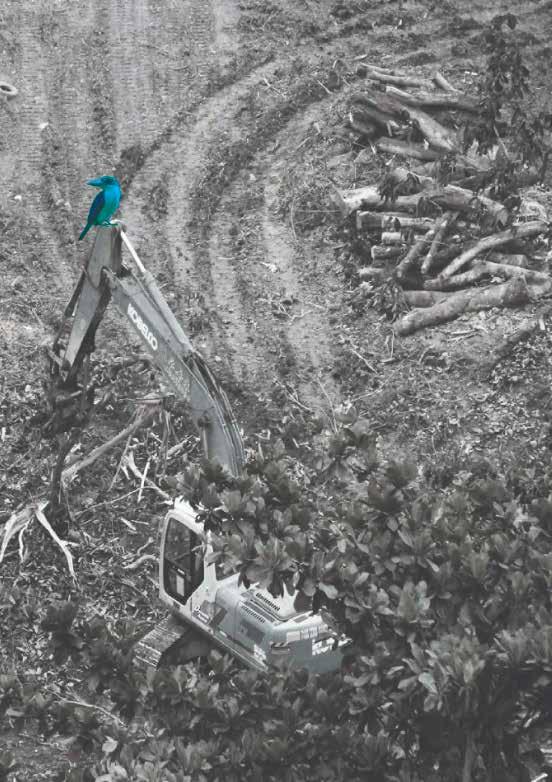
LANDSCAPE FIRST APPROACH FOR PLAB
Guo Lehana
BIRDS ON BULLDOZER studio focuses on the questions of the role of landscape in addressing global challenges. Through landscape-driven scenario-planning and visualizations, the studio aimed to articulate new trajectories for the landscape architecture discipline to guide sustainable city planning.
IN THE STUDIO described in this book, 23 graduate students in the Master of Landscape Architecture programme from the National University of Singapore collaborated to develop landscape planning strategies for the Paya Lebar Air Base future town. The cohort is divided into 2 studios and each studio is tasked to produce 1 overall concept masterplan whilst also working in teams of 2-3 on a given topic. Work included preliminary research into the given topic, site context, field trips to identify opportunities and challenges within the assigned topic, group masterplanning negotiation, and design activities visualizing planning concepts and systems.
MANY THANKS to the following collaborators: NUS PLAB Research team for allowing us to tap on their research and site data required for this studio; Dr Lum Shawn (Nature Society (Singapore) and Dr. Anuj Jain (BirdLife International) who guided the students on their field trip and provided fundamental understanding of the ecology of PLAB; Mr Tan See Nin (URA), Ms Soh Yun Yee (NUS), Ms Ng Abby (NParks), Mr Choo Jeverss (Mao Sheng Construction), and Ms Lim Sheau Miin (DPA) for providing the students insights into various urban planning, development and construction topics related to this studio; Mr Lee Alfred (STX) and Mr Koh Jiann Bin (Coherean Pte Ltd) for providing technical and practical advice to the students; Dr Heng Chye Kiang (NUS), Mr Fung John Chye (NUS), Dr Ong Ghim Ping Raymond, Dr Tan Puay Yok (NUS), Dr Tang Dorothy (NUS), Dr Lin Ervine (NUS), Ms Liu Huei Lyn (PUB), Mr Wright Jason (NParks), Mr Therry Jelle (Ramboll), and Mr Lambreghts Stefaan (Grant Associates) who participated as guest critics and offered valuable advice.
THIS BOOK is a compilation of works from the studio. The first portion of the book documents the sequential studio process of the 2 studios. Thereafter, the 2 overall concept masterplan and the corresponding topics are documented.
Studio 1’s concept masterplan is titled “Happy & Resilient PLAB” and it comprises of strategies with the following headings: LAND AND SOIL MANAGEMENT, WATER MANAGEMENT, RECYCLED CONSTRUCTION MATERIAL, WATERSHED PROTECTION WITH AQUATIC ANIMALS, LANDSCAPE CONNECTIVTY WITH BIRDS.
Studio 2’s concept masterplan is titled “Regenerative PLAB” and it comprises of strategies with the following headings: CO-BREATHING WITH SOIL, SEED DISPERSAL AND ANIMALS, WILDLILFE ECONOMIES, NATURE AS A CARBON BANK, PRODUCTIVE LANDSCAPE BUSINESSES.
The book concludes with reflections by the students. We hope the book will launch new discussion of the role of landscape architecture in sustainable city planning.
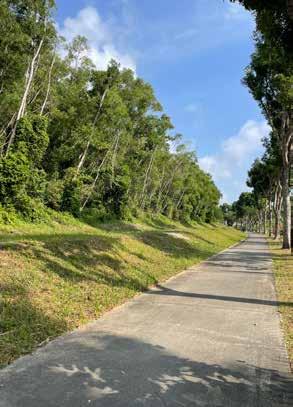
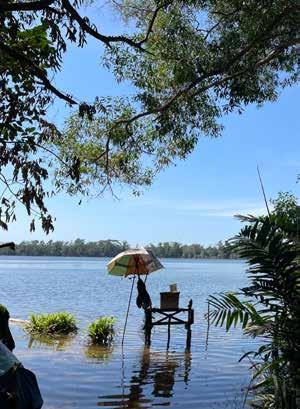
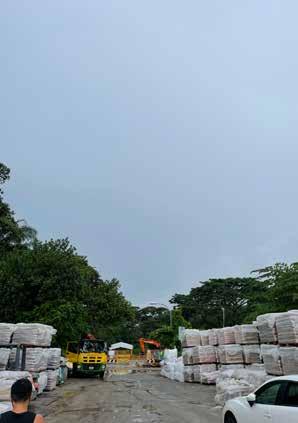

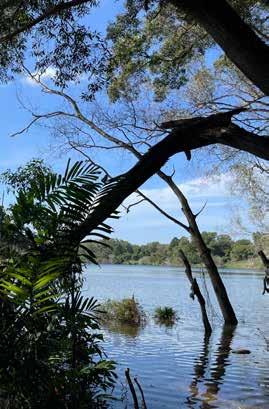


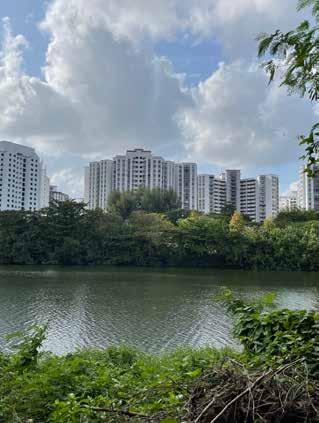
STUDIO INTRODUCTION STUDIO CHRONOLOGY STUDIO 1 : HAPPY & RESILIENT PLAB STUDIO 2 : REGENERATIVE PLAB REFLECTIONS P10-13 P14-21 P22-241 P242-447 P448-459
STUDIO INTRODUCTION
Hwang Yunhye and Guo Lehana
CLIMATE & BIODIVERSITY EMERGENCY
We are in a climate and biodiversity crisis. More than one-fifth of all humans live in regions that have already seen warming greater than 1 degree Celsius since the pre-industrial period, with an increase of 0.2 degrees per decade . Scientists predict that on our current trajectory of habitat loss and global warming, between one third and one half of all species will face extinction by the end of this century. Twin crises will upend ecosystems and destabilize human civilization.
CITIES’ CONTRIBUTION AND OPPORTUNITIES
Urbanization is a major anthropogenic driver of biodiversity loss. Cities’ massive resource consumption and waste production without a closed loop system continues to strain ecosystems globally. . However, the energy and material flows of a city can be designed to be more attentive to local and ecological systems and their limits . Designed with care, urban spaces can also function as heterogeneous habitats accommodating a range of plant and animal species . Cities therefore also present a unique opportunity to address global challenges.
ROLE OF LANDSCAPE ARCHITECTS
Habitat loss and global warming require that landscape architects fundamentally change how we plan and design communities, landscapes, cities and regions . We are uniquely positioned to drive the creation of new habitats and manage the effects of fragmentation and environmental degradation through design. We ensure that developments are planned and designed with careful regard to both local ecological systems and the spatial character of the landscape. Through landscape-driven scenario-planning and visualizations, the studio will articulate new trajectories for the landscape architecture discipline to guide sustainable city planning.
SCIENCE AND TECHNOLOGIES OF LANDSCAPE PLANNING
Current knowledge in ecological and geographical sciences and advancements in landscape digitization can potentially provide the theoretical underpinning and advanced tools for landscape planning. However, disciplinary fragmentation makes it challenging to translate these advancements into actionable knowledge that can guide landscape planning and design.Better alignment and synthesis of different disciplinary perspectives and priorities is needed. The studio setting offers a space for synthetic research where students are able to gather experts’ inputs from relevant fields including environmental engineers, tropical ecologists, remote sensing and spatial analysts, and policy makers in conservation and development.
QUESTIONS
Questions that this studio will tackle include; Where are the green and blue spaces that are imperative to future ecological desired function? What opportunities for ecological restoration exist? How can we leverage a city’s natural capital to strengthen our ecological, climate and socio-economic resilience? What are the development alternatives that can mitigate loss of nature and limit carbon footprint?
SITE
With the relocation of PLAB from the 2030s onwards, a 800 ha of land including the airbase and its surrounding industrial developments, is earmarked for a new growth phase - to be transformed into a new town as a commercial hub . Many ideas on how the PLAB area could be redeveloped in the future have been proposed through a public competition with design studios and the URA .
10
Considered to be one of the largest forested areas outside nature reserves in Singapore, the site has matured from a fallowing land into a young secondary forest with most trees in unmanaged greenery reaching full heights since its former Kampong days. Though extensive in greenery, there is an inconsistency in canopy cover where certain areas are lushly overgrown with closed canopy while others are more barren due to degraded soil and clearance. Due to the variety and network of different habitats complementing and supporting one another, the biodiversity on site may have great potential to form a rich and complex whole.
PLAB is situated in the eastern catchment of Singapore; its waterways flow into multiple catchments - Serangoon and Bedok Reservoirs, or into the open sea. The topography hosts a wide range of levels, with terrain elevations varying from 0.0m to 50.0m. The surface rainwater flows along the uneven terrain, forming temporary streams and ponding areas during heavy rain events. It contains over 80ha of runway and 00hc of industrial buildings consisting of a large amount of asphalt and concrete that are recyclable; various types of soils from healthy soils with organic debris accumulating over several decades to inorganic soil at Tampines HDB stockpiles. Despite the dominant urban layout, the existing topography and many large trees that are naturally grown offer a unique opportunity to create new landscapes or can be recycled while minimising carbon footprint and transportation cost to the landfill site and regenerating the history of post-modern industrial landscapes.
STUDIO APPROACH
Adopting urban ecological principles from several studies, the studio will envision PLAB district to possess a self-sustaining and healthy habitat, a physical environment that is interwoven with histories of infrastructure, buildings, and open spaces to enhance biodiversity conservation and maximize resource usage efficiency, and a district that is connected to the larger ecosystem. In doing so, it injects flexibility into the PLAB district, allowing it to anticipate and respond to rapid changes in environmental and socio-economic conditions. Each studio has 10 potential topics under two key areas to be tackled. From the start of the semester, using the topics given below as a guide, students will work in groups to advance their research and analysis into the site. A studio-based draft concept masterplan is the intended outcome for the 1st half of the semester. For the 2nd half of the semester, the small groups will define a group project with the topic of their choice and develop that into specific site-based design strategies. Students will then be asked to develop design proposals. The intended outcome at the end of the semester is to have all group projects overlayed on one district scale plan per studio. Planning and design work will be evaluated based upon its relationship to knowledge developed throughout the semester and the degree of development and inquiry undertaken by the group.
AREA 1. CARE. CONNECT. COEXIST: FOSTERING HUMAN AND WILDLIFE RELATIONSHIP
With biologists' inputs and theoretical knowledge of socio-ecological functions of wildlife in the PLAB, the studio will begin with two scale site analysis. Further exploration is needed to understand how wildlife conservation and monitoring can meet the seemingly conflictual demands of urban development and public preference towards living with wildlife. Potential topics (but not limited to) are as follows;
1. Soil restoration & permeability with insects
2. Landscape connectivity with birds
3. Seed dispersal & food sources with arboreal and ground animals
4. Watershed protection with aquatic animals
5. Wildlife economies
11
AREA 2. REUSE. REPRODUCT. REDIRECT : MANAGING NATURAL AND HUMAN RESOURCE FLOWS
Aiming to optimize resource usage efficiency in construction and management, students will begin to quantify carbon footprint from land development, existing resources, including soil, trees, and construction materials. In ‘Resources’, soil conditions, trees, and other construction materials will be discussed for recycling and reuse in future development towards a productive ecosystem for the new town. Potential topics (but not limited to) are as follows;
1. Land & Soil management
2. Water management
3. Recycling existing natural elements as natural capital
4. Recycled construction materials (e.g.Low-carbon material specification)
5. Landscape related business (e.g. Green Manufacturing)
12
REFERENCE
[i] Rivkin, L. R., Santangelo, J. S., Alberti, M., Aronson, M. F., de Keyzer, C. W., Diamond, S. E., ... & Johnson, M. T. (2019). A roadmap for urban evolutionary ecology. Evolutionary applications, 12(3), 384-398.
[ii] Diwekar, U., Amekudzi-Kennedy, A., Bakshi, B., Baumgartner, R., Boumans, R., Burger, P., ... & Theis, T. (2021). A perspective on the role of uncertainty in sustainability science and engineering. Resources, Conservation and Recycling, 164, 105140.
[iii]Forman, R. T. (2014). Urban ecology: science of cities. Cambridge University Press.
Broto, V. C., Allen, A., & Rapoport, E. (2012). Interdisciplinary perspectives on urban metabolism. Journal of Industrial Ecology, 16(6), 851-861.
[iv] Steiner, F. (2014). Frontiers in urban ecological design and planning research. Landscape and Urban Planning, 125, 304-311.
[v] Steiner, F. R., Thompson, G. F., & Carbonell, A. (2016). Nature and cities. The ecological imperative in urban design and planning. Cambridge: Lincoln Institute of Land Policy.
[vi] Hwang, Y. H., & Jain, A. (2021). Landscape design approaches to enhance human–wildlife interactions in a compact tropical city. Journal of Urban Ecology, 7(1), juab007.
[vii] Low, M. E., Pocklington, K., & Ng, P. K. (2019). 200: Points in Singapore's Natural History. Lee Kong Chian natural history museum.
[viii] Clauzel, C., Jeliazkov, A., & Mimet, A. (2018). Coupling a landscape-based approach and graph theory to maximize multispecific connectivity in bird communities. Landscape and Urban Planning, 179, 1-16.
[ix] Etherington, T. R. (2016). Least-cost modelling and landscape ecology: concepts, applications, and opportunities. Current Landscape Ecology Reports, 1(1), 40-53.
[x] Cadavid-Florez, L., Laborde, J., & Mclean, D. J. (2020). Isolated trees and small woody patches greatly contribute to connectivity in highly fragmented tropical landscapes. Landscape and Urban Planning, 196, 103745.
[xi] Valencia, N. (2020, October 13). Not all parks should be green: 10 tips to design landscape infrastructure. ArchDaily. Retrieved Jan 5, 2022, from https://www.archdaily.com/926764/not-all-parks-should-be-green-10-tipsto-design-landscape-infrastructure
[xii] Low, YJ (2019, March 24) Explainer: Why sand is so highly valued and the controversy surrounding crossborder trade. Today Online. Retrieved Jan 5, 2022, from https://www.todayonline.com/singapore/explainer-whysand-so-highly-valued-and-consequences-overmining
[xiiii] Stephanie Nah Yun Yuan, 2017, M.Arch thesis, Architectural Symbiosis: Forestry & Urbanism
[xix] Lena Chuan, 2021, Transforming Singapore into A City in Nature, CUGE lecture series
13
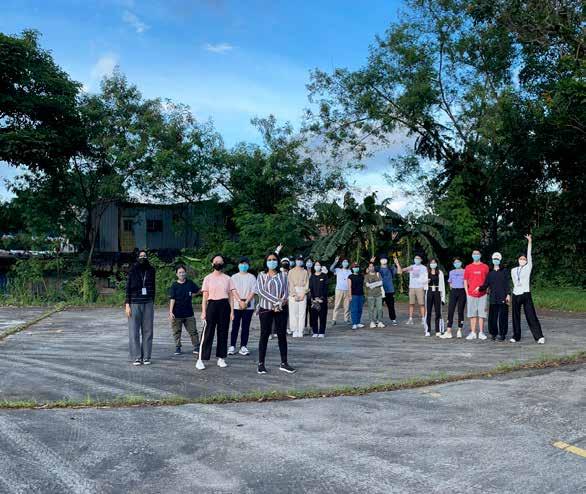
14

15 STUDIO CHRONOLOGY 10 January - 1 May 2022
The studio started off with an orientation of studio "Birds on bulldozer" by tutors, Associate professor Hwang Yun Hye and Ms Guo Lehana followed by introduction to the entire semester's schedule. The students were then tasked to group themselves into groups of 3 based on the choice of topics given.


A series of guest lectures was also given on the following topics:
• Planning for Future PLAB by Mr Tan See Nin (URA)

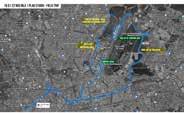
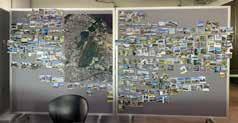
• Summary on the First Report of the PLAB Research Report by Ms Soh Yun Yee (NUS PLAB Research Team)
• Design, Construction, and management of Jurong Lake Garden by Ms Ng Abby (Nparks)

• Potential and Limitation of Natural Resource Management in Landscape Projects by Mr Choo Jeverss (Mao Sheng Construction)
• Stages of Building and Infrastructure Construction by Ms Lim Sheau Miin (DP Architects)

12 JAN Studio Orientation


19 JAN Field Trip
For the morning discussion, the studio was tasked to explore the PLAB site prior to the guided field trip and to identify the various landscape typologies found within the boundary.
Dr Shawn Lum and Dr Anuj Jain then led the studio on a field trip. While stopping at various key areas, both the guest guides provided a commentary on the ecological structure and history of the site.

16
Each studio shared their site model making intention in terms of the scale to use, materials to employ and color scheme. After which, each group presented their research and analysis of the site based on the chosen topic. As most of the site data was provided by NUS PLAB Reseach Team, the students were tasked to filter through the data and to present only what is relevant. The topics presented were:
Area 1. Care. Connect. Coexist: fostering human and wildlife relationship
1. Soil restoration & permeability with insects
2. Landscape connectivity with birds
3. Seed dispersal & food sources with arboreal and ground animals
4. Watershed protection with aquatic animals

5. Wildlife economies
Area 2. Reuse. Reproduct. Redirect : managing natural and human resource flows
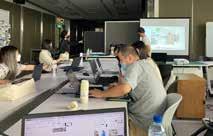
1. Land & Soil management
2. Water management

3. Recycling existing natural elements as natural capital
4. Recycled construction materials (e.g.Low-carbon material specification)

5. Landscape related business (e.g. Green Manufacturing)
26 JAN Exercise 1 Presentation & Model Discussion
2 FEB Exercise 2 Studio Site Model
Each studio was required to produce 1 overall physical model of the existing site. The models made have to be flexible such that the existing elements can be removed and replaced with the design interventions. The site model included the contours / terrain, road networks and any other layers necessary to demonstrate context according to the selected topics of the studio.
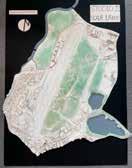


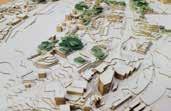
17
The Concept Masterplan Design workshop was led by the tutor of each studio. The students were guided through the drafting of the concept masterplan through various design prompts, such as the identification of various user types, understanding the issues in relation to the individual group topics, and consideration of the external site context. As part of the intending studio process, intergroup discussion was also conducted to understand the requirements and limitations of each topic. An overall studio draft concept masterplan was the deliverable set for the following week.
9 FEB Concept Masterplan Design Workshop
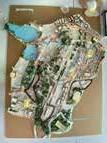
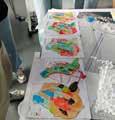
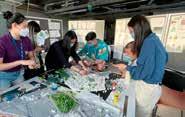
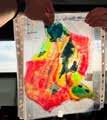

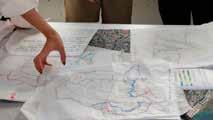



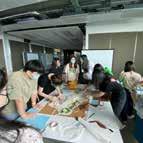
16 FEB Masterplan Negotiation and Model Modification
Using the first draft of the concept masterplan as the base, the studio tutors raised various queries to challenge the students to further enhance the masterplan.
Studio 1 worked on demarcating core ecological zones and parceling of the site based on the assumed demands of each topic.
Studio 2 conceptualised a rating strategy to facilitate the demarcation of zones required for each landuse type.
18
The midterm review was divided into 2 sessions. The morning session was a presentation of the overall studio concept masterplan followed by a Q&A session with invited critics, namely, Dr Heng Chye Kiang (NUS), Mr Fung John Chye (NUS), Dr Ong Ghim Ping Raymond, who were all part of the NUS-PLAB Team, and Dr Tan Puay Yok (NUS).
23 FEB Midterm Review
The afternoon session was curated as a presentation of individual group masterplanning and concept design strategies, followded by a Q&A session with invited critics, namely, Dr Tang Dorothy (NUS), Ms Liu Huei Lyn (PUB), Dr Lum Shawn (Nature Society Singapore), Dr Anuj Jain (Birdlife International), and Mr Koh Jiann Bin (Coherean Pte Ltd).
The invited critics provided critical and valuable comments for the students to consider as they further their design strategies in the following weeks.
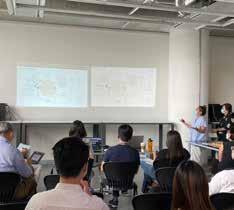
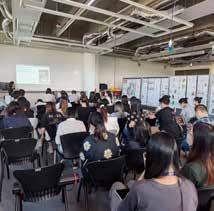

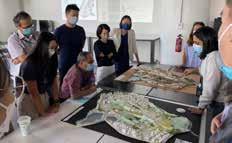

19
Following the comments received at the Mid-term Review, each studio relooked into their masterplanning strategies, continued the intergroup negotiation process and made the neccessary adjustments.
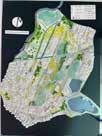

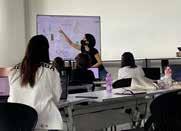


Further design developments on individual group topics were also made in consideration of the comments received by the external critics.
Design Development
16 MAR - 13 APR Design Development
With the overall studio's Concept Masterplan firmed up, the last month of the semester was dedicated for individual group consultation to further the design schemes of each topic.

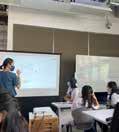

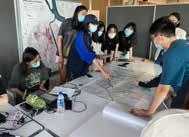
20 2
MAR - 9 MAR Masterplan Adjustment and
At the Final Review, each studio presented their overall studio masterplan followed by the individual group topic. Two groups of external critics were invited to join session. Studio 1's "Happy & Resilient PLAB" was critiqued by Mr Tan See Nin (URA), Mr Lambreghts Stefaan (Grant Associates), and Dr Tang Dorothy (NUS). Studio 2's "Regenerative PLAB" was critiqued by Mr Wright Jason (NParks), Mr Therry Jelle (Ramboll), and Dr Ervine Lin (NUS).
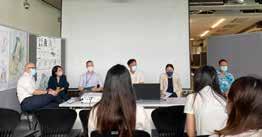

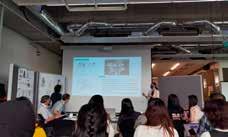

The semester concluded with the submission of a compiled studio report and the students' reflections found in the subsequent chapters of this book.
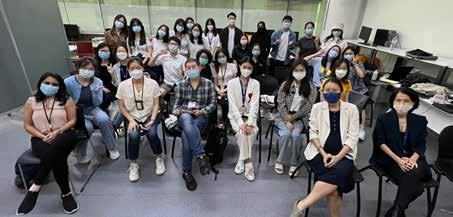
21 20
APR Final Review

HAPPY & RESILIENT PLAB
CONCEPT MASTERPLAN GENERATION & NEGOTIATION PROCESS
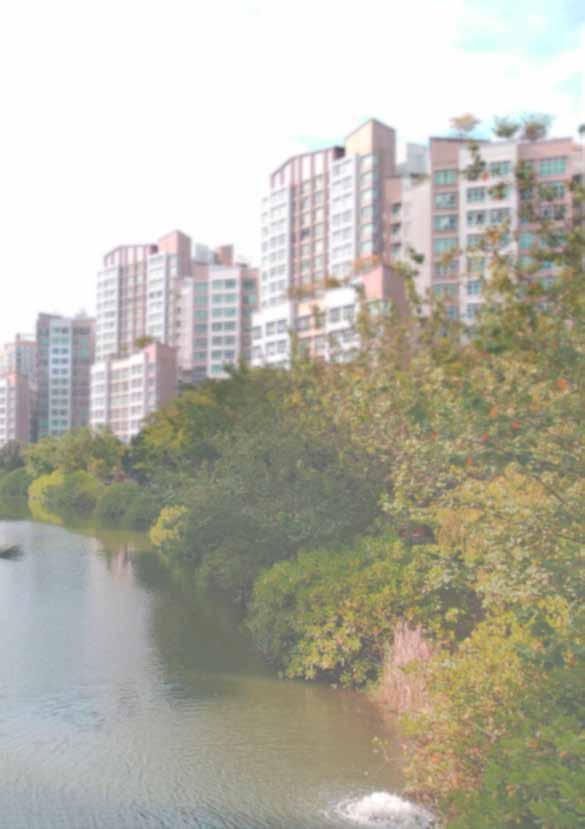
STUDIO ONE | DONG LIWEI | ZHANG YUER | SHEN YUNNAN | JIANG YULI | LIU ZIYUE | YE HAN | WANG YU | | ZHANG WENTING | LIU KANGSHENG | LIN LAN | HU DIE | JIN ZHUOYIN | | JANINA KWAN | SABRINA SHAFARI | XING ZHIYAN |
TUTOR: LEHANA GUO

MASTERPLAN ISSUES 24
Singapore iS Small nation that haS experienced rapid development in over half a century, tranSforming itSelf into a firSt-world country by thriving aS a global financial hub deSpite itS conStant development, there are iSSueS that the nation haS yet to fully reSolved, along with the riSe of future challengeS that grow with the everchanging State of the world the development of plab will hold great infuence over Singapore'S future State, aS itS foundationS will be Shaped by preSent and future conditionS thuS, the foundation of the Studio maSterplan will be guided by Singapore'S current development, itS iSSueS and future iSSueS
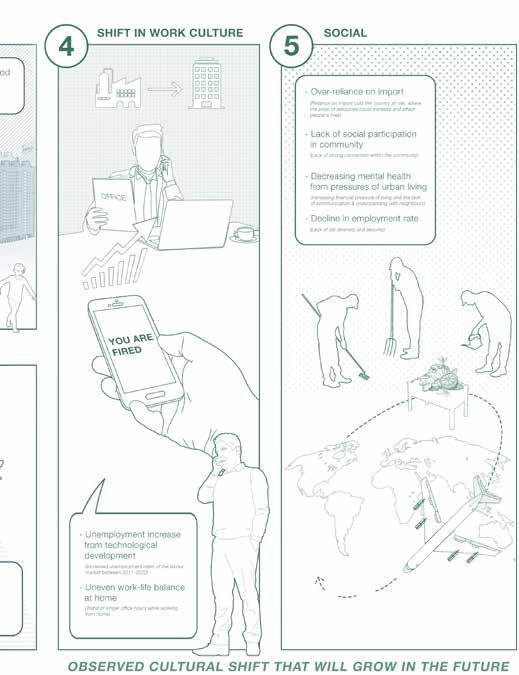
25
HAPPPY & RESILIENT PLAB
Topic Generation
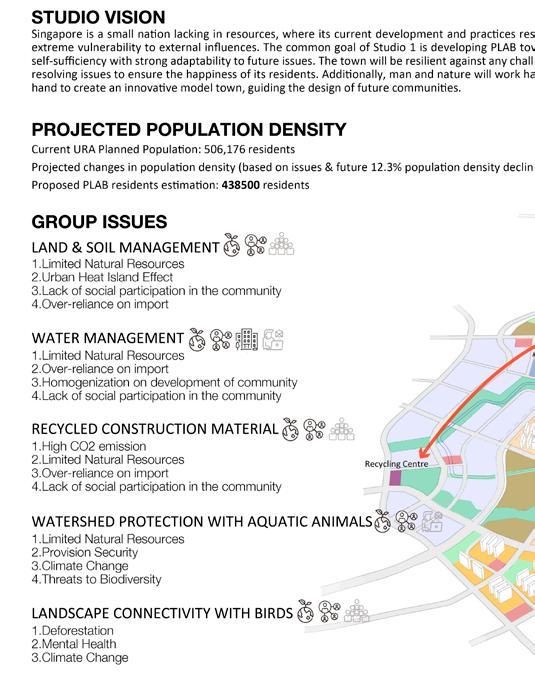
26

27
MASTERPLAN NEGOTIATION PROCESS

Green Space Negotiation
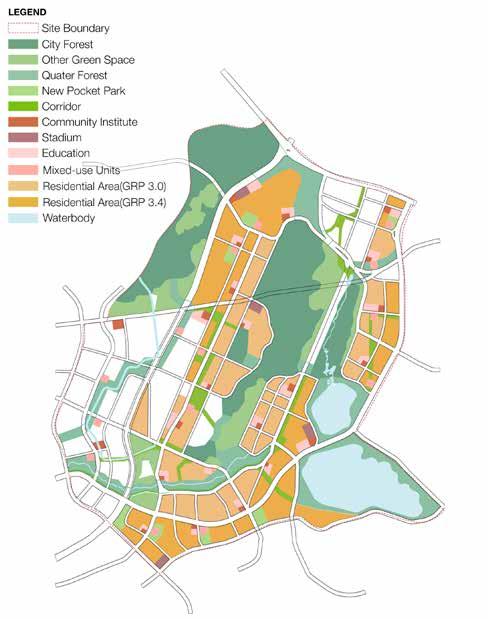
28

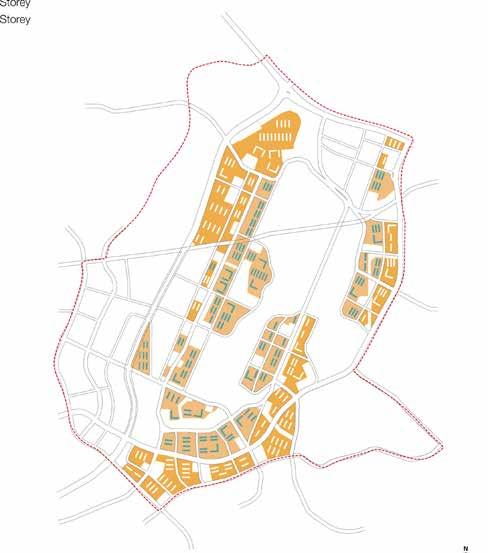
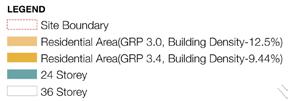

Population Density 29
MASTERPLAN NEGOTIATION PROCESS

Road Network & Hierarchy
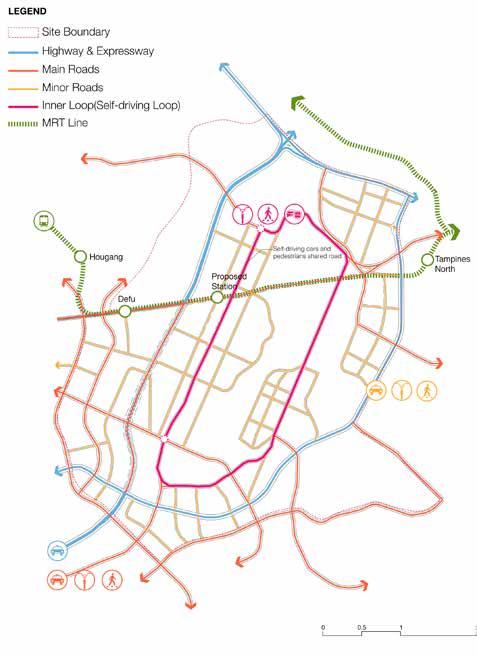
30





Landuse 31
MASTERPLAN TIMELINE
the plab Studio maSterplan takeS place acroSS 30 yearS in 4 different phaSeS

32

33
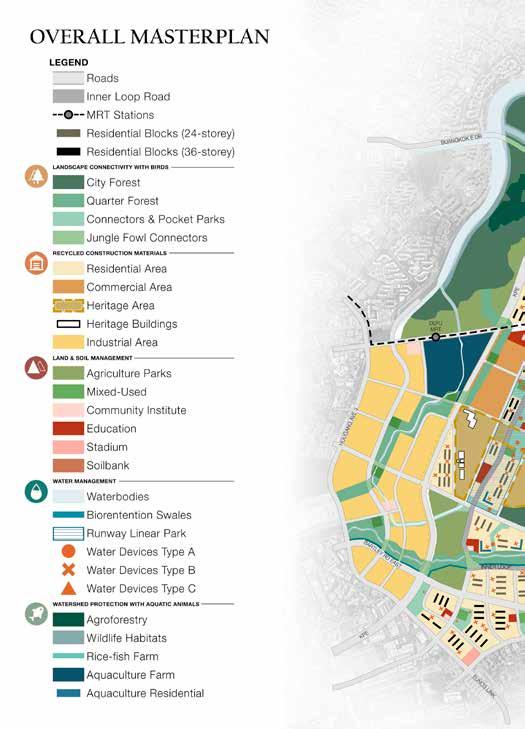
OVERALL MASTERPLAN 34
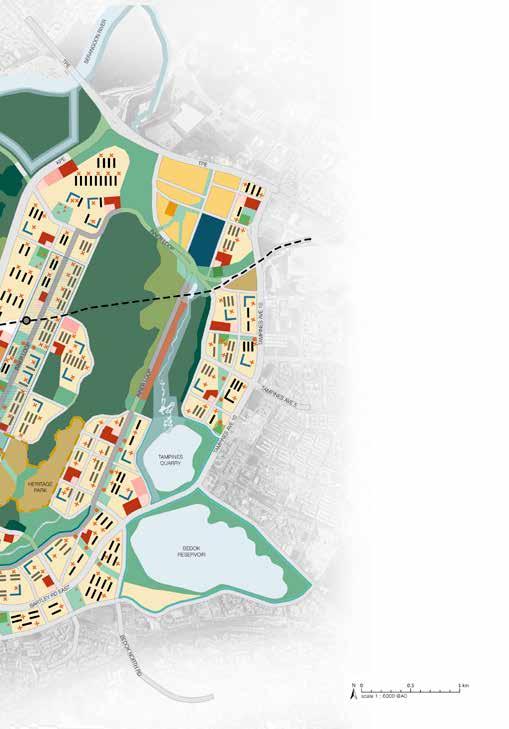
35
36
HAPPY & RESILIENT PLAB
CONCEPT MASTERPLAN TOPIC OF FOCUS
LANDSCAPE CONNECTIVITY WITH BIRDS
RECYCLED CONSTRUCTION MATERIALS
LAND & SOIL MANAGEMENT


WATER MANAGMENT
WATERSHED PROTECTION WITH AQUATIC ANIMALS



37

38
LIVE WITH BIRDS
LANDSCAPE CONNECTIVITY WITH BIRDS
Singapore's primary forest area has been reduced to 2% of what it used to be. Ninety percent of tree cover loss occurred in urbanized areas. And the potential breakdown of pollination and dispersal mechanisms through the loss of species is also a risk factor. At the same time, One in seven people in Singapore has experienced mental disorders. Especially during the COVID-19 pandemic, More people seek mental health support.
Four aspects led us to choose birds as the target species. The first is the status quo of birds, and there has been a fluctuation decline in bird total counts and species in Singapore in 10 years. Secondly, Singapore is transforming itself into a City in Nature. The goal of 60 species recovery plans for the animal is set. Moreover, well-being was positively related to natural features, including species richness and abundance of birds for humans. And Singaporeans were generally optimistic about birds. Finally, birds are beneficial to the environment, and they are good pollinators and seed dispersers to facilitate the connectivity of the landscape.
New findings indicate that Singapore is now at the intersection of two flyways, the CAF and EAAF. PLAB is the green core in the west of Singapore and one of the most significant green spaces apart from the Nature Reserve.
Therefore, our design will mitigate the problem of deforestation, mental health, and climate change based on the Studio issues. And our vision is to transform PLAB from a bird-forbidden site to a bird-friendly site and then help the urban forest regeneration quickly while creating more opportunities for PLAB residents to get closer to nature. By connecting people more closely with nature and nature with nature, PLAB will become a happy and resilient city.
Moreover, our target is to keep the bird observation distance from 10.8m to 28.6m. Secondly, ensure access to parks within 300m of residential areas. Thirdly, increase public parks and open space to 9m2 per capita. Finally, the design will preserve 100% of the core habitat and increase the 1836226m2 forest area.
In conclusion, more birds will arrive as the forests mature and the greenery is better connected. Human wellbeing is improved, and PLAB is resilient against climate warming and extreme disasters with forest regeneration.
39
Dong Liwei, Shen Yunnan, Zhang Yuer
PRELIMINARY ANALYSIS Design Concept

40
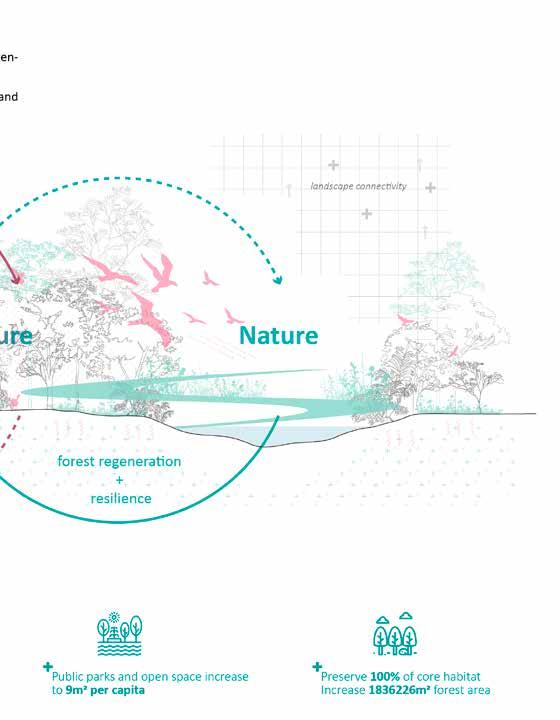
41
PRELIMINARY ANALYSIS
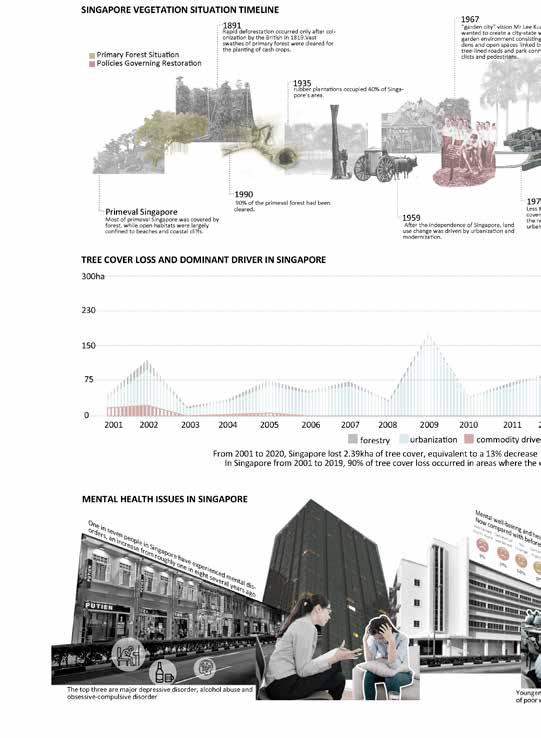
Background 42

43
PRELIMINARY ANALYSIS
Why bird?
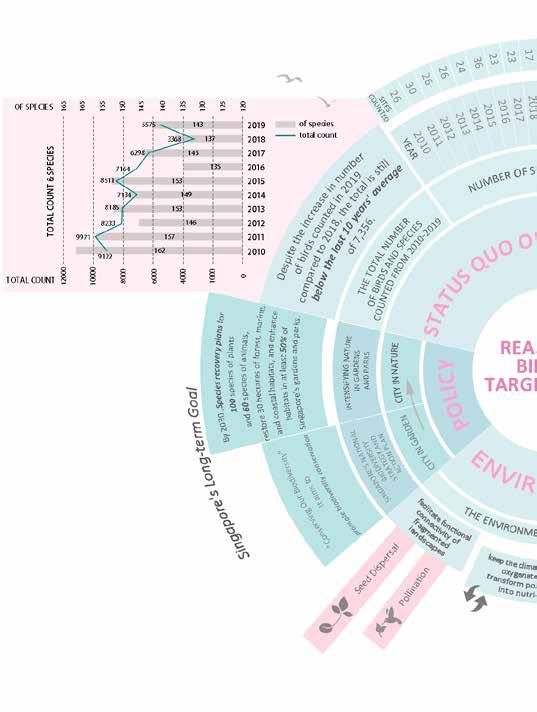
44

45
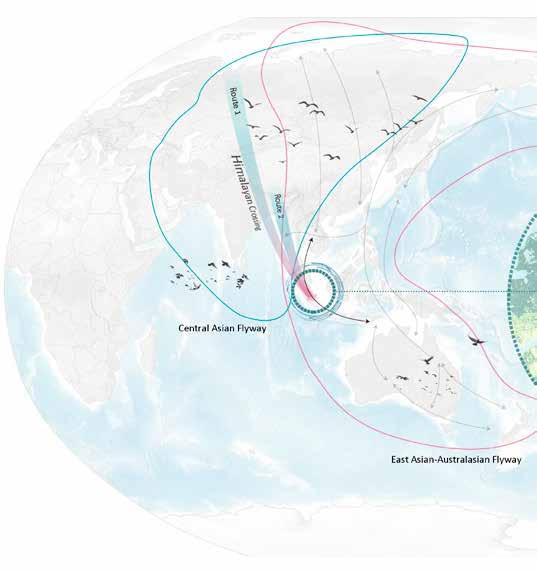
Situation Birds Migratory 46
PRELIMINARY ANALYSIS Bird
Migratory Routes
INTERNATIONALLY: New findings indicate that shorebirds use both the CAF and EAAF to reach their breeding grounds. Singapore is at the intersection of 2 flyways.
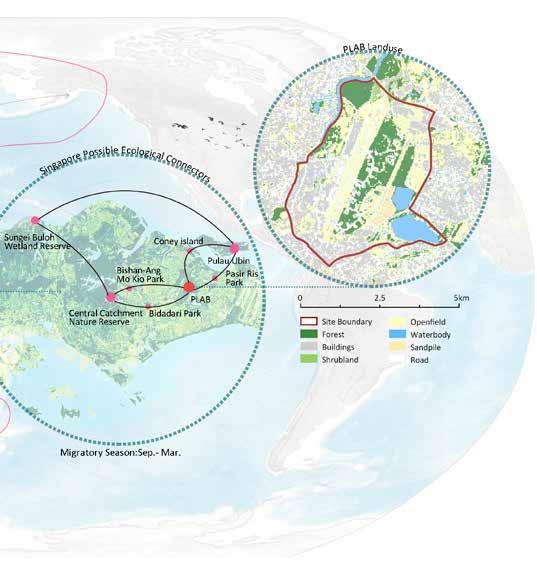
SINGAPORE: PLAB can link to Central Catchment Nature Reserver, and it can also link to Coney Island and Pulau Ubin.
PLAB: PLAB is one of the largest green space apart from the Singapore Nature Reserve and is the green core in the west of Singapore.
47
PRELIMINARY ANALYSIS
Bird Species Selection
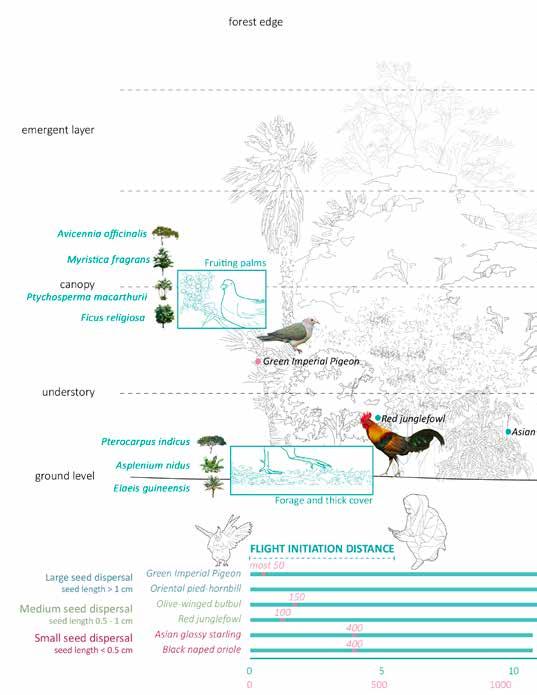
48
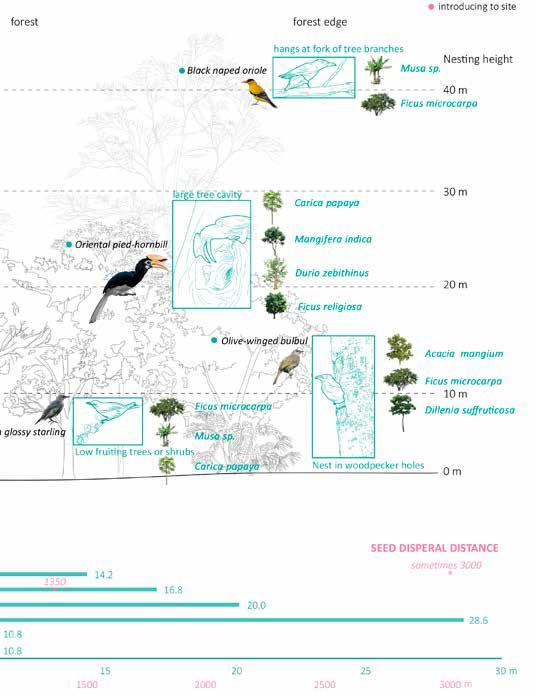
49
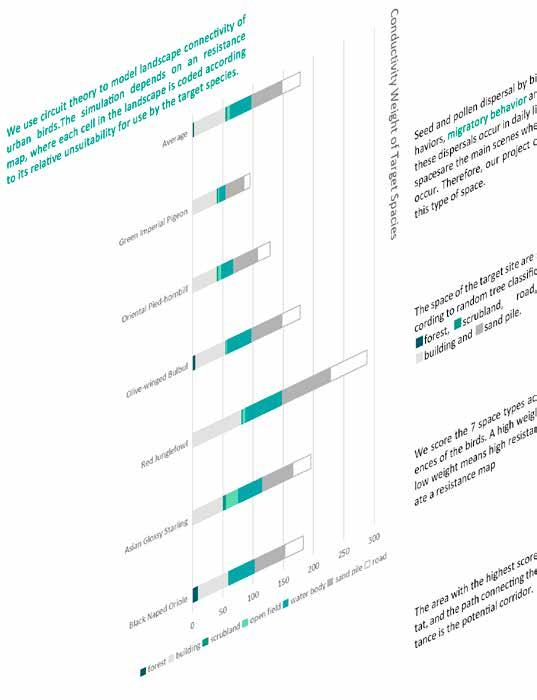
50
PRELIMINARY ANALYSIS Analysis & Calculation Method
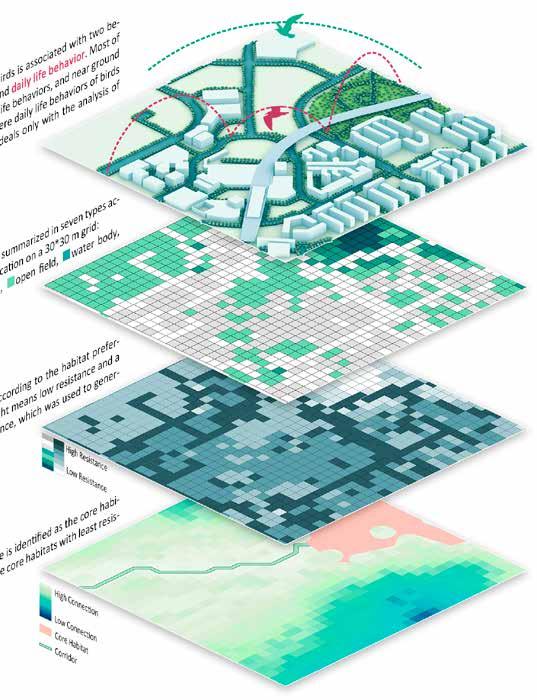
51
PRELIMINARY ANALYSIS
Landscape Connectivity with other patches outside PLAB
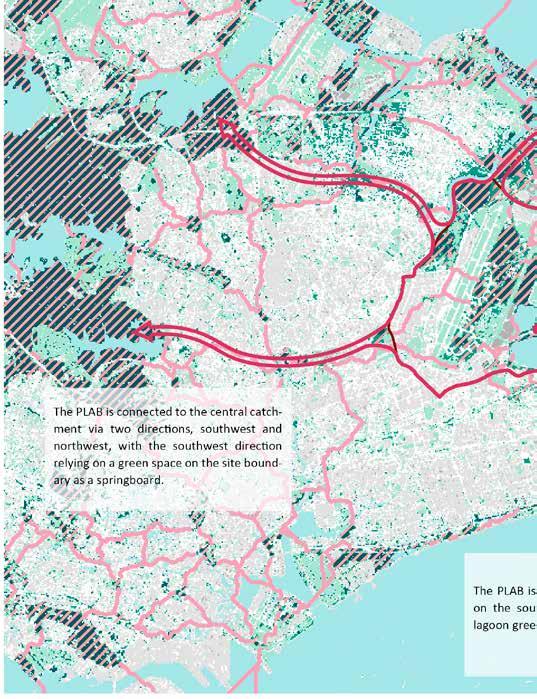
52
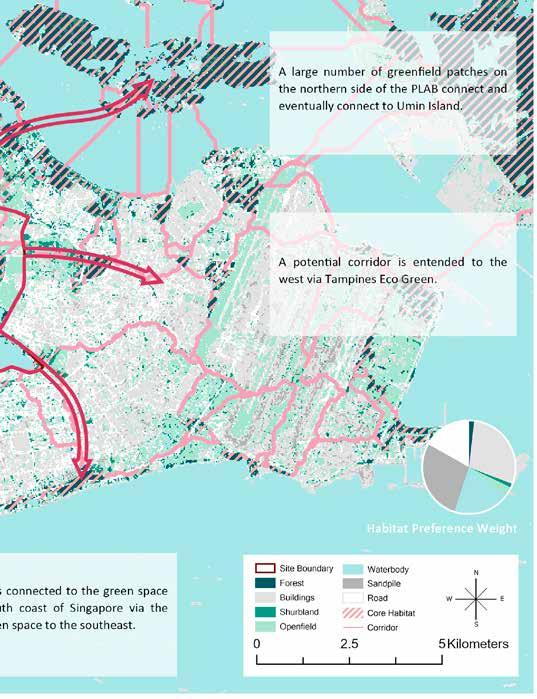
53
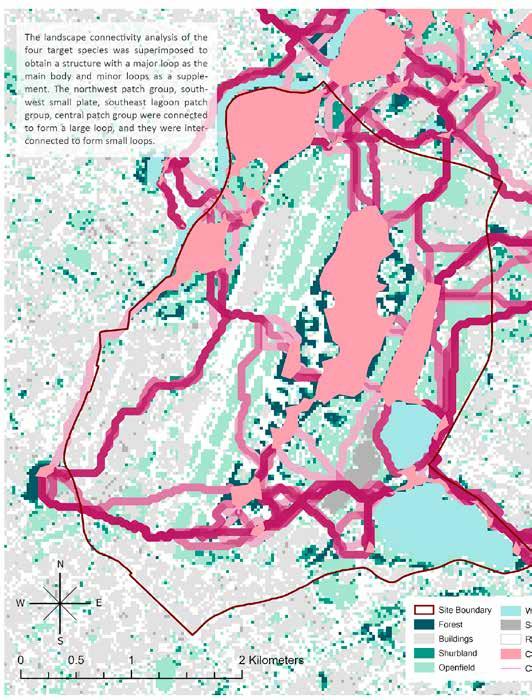
54
PRELIMINARY ANALYSIS Potential Corridor

55
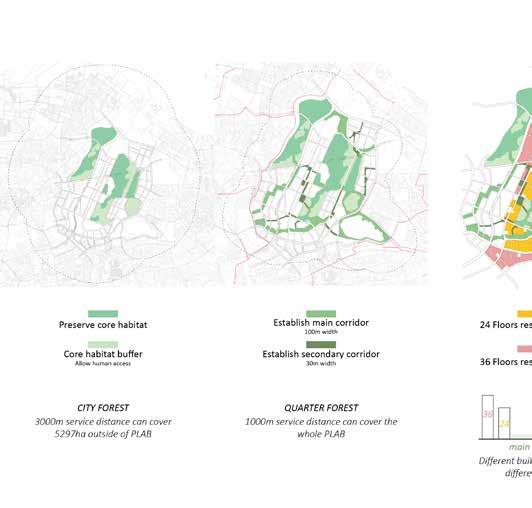
Masterplan Generating Process 56
PROPOSAL

57
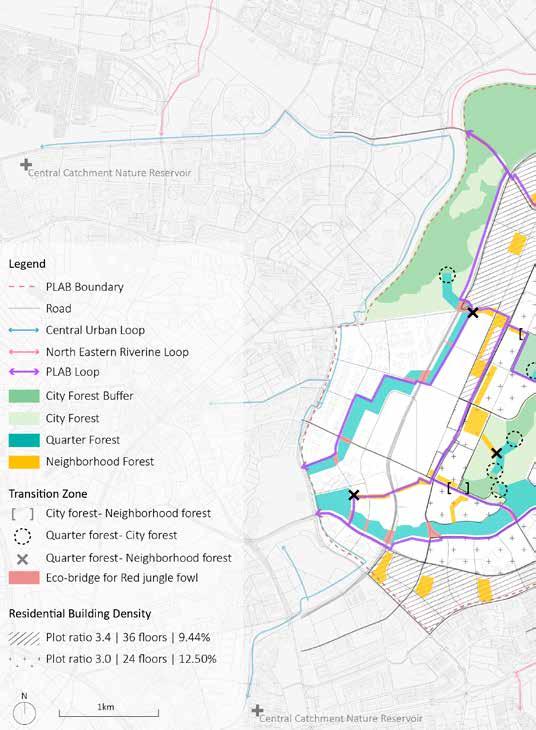
58 PROPOSAL Masterplan

59
PROPOSAL
Redefinition of Different Forests
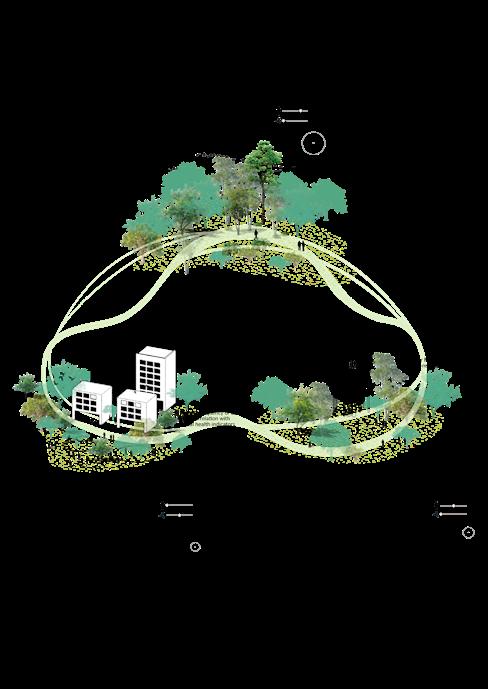
60

Legend 61 PROPOSAL Forest Succession Timeline
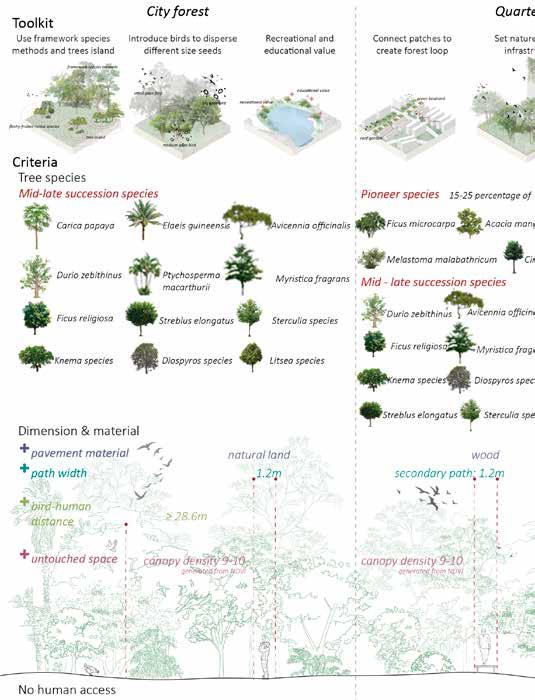
62
PROPOSAL Design Guideline
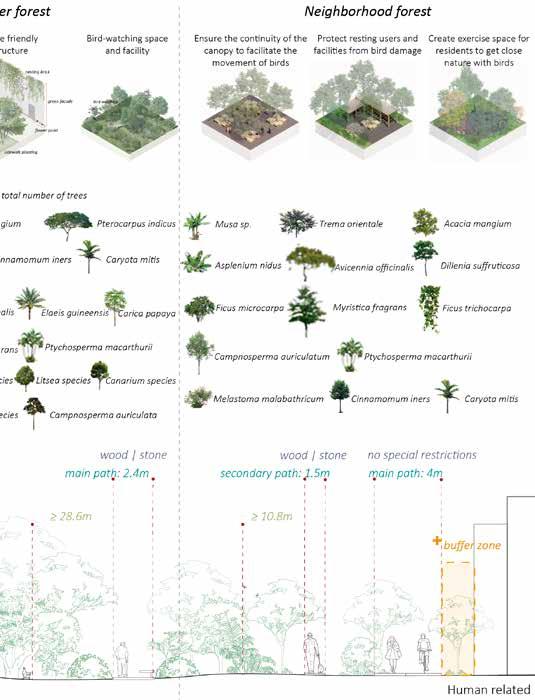
63
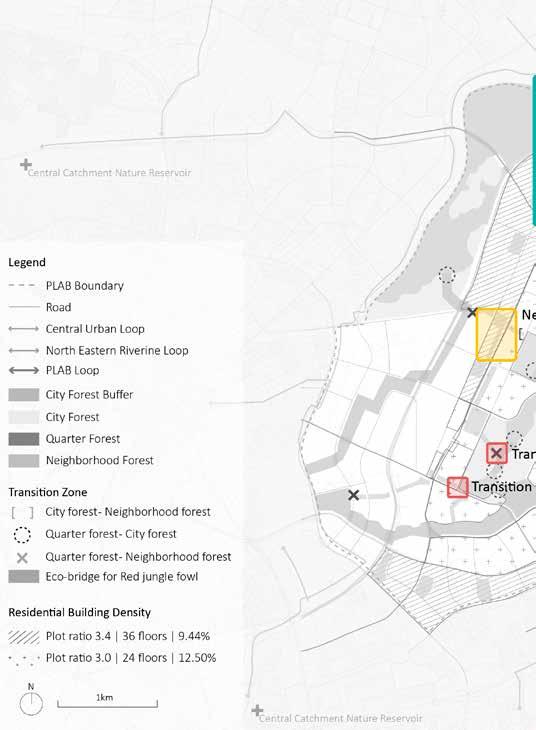
PROPOSAL Detail Design Location 64
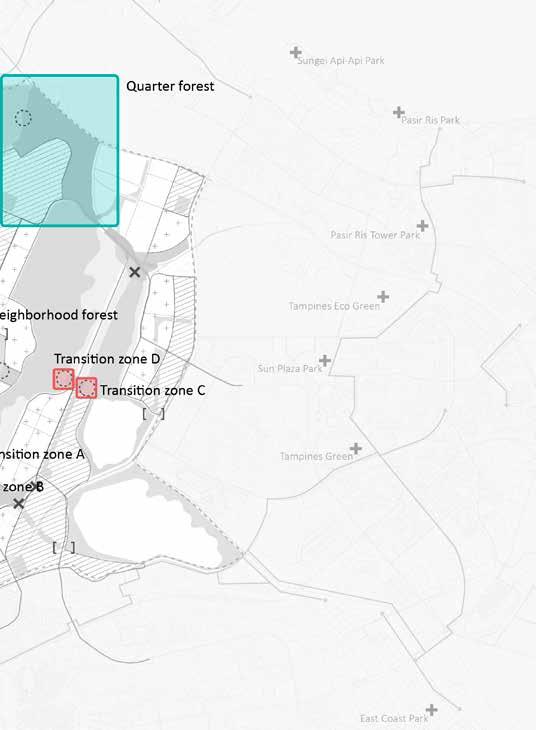
65
DETAIL DESIGN | QUARTER FOREST
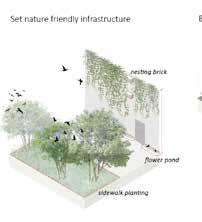
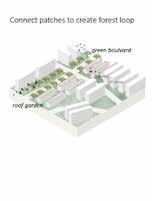
Design consideration
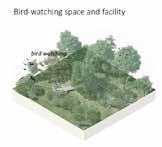
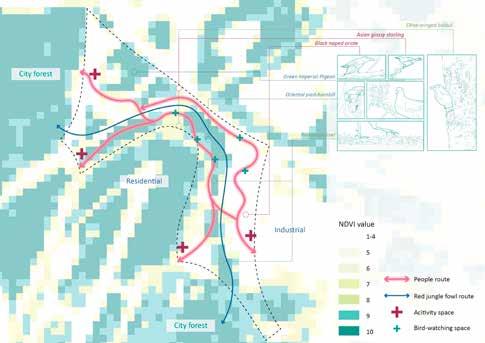
66
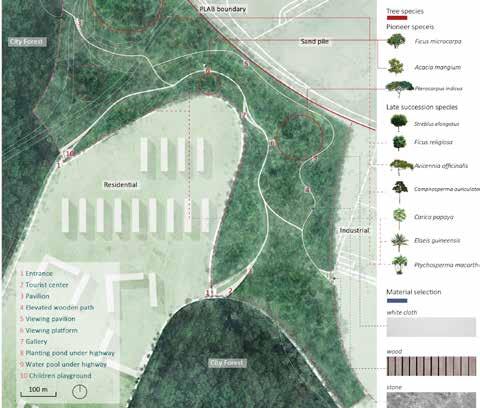
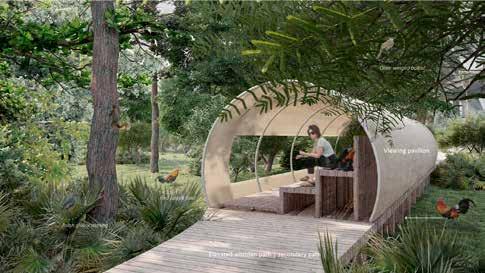
Detailed Plan
67
Perspective of Pavilion & Elevated wooden path
DETAIL DESIGN | NEIGHBORHOOD FOREST

Detailed Plan 68
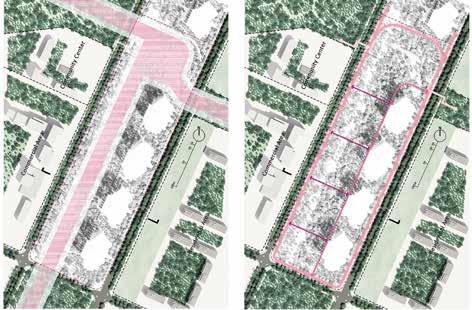
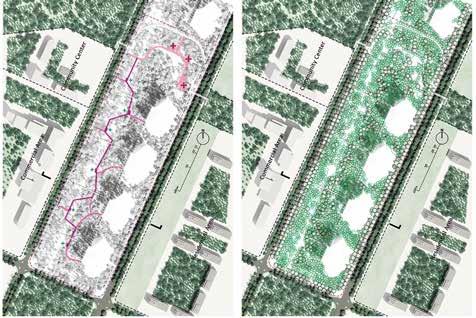

Design consideration 69
DETAIL DESIGN | NEIGHBORHOOD FOREST
Design Consideration

The site supports potential corridors for Black napped oriole, Olive-winged bulbul and Green imperial Pigeon to pass through. According to the creation guidelines of neighbourhood forest, a safe corridor of at least 30m wide and a bird-human distance of at least 10.8m wide should be preserved.
According to studies, an NDVI of around 70% in the urban environment is ideal to ensure maximum bird diversity. This means that meeting such target is optimal for bird survival. The stimulated NDVI of the planting design reached 74%. Based on the vegetation type preferences of the three target species, the following plants will be planted as the keystone species of the site.


70
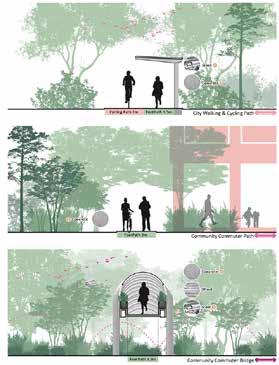
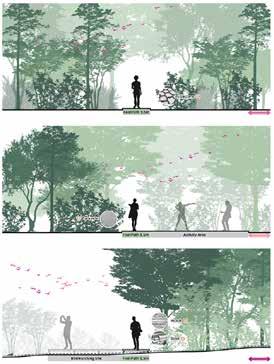
71
DETAIL DESIGN | NEIGHBORHOOD FOREST

72

73
DETAIL DESIGN | TRANSITION ZONE
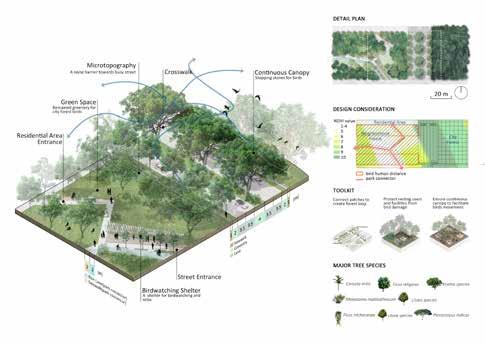
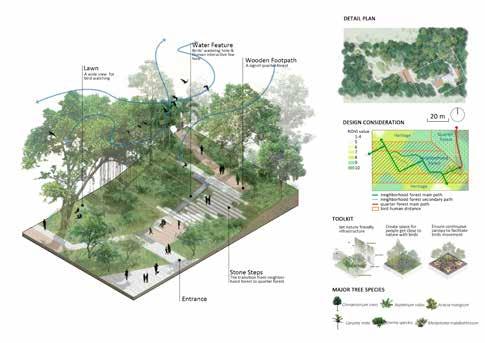 Neighborhood forest - Quarter forest
Neighborhood forest - Quarter forest
74
Neighborhood forest - City forest
Quarter forest - City forest
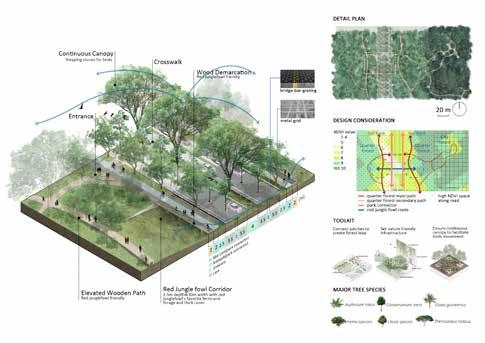
Connecter

75
Red jungle fowl
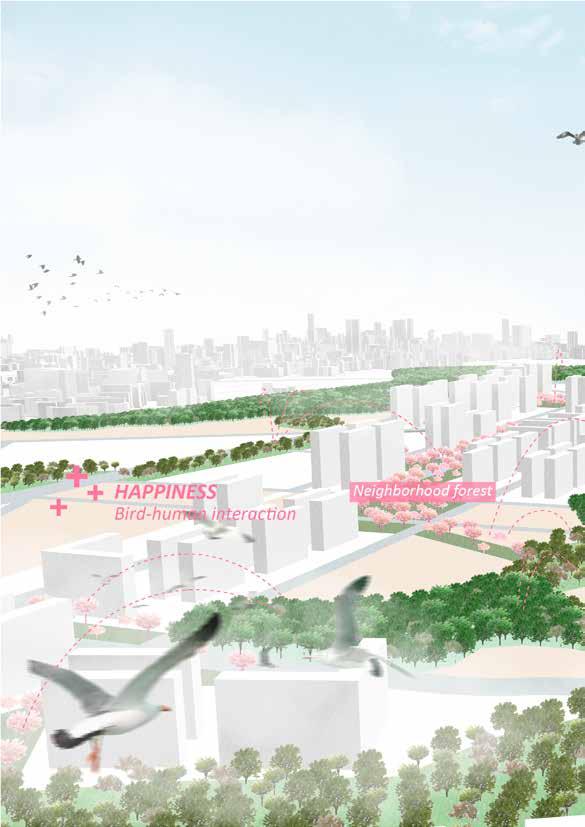
76
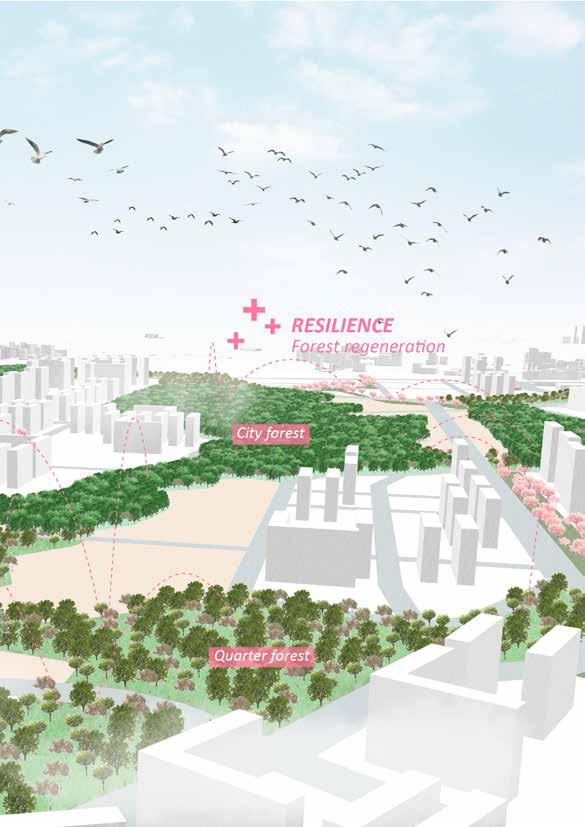
77
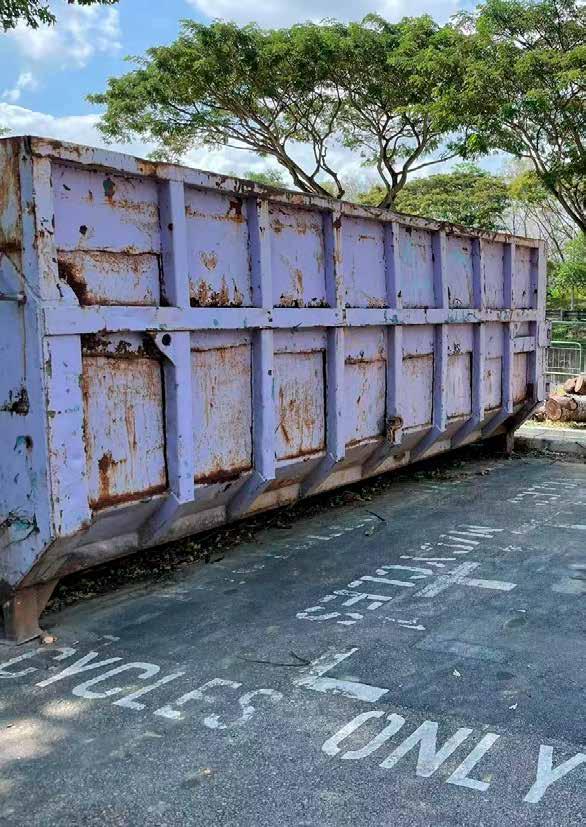
78
RECYCLED CONSTRUCTION MATERIAL
The fluctuations in the social and economic system caused by the deterioration of the environment, natural resources crisis and the emergent social problems have had a serious impact on Singapore, a country that is highly dependent on imports. For example, in urban construction, the cost of materials has risen sharply. Our concept “RE+” in PLAB provides new ideas for the long-term development of a resilient city: a recycling system that extends the life cycle of materials and a heritage park made of recycled construction waste. The government, enterprises, associations, and other organizations cooperate with each other and share information in the new system, which improves the quality of recycled products and further promotes the goal of “Zero Waste”. In the process of visiting the heritage park and experiencing the handcraft activity with different materials, the public can not only gain happiness, but also raise their awareness of environmental protection. “RE+” makes PLAB a happy resilient model town.
"RE" itself represents a process of repetition and renewal. We will achieve the following three visions mainly through 3 related strategies:
Reducing carbon emissions from material recycling process
For the "REposition" strategy: we will reduce the transportation distance of deconstruction waste, and improve energy utilization and recycling efficiency by re-establishing a new comprehensive material recycling center. The efficient recycling and orderly management of materials will achieve the vision of CO2 reduction.
Enhance the awareness of material recycling in the whole society
For the "REfresh" strategy: we will awaken residents' awareness of material recycling through prototyping research on detachable designs, designing heritage parks using recycled materials, and incorporating visual material recycling knowledge. At the same time, the planning of the material experience area will play a certain educational role for children and adolescents.
Improve downcycling status and extend material life cycle
For the "REvalue" strategy: we will extend the life cycle of construction materials and retain the utilization value of materials through the introduction of the "rental system" system. A more complete material flow system and the reuse of higher-frequency recycling components will alleviate Singapore's reliance on imported materials to a certain extent, and at the same time make a contribution to alleviating the material crisis.
RE+
79
Jiang Yuli, Liu Ziyue, Ye Han
ISSUES ANALYSIS: MACRO SCALE
ISSUE 1: HIGH CO EMISSION

1. Current Status:
[1] The real estate industry’s carbon emissions account for 20% of the Singapore’s.
[2] 30% comes from the material manufacture, transportation and construction.

2.Why CO2 matters: Carbon dioxide emissions are the most important contributor to global warming. It also changes the pH value of seawater, thereby affecting the marine ecological environment.
Atmospheric CO2 concentration is rising rapidly
ISSUE 2: LIMITED NATURAL
1. Consumption Speed: TWICE
2. Annual Consumption:100.6bn
3. Proportion: >50% is sand, gravel building
4. Recycle Rate: Fallen from 9.1% We cannot do this indefinitely - our needs to be halted.

CO2 is the most important factor causing global warming
Building materials emit a large amount of carbon dioxide during their life cycle!
Source: https://keelingcurve.ucsd.edu/, https://www.ecocyclesolutionshub.org/about-zero-waste/resource-depletion/
If we don’t recycle the materials, the raw materials will depleted very quickly!
Ecosystems Fossil Fuels Minerals 417.88ppm
2
80
NATURAL RESOURCES
TWICE the population growth rate
100.6bn TONNES
gravel and cement used for
9.1% to 8.6% our hunger for virgin material
ISSUE 3: OVER-RELIANCE ON IMPORT

1. Current Status: Singapore is a country that relies heavily on imports of building materials, with total imports rising by 19.7% in 2021.

2. Why this matters?
The price of building materials in Singapore will be largely controlled by the exporting country and easily affected by the environment. (Example)rebar prices have moved up more than 15 % since the war started.
Price trends of building materials: Metal & Other





Singapore’s building materials mainly rely on imports. Due to factors such as the epidemic, material prices continue to rise!
materials, be quickly!
?
81
ISSUE ANALYSIS










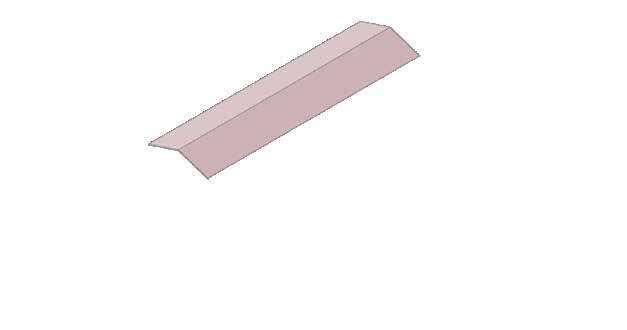

HIGH CO2 EMISSION FROM DECONSTRUCTION



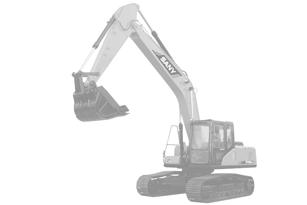
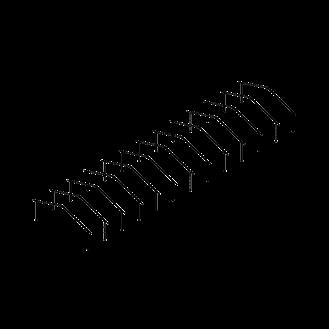
PLAB Scale
HIGH
1,011,150 m3 Demolition waste ≈ 404 1 ≈ 2500 m3 2.7 mt sand ≈ 1 month 1 year ≈ 50 mt sand 438,500 Estimated residents 1,856,821 t ≈ 7,288,100 m2 53 days 1 m2 ≈ 1.8t CO2 / year Swimming pool Swimming pool 16,300 t Concrete 12.8 mt Concrete 2500 t Stone 238,220 t Stone made of 3000 t Metal 183 t Plastic Mekong National Stadium PLAB Forest Forest PLAB Future residential area: Assumed demolition area: 7.22 km2 Reference Reference Assumed construction waste: 9.5 CO2 1 2.7 million 82
DEMAND FOR CONSTRUCTION
CONSTRUCTION MATERIALS













residents ≈ 8
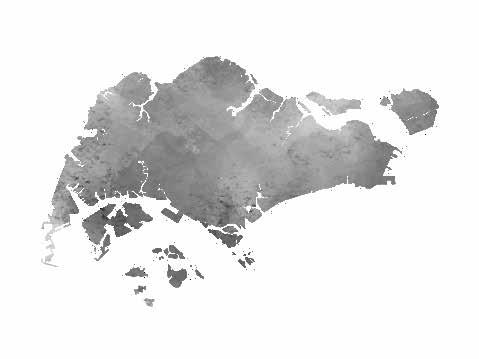

National Stadium
month excavation
DECREASE IN IMPORTED BUILDING MATERIALS
Imports of material drop by 7-50%
Inventory affects construction progress
Import value of construction material in 2018
9.5 million m3
874,665 t Metal 52735 t Plastic


million tons sand
= 55,000 people
Stadium
SGD 270 Million
Prefabricated building
SGD 1350 Million
Import value of construction material in 2020 (Tradingecnomics.com)
Imports value 2018 vs 2020
Prefabricated buildings: 1765 M→1350 M


Stone / plaster: 880 M→810 M


Metal: 350 M→175 M
Lime / cement: 1220 M→680M
83
REPOSITION
Relocate integrated recycling centers on site; Redefine waste management and recycling centers as an "atttactive and lively urban space" in the neighborhood.
Creatively set up for recycling materials, value to waste, and life cycle of
*Definition of "RE+"
1. The repeating of an action or process;
2. A change in the position or state of something.
* Happy & Resilient
1. Happy
Public gains happiness in the process of visiting the heritage park and experiencing the handcraft activity with recycled materials.
2. Resilient
A new recycling system is build for the long-term development of a resilient city. Different organizations coorperate and share information, which further promotes the goal of "Zero Waste".

RE+
CONCEPT & STRATEGIES
84
REPOSITION
up a rental system materials, giving new and extending the recycled products.
REFRESH
Use the educational significance of landscape space to awaken people's awareness of material recycling and resource protection.

Educational Line:
With the support of AR technology, the material information stored in the rental system will be shared with the public. At the same time, more activities will created for teachers, students and residents to visit and participate, thus strengthening their focus on a sustainable future.
85
MASTER PLAN
LEGEND
PLAB Boundary
Recycling Center
Aquaculture Area
Commercial Area
Industrial Area (Smart Manufacturing)
Industrial Area (Semiconductor)
Industrial Area (Smart Logistics)
Residential Area
Heritage Area Boundary (Design Site)

Heritage Building
Public Landscape
Heritage Landscape
Natural Landscape
Water Body
Forest
Inner Loop Road
Roads
Functional Zoning Design
MAIN
Avoid core habitats 500M Area & Location Adjustment of Industrial Zone Confirm the location of the recycling center
CONSIDERATIONS
200 0 500 1000 N 2000M
86
LEGEND
High-tech commercial center
Recycling Center
Functional radiation range
Heritage Landscape
Public Landscape
Natural Landscape
Transition with Residential Area
Inner loop road
Heritage Area Central Axis
Function Axis
Source of construction materials
Consumption of construction materials
Confirm the core location of the CBD
Material transport system
Functional zoning analysis of heritage area
Relationships between functional zones

MAIN CONSIDERATIONS
200 0 500 1000 N 2000M 87
Based on the building life cycle within the period(RSP) of 50 years, during Phase 2, necessary maintenance and material updates will be carried
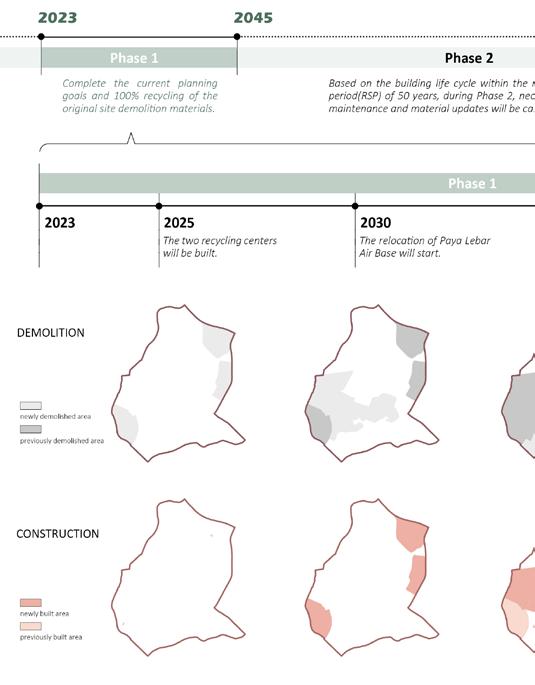
TIMELINE Sequential Development
88
reference studu necessary building carried out.
At the end of the life cycle, a new round of holistic demolition and recycling will begin.
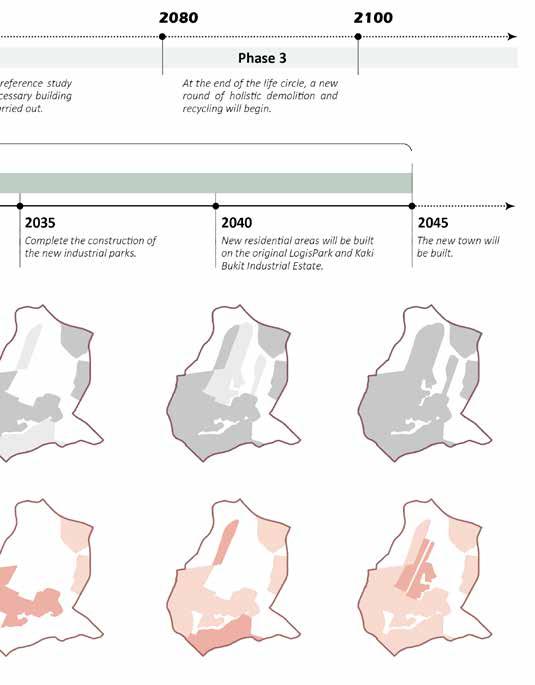
Comlete the construction of the new industrial parks.
New residential areas will be built on the original Logis Park and Kaki Bukit Industrial Estate.
The new town will be built.
89
REPOSITION
On-site Material & Energy Flow
Energy Plant & Sewage Treatment Facility
Co-generation Plant
Tipping Building
Material Bank
Solar Roof
Electricity
Electricity
CDW Input
Product Output
Foodwaste Input
Electricity from solar power
Electricity from foodwaste
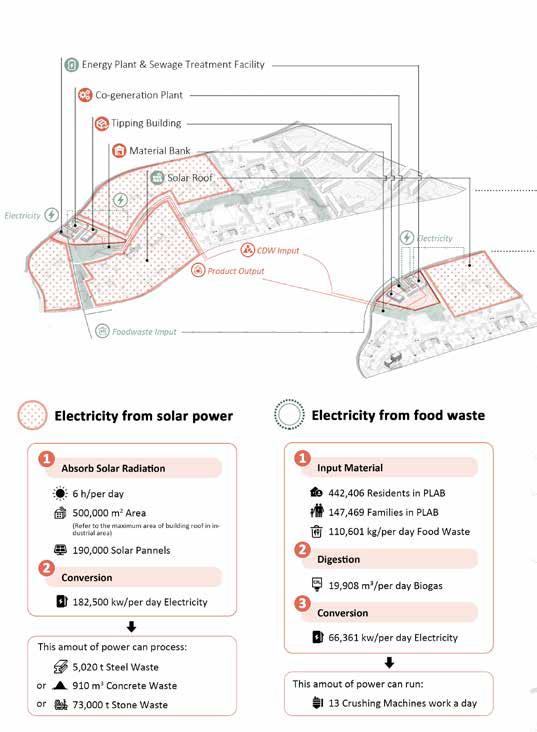
6 h/per day
500,500 m2 Area
(Refer to the maximum area of building roof in industrial area)
190,000 Solar Pannels
182,500 kw/per day Electricity
This amount of power can process:
5,020 t Steel Waste
910 m3 Concrete Waste
73,000 t Stone Waste or or
442,406 Residents in PLAB
147,469 Families in PLAB
110,601 kg/per day Foodwaste
19,908 m3/per day Biogas
66,361 kw/per day
Electricity
This amount of power can run:
13 Crushing Machines per day
90
Reposition Basis 1
A buffere zone of 500 meters is reserved between the recycling center and the residential area. Plant isolation belts are needed to reduce the impact of pollution on the living environment during the recycling process.

Reposition Basis 2
The material bank will be intergrated with the pocket garden from the plant group, making it not only a part of an industrial facility, but also a more comfortable public space.
Green Space
Recycling Center
Industrial Area
Solar Roof
Residential Buildings
Energy Flow
Inner Loop
Material Flow
500m Buffer
Food Waste Collection Point
@ New Defu Industrial Park
@ New Tampines Industrial Park
91
REPOSITION: ON-SITE RECYCLING CENTER & MATERIAL BANK













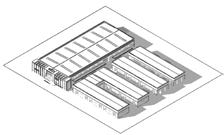

Material Processing Route Area of Recycling Center

Education Route

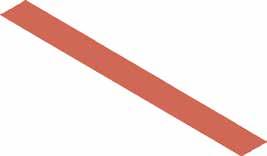
It can accommodate the recycled materials from about 200 buildings at the same time.
The comprehensive material recycling center integrates the resources of the original 5 single material recycling centers of PLAB, and expands the scale on the original basis. The integrated material recycling center is connected to the urban green space park. An educational route is designed inside the center to allow university visits to popularize material knowledge and enhance recycling awareness. Therefore, the material recycling center is not only an ordinary processing plant, but also can be repositioned as a green space and educational point of a city.
DEMOLITIONAREA
Processing Building Sta Building
Dumped and Sorting Building
≈2 Hectare 92
COMPREHENSIVERECYCLINGCENTER





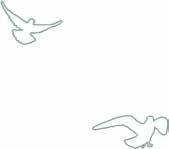

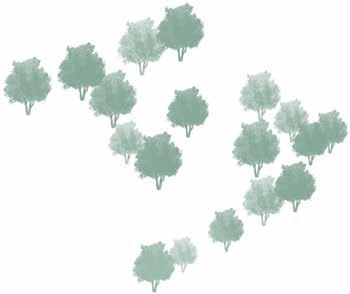

Processing Material Bank Education Center Public Green Space 2 3 4 93
Social
With the reduction of raw material sources the price of raw materials will inevitably disposing waste in landfills, continue It's much more expensive to send waste to recycle it. Innovation in materials, capabilities could all help create new the future, and also create new
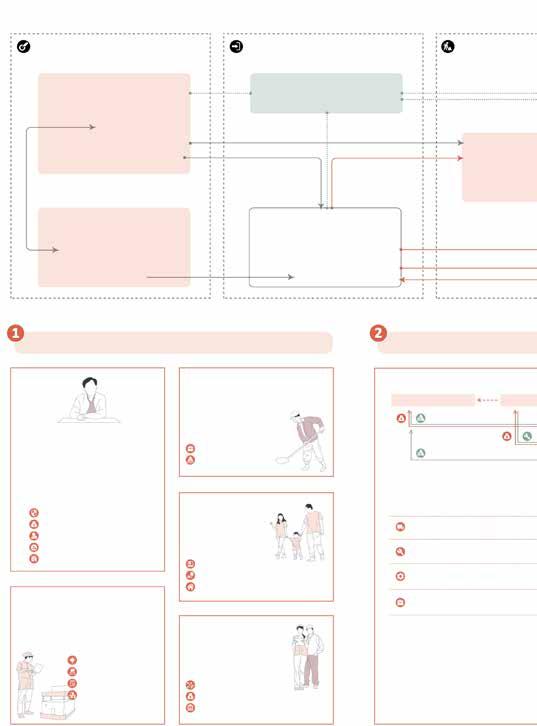
REVALUE Rental System Plan & Design Government Agencies Government Agencies Shared Information Platform Recycling Center MATERIAL BANK i.rent materials iii.return materials
Benefits Transaction QUALITY ASSESSMENT LEND & RENT MANAGE COORPERATE SUPPORT PUBLIC BIDDING CARRY Transportation Cost Process Cost Facility Cost Job Creation Workers Residents Construction Firms Designers & Researchers Designers & Researchers Procure Construct Demand: HDB, Nparks, URA,LTA Supply: RVA (Re-value Agency responsible for the whole process) 48+ Recycled Material Typologies 9+ Landscape Prototypes 1.5 One-north High-tech Park 600+ Eco-idustries 75000+ Employment 442,406 Residents 53,088 0-14 years 20years Lease Term 2 Material Banks 1.Liability 2.Economic Responsibility 3.Physical Responsibility 4.Ownership 5.Informative Responsibility 1.Innovation Base 2.Practice Base 3.Policy Support 4.Support DFD 1.Employment 2.Productivity 1.Education 2.Better Living Environment 3.Reliable Housing Information 1.Supply Chain 2.Lower Cost 3.Reliable Material Information EPR System HDB Nparks URA LTA Material ID Cards Material Bank Tipping Building Education Center R&D Center Architects Landscape Architects Engineers Researchers Re-value Agency A new agency responsible for the process Landfill ii.repair RVA AGENCY Economic Indicators of the Economic
markets Source: https://bettermeetscreality.com/is-recycling-economical-and-profitable/ 840,000,000$ X Construction Developer Construction firms 94
ASSESSMENT
Operate End of the lease of material
Users
Project Owner Projects
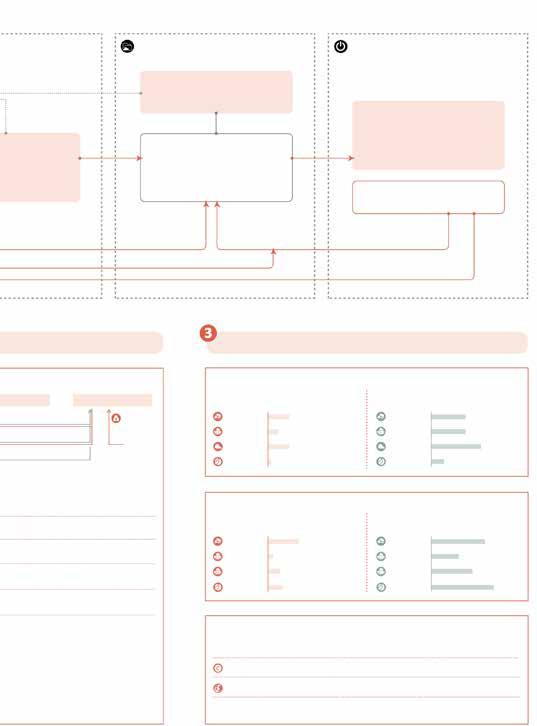
RVA:
"Whether to extend the lease"
Economic Benefits
Transaction Mode
AGENCY CONTRACTOR Clients
ii.repair materials
Economic Viability of Recycling
Landfill & Incineration Rental Recycling
90$/t
sources and the increase in market demand, inevitably rise. Tipping fees, which are fees for to rise as waste production increases. waste to landfill or incinerate it than it is product design and recycling system demand for some recycled materials in markets in some instances.
https://bettermeetscreality.com/is-recycling-economical-and-profitable/
Ecological Benefits
RETURN
1.Extend Material Lifespan without rental system without rental system
with rental system
2.Delay the Material Crisis
MAINTENANCE with rental system
3.Reduce Carbon Emissions
Source: https://doi.org/10.1016/j.egypro.2015.07.581
dump:4$/t 840,000,000$ X people/t 18$/t recycle:54$/t 25,200,000$ X+2 people/t Concrete Steel Stone Plastic CO2 Emission Landfill 100% 57.1% +6.22% -0.00144% Rental System Traditional Recycle Energy Saving 50+ years 25 years 50+ years 5 years YES NO 2092yr 2025 yr 2045 yr 2050 yr 200+ years 200+ years 300+ years 50+ years 2330 yr 2125 yr 2250 yr 2450 yr 52.9% +53.27% Concrete Silver Copper Plastic Concrete Silver Copper Plastic Concrete Steel Stone Plastic
Construction
Clients and residents Developer Nparks
Roads Parks Infrastructures Developer and industrial firms 95
PROTOTYPES
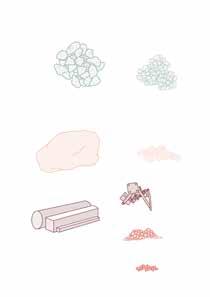

MATERIAL SIZE

Coarse aggregate > 4.75 mm
Fine aggregate < 4.75 mm (fine) Metal

PAVEMENT
Etched concrete
FURNITURE

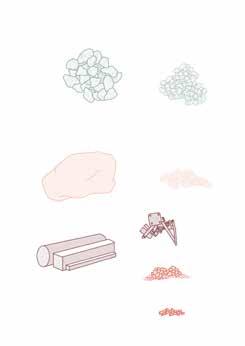
WALL BUILDING
Detachable concrete board












Wrinkled concrete
 Retaining wall
Detachable metal skin
Structured beam & joints
3D Printing
Road edge Undulating concrete
Retaining wall
Detachable metal skin
Structured beam & joints
3D Printing
Road edge Undulating concrete
3D Printing Reflective metal board Layered concrete Detachable steel structure
Perforated board Modular furniture REfresh 96
Grid

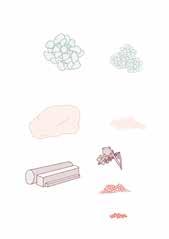
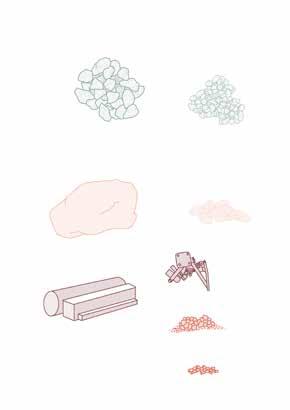

















Pellet
Planting
Luminous
Modular
Regular
Plastic
Noise
Rotatable
Temporary plastic
Modular
Hex
Steppingstone Plastic
97
Stone for gabion 100 - 200 mm Steppingstone > 650 mm
Stone wall
box Stone building
plastic box Cylindrical stool
plastic
stone
road
barrier
board Gabion building
structure
stone
podium
tile
TYPOLOGIES




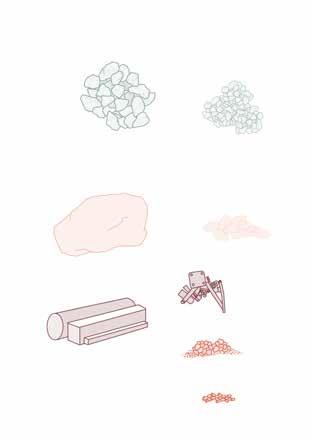
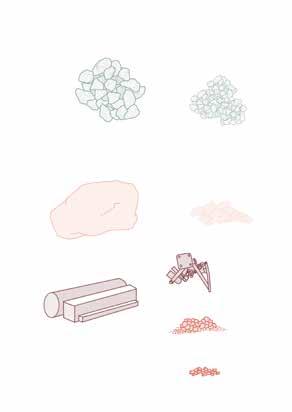
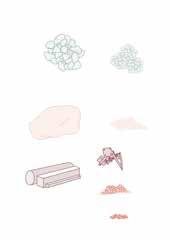
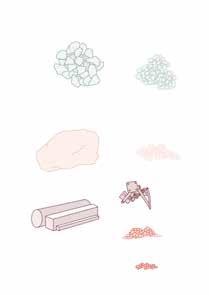
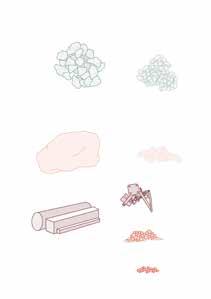
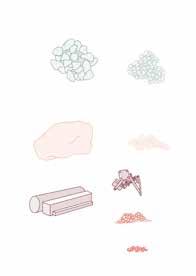
MATERIAL SEARCH CONCRETE STONE
RECYCLED FROM Selected
Historical landscape
Naturalistic landscape
Public landscape
EDUCATION METHODE
Raise awareness by observing the use of materials in design
Raise awareness through AR educational application
Raise awareness through activities of assembling materials
Coarse aggregate > 4.75 mm
Fine aggregate < 4.75 mm (fine) Metal
Stone for gabion 100 - 200 mm
REfresh Rain garden Birds corridor Ecological
98
Steppingstone > 650 mm Pellet
NAME
Prototype name



SCHEMATIC EDUCATION METHOD
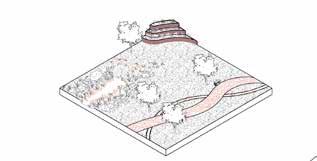
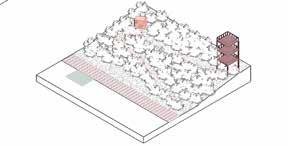
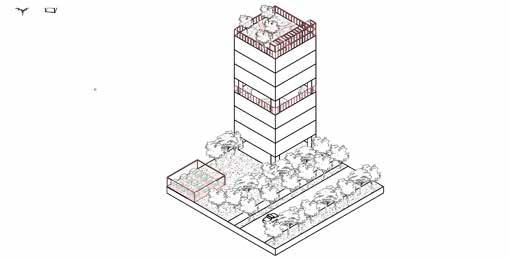
garden corridor Ecological park NAME
99
MATERIAL SEARCH




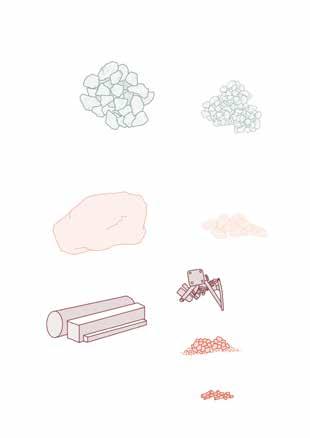




RECYCLED FROM Selected
CONCRETE
STONE
Historical landscape
Naturalistic landscape
Public landscape
EDUCATION METHOD
Raise awareness by observing the use of materials in design

Raise awareness through AR educational application
Raise awareness through activities of assembling materials
Coarse aggregate > 4.75 mm
Fine aggregate < 4.75 mm (fine) Metal
Memorial Exhibition Historical NAME 100
Stone for gabion 100 - 200 mm Steppingstone > 650 mm Pellet
TYPOLOGIES REfresh
Prototype name




SCHEMATIC EDUCATION METHOD
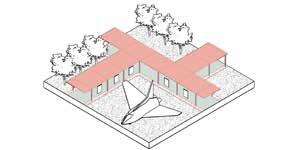
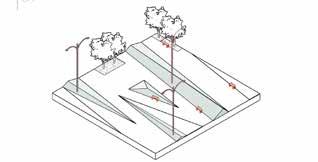
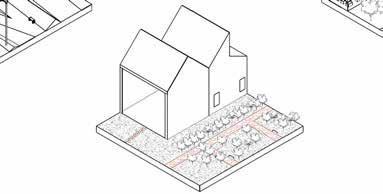
Memorial Exhibition Historical protection NAME
101
MATERIAL SEARCH CONCRETE
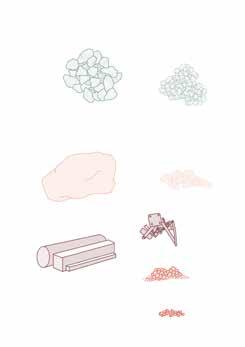

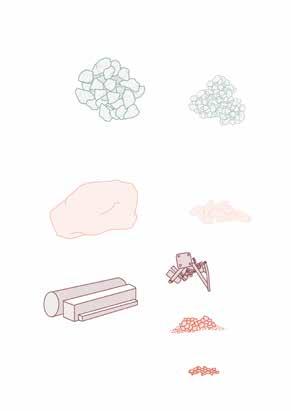

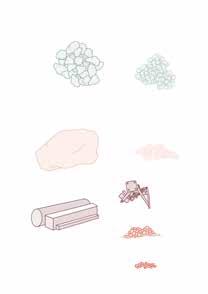
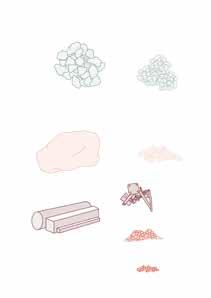
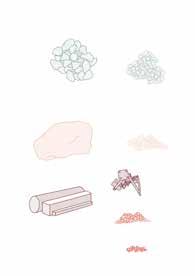
RECYCLED FROM Selected
STONE



Historical landscape
Naturalistic landscape
Public landscape
EDUCATION METHOD
Raise awareness by observing the use of materials in design
Raise awareness through AR educational application
Raise awareness through activities of assembling materials
Coarse aggregate > 4.75 mm
Fine aggregate < 4.75 mm (fine) Metal
Plaza
garden
Stone for gabion 100 - 200 mm Steppingstone > 650 mm Pellet
TYPOLOGIES REfresh
Fruit
NAME 102
Playground
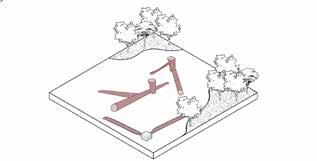
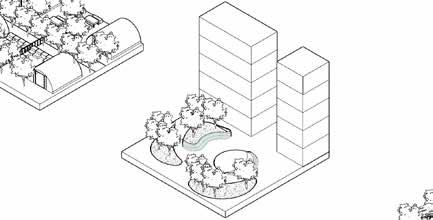
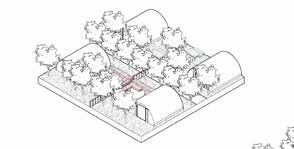



garden Playground NAME SCHEMATIC EDUCATION METHOD 103
Prototype name
MATERIAL FROM THE DEMOLITION
















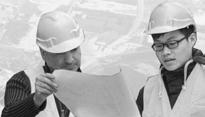
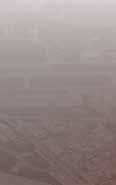
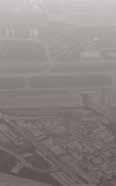
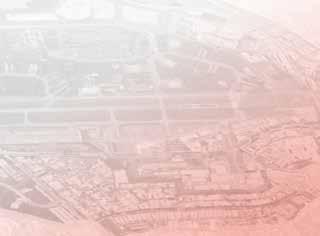
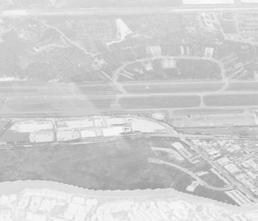








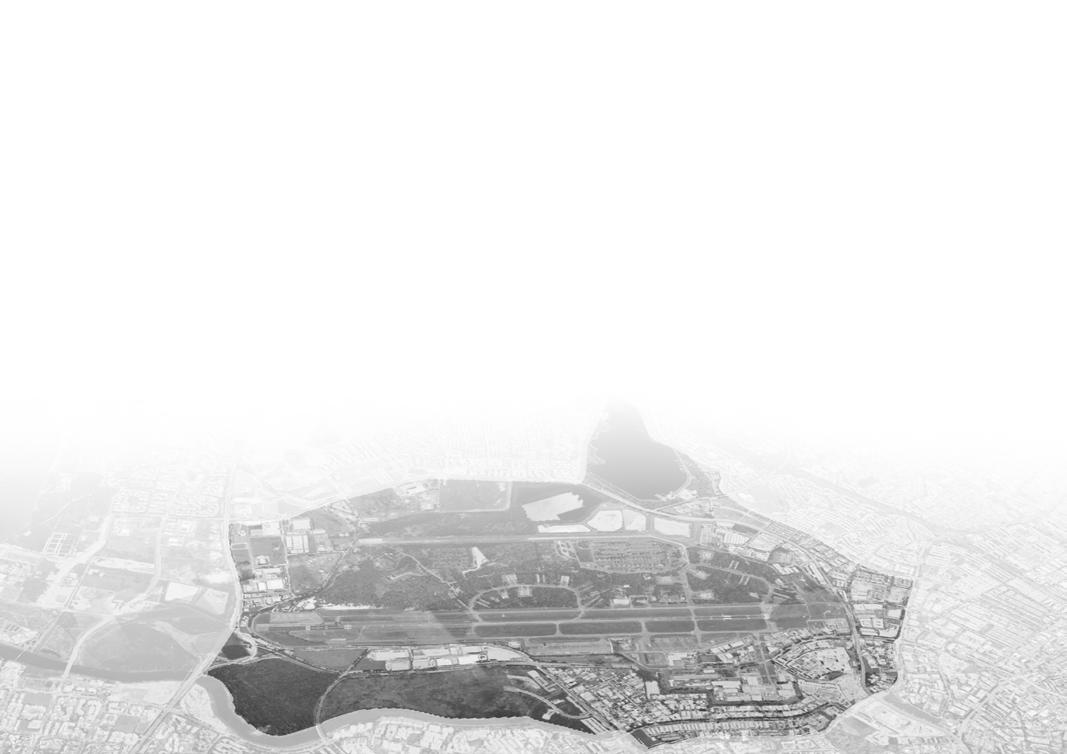
Concrete Stone Metal Plastic
104 ToTal demoliTion area = 827,000 m 2 = 16,540 indusTrial uniTs Total demolition material= 347,340 m³ = 139 swimming pools 451,903 T 69,558 T 2,119 T 85,278 T 25,106 3,864 118 recycling treatment reFerenCe 1 Swimming Pool ≈ 2500m³ 1 ≈ 10,423 18 t freight lorry 4,738 how much building material can we get from the demolition? deFu indusTrial esTaTe 899 BuildingS 3 floor average 16,540 uni ??? 827,000 m 2 * 3 1 m 2 fore 1
exiSting inefficient material recycling plant






















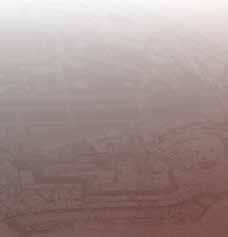















Concrete Stone Metal Plastic CO2 2 105 16,540 Ts 316,332 T 70% REPOSITION REVALUE REFRESH 70% 100% 80% 55,646 T 1,483 T 11,844 T oreSt ≈1.8 t Co2 / year 1 induStrial unit = 150 m 2 * 4 m (floor height) ≈ 500 18 t freight lorry 1 ≈ 50 18 t freight lorry demolition in 2025 ConStruCtion in 2030 heritage area regiStration in rental SyStem can be abSorbed by 7,288,100 m2 PlaB foreSt in 17 dayS total co : 638,858 T Co2
DESIGN ANALYSIS OF THE HERITAGE PARK


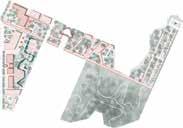
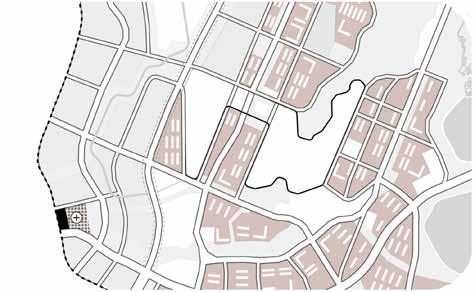
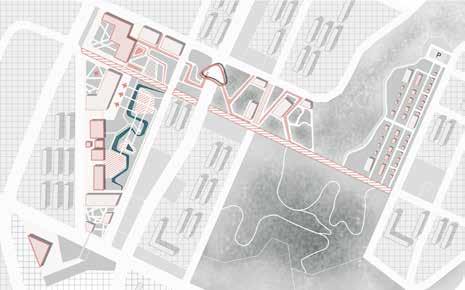
Transportation Route Analysis
2 Terminal Building
Hanger
Recreation Area PublicServiceArea Planting experience area EcologicalWalkingArea Cultural Exhibition Area Conserved Bunker
Runway
1 Inner Loop Road
Element
106
Material
Route
The Air Force Museum
Children
Retained
Route
Functional Zoning & Original
Analysis
Central Axis





Commercial Connection Community Axis Ecological Axis Locational Linkage Analysis Tour Route Analysis 107
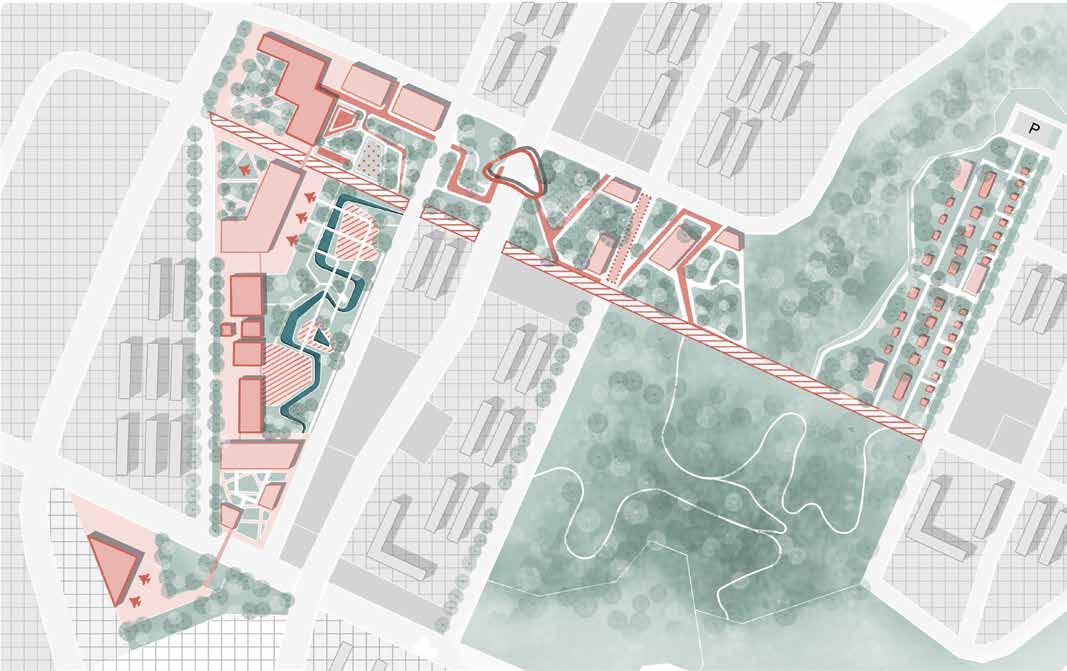
6 5 4 2 3 1 1 2 3 4 5 6 7 8 9 10 11 12 7 LEGEND The Air Force Museum Aerial Circular Plank Water Plaza Cafe Material playground Terminal Building
Retal Garden Hangar Retained Airplane Runway
Exhibition Hall
HERITAGE PARK MASTER PLAN
Citizen
History
City Forest
108
Ecological
Walk Area

8 9 11 10 12 0 50 100 200 500M N 109
HISTORICAL AREA
Heritage park redesign
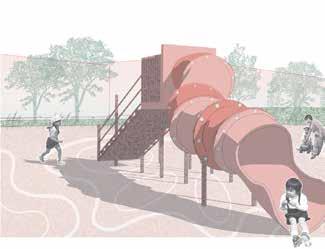

Overview of rental materials


In order to build the airbase historical area, I rented a total of...
How can recycled materials show the history and memory?
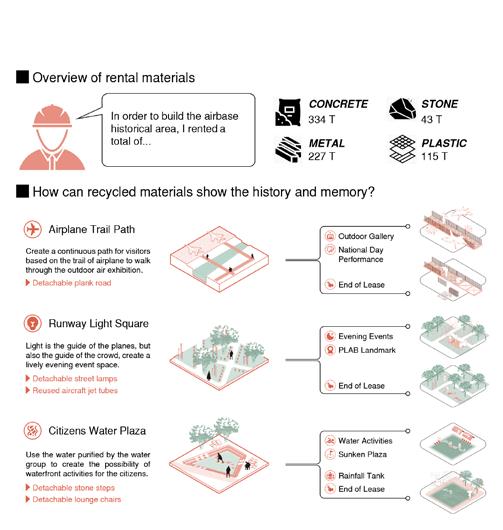
Airplan Trail Path
Create a continuous path for visitors based on the trail of airplane to walk through the outdoor air exhibition.
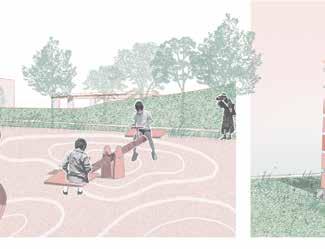
Detachable plank road
Runway Light Square








Light is the guide of the planes, but also the guide of the crowd, create a lively evening event space.
Detachable street lamps
Reused aircraft jet tubes
Citizens Water Plaza
Use the water purified by the water group to create the possibility of waterfront activities for the citizens.
Detachable stone steps

Detachable lounge chairs
Outdoor Gallery
National Day Perfomance
End of Lease
Evening Events
PLAB Landmark Sunken Plaza
Water Activities
Rainfall Tank
End of Lease
1 2 110
End of Lease
334 T METAL 227 T STONE 43 T PLASTIC 115 T How Detachable Detachable Detachable
CONCRETE
How to use recycled materials at this site?
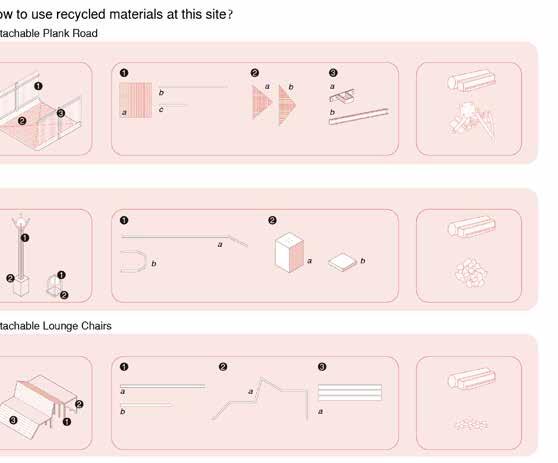

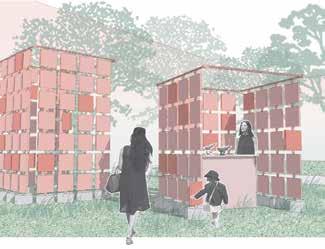

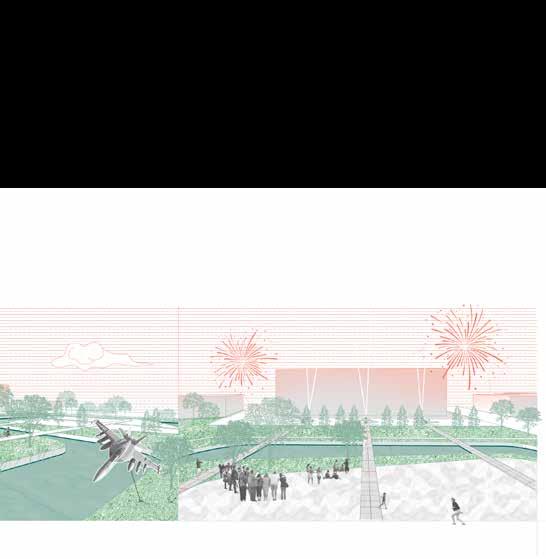
111
Plank Road Rail Structural Column Structural Column Shape Base Plastic Suface Concrete Base Pavement Connector Product Product Product Components Components Components Recycled Material Used Recycled Material Used Recycled Material Used Detachable Street Lamps Detachable Lounge Chairs
fence
handrail
structual
2.5m steet lamps b.for 0.5m garden lights a.40mm*40mm*460mm b.40mm*40mm*800mm a.customized according to seat and table height a.90mm*1500*2140mm plastic board a.for 2.5m steet lamps b.for 0.5m garden lights a.No.1 grid paving b.No.2 grid paving a.screw nut b.U-shaped steel recycled metal recycled metal recycled metal recycled concrete recycled plastic REPOSITION REVALUE REFRESH
Detachable
a.945mm*1025mm
b.2000mm
c.50mm*50mm*1260mm
a.for
RECREATIONAL AREA
In order to build the recreational area, I rented a total of...


















How to make playgrounds with recycled materials?






Metal is suitable for making some small-scale amusement equipments.
Metal climbing frame
Metal swing
Concrete is very strong and suitable as a base.















Concrete skatepark
Concrete steppers
Plastic is light in weight, so it can be used as a large-scale amusement equipments.
Plastic slide
Plastic seesaw
Stone is a relatively natural material, suitable for wild-shaped amusement facilities.
Stepping stone
Stone climbing wall
1 2 1 2 1 2 112
rental materials
Concrete Plastic Stone CONCRETE 926 T METAL 0.4 T STONE 38 T PLASTIC 39 T
Heritage park redesign
Overview of
Metal
60cm Metal
How Slide Temporary 20cm Plastic 10cm Concrete
How to use recycled materials at this site?









1 1 1 1 2 2 3 3 2 2 1 1 1 1 2 2 3 3 2 2 1 1 1 1 2 2 3 3 2 2 113 60cm Metal REPOSITION REVALUE REFRESH
Slide Temporary stall 20cm Plastic 10cm Concrete 110cmMetal Plastic Bolt mechanism Embedded installation Embedded installation Embedded installation Rotatable plastic plate Bolt mechanism Bolt mechanism Bolt mechanism
PUBLIC AND ECOLOGICAL AREA
Overview
In order to build the public area and ecological area, I rented a total of...
















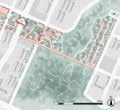























































Where did the shape of this area come from?




























Central axis
Original contour lines



How to use recycled materials at this site?



Public area
Public area creates a relatively quiet atmosphere, allowing people to have a resting space with outdoor furniture made with recycled material.
Shape of plane

Final design
Ecological area








In the ecological area, the recycled material used is mostly stone. Because they can better integrate into the natural environment.

park
1 1 1 1 1 1 114
Heritage
redesign
CONCRETE 2428 T METAL 26 T STONE 226 T PLASTIC 4 T
of rental materials
How The Lawn
How to use recycled materials at this site?







The original demolition waste is added to let people intuitively feel the possibility of recycled material.

3 2 1 1 1 1 1 3 2 1 1 1 1 1 3 2 1 1 1 1 1 115 REPOSITION REVALUE REFRESH
Lawn Lamp 1cm Transparent plastic 5cm Transparent plastic 10cm Metal 50cm Transparent plastic Reinforced concrete 50cm Plastic 50cm Stone 90° 100cm Guide Sign Bench Transparent plastic Demolition waste: stone Trough for storing stones Stone bench base Bolt mechanism Bolt mechanism Bolt mechanism Original reinforced concrete Engraved plastic board Transparent plastic cap
plastic cylinder for storing plastic pellet
plastic cylinder for storing the lamp Plastic pellet
Transparent
Transparent
FRUIT AND VEGETABLE GARDEN
Overview of rental materials


In order to build the vegetable and fruit garden area, I rented a total of...
How people interact with the material?

Visitors
When the lease expires
Rental House
Procedures for leasing
Choosing the material of the planter box
Picking the seeds you want to grow
Teaching how to splice planter boxes
Handle rental cancellation procedures

Disassemble and clean the planter box
Help customers transport materials to the corresponding garden


Harvest fruits and vegetables
Eat by themselves
Sell to market
Assemble and Decorate
Fruit and Vegetable garden

Take care of fruits and vegetables
Have a dinner party
Participate in festivals
220 T METAL 36 T STONE 7 T PLASTIC 7 T
CONCRETE
Structural
Metals Alphabet Other 116
How Detachable
Replaceable
How to use recycled materials at this site?




Structural Analysis

Detachable Planter Box
Replaceable Recycled Metals Sheets Small Planter Box Lettuce Carrots 100mm 400mm Mint Rose mary Potato 100mm 400mm 200mm Bay leaf Tomato Parsley 100mm 500mm 200mm Basil Lemon Thyme 100mm 600mm 300mm Medium Planter Box Large Planter Box Alphabet Plastic Modules Compound Flower Stand Replaceable Free to Draw Replaceable Steel Available for climbing plants Recycled plastic clapboard Other Small Structure 117
AFTER THE LEASE
SITUATION1: Renew the lease
These iron sheets require maintenance procedures such as grinding and polishing, which are much cheaper than remanufacturing.
Some planter boxes in the fruit garden needs to be updated, and these materials will be returned here after maintenance.
When the lease expires, some managers want to continue to use these materials, but some need maintenance, they can choose to renew the lease.
SITUATION2: End the lease
This area will be planned as a residential area, so the landscape structure here needs to be demolished.
Once these materials enter the recycling cleaning, repair, sanding and polishing
Some of the recovered materials of acceptable quality for maintenance, while the other is crushed and recycled.
Some sites will be demolished or refurbished, so the manager has opted to end the lease. Therefore, all the landscape structures of the site will be transported back to the recycling center.
Since most of the landscape structures ditachable, after dismantling, some used in their original functions for part will be processed into raw materials.
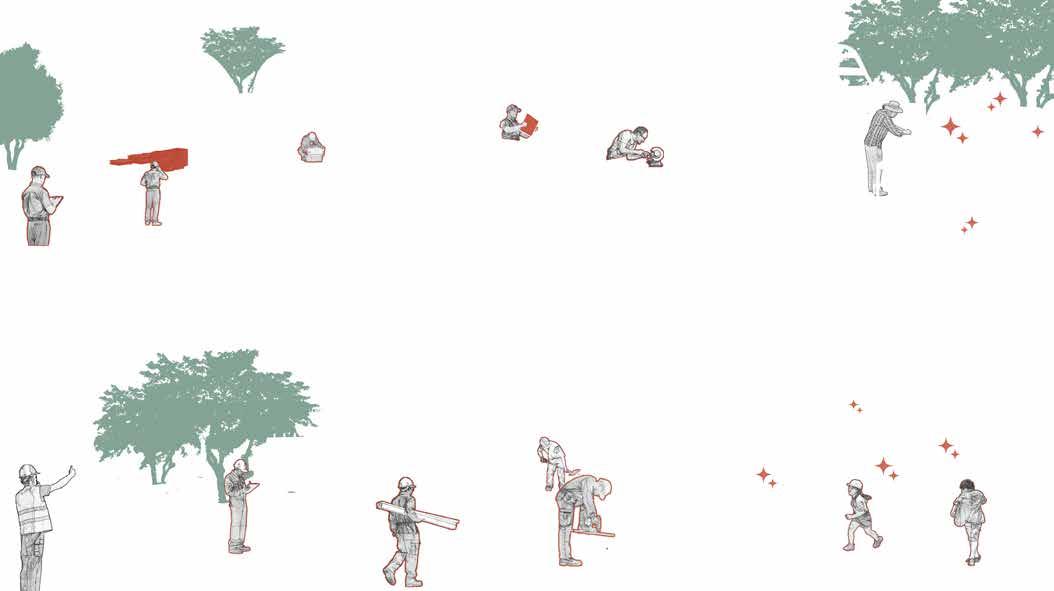
118
The detachable planting box is more convenient for material maintenance.
recycling center, only simple polishing operations are carried out.
After maintenance, these materials will be returned to the original site and maintain the original function.
materials are maintenance, recycled.
I heard that these rides are made of recyclable plastic. so eco-friendly!!
structures will be designed to be some materials will continue to be simple maintenance. Another materials.
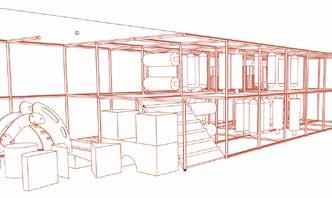
When a new site needs to be built, these materials will be leased again. And it will continue its life cycle with new functionality.

119
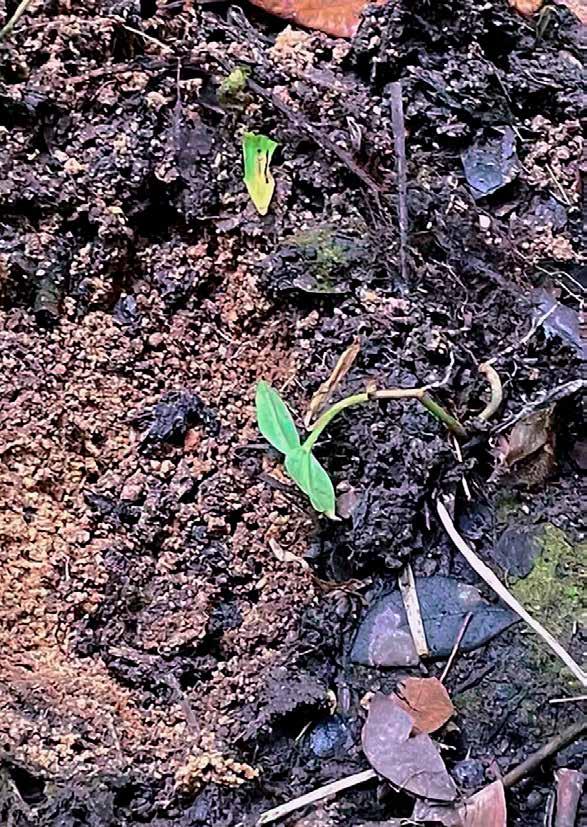
It takes about 300 years or more to form 1 cm thick soil on the earth's surface, so the soil is an extremely valuable resource for human beings.
120
-Eduardo Mansur , FAO
LAND & SOIL MANAGEMENT
THINK AND INTERFERE THROUGH SOIL
Both land and soil are scarce resources for Singapore. With limited resources, Singapore needs to rely on a lot of imports. In addition, in order to meet the high-density population living on the limited land, Singapore needs to continuously carry out urban renewal. In this process, some environmental or social Issues will arise. The relocation of PLAB will provide new opportunities for the development of new towns in Singapore, but the remaining problems of Land and Soil still need to be solved urgently. We plan our strategy in two stages. Handing soil, land, and even social issues. Hope to create a Happy and resilient new model town based on sustainable land and soil management.
Our target is to solve or alleviate the above issues through land and soil intervention. And we made a twostage strategy. The first stage is soil regeneration. Remediate contaminated soil to Plantable soil. The second stage is agriculture Urbanism. Using regenerated soil for food production through the establishment of the PLAB agricultural network with 3 typology. Agriculture park for town level,mixed-use units for estate level, and agricultural street scape for block level.
Intervention through our strategy, we will regenerate about 100,250m³ of agricultural soil through soil regeneration and formed a closed loop of soil transportation within PLAB. We have added about 95 hectares of land for food production by establishing the PLAB agricultural infrastructure network. At the same time, ecological benefits are generated through the operation of these two systems, and it can also promote community participation.
Wang Yu, Zhang Wenting, Liu Kangsheng
121
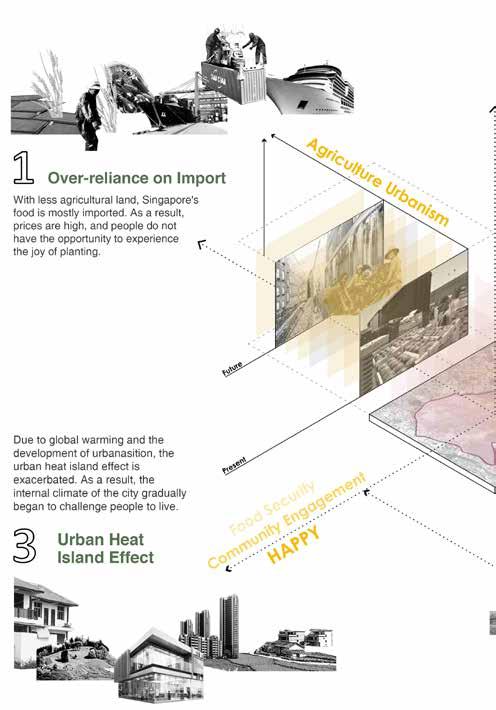
ISSUE & VISION & TARGET 122
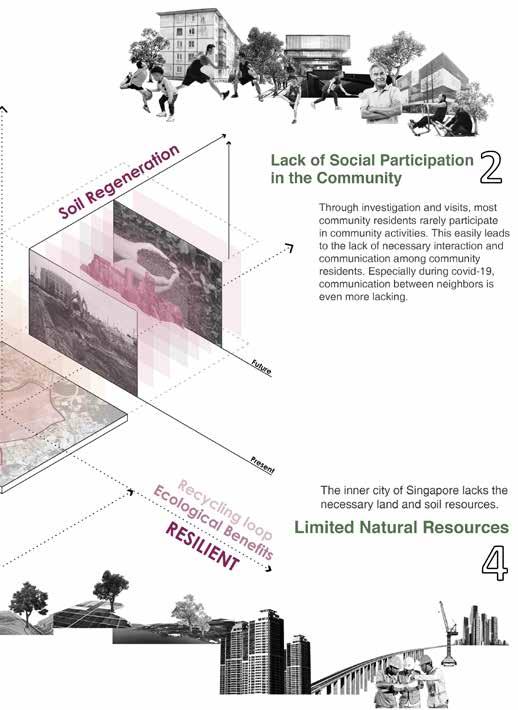
123
SOIL AND LAND CLASSIFICATION
Layer of ground classification
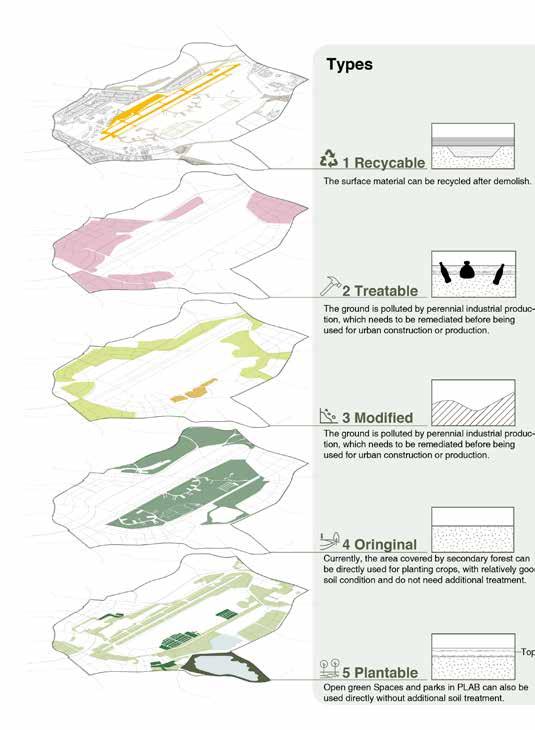
124
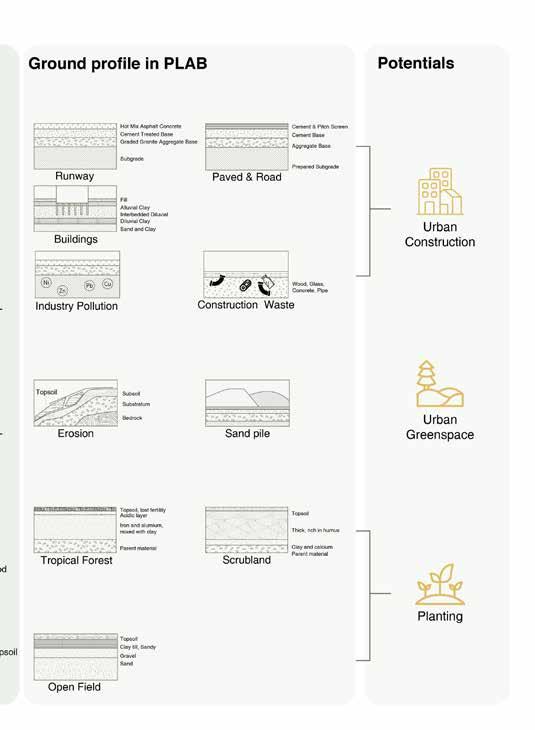
125
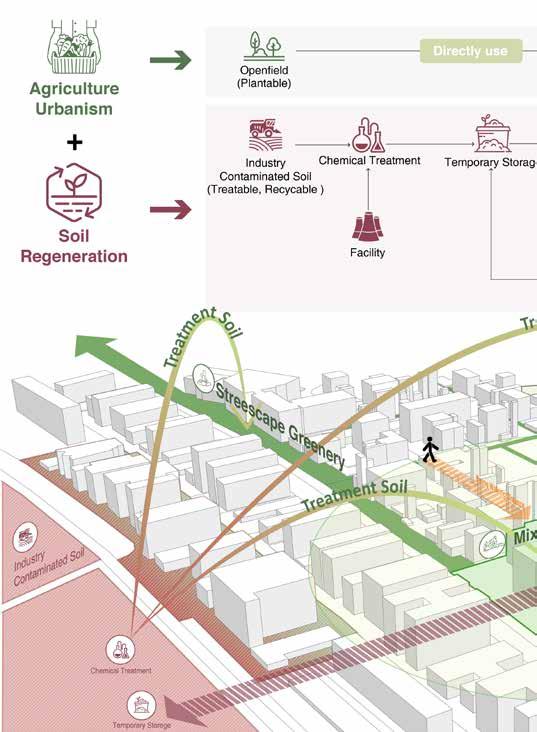
126
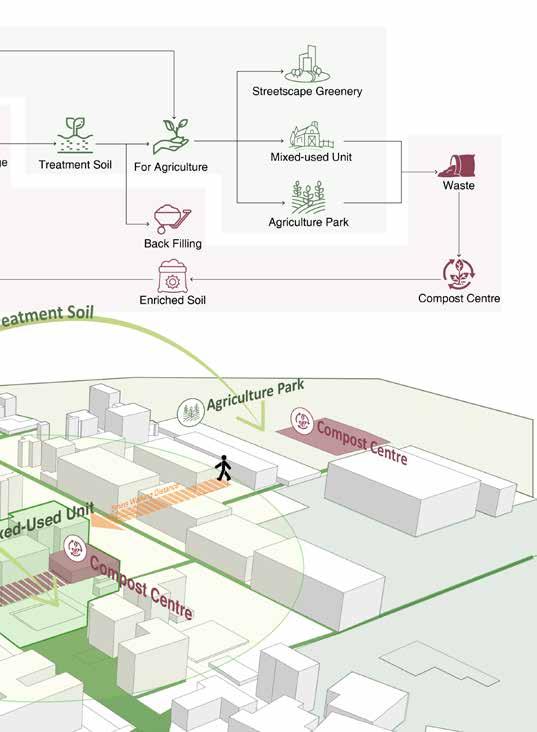
127
SOIL REGENERATION

Contaminated S


Soil Excavation
Transportation


SOIL STABILIZATION
Screening and Crushing
Heavy metal pollution
Soil Chemical Treatment







Organic Pollution

Self-check Passed Accepted
Temporary Storage Backfilling
the dust net Compost
Restoration Workshop Cover
and Crushing, Adding repairing agent, Mixing Soil To Be Inspected Agriculture Usage 128
SOIL OXIDATION Sieving
PHASING PHASE 1 PHASE 2 41.0 ha 102,500 m≥ ≥ 8.2 ha 20,500 m≥ 4.5 ha 11,250 m≥ 82,000 m≥ 73,000 m≥ 33.7 ha 84,250 m≥ TREATMENT EXCESS 113,750 m≥ AGRICULTURAL CONSUME 32,250 m≥ Defu Industrial Park Par t 1 Defu Industrial Park Par t 2 Tampines Industrial Park New Agriculture Park New Agriculture Park Paya Lebar Air Base Par t 1 New Green Space (B) Chemical Remediation (A) Excess (A-B) 2.7 ha 6,750m≥ 10.2 ha 25,500m≥ Treated Soil For Agriculture 43.7 ha h 102500 m≥ 0 9.4 ha a 23500 m≥ 0 0 ha a 0 m≥ m 85750 m≥ 0 48250m≥ 2 19.3 ha 48250 m≥ 2 New Green Space (B) Chemical Remediation (A) TREATMENT EXCESS 155,000 m≥ Excess (A-B) 0 ha 0 m≥ 65500m≥ 26.2 ha 65500 m≥ New Green Space (B) Chemical Remediation (A) Excess (A-B) 32.3ha 807,50m≥ 0 ha 0 m≥ 4.5 ha 11,250 m≥ 80,750m≥ 33,000 m≥ 28.2 ha 84,250 m≥ New Green N Space (B) Chemical C Remediation (A) m Excess (A-B) AGRICULTURAL CONSUME 26750 m≥ 5.2 ha 13000m≥ 5.5 ha 13750m≥ Treated Soil For Agriculture AGRICULTURAL CONSUME 25750 m≥ 10.3 ha 25750m≥ Treated Soil For Agriculture Agricultural Street Scape Formed AGRICULTURAL CONSUME 15,500 m≥ 6.2 ha 15,500m≥ 0 ha 0m≥ Treated Soil For Agriculture Green Space New Green Space Under-treatment rAea Treated A rea New Edibale Garden New Agriculture Treated Area Mix-used Units New Agricultu re Treated A rea Green St reetscape PHASE 1 PHASE 2 PHASE 3 PHASE 4 41.0 ha 102,500 m≥ ≥ 8.2 ha 20,500 m≥ 4.5 ha 11,250 m≥ 82 000 m≥ 73,000 m≥ 33.7 ha 84,250 m≥ TREATMENT EXCESS 134000 m≥ TREATMENT EXCESS 113,750 m≥ 32,250 m≥ Defu Industrial Park Par t 1 Defu Industrial Park Par t 2 Kakit Bukit Industrial Park Tampines Industrial Park New Agriculture Park Paya Lebar Air Base Par t 1 PAYA LEBAR AIR BASE PART2 PAYA LEBAR AIR BASE PART3 New Green Space (B) Chemical Remediation (A) Excess (A-B) 43.7 ha h 102500 m≥ 0 9.4 ha a 23500 m≥ 0 0 ha a 0 m≥ m 85750 m≥ 0 48250m≥ 2 19.3 ha 48250 m≥ 2 New Green Space (B) Chemical Remediation (A) TREATMENT EXCESS 155,000 m≥ Excess (A-B) TREATMENT EXCESS 65500 m≥ 0 ha 0 m≥ 65500m≥ 26.2 ha 65500 m≥ New Green Space (B) Chemical Remediation (A) Excess (A-B) 32.3ha 807,50m≥ 0 ha 0 m≥ 4.5 ha 11,250 m≥ 80 750m≥ 33,000 m≥ 28.2 ha 84,250 m≥ New Green N Space (B) Chemical C Remediation (A) m Excess (A-B) AGRICULTURAL CONSUME 26750 m≥ 5.2 ha 13000m≥ 5.5 ha 13750m≥ Treated Soil For Agriculture AGRICULTURAL CONSUME 25750 m≥ 10.3 ha 25750m≥ Treated Soil For Agriculture Agricultural Street Scape Formed Green Space New Green Space Under-treatment rAea Treated A rea Green Space New Green Space Under-treatment rAea Treated A rea New Edibale Garden New Agriculture Treated Area Mix-used Units New Agricultu re Treated A rea Green St reetscape 129
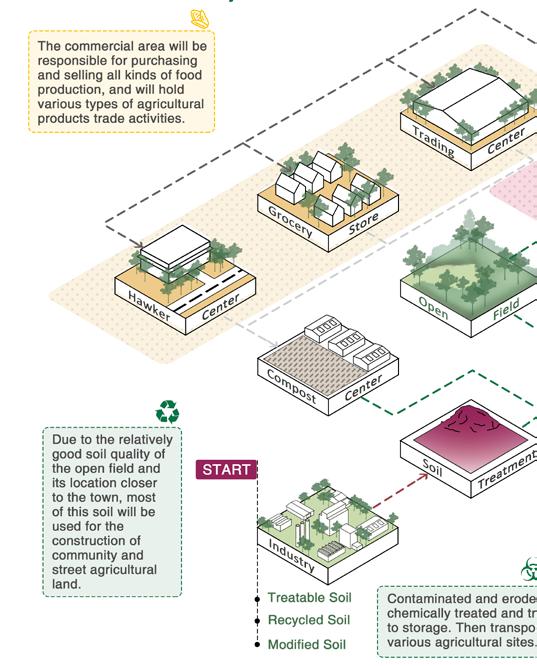
SOIL & FOOD PRODUCTION FLOW 130
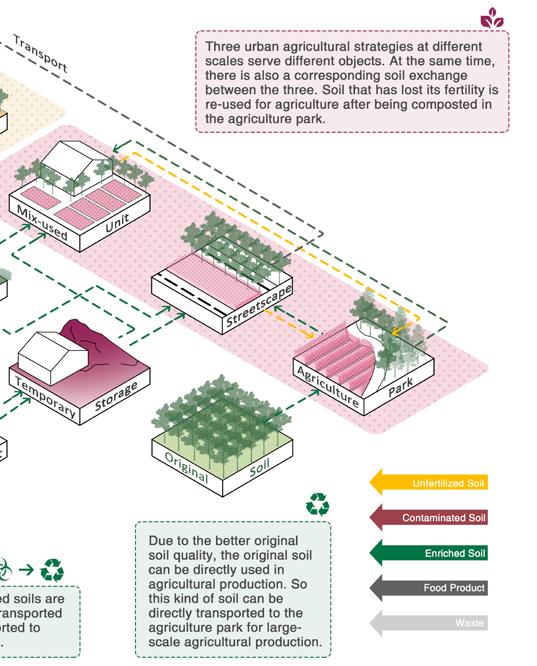
131
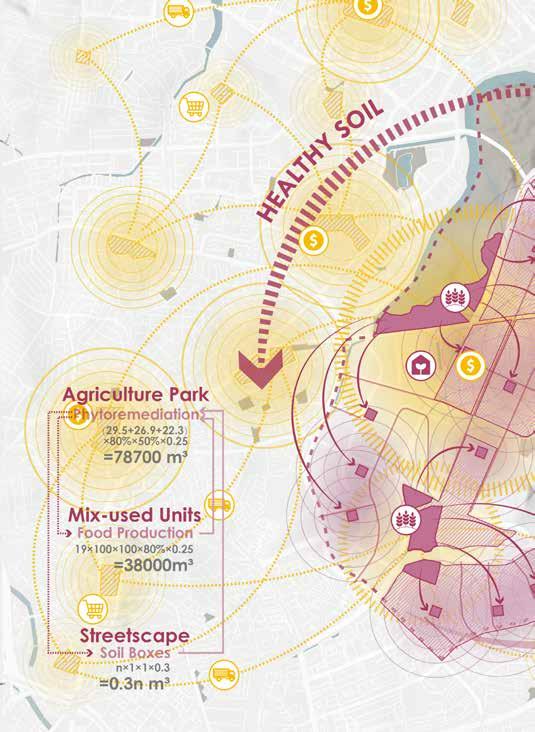
SOIL
132
RECYCLING SYSTEM
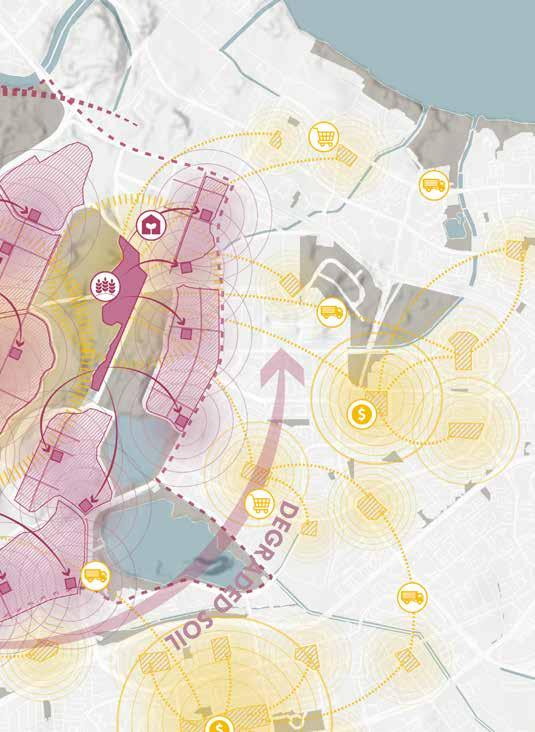
FOOD TRANSPORT SYSTEM 133
AGRICULTURE PARK SCENARIO
t he agricultural park i S in the original S oil area , the S oil i S in good condition and doeS not require additional treatment before being uSed for ProduCtion. the area uSed for ProduCtion aCCountS for 80%. and ComBined high-tech agriculture and traditional agriculture the phytoremediation area mainly u S e S the method of plant management to regenerate the fertility of the Soil that haS loSt itS fertility in the other part of the agriculture park at the Same time, the creation area in the agricultural park enhanceS Social participation and connection
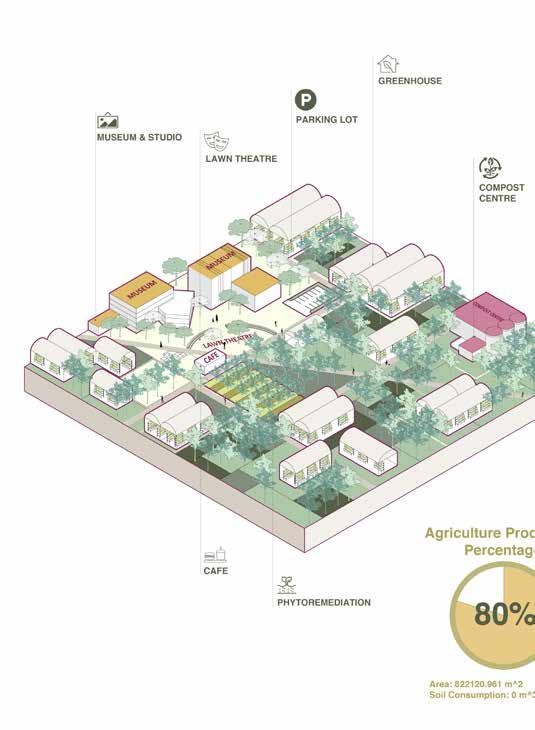
134

135
MIXED-USE UNIT SCENARIO
the main PurPoSe of the mixed-uSe unit iS to Serve the eState within 5 minuteS of walking diStance. the production area in each mixed-uSe unit a CC ount S for 70%. h igh - te C h agri C ulture and traditional agri C ulture are combined compoSt centre and rainwater harveSt provide mixed-uSe unit with fertilizer and water for agricultural production community committeeS increaSe connectivity and participation between communitieS, and the food court in the mixed-uSe unit uSeS agricultural productS produced in the unit to achieve "field to table".
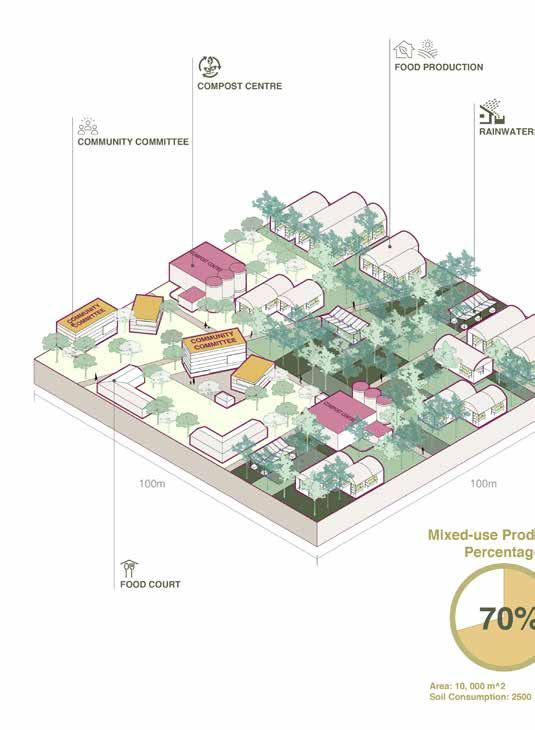
136

137
AGRICULTURE STREETSCAPE SCENARIO
S treet S cape agriculture i S mainly u S ed to S erve the S urrounding communitieS and meet the daily needS of Surrounding reSidentS part of the roof of the buildingS next to the Street iS put into uSe and becomeS roof farming the Soil uSed for planting comeS from the clean Soil after remediation , and the rainwater harve S ting device and compo S t center provide water and fertilizer for plant growth. Street retail can Sell the productS be en produced along the StreetScape.

138
Module Furniture
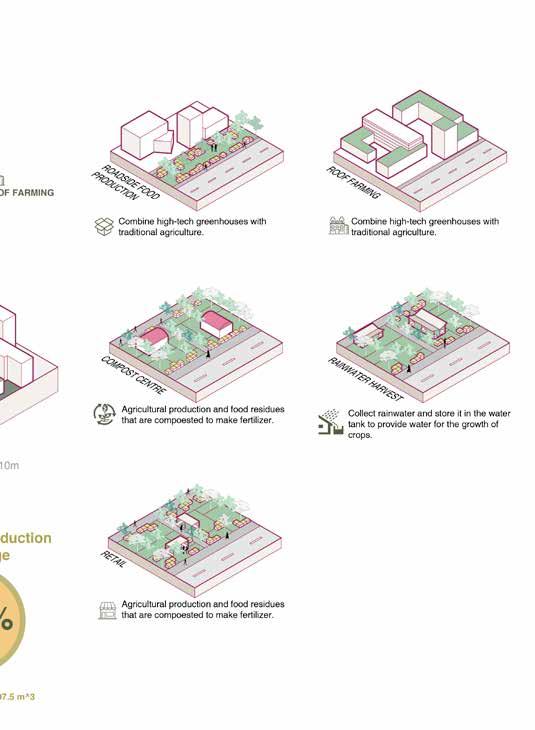
139
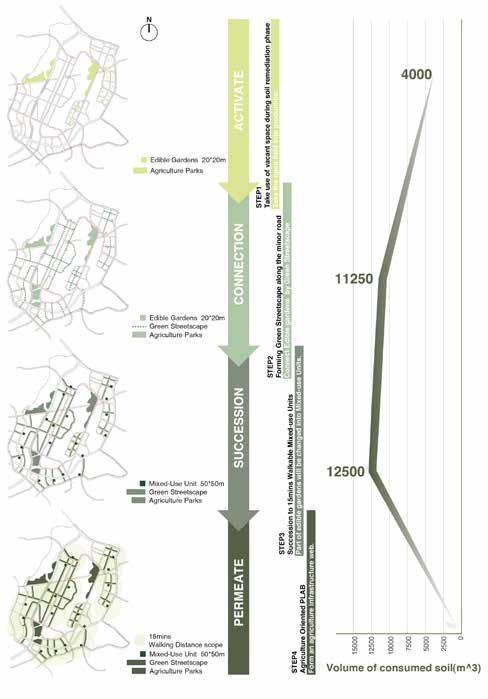
140
AGRICULTURE INFRASTRUCTURE WEB PHASING


MASTER PLAN 141
DETAIL DESIGN: AGRICULTURE STREETSCAPE
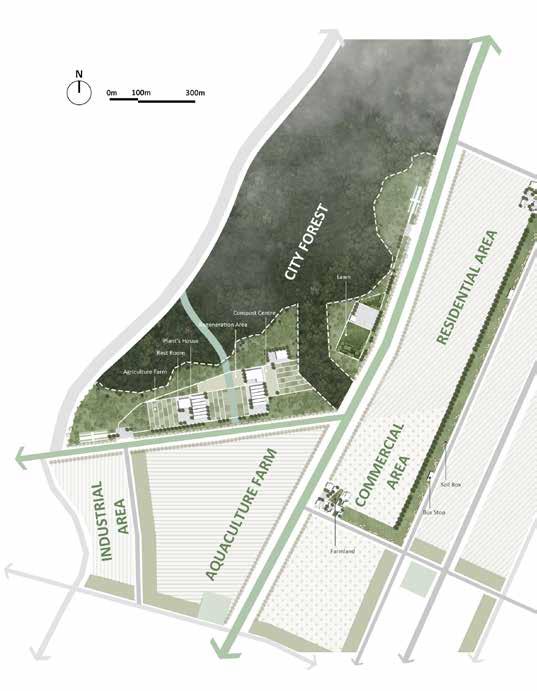
Furniture
Module
142

Soil boxes DETAIL DESIGN: AGRICULTURE STREETSCAPE Original Soil Treatable Soil Plantable Soil Recycable Soil Industrial Area LogisticsP ark Serango o nF orest Pay a -LebarA irBase Developing urban agriculture in non-ecological core areas Plantable soil develop Agriculture in situ Recycable&Treatable soil regenerated to plantable soil Treatment Facilities 12500m≥ 24500m≥ Agriculture Park Mix-used Units Streetscape Residential Area CoreHabitat AquaFarm Commercial Area 29.5 ha 3◊1=3 ha 1 CURRENTLY 2 RENEWAL 3 FUTURE Soil Regeneration Agriculture Urbanism 143
DETAIL DESIGN: AGRICULTURE PARK

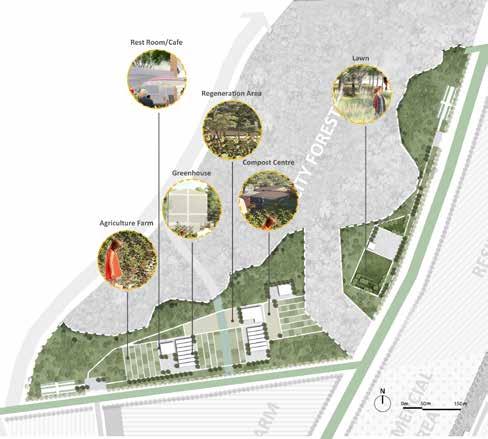
Detail Masterplan 144




DETAIL DESIGN: AGRICULTURE PARK Design Analysis 145
DETAIL DESIGN: AGRICULTURE PARK

Perspective of Agriculture Farm 146

147
Legend
DETAIL DESIGN: AGRICULTURE PARK
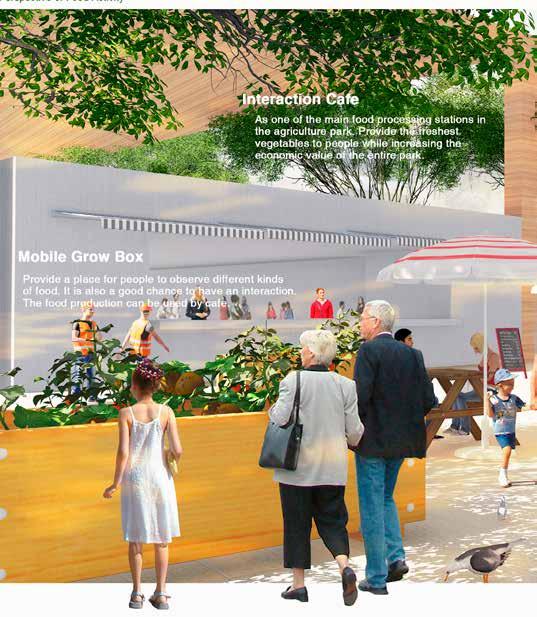
of Food Activity 148
Perspective
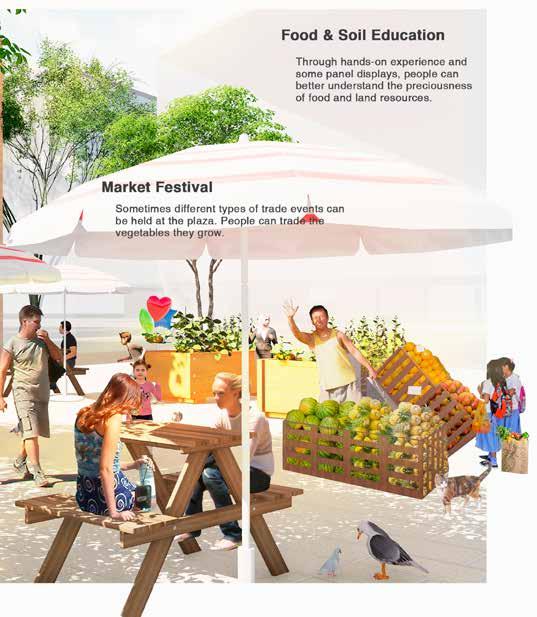
149
DETAIL DESIGN: MIXED-USE UNIT
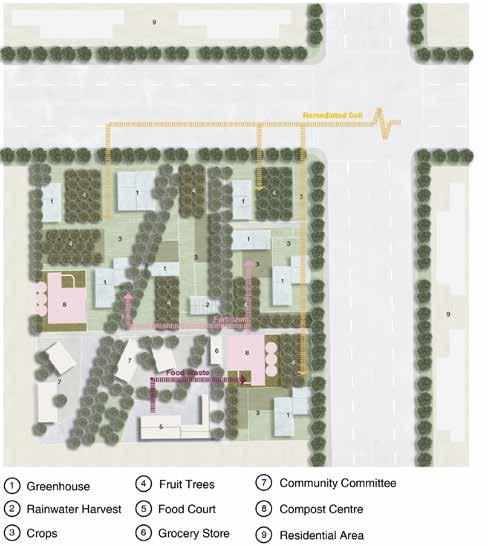
m ixed - u S e u nit S erve S the S urrounding C ommunity within a 15- minute walking radiu S . agricultural production iS mainly to meet the needS of daily life the productS mainly include baSic common vegetableS and fruitS

i n addition to focu S ing on agricultural production , m ixed - u S e u nit al S o focu S e S on Strengthening the connection between communitieS, which iS different from community centre in the traditional SenSe by participating in agricultural activitieS, community reSidentS are more cloSely connected, and community functionS are enriched.
S uch m ixed - u S e u nit S are evenly di S tributed near each re S idential area group of plab , enSuring that each reSidential area of plab can be covered by the Service Scope of mixeduSe unit, Strengthening communication between communitieS, and enhancing the diverSity of community activitieS
Master Plan
150

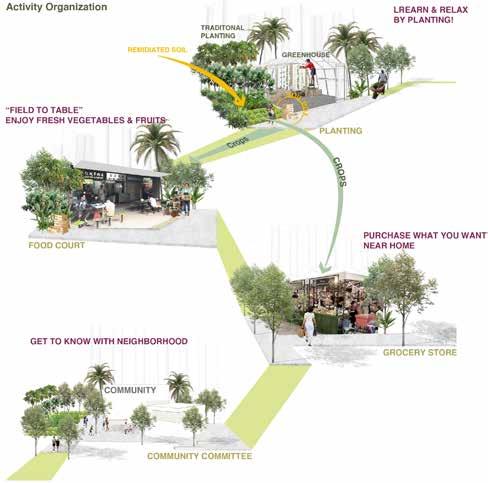
Activities DETAIL DESIGN: MIXED-USE UNIT 151
DETAIL DESIGN: MIXED-USE UNIT
t he community committee regularly organize S a variety of plant - themed activitie S to attract more people participate and Strengthen the connection between reSidentS in the community
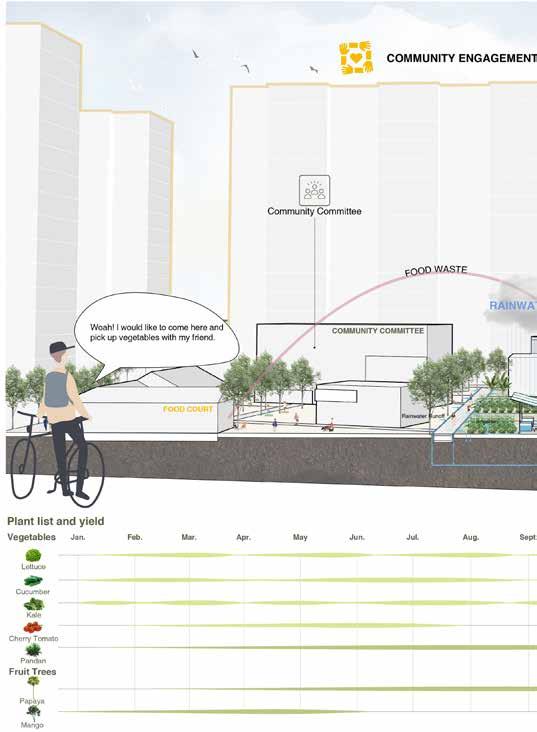
Section
152
regularly themed people to connection
a gricultural production provide S the community with the daily neceSSitieS of freSh vegetableS and fruitS community reSidentS can pick agricultural productS at their doorStep.
t he food wa S te and potential extra agricultural productS generated by the community are degraded to provide the neceSSary fertilizer for planting
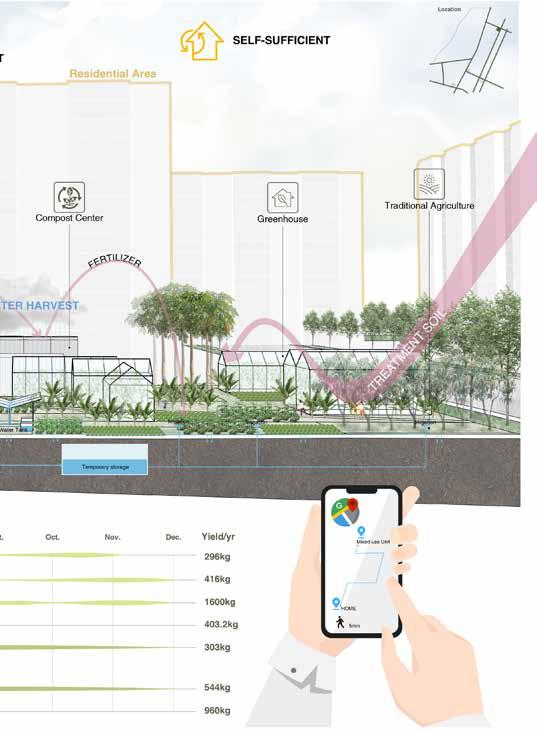
153
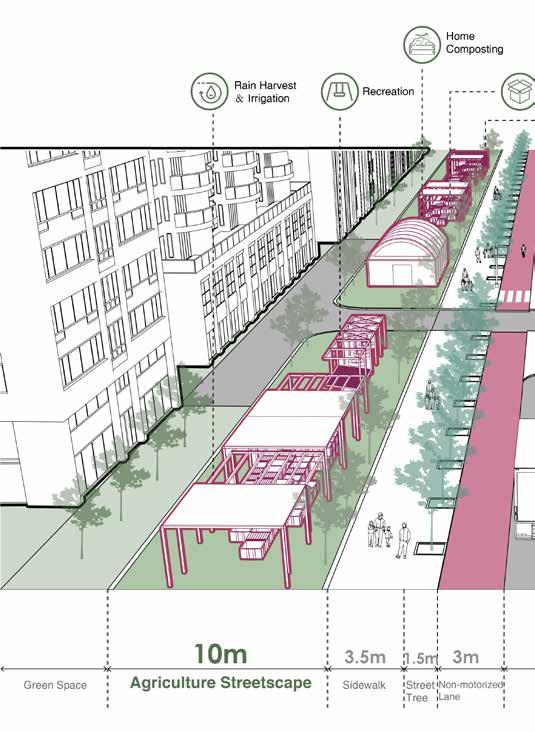
154

155
DETAIL DESIGN: AGRICULTURE STREETSCAPE
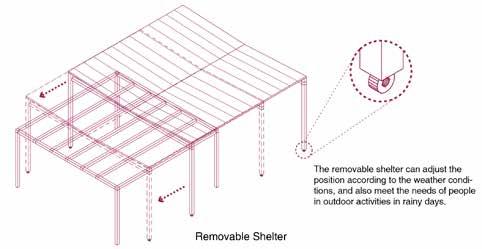
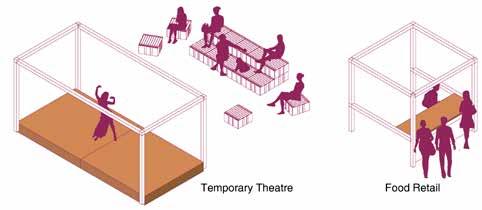

Furniture
Module
156
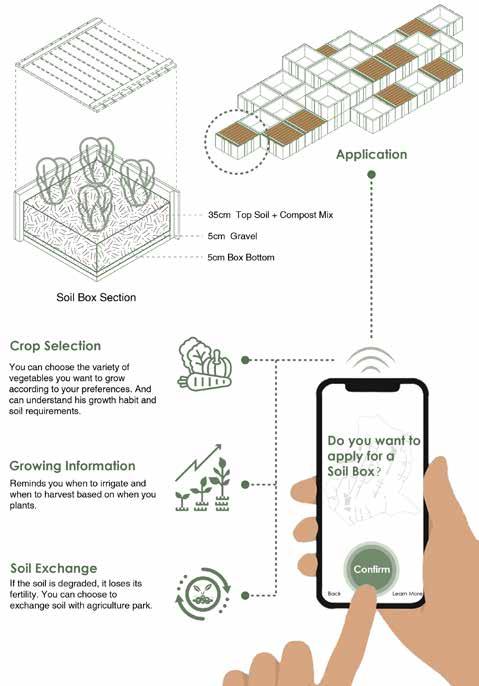
Soil boxes DETAIL
AGRICULTURE STREETSCAPE 157
DESIGN:

158
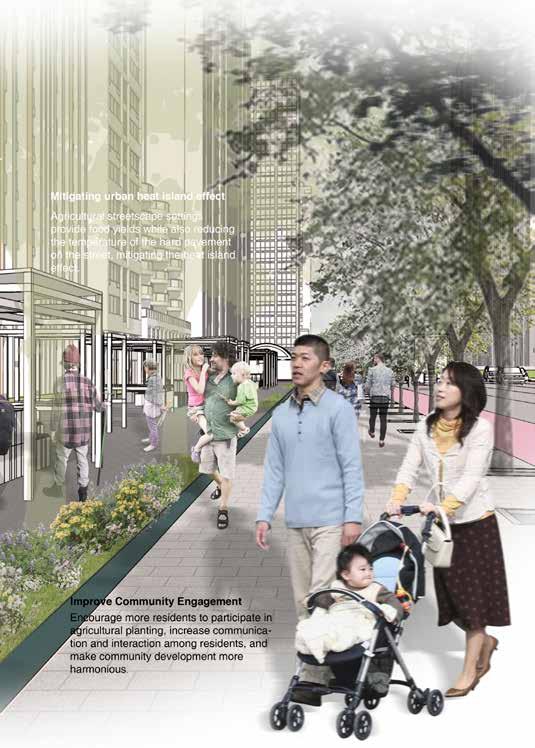
159
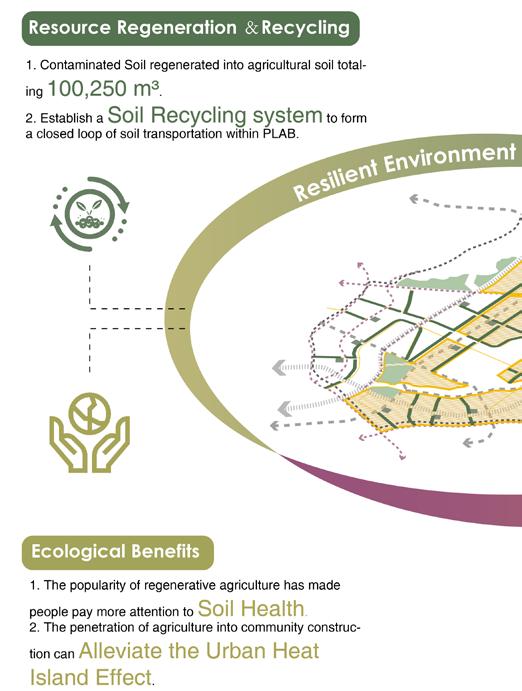
CONCLUSION 160
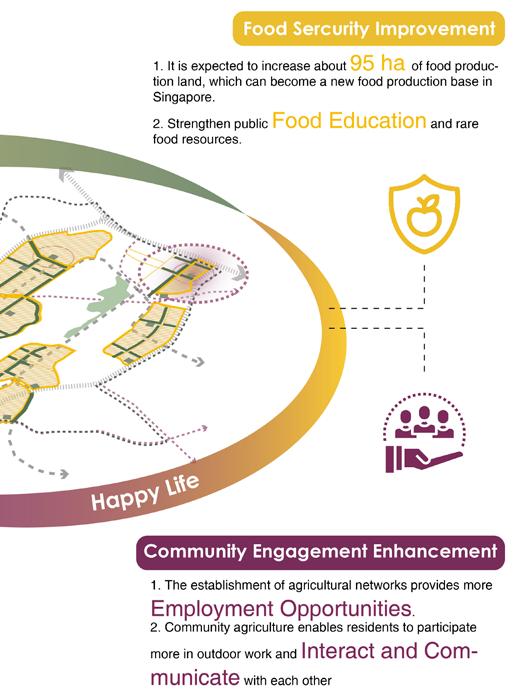
161

162
MORE THAN BLUE INFRASTRUCTURE:
COMMUNITY, NATURE, MEMORY
Water is always a vital resource for all humans, Singapore has been facing problems such as limited freshwater resources and over-reliance on imports. As a new town in the future, the increasing population in PLAB brings about increasing water demand, but the available water resources within the site are limited and depend on external water supply. In addition, PLAB was closely related to water in terms of production and living, but with waterways canalization, the relationship between people and water was estranged.
The project is aiming at maximizing the use of collected rainwater and greywater while transforming water management infrastructure into spatial landmarks to integrate the water system into people's daily life. Through innovative water management design, the following targets are:
1. Manage water quantity and quality while improving biodiversity and accessibility
2. Reconnect the relationship between humans and water
3. Shorten the process of wastewater transportation and reduce non-potable water reuse costs
The project proposes a new framework for water management in future PLAB, which is more than blue infrastructure, but a whole new system linking ecological restoration, historical memory, and community life. The design is divided into three strategies:
1. Improvement in rainwater harvesting capacity: Integrating the blue-green infrastructure network through constructed wetland system and WSUD elements
2. Interaction between people and water: Integrating blue infrastructure with community life & historical representation & ecological education in the linear runway park
3. Innovation in water treatment: Introducing decentralized wastewater treatment coupled with on-site, nonpotable water harvesting and purification devices
By integrating the fragmented blue-green infrastructure to create a new blue-green network for the overall studio masterplan, the project enables the efficient management of water reuse and achieves the goal of resilience. While it tends to transform water management infrastructure into spatial landmarks to reconnect the relationship between humans and water, which echoes the studio’s goal of a happy model town.
163
Hu Die, Lin Lan, Jin Zhuoyin
BACKGROUND
Water Management Loop in Singapore
 This graphic shows where water comes from and how sewage is treated and reused in the current water management loop in Singapore.
This graphic shows where water comes from and how sewage is treated and reused in the current water management loop in Singapore.
164
The shortage of this loop is, rainwater and waste water needs to be transported a long distance to the treatment plants through whether concrete drainages or underground pipes. This will increase the cost of water transportation to some extent.
BACKGROUND
Potential Water Demand & Supply in PLAB
Based on PLAB's future population, we calculated the future non-potable water demand and the potential supply of rainwater and grey water. According to the calculation, we find that the daily potential supply is about three times of the non-potable water demand, indicating that PLAB has great potential for rainwater and greywater reuse.

165
PRELIMINARY ANALYSIS Site Analysis
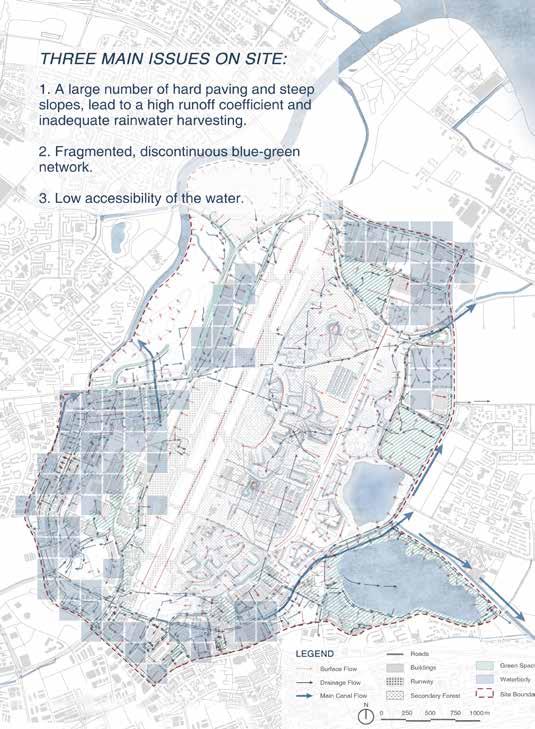
166

167

History Analysis 168
PRELIMINARY ANALYSIS

169
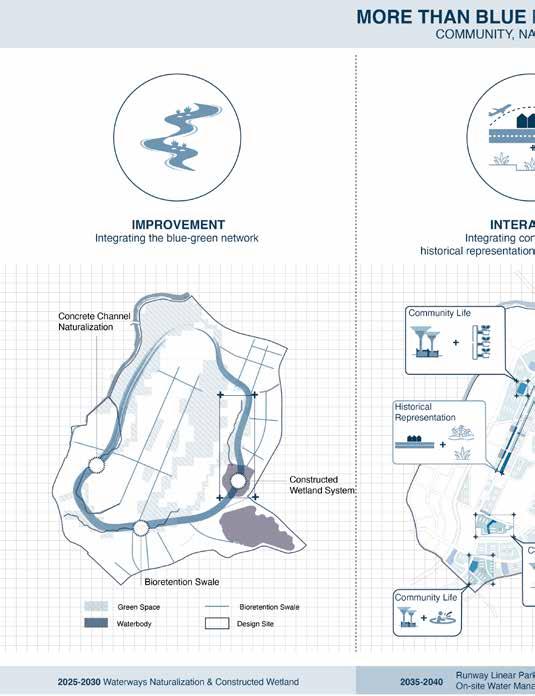
PROPOSAL Overall Strategies 170
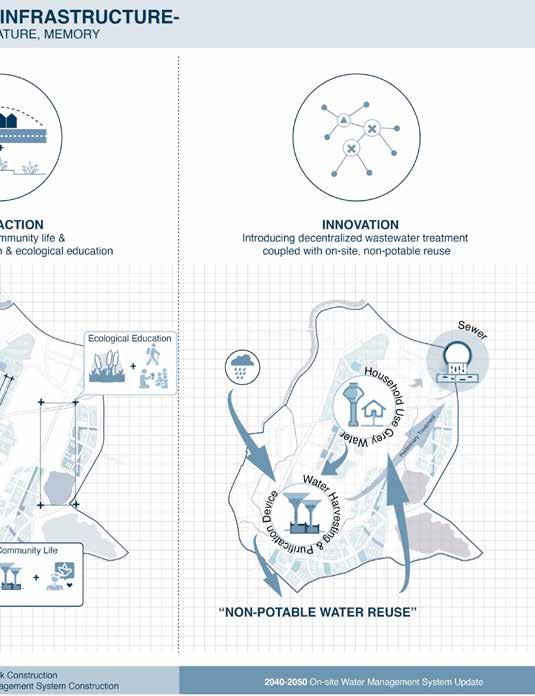
171
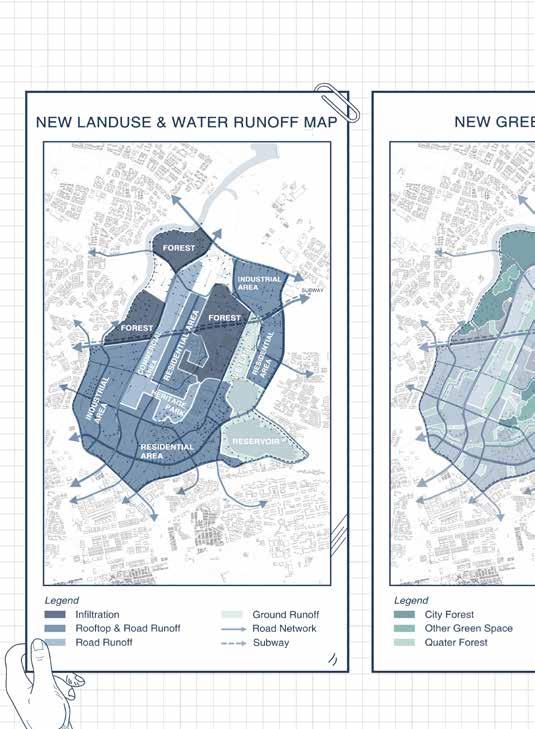
172
Masterplan
PROPOSAL
Process
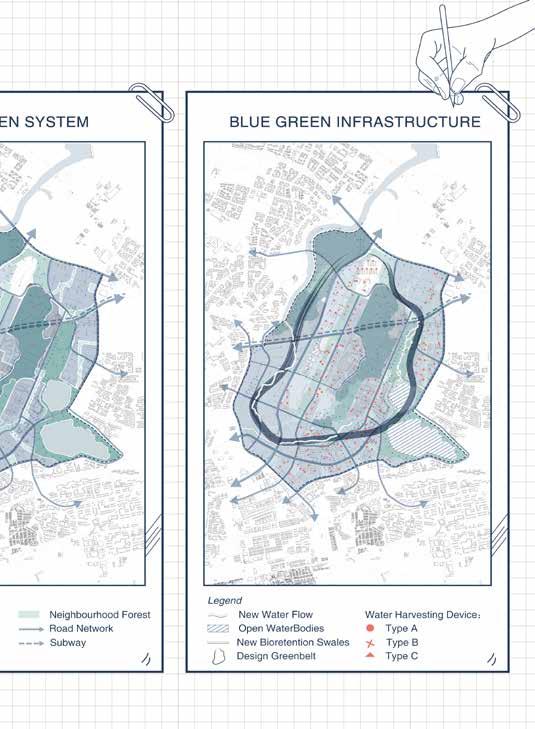
173

PROPOSAL Masterplan 174

175
PROPOSAL
Relationship Between Human&Water

176

177
PROPOSAL
Water Management Toolbox
According to different water quality requirements of inlet and outlet water, we developed three water treatment processes.

178

179
DETAIL DESIGN | ECOLOGICAL PARK Treatment Tool Box
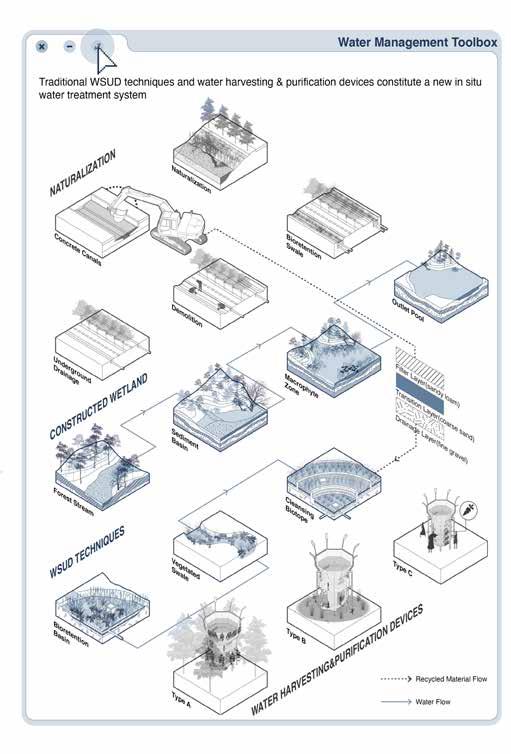
180
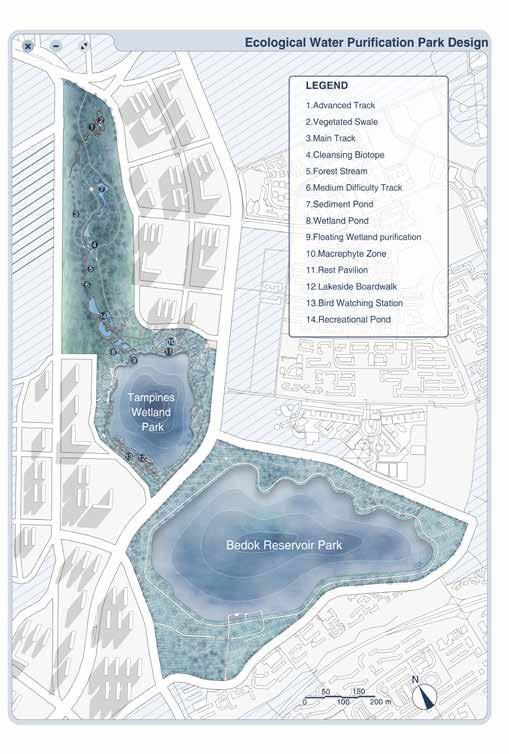
DETAIL
ECOLOGICAL PARK Detail Plan 181
DESIGN |
DETAIL DESIGN | ECOLOGICAL PARK Treatment Process

182

183
DETAIL DESIGN | ECOLOGICAL PARK Rendering
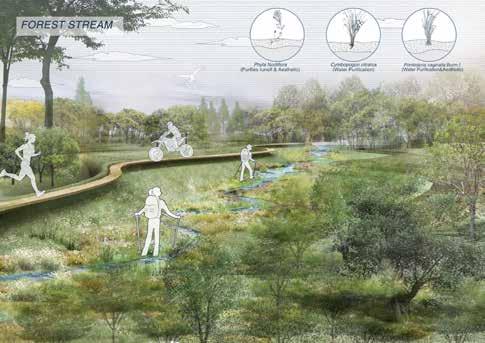

184
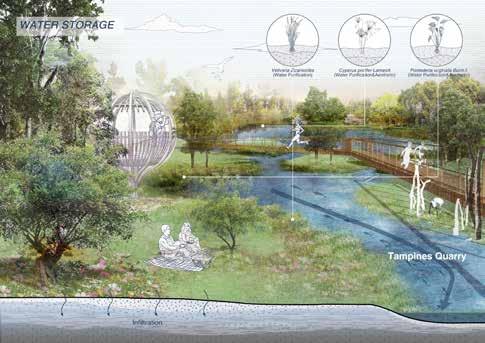
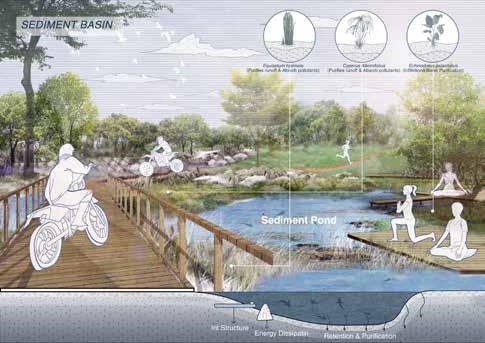
185 DETAIL
ECOLOGICAL PARK Rendering
DESIGN |
DETAIL DESIGN | RUNWAY LINEAR PARK Treatment & Activity Tool Box
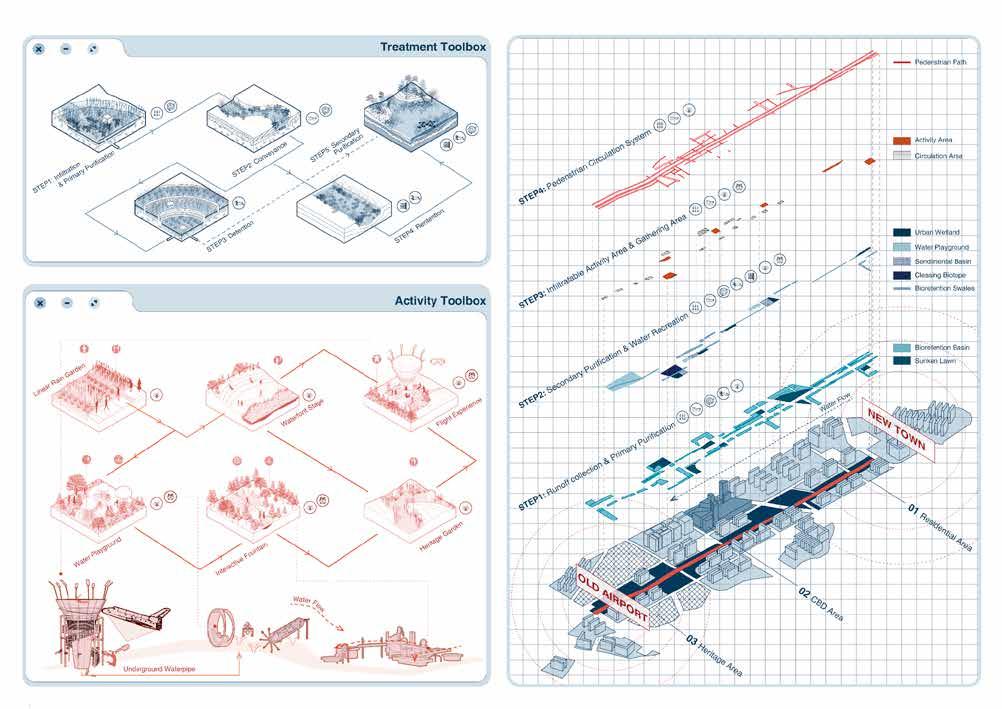
186

DETAIL DESIGN | RUNWAY LINEAR PARK Design Process 187
DETAIL DESIGN | RUNWAY LINEAR PARK
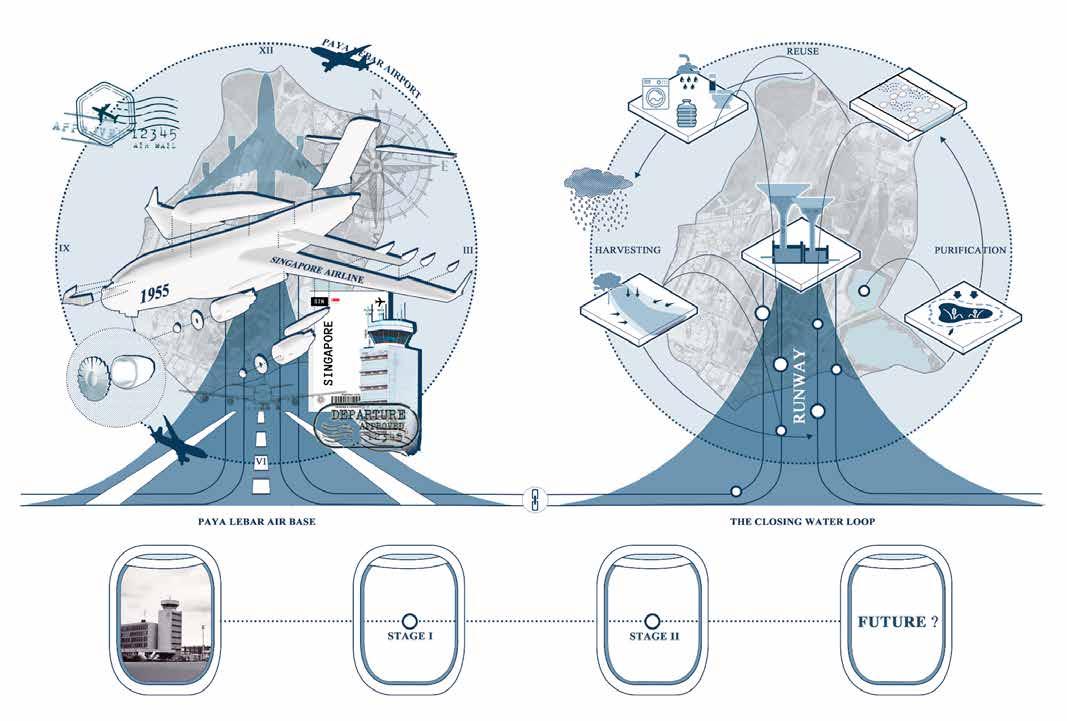
Storyline 188

189
DETAIL DESIGN | RUNWAY LINEAR PARK
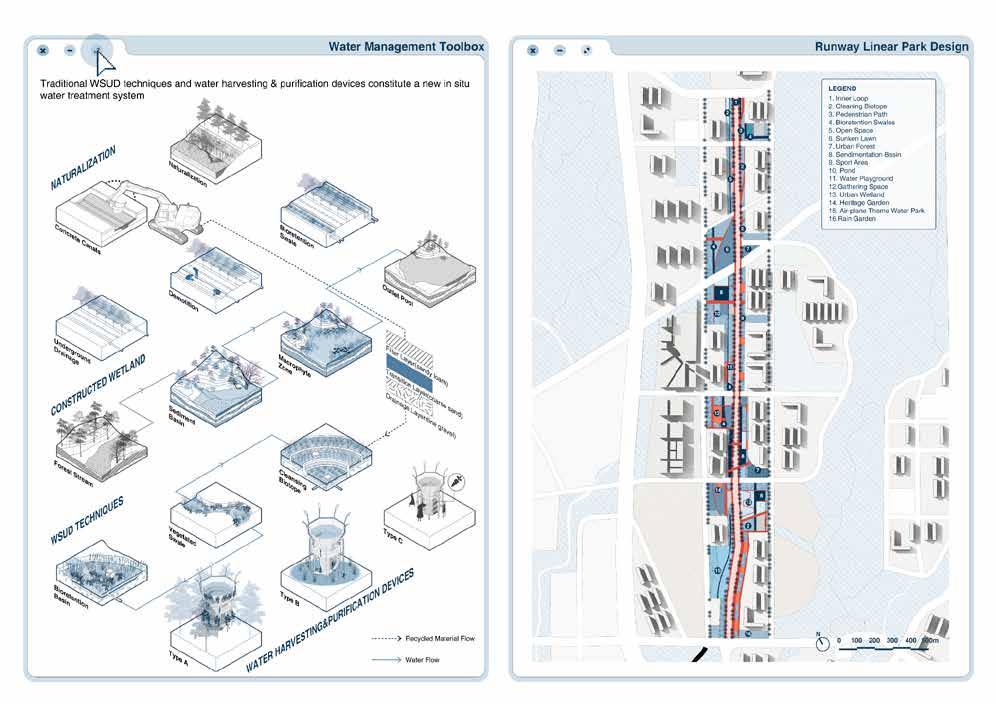
Detail Plan 190
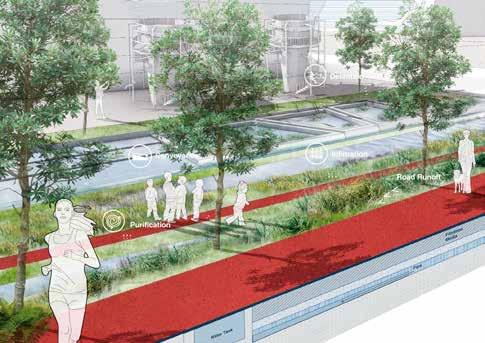
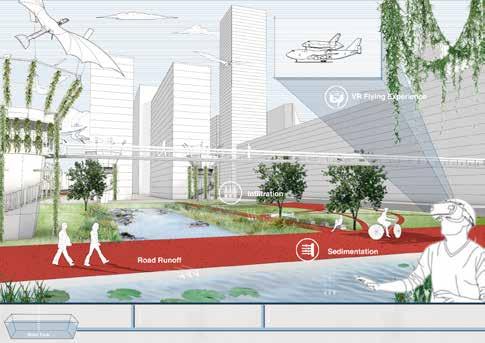
DETAIL DESIGN | RUNWAY LINEAR PARK Rendering 191
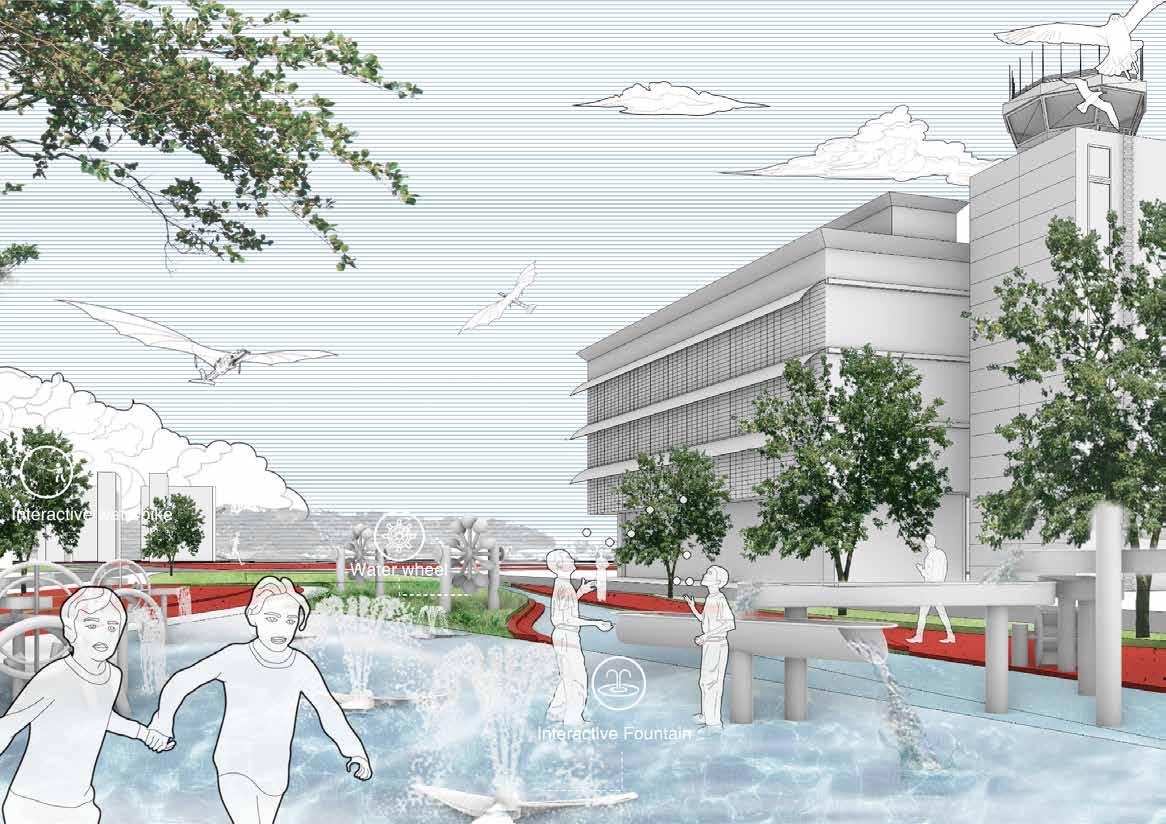
Rendering 192

DETAIL DESIGN | RUNWAY LINEAR PARK 193
DETAIL DESIGN | WATER TREATMENT DEVICE
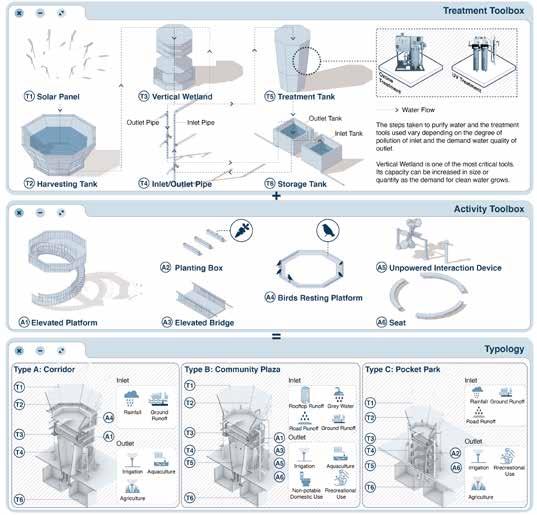
Water Harvesting & Purification Device Toolbox
Detail Plan Process
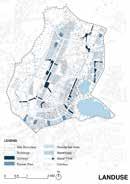

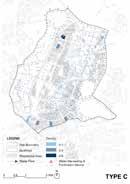
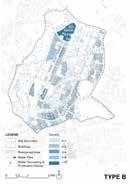
194
Type B is located in the open space at community plaza, which density is calculated according to the water demand of each block.
depending on the scale of the area.

Detail Plan
Type A is located in the bird corridor. After overlaping with the water flow map, the runoff intersection is found as the construction location of the device.
195
Type C is located in the community pocket park, the density of the device is
DETAIL DESIGN | WATER TREATMENT DEVICE
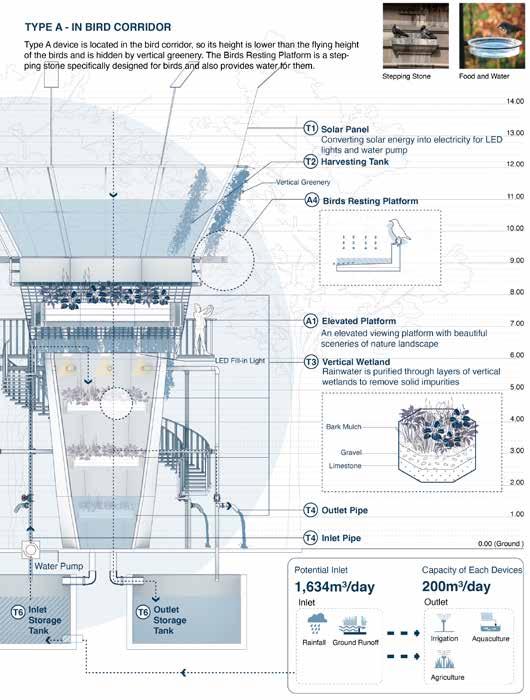 Section & Renders
Section & Renders
196
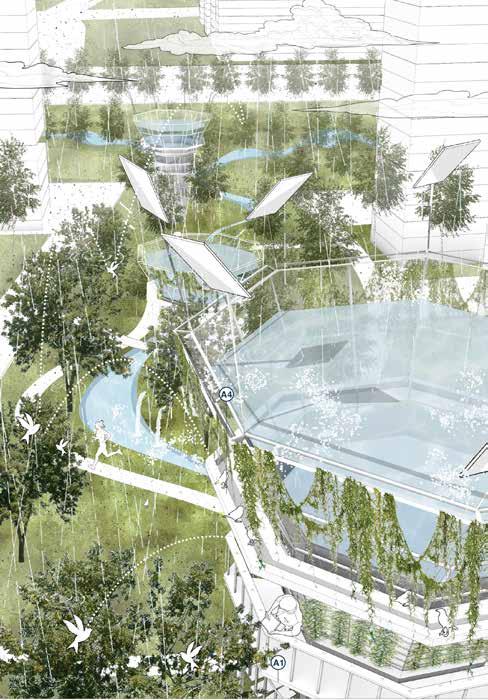
197
DETAIL DESIGN | WATER TREATMENT DEVICE
 Section & Renders
Section & Renders
198

199
DETAIL DESIGN | WATER TREATMENT DEVICE
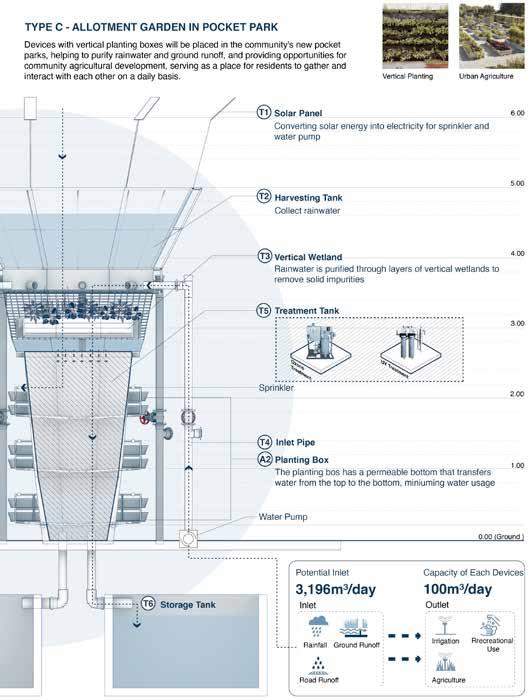 Section
Section
& Renders
200
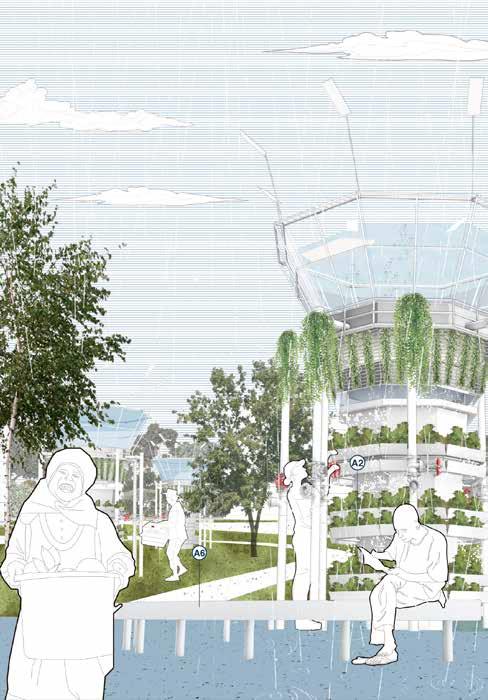
201
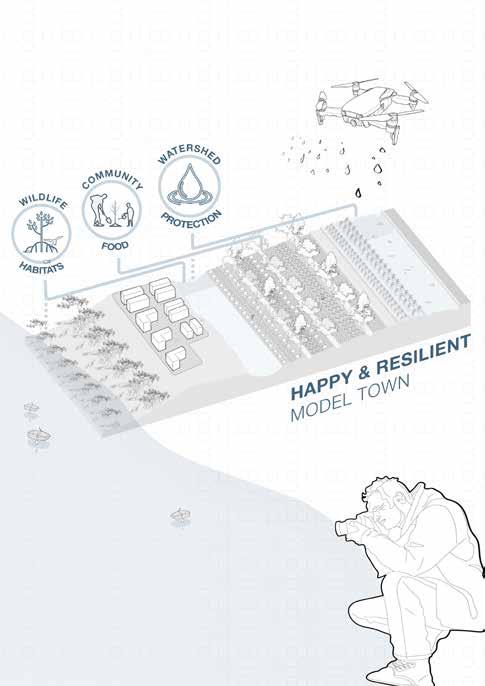
202
WATERSHED PROTECTION
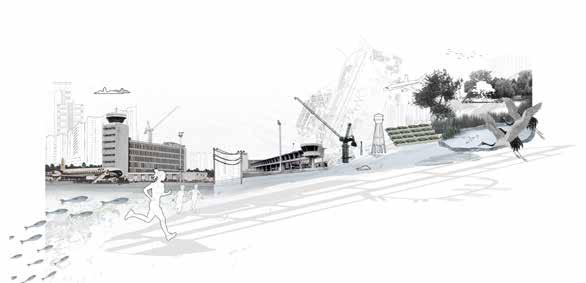
WITH AQUATIC ANIMALS
In over half a century, Singapore has experienced unprecedented growth. As a result, resource limitations and provision security have grown to become significant future challenges, where design is required to plan beyond the present and engage with future issues including climate change and threats to biodiversity. This project will show how this can be achieved through a watershed protection approach with aquatic animals. This approach will be integrated with a scenario-based framework, where a series of ecological strategies will responf to predicted trends in PLAB. Through strengthening the relationship between the watershed, biodiversity and people, residents wil achieve a happy & resilient community. In relation to the overall studio masterplan, this project will propose strategies that will work with one another and adapt to any current, ongoing and future scenarios, while providing support to other systems to shape PLAB into a Happy & Resilient Town of the future.
203
Janina Kwan, Sabrina Shafari, Xing Zhiyan
GROUP VISION

Achieving a Happy & Resilient Community
Resource Limitations and Provision Security are the biggest challenges PLAB will face with its coming development. Thus, design should engage with future unpredicatbility to form a resilient town with strong adaptability. The watershed protection approach with aquatic animals can be integrated with a scanriobased framework, where strategies will respond accordingly. By establishing a strong relationship between its watershed, biodiversity and people, PLAB will achieve a happy and resilient community.
204
PROJECT FOUNDATION

Thought Process & Direction
The existing watershed has cultural & historical significance, with mangroves and fishing along Serangoon River. In the late 20th century, the river bank was the former Lorong Halus Dumping Ground landfill. Addtionally, the 3 main waterbodies in PLAB currently exhibit low and uneven species diversity for aquatic & non-aquatic fauna.
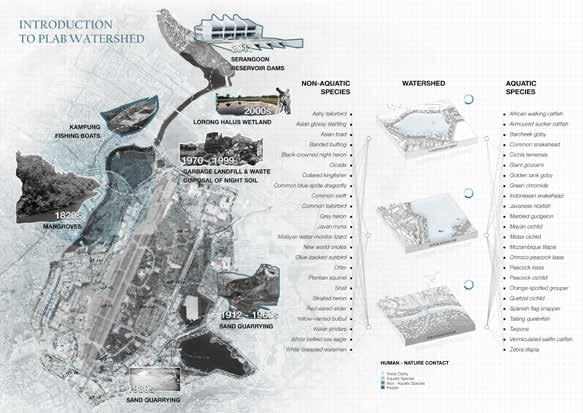
205
Study of the current water quality conditions & observations show majority of the areas throughout PLAB were lacking in the ability to simultaneously cater to the watershed, people and biodiversity.

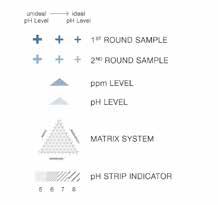
Successful watershed protection is currently at 94%. Our goal is to provide 100% successful watershed protection.

SITE ANALYSIS Water Sampling
206
STUDIO MASTERPLAN Masterplan Site Considerations

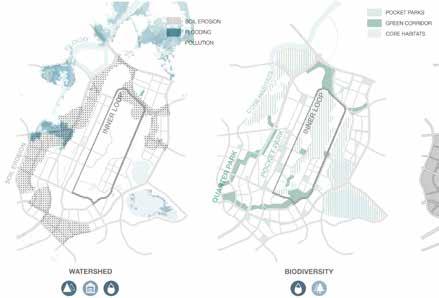
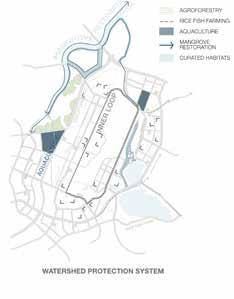
Based on the analysis of proposed construction, demolition & establishment of soil bank, areas were identified with high risk of soil erosion & flooding that will affect the quality of PLAB's watershed.
Green spaces & proposed habitats were taken into consideration, due to their close relationship with waterbodies and its aquatic species to create a thriving & balanced ecosystem.
The future landuse & transportation network were used to identify areas that will have enhanced human-nature contact, watershed protection and ecological enhancement.
In conjunction with the studio masterplan, the project aims to work together and support it, achieving integration with by considering relevant strategies from other groups.
207
JOURNEY OF WATER
Relationship between Proposed Strategies
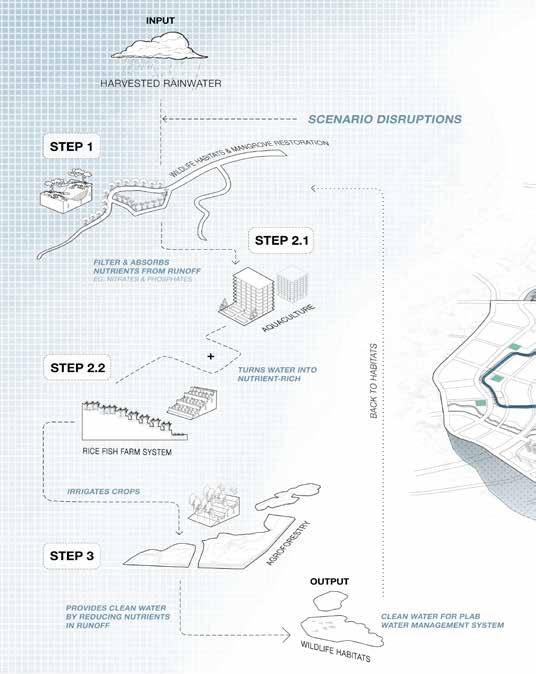
208

209
SCENARIO-BASED ISSUES
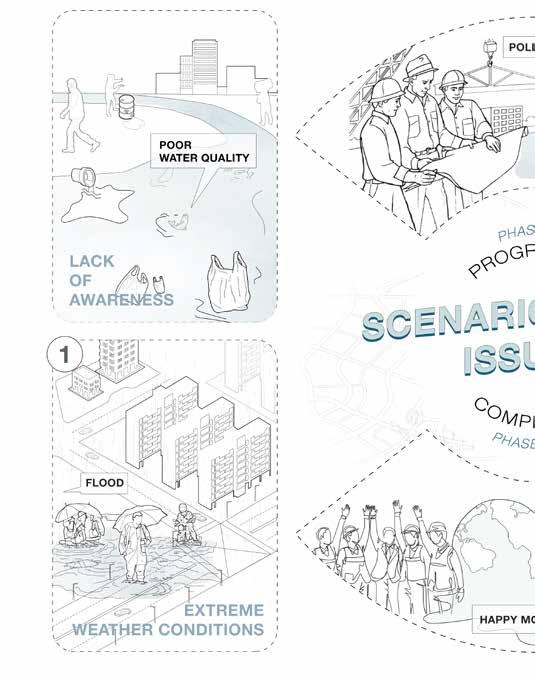
& Addressed Issues 210
Predicted
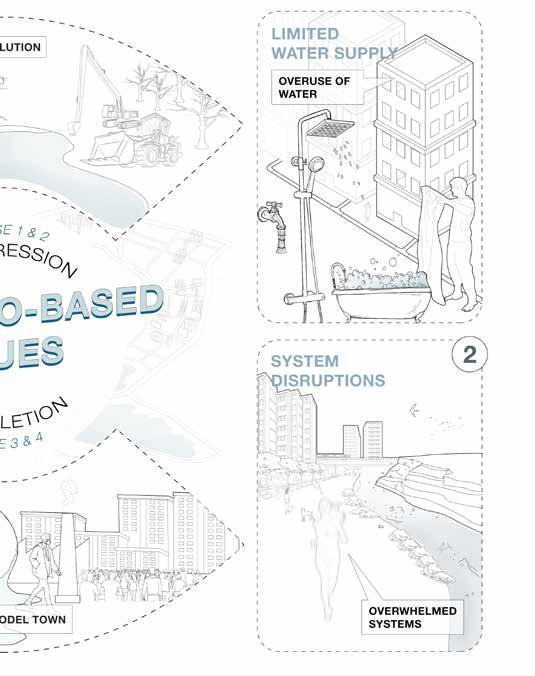
211
SCENARIO 1: MASTERPLAN PROGRESS
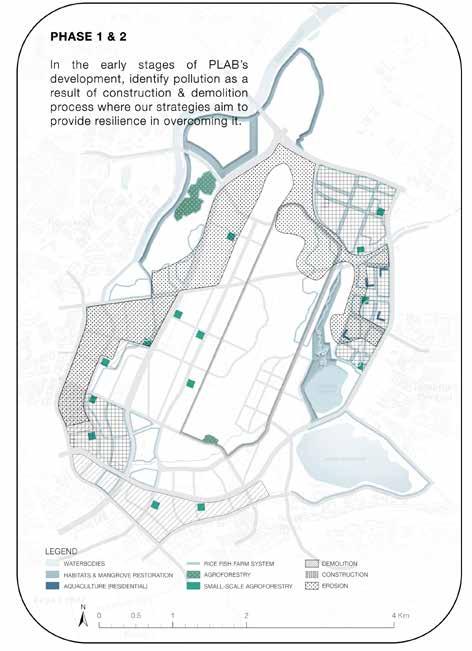
Pollution 212

213
PROGRESSION RESPONSE
Strategies Reponse to Pollution

214

215
WILDLIFE HABITATS
Bioindicators & Typologies
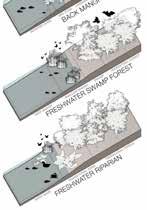
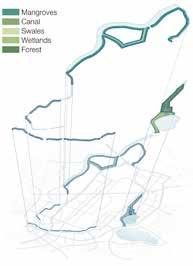
Curated wildlife habitats will strengthen biodiversity & provide a reliable means of evaluation. Watershed inhabitants directly respond to their environment, where the choice of suitable flora & fauna species can help to identify & resolve issues. Across the different habitat typologies, there will be flexible species proposal to benefit the watershed, biodiversity & people.
Along Serangoon River, the Mangroves habitat will transition through 4 types: Mangroves, Back mangroves, Freshwater swamp forest and Freshwater riparian.
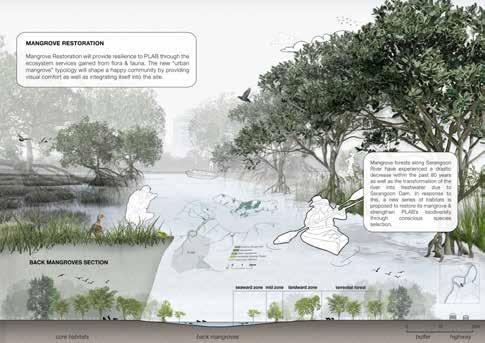
Source: https://www.researchgate.net/publication/268374524_The_present_extent_of_mangrove_forests_in_Singapore
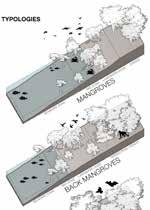
216
Programs integrated into these habitats will further strengthen the connection between people & biodiversity. It will provide valuable educational opportunitoes & support a lifestyle experience unique to the community.
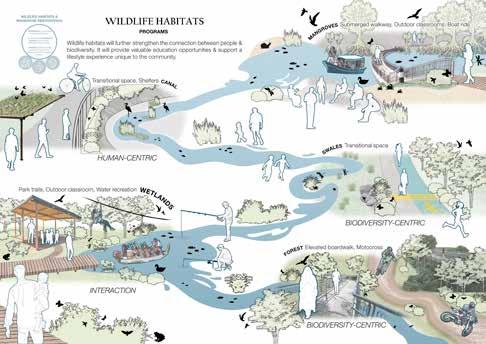
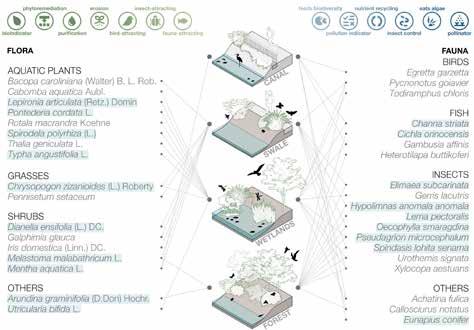
WILDLIFE HABITATS Species Selection & Program Integration
217
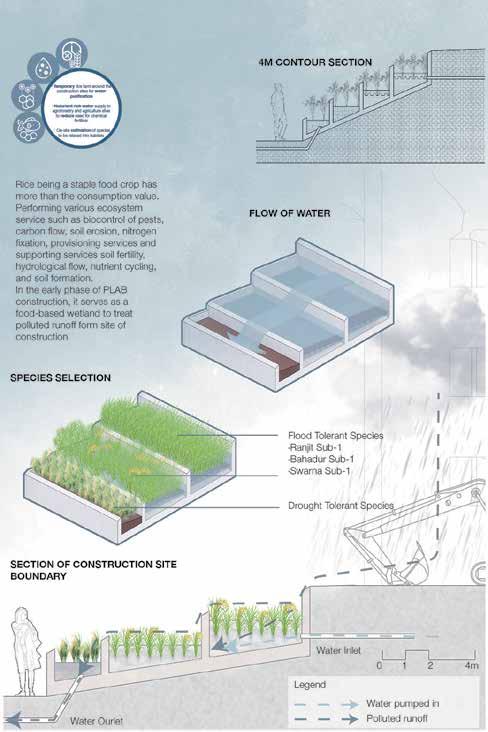
TEMPORARY
Ecosystem Services 218
RICE FARM
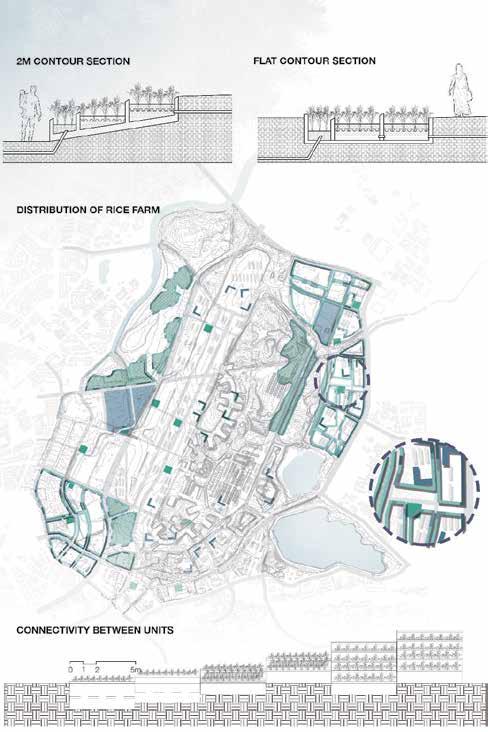
TEMPORARY RICE FARM Site Distribution & Typologies 219
AGROFORESTRY
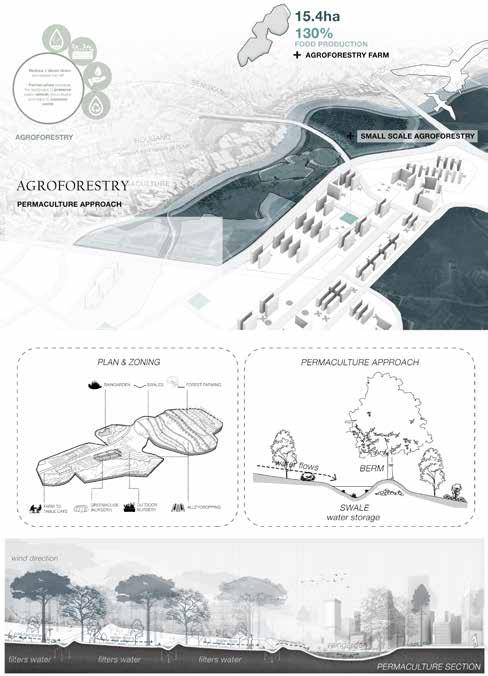
Permaculture Approach
Agroforestry aims to reduce the over-reliance on imported food and establish a self-sustaining food supply for the future PLAB residents and Singapore.
In Phases 1 & 2, the farm reacts as the last process of treating polluted water by reducing nutrients in water runoff from construction & demolition areas before it reaches the Serangoon River Watershed.
A holistic approach to farm crops in a sustainable way, which achieves high yields and productivity.
220
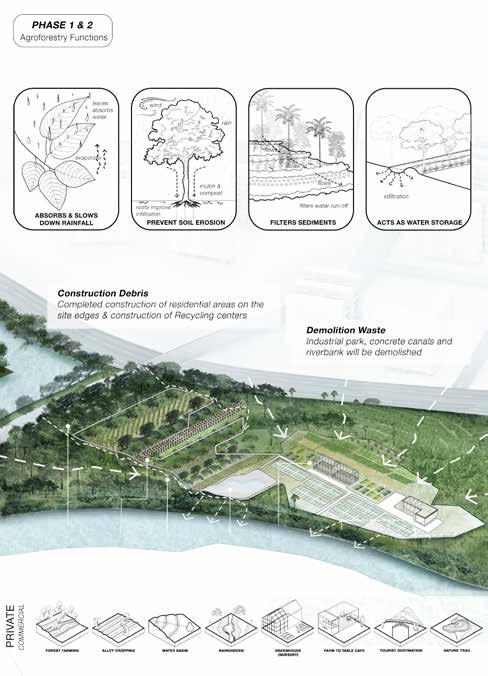
AGROFORESTRY Functions & Benefits 221
SCENARIO 2: MASTERPLAN COMPLETION
Happy Town Model
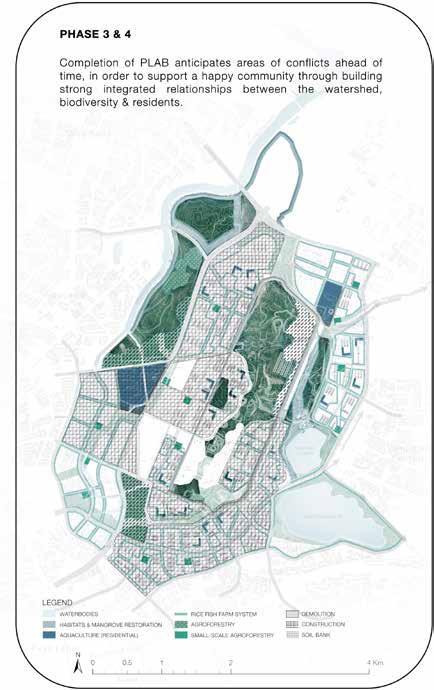
222
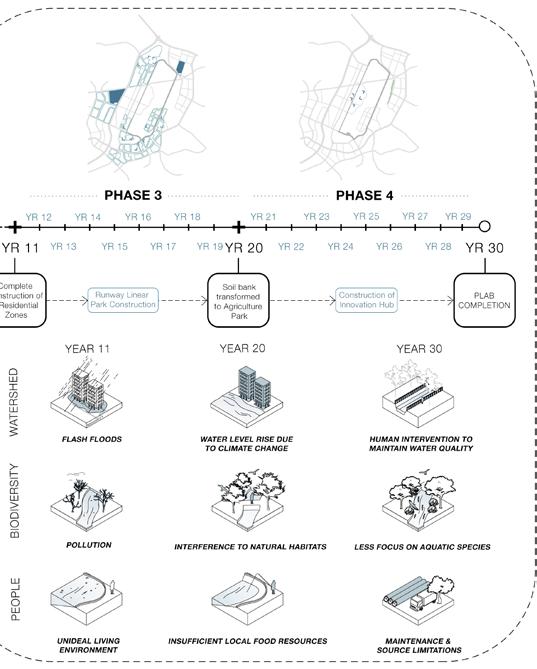
223
COMPLETION RESPONSE
Strategies Reponse to a Happy Community

224
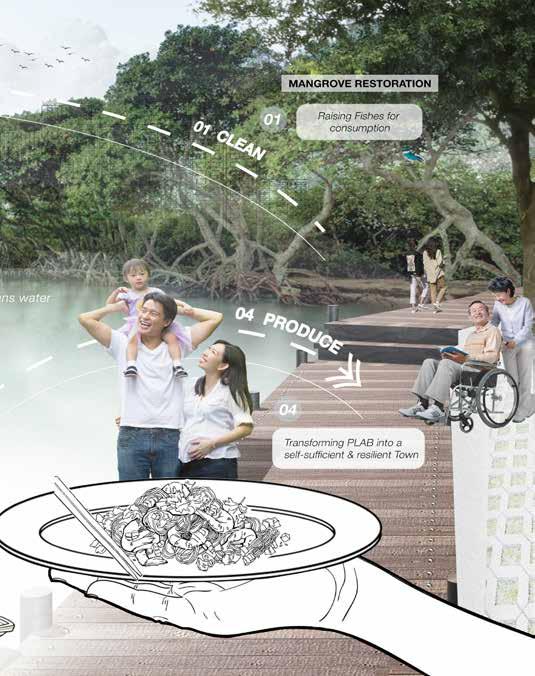
225
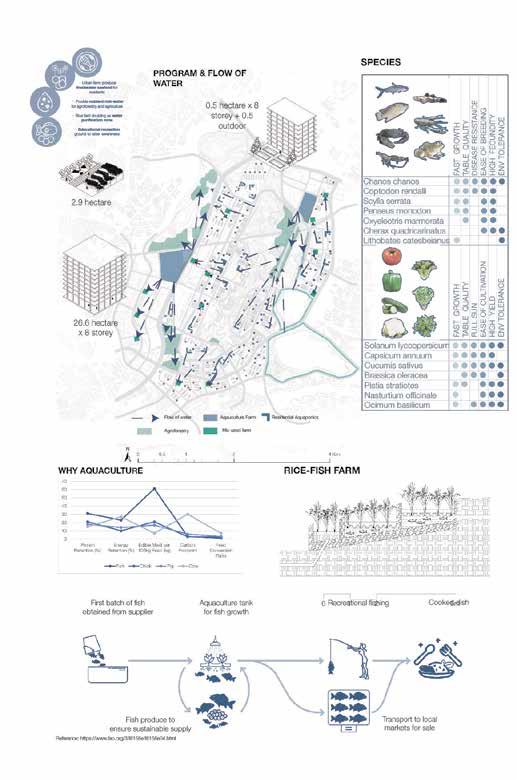
226
AQUACULTURE Functions, Operations & Benefits
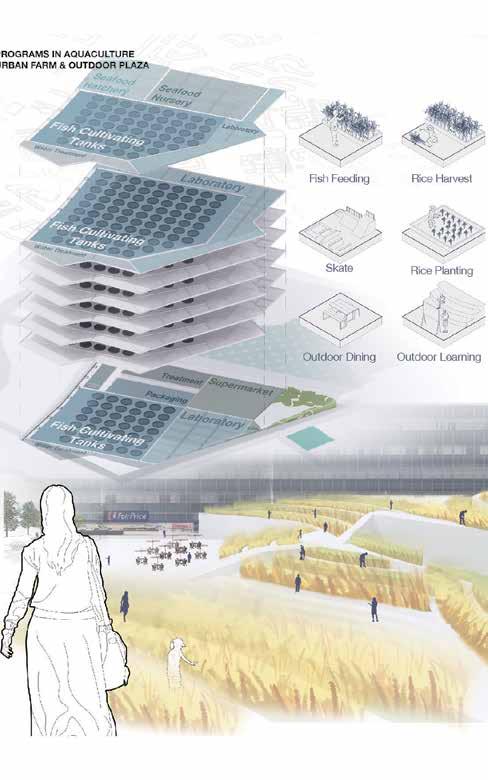
AQUACULTURE Programs 227
Agroforestry takes on a larger role during this stage of development in terms of food production and strengthening the relationship between people and nature. It will be done on 3 scales in different phases: Commercial, Neighbourhood and Residential.
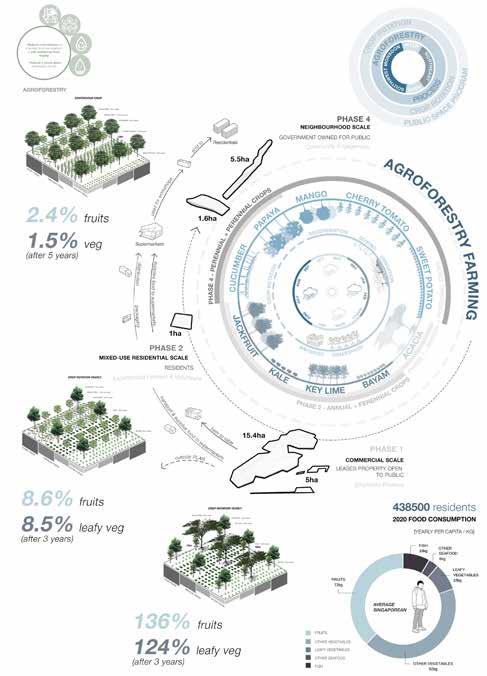
AGROFORESTRY Distribution & Overview
228

AGROFORESTRY Mixed-Use Residential & Programs 229
FOOD DISTRIBUTION NETWORK
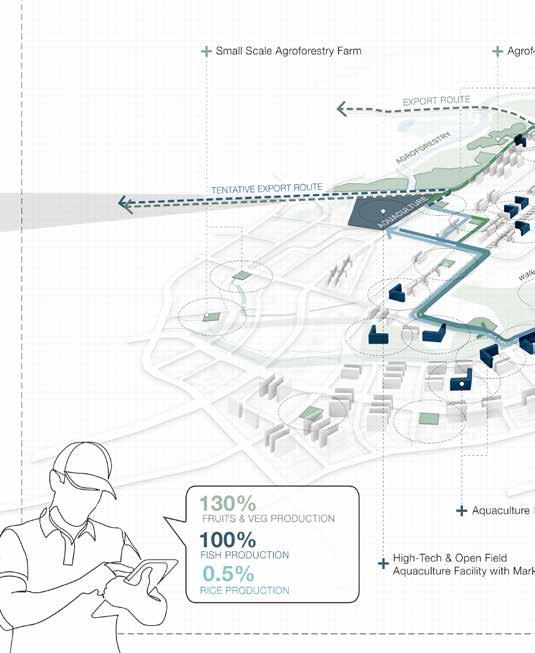
230
Movement of Food in Paya Lebar Airbase
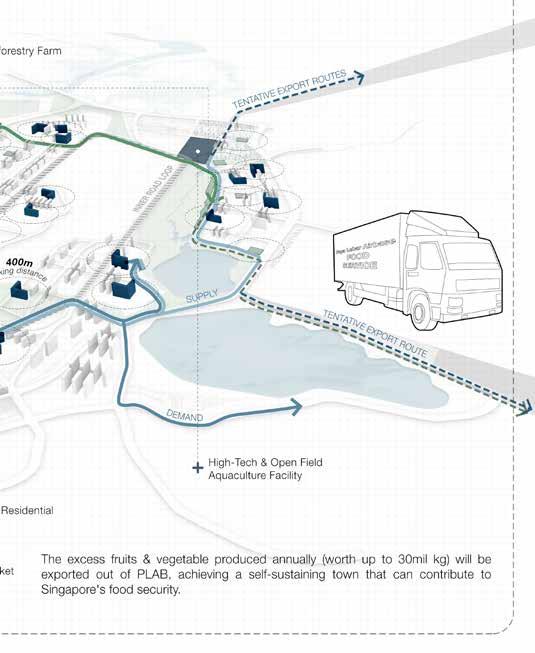
231
SCENARIO 3: MASTERPLAN FUTURE
Overwhelmed Systems
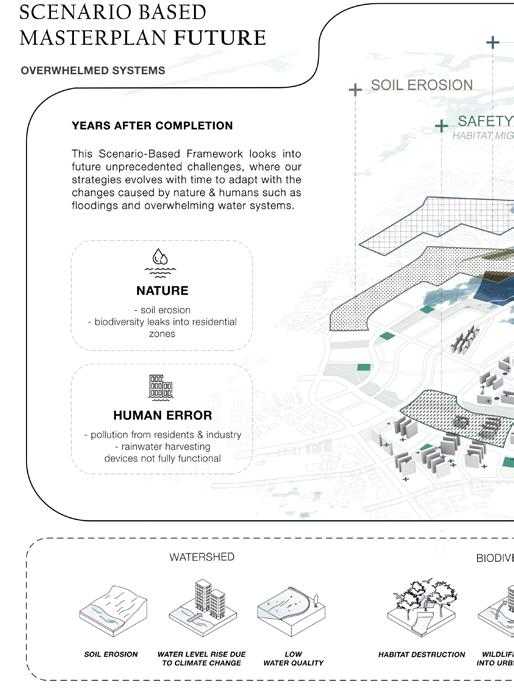
232
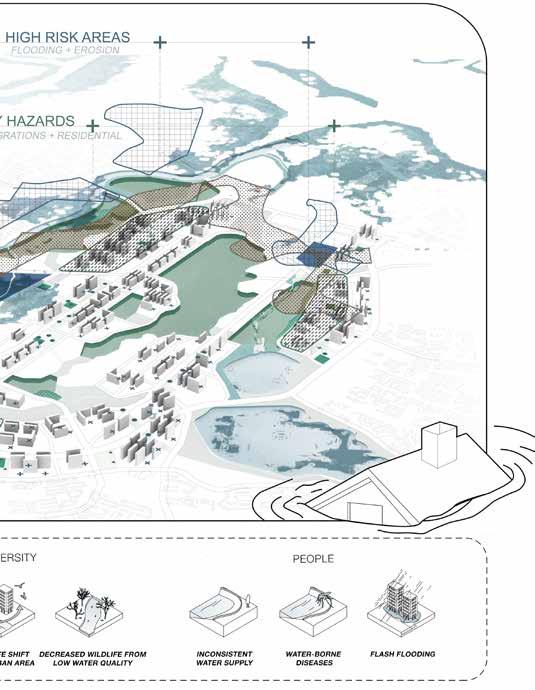
233
FUTURE RESPONSE
Strategies Reponse to Overhwhelmed Systems
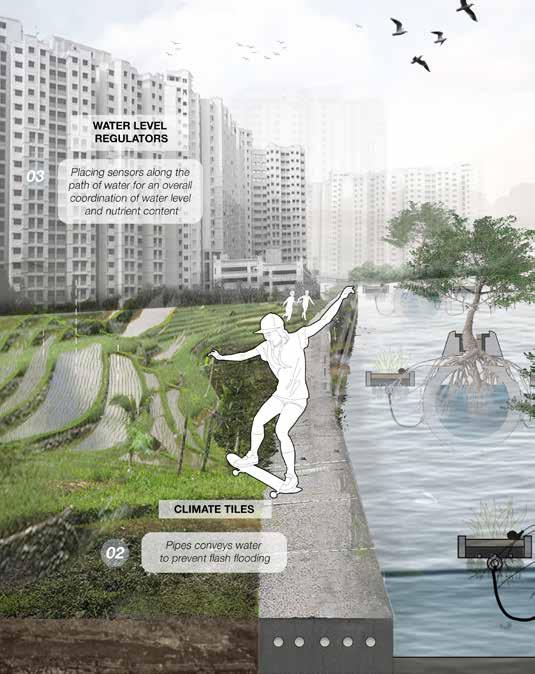
234
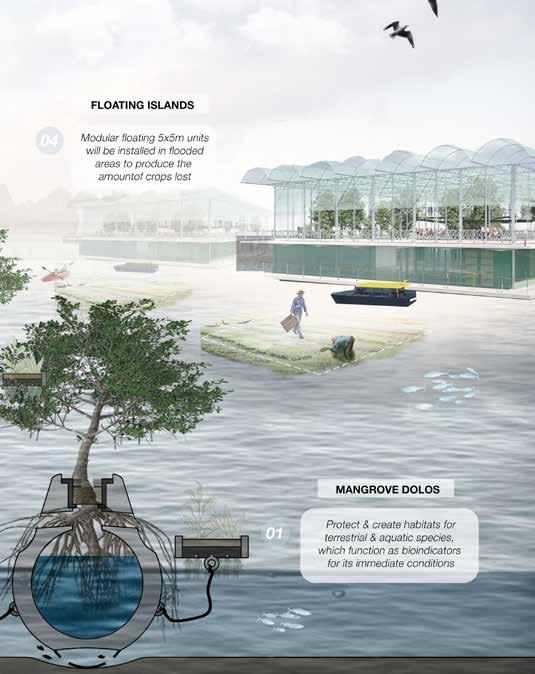
235
WILDLIFE HABITATS
Adaptation of Habitats
Source: https://www.jstor.org/stable/26233154#:~:text=Introduction.,the%20official%20record%20in%201929.
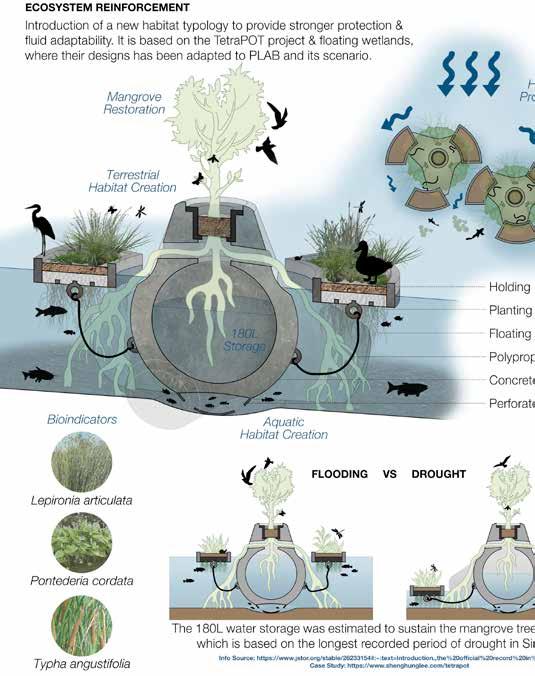
236
Source: https://www.shenghunglee.com/tetrapot, https://www.tredjenatur.dk/en/portfolio/climatetile/
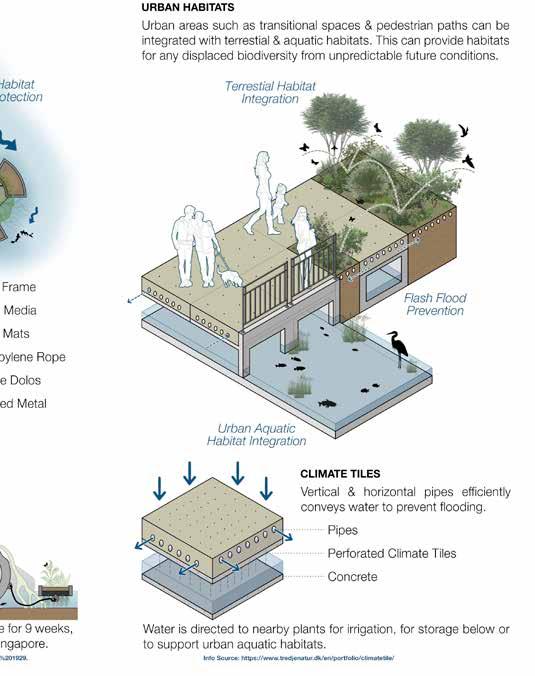
237
AQUACULTURE & RICE FARMS

of
238
Addtion & Functions
Water Sensors
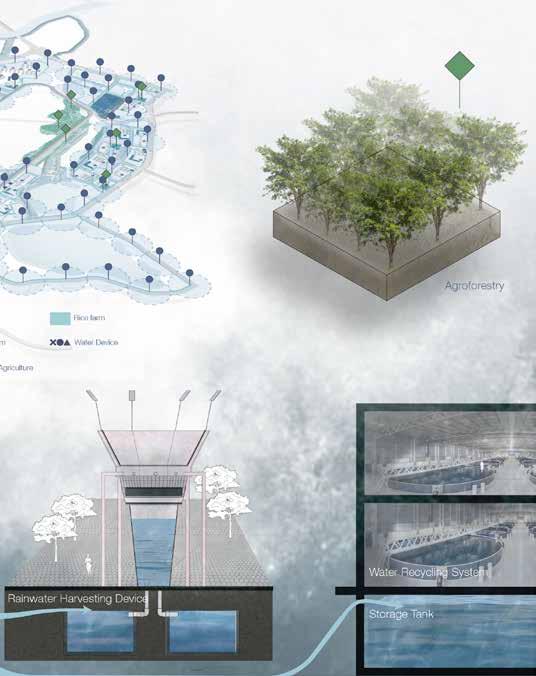
239
FLOATING AGROFORESTRY
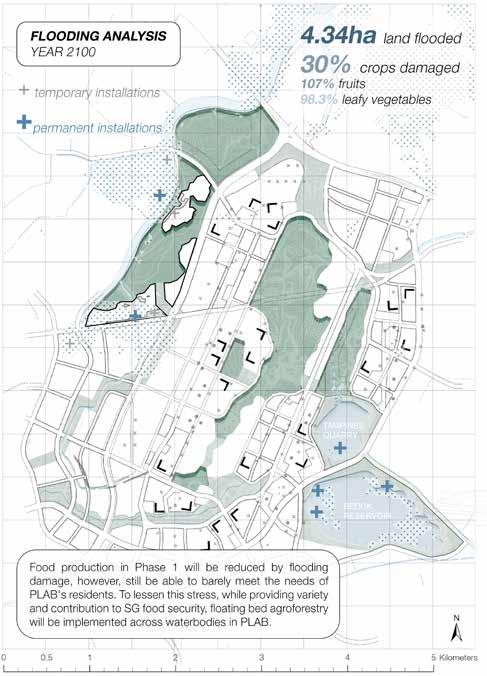
240
Flooding Analysis
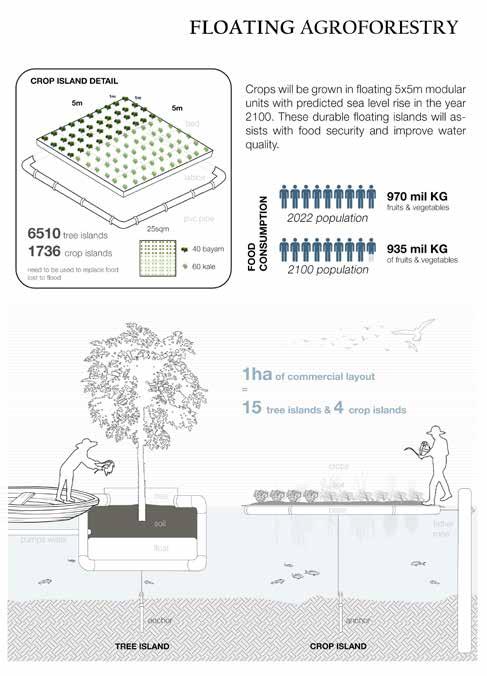
FLOATING AGROFORESTRY Adaptation & Benefits 241
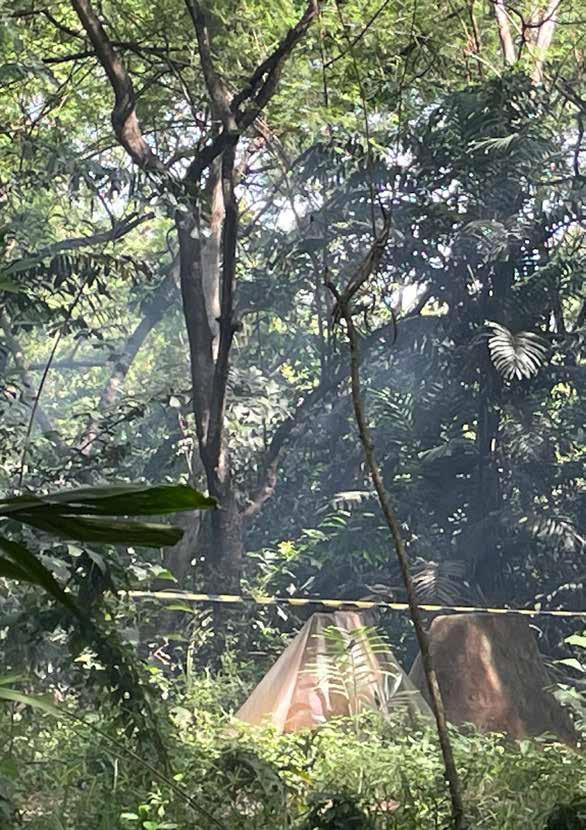
242
REGENERATIVE PLAB
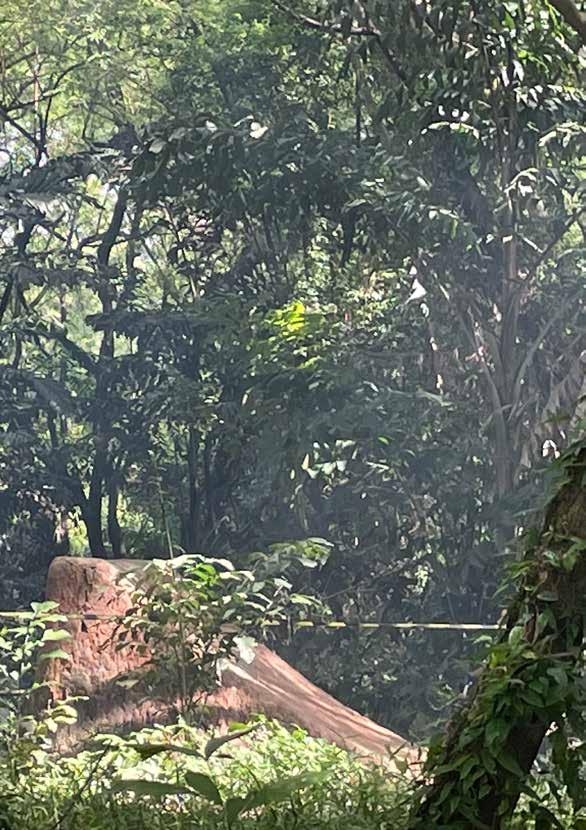
CONCEPT MASTERPLAN GENERATION & NEGOTIATION PROCESS
STUDIO TWO | CYNTHIA WEE SU YI | CHANG WANRUO | SHI YILAN | CHAI XIN YI | MIRWANKAR ANCHITA NITIN | | WANG LIANGYU | ZHANG YUXI | XU RUOZHU | REN JUNYAO | CAO NAICHUN | CAO NAICHUN | | ZHOU SICONG | ZHAO MINGYU | JIANG RUOMIN | CHENG SIQI |
TUTOR: HWANG YUN HYE
243
RATING MAPS OF FOCUS TOPICS
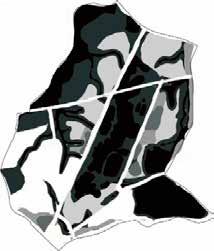

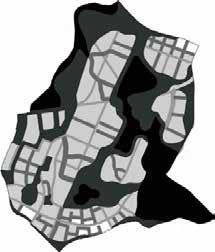
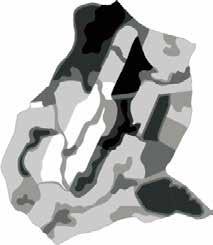
Process | Nature - Human
Co-Breathing w ith Soil
Wildlife Economies
Seed
Nature
D ispersal & Animals
244
as a Carbon Bank
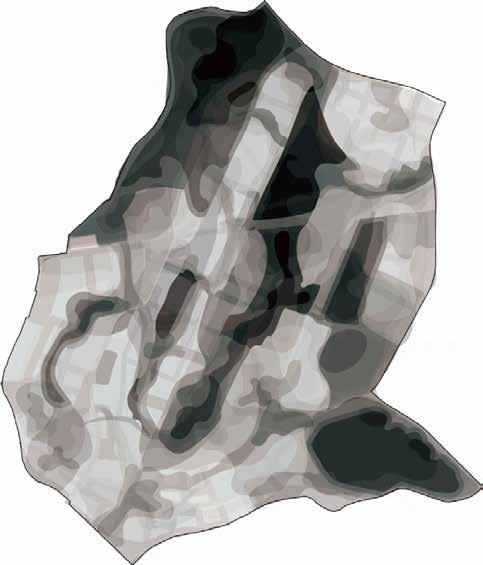

Combined r ating m aps o f 4 groups 245
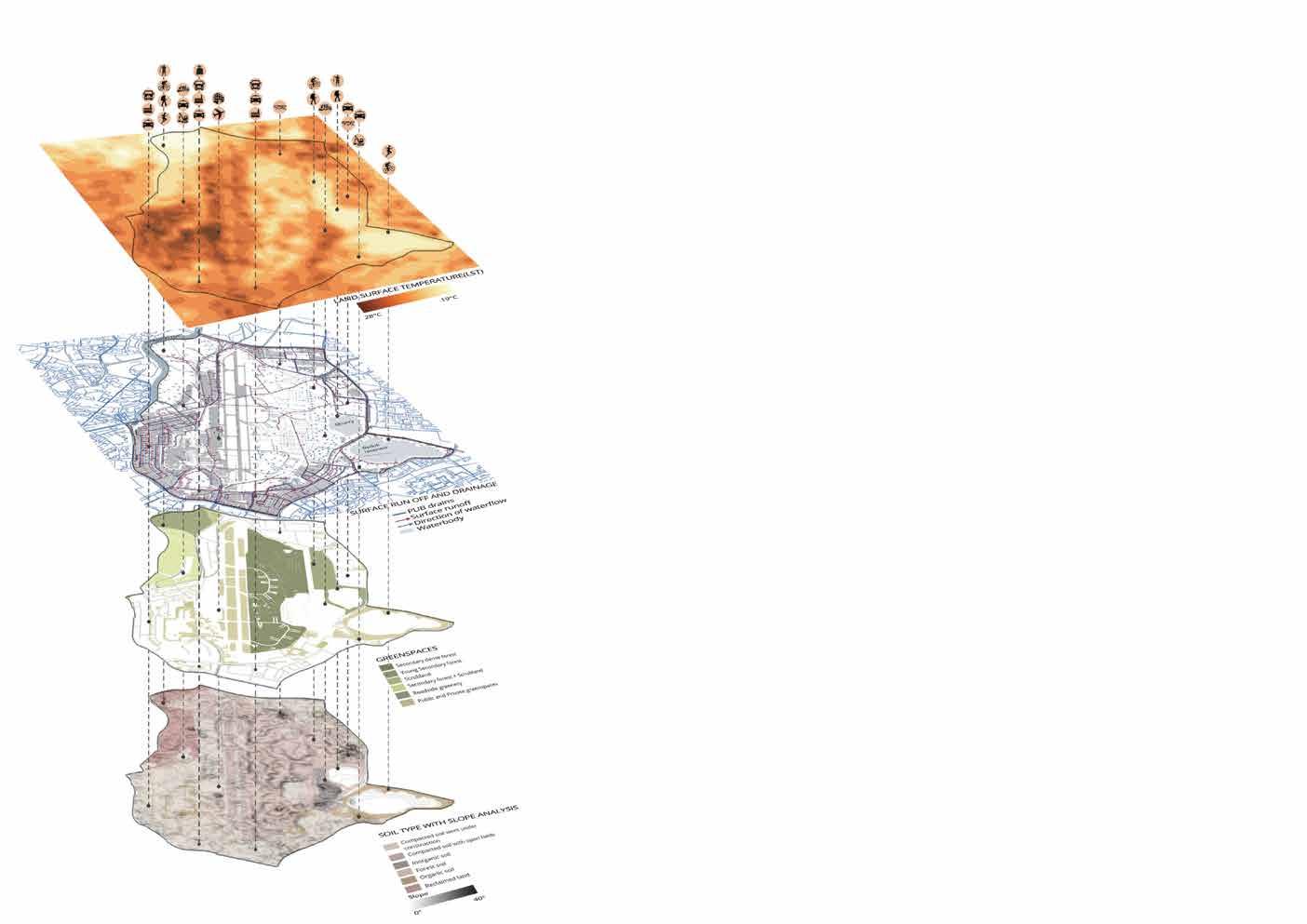
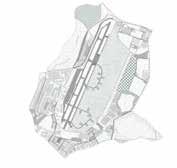
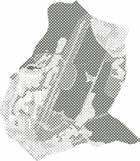

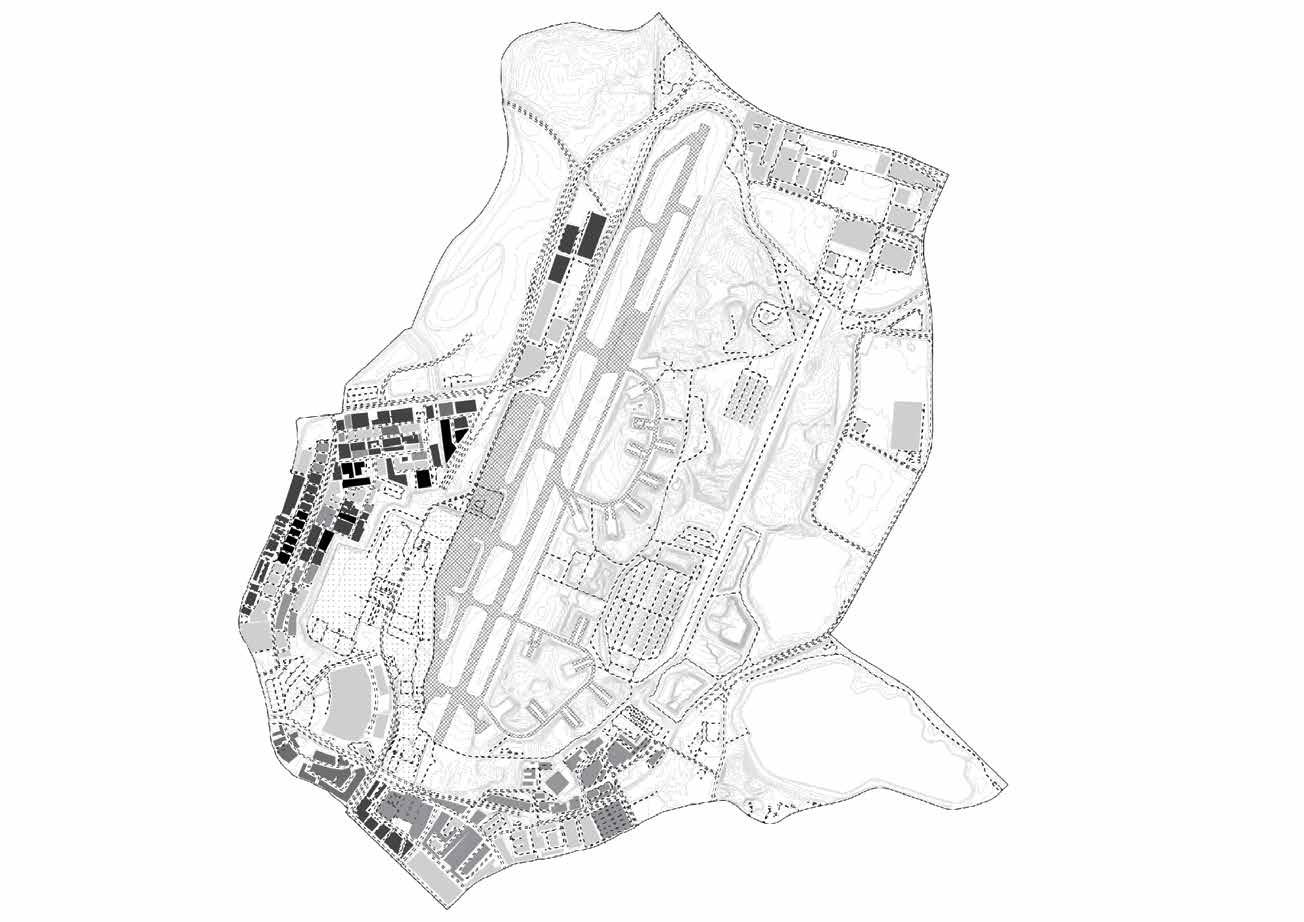



Insect Habitat Suitablity Permeability Issue Suitable Based on soil temperature and vegetation� density High Quarry Tampines Forest Runway airplanes exhibition, apron Insect Habitat Suitablity Permeability Issue Suitable Unsuitable Fill Cut Open Field, Managed Turf e b a e g n-ve No Pervious Surface Impervious Surface Buildings Topo Change Slope Analysis with Hydrology 40° Low High 0° Based on soil temperature and vegetation� density High Low Urban Green Bedok Reservoir Seragoon Scrbland PLAB Forest Seragoon Forest Quarry Tampines Forest Surface runoff Direction of waterfl ow Existing contour lines Water Flow Mitigation 5 4 3 Nature Human Urban Pollutant Issue Manufacture Metal workshops Warehouse/ Storage Private Ltd. Companies Roads Motor repairs Airbase buildings Metal,paper, recycling High food,paper Construction, technology etc. car washing, repairs, spare parts storage, repair vehicular movements Low Runway airplanes exhibition, apron Insect Habitat Suitablity Permeability Issue Suitable Unsuitable Fill Cut Open Field, Managed Turf le b at e g n-ve No Pervious Surface Impervious Surface Buildings Topo Change Slope Analysis with Hydrology 40° Low High 0° Based on soil temperature and vegetation� density High Low Urban Green Bedok Reservoir Seragoon Scrbland PLAB Forest Seragoon Forest Quarry Tampines Forest Surface runoff Direction of waterfl ow Existing contour lines Water Flow Mitigation 5 4 3 Nature Human Urban Pollutant Issue Manufacture Metal workshops Warehouse/ Storage Private Ltd. Companies Roads Motor repairs Airbase buildings Metal,paper, recycling High food,paper Construction, technology etc. car washing, repairs, spare parts storage, repair vehicular movements Low Runway airplanes exhibition, apron 246
The concept plan creates green connections within urban areas, improving urban area permea-bility. At the same time, topo changes in the forest and additional forest periphery prevent further erosion, allowing the opportunity for the soil ecosystem to thrive.
The concept plan creates green connections within urban areas, improving urban area permea-bility. At the same time, topo changes in the forest and additional forest periphery prevent further erosion, allowing the opportunity for the soil ecosystem to thrive.
The concept plan creates green connections within urban areas, improving urban area permea-bility. At the same time, topo changes in the forest and additional forest periphery prevent further erosion, allowing the opportunity for the soil ecosystem to thrive.
The concept plan creates green connections within urban areas, improving urban area permea-bility. At the same time, topo changes in the forest and additional forest periphery prevent further erosion, allowing the opportunity for the soil ecosystem to thrive.



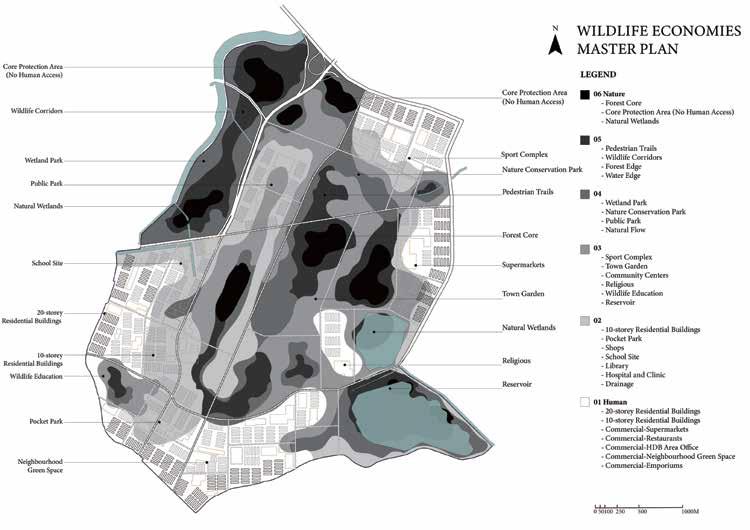
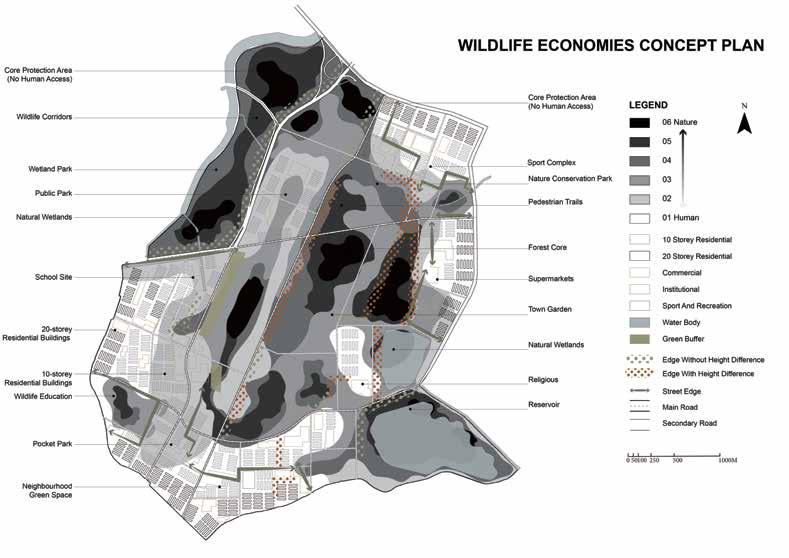

RATING MAPS Process Outcome
RATING MAP Nature Human
RATING MAP 6 5 4 3 2 1 Nature Human
247
TO DECIDE WHICH EXISTING GREEN SPACES HAVE THE MOST CONSERVING VALUES AND WHERE TO HAVE ADDITIONAL GREEN PATCHES
TO DECIDE WHICH EXISTING GREEN SPACES HAVE THE MOST CONSERVING VALUES AND WHERE TO HAVE ADDITIONAL GREEN PATCHES

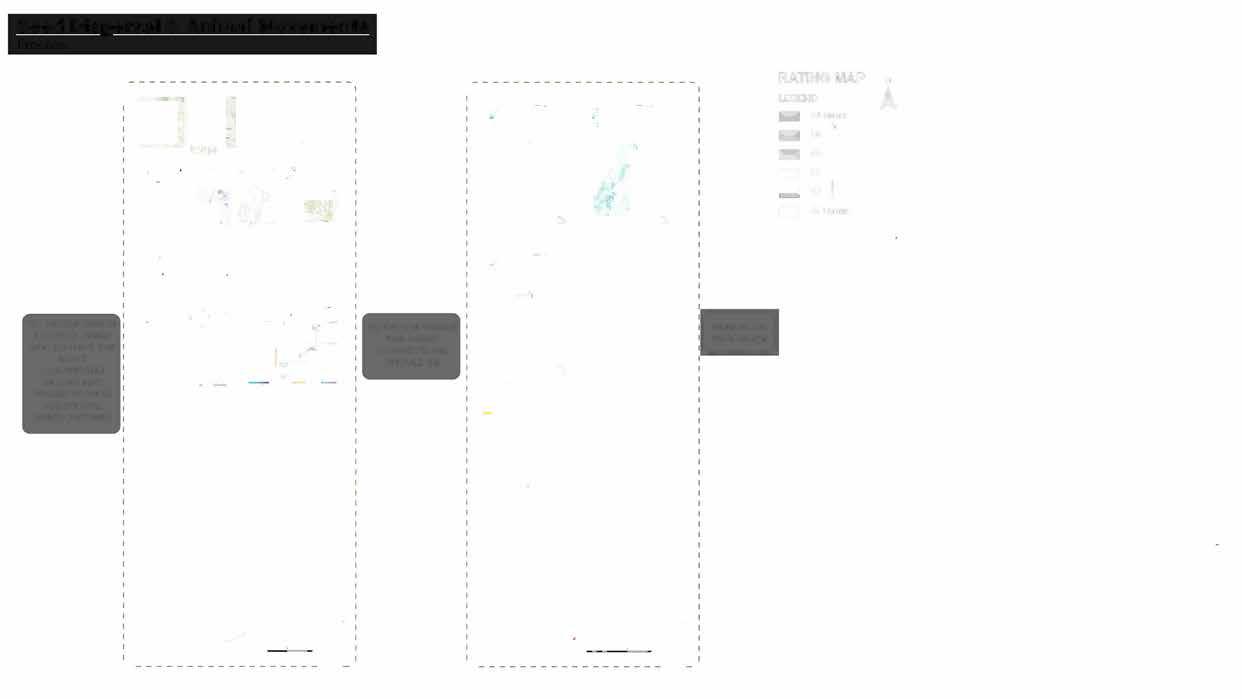














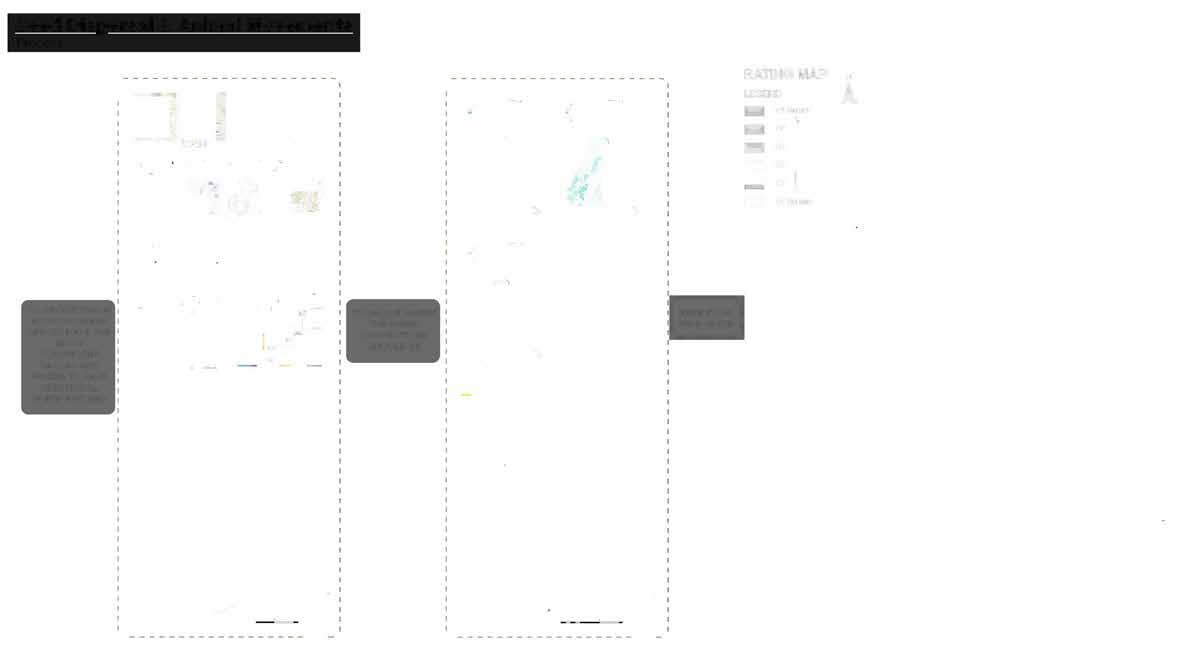
TO DECIDE WHERE THE GREEN CONNECTION SHOULD BE

, Contou,MapVegetationDensity Fragmentation li仁~J七 BarrierMap Arbo,ealAmas
`炉c ----, = -毛- I....」. GoondAnimalS ConopyLoyer BuildingsTraffic l一`-A一二心.:,·A 心心··•心一 . 丿 飞己 - A__, HydraulicLayer (NatureGr<upl overallEcologicalConnection , ._L ...壮几J 寸L `补心 尘日 ; 4 - { N A Arboreal Animals 口贮也一”“ Mo心eim记 ·' _ _ _ Ground Animals 勹贮书~如归 Mo”巳m论', ' ·'`', _ _ _ 叩lK1r、长 ..之6Q., 厂匕广UlHL尸气七一 • ·260B 1 A 7 A Flying Animals 口一 上1, .心 . 1 _ _ _ 厂L「Ulk亡·JL.,N ..m§ A \ Ij 动 仿 贮 E 勹 俨 、 Insect Habitat Suitablity Suitable Unsuitable Based on soil temperature and vegetation� density Water Flow Mitigation 5 4 3 Nature Human i, Contou,MapVegetationDensity Fragmentation li仁~J七 BarrierMap Arbo,ealAmas
DECIDE WHICH XISTING GREEN HAVE THE OST CONSERVING LUES AND TO HAVE ADDITIONAL PATCHES
炉c ----, = -毛- I....」. . GoondAnimalS ConopyLoyer BuildingsTraffic l一`-A一二曰心.:,·A 心心··•心一 . 丿 飞己 A__, HydraulicLayer (NatureGr<upl overallEcologicalConnection .,I ._L .. ...壮几J 一寸L `补心 尘日 ; 4 巳一一·守C___, 匕 气匕 TO DECIDE THE CONN ECTIONS SHOULD >>
Insect Habitat Suitablity Permeability Issue Suitable Unsuitable Open Field, Managed Turf le b at e g n-ve No Pervious Surface Impervious Surface Buildings Slope Analysis with Hydrology 40° Low High 0° Based on soil temperature and vegetation� density High Low Urban Green Bedok Reservoir Seragoon Scrbland PLAB Forest Seragoon Forest Quarry Tampines Forest Surface runoff Direction of waterfl ow Water Flow Mitigation 5 4 3 Nature Human 248
DECIDE WHERE GREEN ECTIONS HOULD BE



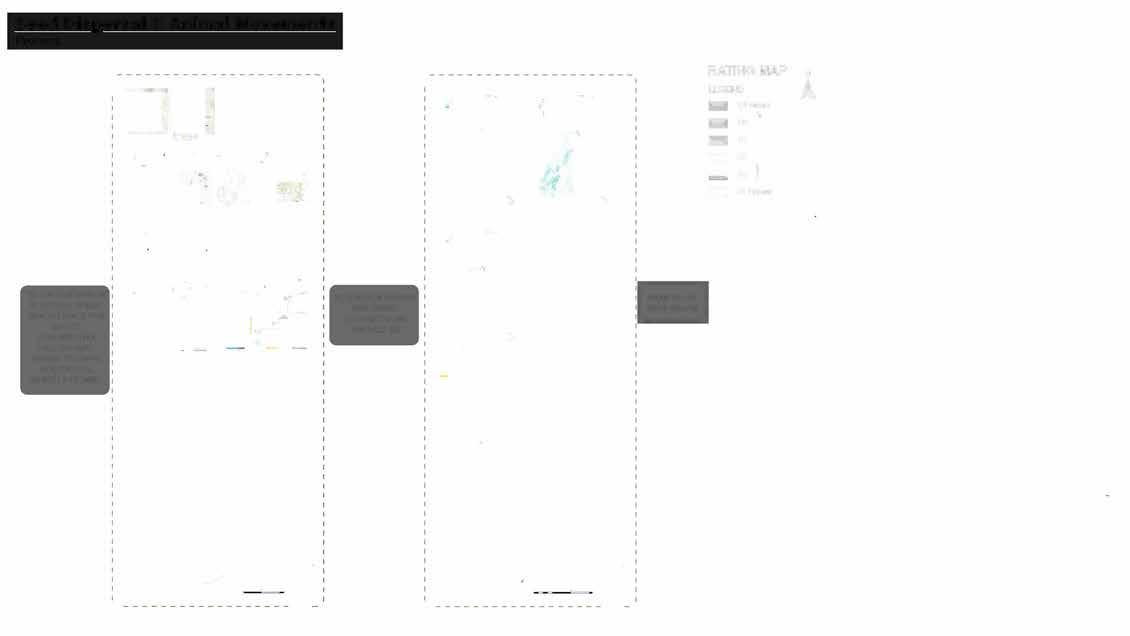
RATING MAP N LEGEND A _ 06 Nature 05 _ 04 03 02 [ 01 Human {
RATING MAPS Process Outcome
>> Arboreal Animals 口贮也一”“ Mo心eim记 ·' ```·``.' _ _ _ 叩lK1r、长 ..之6Q., 7 A Flying Animals 口扣一心 上1, . , ,'矗 1 _ _ _ 厂L「Ulk亡·JL.,N ..m§ A RATING MAP N LEGEND A _ 06 Nature RATING MAP 6 5 4 3 2 1 Nature Human 249
STAND BY WILDLIFE Negotiate, Diffuse, Appreciate
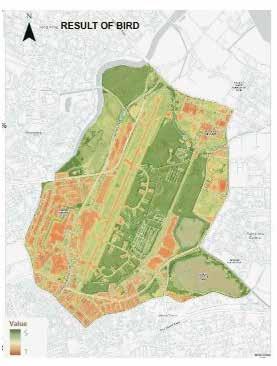

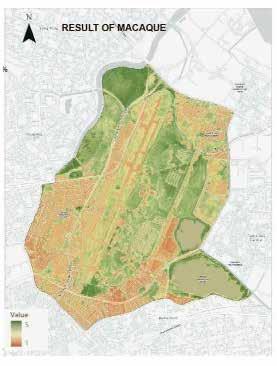

250
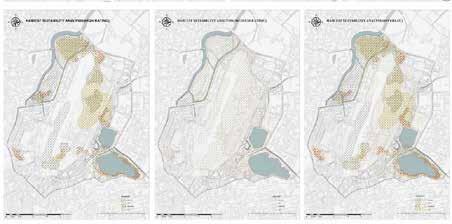
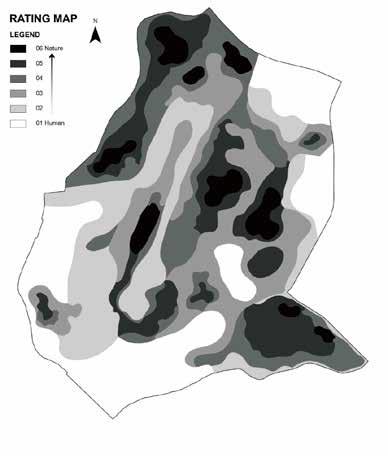

RATING MAPS Process Outcome 251
Nature as a Carbon Bank
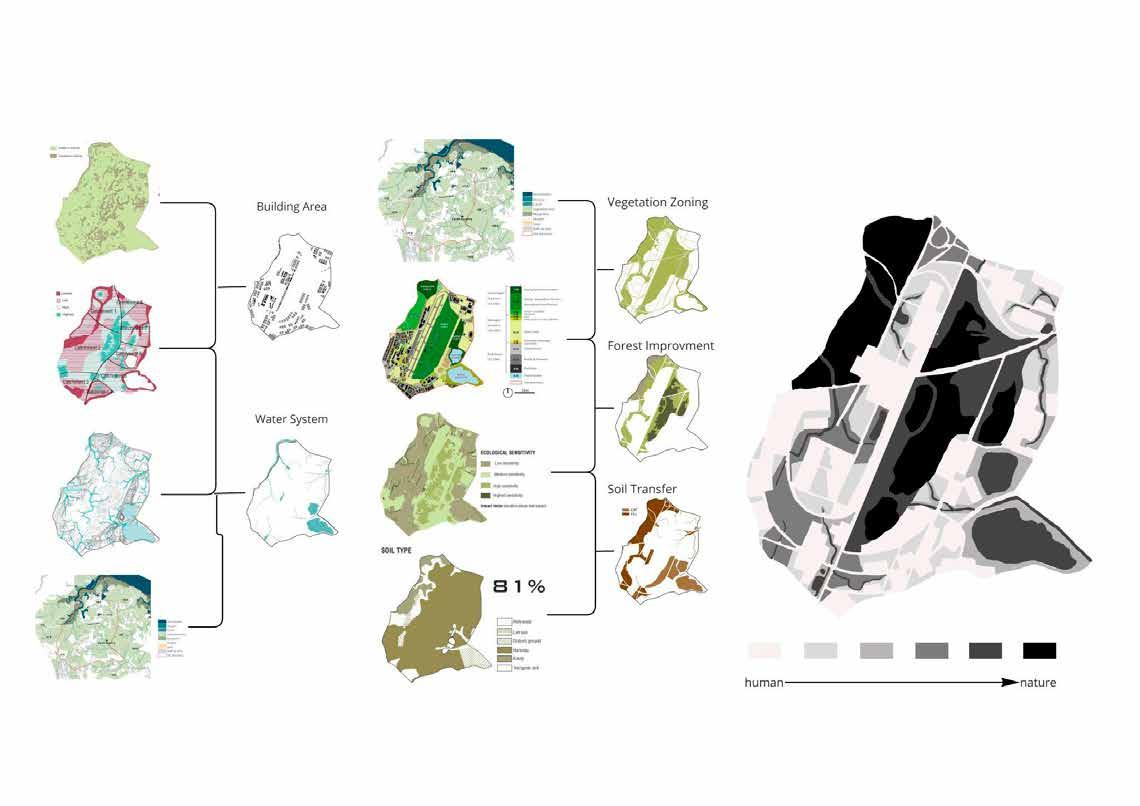
Process 252

253
PRODUCTIVE LANDSCAPE BUSINESSES





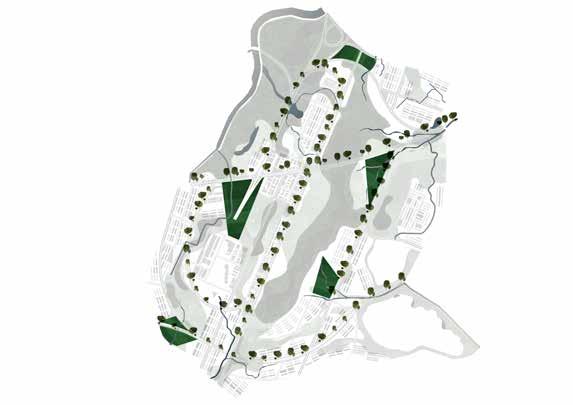
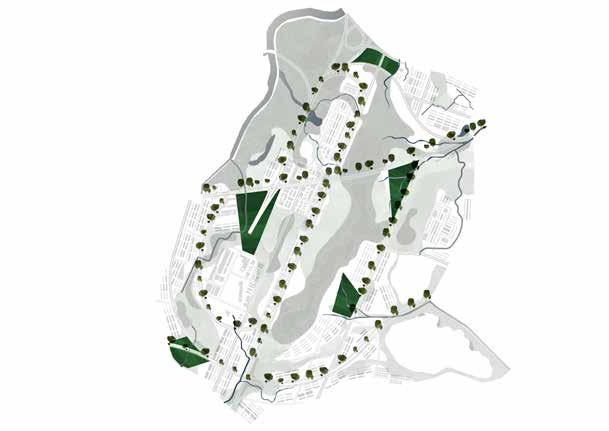
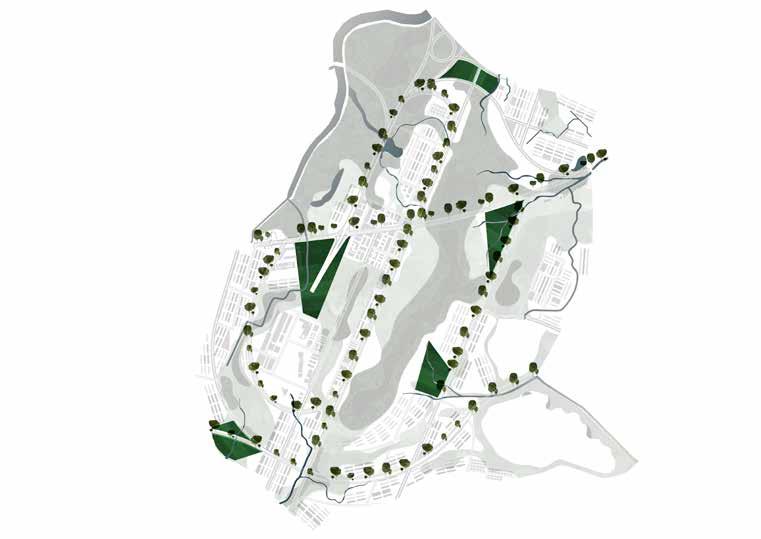

Develop, improve, engage

254


































255
STUDIO CONCEPT PLAN PROCESS















256
Negotiation






257
STUDIO CONCEPT PLAN
Overlap of rating and negotiation process
Concept plan is the overlapping of the rating maps of the four nature-focused groups to understand the different degrees from nature to the human area and negotiation between the nature and built environment on 3 main topics which are green & blue distribution, road systems and buildings to achieve overarching studio vision “regenerative plab”.
258



259


















Intervention and Phasing 260
CONSTRUCTION TIMELINE Site

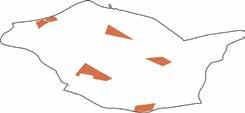


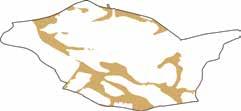

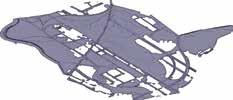

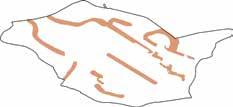
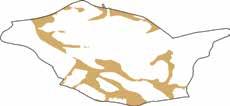

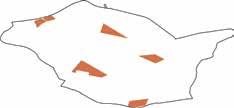


261

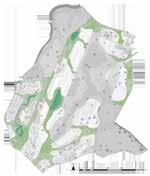

262
POTENTIAL INTERVENTION AREAS Issues and Strategies
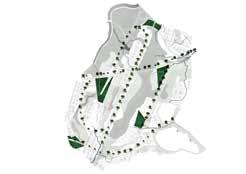

263
264
REGENERATIVE PLAB
CONCEPT MASTERPLAN TOPIC OF FOCUS
CP-BREATHING WITH SOIL
SEED DISPERSAL AND ANIMAL MOVEMENTS


WILDLIFE ECONOMIES
NATURE AS CARBON BANK
PRODUCTIVE LANDSCAPE BUSINESSES
265












Living soil isfor... Health y soilsrea alive!Home to 90% of allrgoanisms that live on earth. But soil is o ften neglected. Water Purification and soil contaminant reduction. Su rfaceR uno ff Con tanmination Exchange Carbon Sequestration Nutrient C ycling Climate R egulation Provision offood andfibre Cultural Heritage Foundation of human infrastructure Provide Habitat for a widerange of beneficial o rganisms Co 2 C Flood R egulation N P S A bsorb radiation Co 2 H 2o O 3 266
CO-BREATHING WITH SOIL
IMPROVEMENT, PERMEABILITY, INTERPLAY
Is soil really that important? The answer is usually yes, as mentioned in the textbook. But beyond book knowledge, people don't necessarily consider soil to be an important part of our lives, and they tend to ignore or dislike its existence.
In fact, as important as water and trees, soil is a key component of ecosystems and human life. Its importance is manifested in many ways, such as providing habitat for a wide range of beneficial organisms, as the foundation of human infrastructure, etc. All life on Earth depends on healthy, viable soil, which means we can only have a good life if we have good soil.
However, the soil conditions in Paya Lebar are not ideal. The results showed that there were three main problems with the soils on site, land-use change leading to surface degradation, reduced permeability, and negative perceptions of "dirt" and insects. First, drastic land-use changes have led to the deterioration of soils and their biodiversity, with some soils containing more pollutants and higher soil compaction. Second, excessive growth in infrastructure, urbanization, and human activity affects permeability and soil life, and creates a disconnect between surface and subsurface relationships. Finally, while insects have proven to have many benefits for soils and ecosystems, the distribution of insects has changed as the physical gap between cities and natural areas has grown, leading to a long-standing psychological fear of insects. The invisibility of soils in daily life also arouses people's unfamiliarity with soils, seeing them as dirt.
Therefore, in response to these issues, we propose a strategy, divided into three parts, to revitalize soil quality, allow soil to breathe, and allow humans to breathe with soil. The strategy consists of four sequential actions, starting with soil movement (providing a healthy soil base), habitat improvement (initiating natural regeneration), soil treatment (providing further sustainable improvement), and final action, human interplay (providing participatory maintain).
After completing the first cycle, improvements in soil quality, permeability and diversity will be achieved. The follow-up system will provide continuous soil improvement support for Paya Lebar, and is expected to achieve a stable, sustainable, regenerative cycle, and ultimately realize the co-respiration of people and soil.
267
Anchita Nitin Mirwankar, Cao Naichun, Zhou Sicong
ISSUE I: DEGRADED LAND SURFACE
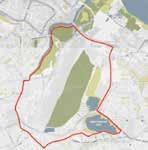


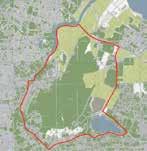

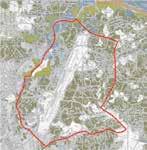
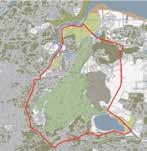
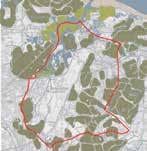
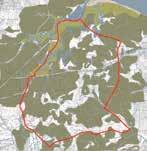
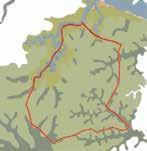
Over the years, land in PLAB have gone through various change in land use like tree cultivation, landfill, quarry excavation, grassland, built infrastructure. This drastic change has deteriorated the richness of ecosystem and biodiversity having pollutants and high compaction in soil.
Source: https://libmaps.nus.edu.sg/ , PLAB: RESEARCH REPORT
Tree cultivation Mangroves Swamp forest Water body Forest Sand/Mud Scrubland Grassland Public parks Site boundary Quary Low cultivation Rich in ecological habitats Expansion
Introduction
Grassland
Increase in scrubland, low cultivation and reduction quarry Qurry turned to waterbody, low cultivation to tree cultivation , rivers and stream canalised Introduction of landfill, managed greens, land
ecology
forest 1 km
Rubber
Issue statement 1819 1945 1958 1987 1974 1966 2002 2010 2022 268
of industrial land use
of pollutive landuse like landfill and sewage works
along PLAB run way and land use and quarry expansion
use and existing
converted to secondary
Cutting of existing ecosystem to expand
and coconut tree cultivation and quarry excavation
In soil classification
Soil life
Less soil life
Soil life reduced as compaction increased because of built areas and landfill
SOIL CLASSIFICATION
Compacted soil
Compacted soil(open fields)
Inorganic soil
Organic soil
Forest soil
BUILT AREA
In built spaces
Permeable areas
Polluted area
Built areas increased NPK nutrients in soil and reduced permeability.
Managed ecosystem
High biodiversity
Low diversity
Maintained organic soil green areas with less biodiversity.
New ecosystem
High diversity
Low diversity
Loss of existing forest and mangroves leading to new ecosystem.
Ecosystem + Water permeability
High
Low
Canalised stream, quarry turned water body changed ecosystem and reduced permeability.
Diverse ecosystem
Good soil
Degraded soil
603.50 ha
32.29 %
Reclaimed land Buildings
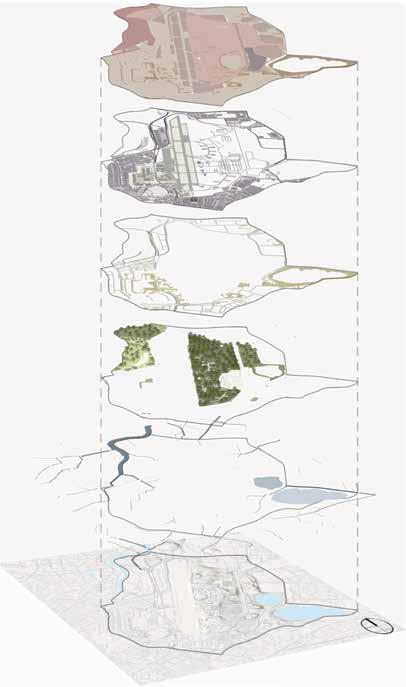
Paved areas Roads
Industrial zone
PLAB Airebase zone

MANAGED GREENS
140.25 ha
7.5 %
Streetscape greenery
Public and private parks
UNMANAGED GREENS
591.55 ha
31.64 %
Secondary dense forest
Young Secondary forest
Scrubland
Secondary forest + Scrubland
WATER BODIES

122 ha
6.53%
Bedok Reservoir
Tampines quarry
Seragoon river
SITE
1869.8 ha
The existing site have high pollutant zone, high soil compaction and prominent change in ecosystem leading to poor soil quality and life.The newly habitat emerged are secondary forest and scrubland thriving on poor quality of soil leaving behind rich habits like mangroves, low swamp forest. Currently, over 65 % of soil is has lost its quality and life.
269
ISSUE II: LESS PERMEABILITY Issue














































































































































































































Permeability analysis displayed high percentage of impervious surface in urban area. Nature area based on location, some proved to have poorer porosity which may cause damage to root growth and underground communities.






Source: PLAB Research Report; Geology of Singapore; Geological and geotechnical features of Singapore: an overview



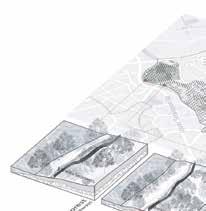






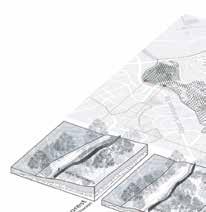










P Cd PERMEABILITY Tampines Forest Seragoon Forest PLAB Forest Seragoon Scrubland Bedok Reservoir Urban Green Non-vegetated Pervious Surface Impervious Surface Buildings Open Field, Mangaged Turf
Sand Sandy Loam Sandy Loam Sandy Loam
Loamy
Sandy Clay Loam
LOW - Lower Moisture Content+ High Soil Permeability - Insect Larvae Damage - Compacted Surface - Pollution - Inorganic Sandpile Cd
Tampines Forest Forest Scrubland Reservoir Urban Green Non-vegetated Pervious Surface Impervious Surface Buildings Open Field, Mangaged Turf Sandy Loam Sandy Loam
Sandy
LOW Bukit Tim ah Granite - Lower Moisture Content+ High Soil Permeability - Insect Larvae Damage - Pollution
Sandy Clay Loam
PERMEABILITY
Sandy Clay Loam
Clay Loam
statement
P Cd PERMEABILITY Tampines Forest Seragoon Forest PLAB Forest Seragoon Scrubland Bedok Reservoir Urban Green Non-vegetated Pervious Surface Impervious Surface Buildings Open Field, Mangaged Turf
Alluvium
Loamy Sand Sandy Loam
Old
[80.08%]
Sandy
Sandy Loam
Loam
Sandy Clay Loam
LOW HIGH Kallang Form ation Bukit Tim ah Granite - Lower Moisture Content+ High Soil Permeability - Insect Larvae Damage - Compacted Surface - Pollution - Inorganic Sandpile 270
Sandy Clay Loam

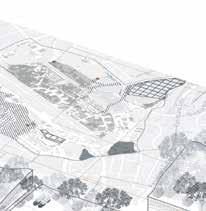
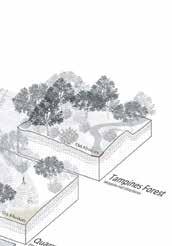
























Ca2+ Ca2+ K+ K+ P PP Ca2+ Ca2+ Ca2 Ca P P Ca C 2 Content+ Permeability Damage IDEAL - High Bulk Density - High Potassium - High pH - High Calcium - Low pH - Higher Soil Permeability - Lower Moisture Content + High Soil Permeability - High Calcium 271
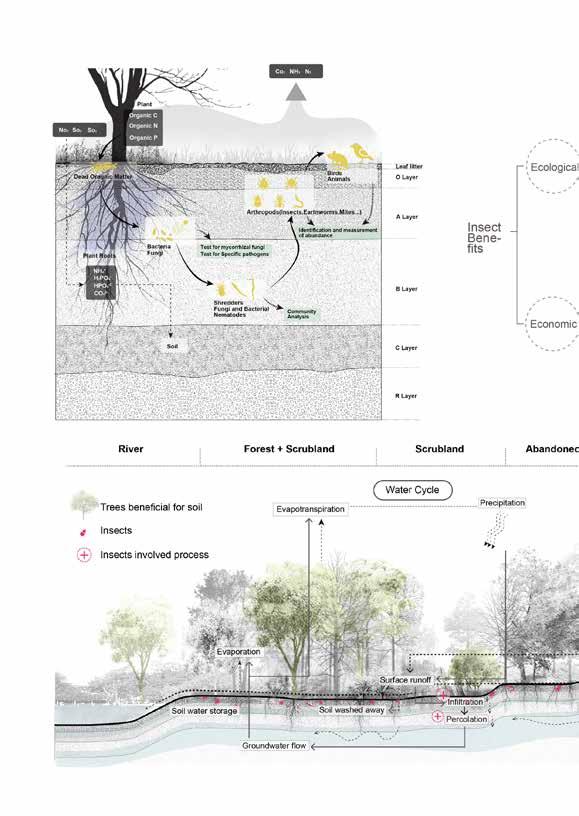
BENEFICIAL EFFECT OF INSECT 272

273
Source: httpS://www inaturaliSt org/obServationS?place id=any&Subview=map

274
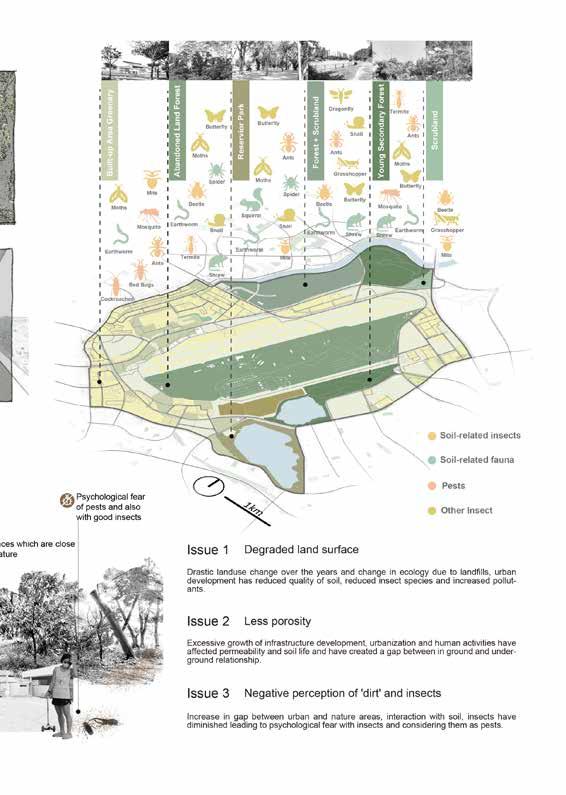
275
POTENTIAL AREA & VISION & STRATEGY
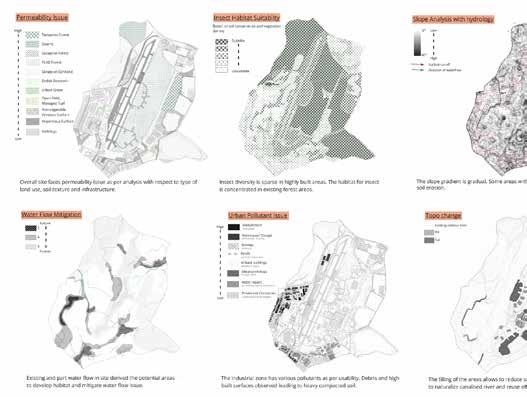

276
Vision & sTraTegy


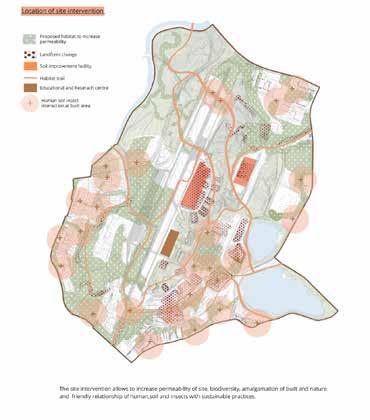
inTerVenTion area 277
ACTION I: SOIL MOVEMENT

Some part of forest area is replaced for proposed infrastructure and this soil which is high in fertility, soil life and less compacted is inserted in existing compacted built areas to increase permeability and soil quality.
The forest soil is divided into 2 types soil :
1.Type A which is a mixture of topsoil and crushed trees is inserted as base for proposed core vegetation.

















2.Type B is subsoil and parent rock used as base for recreational areas and streetscapes.






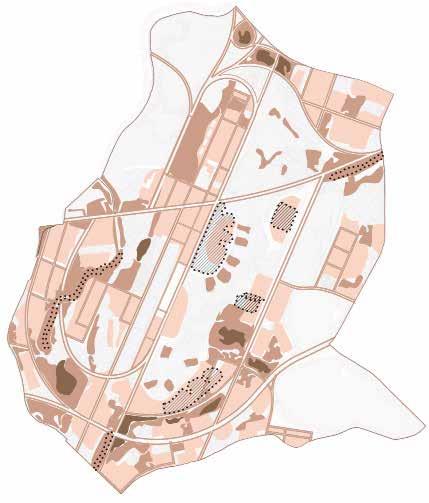
Type C is crushed concrete powder is used for paver block production in hardscape areas as permeable material. The volume obtained from the cutting for all soil types is used within the site.

Cut of Forest soil
Cut of Concrete canal


Soil type A
Soil type B
















Soil type C


Legend
SECTION THROUGH SOIL TYPOLOG
Proposed habitat Recreational
Top soil layer 0.3 m depth Sub soil layer 1.20 -1.50 m depth
Secondary forest Type A and B soil
park Paved pathway
1 km
Why Secondary 278
Tree crusher Combination of forest area Proposed habitat




























































TYPOLOGY AND ITíS MOVEMENT pathway Paved pathway Concrete canal Residential building Tree pit Tree pit Tree pit Tree pit Parent rock layer below 1.50 m Concrete Vegetation Paving SOIL TYPE A Secondary forest soil ? 1. Highly fertile 2.Less compacted soil 3.High soil life Combination of top soil and powder of crushed trees area Combination of sub soil and parent rock Crushed concrete powder recycled to use paver blocks Concrete crusher 530000 m3 675000 m3 134500 m3 SOIL TYPE B SOIL TYPE C Recreational park at residential area Paved area in residential zone habitat Top Soil Layer 0.3m depth Sub Soil Layer 1.2m-1.5m depth Parent Rock Layer below 1.5m Concrete 279
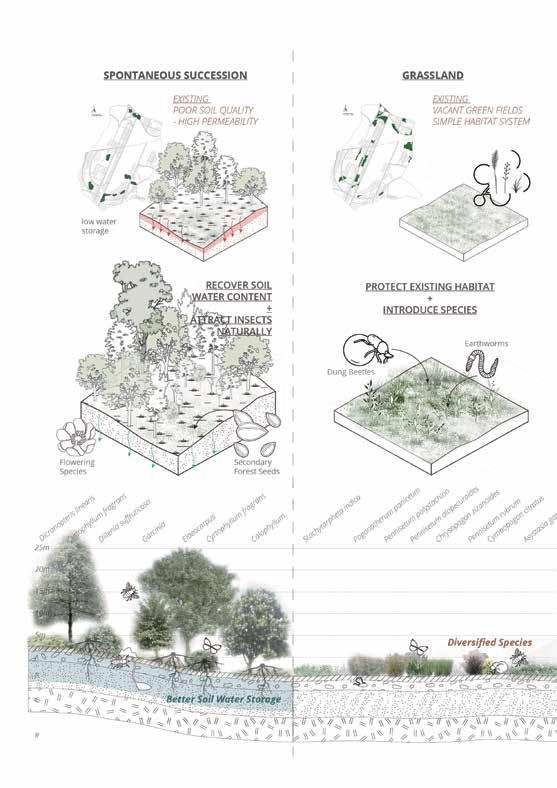
280
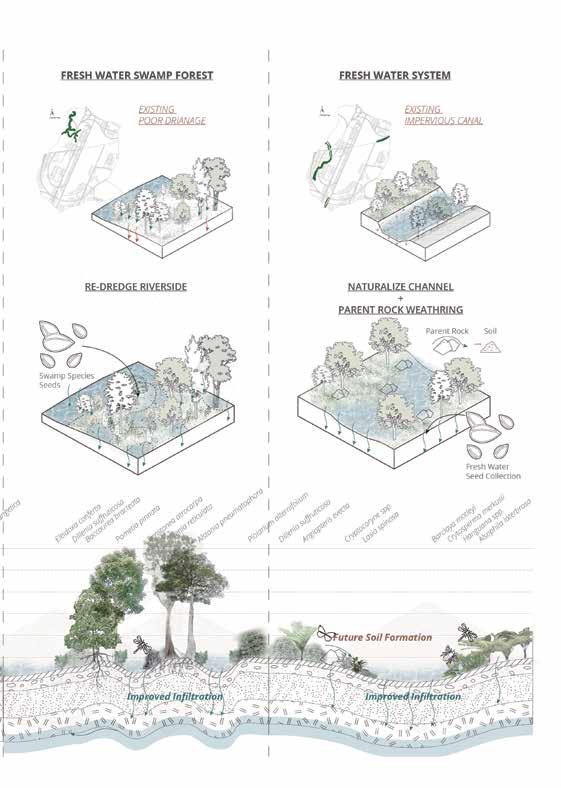
281

282
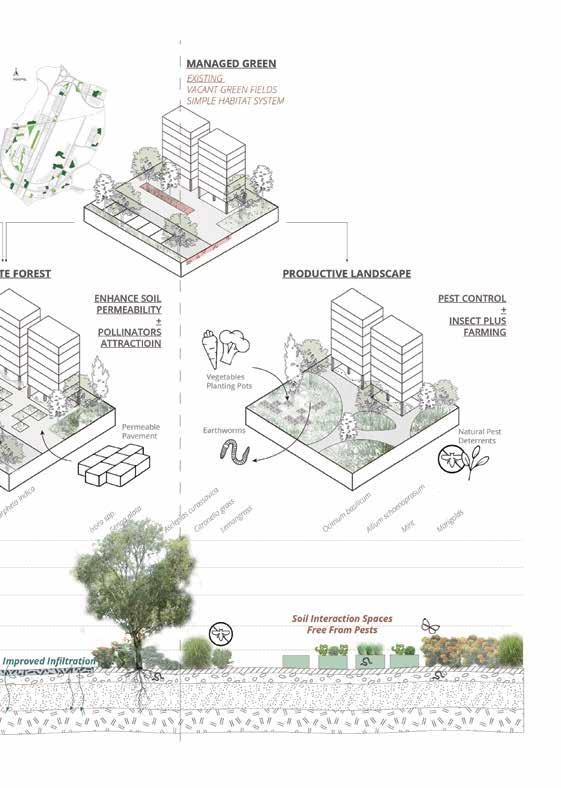
283
ACTION III: TECHNIQUES TO IMPROVE SOIL LIFE AND QUALITY




Source: https://www.towardszerowaste.gov.sg/foodwaste/, https://www.straitstimes.com/singapore/environment/project-using-black-soldier-flies-to-break-down-food-waste-set-to-expand-in
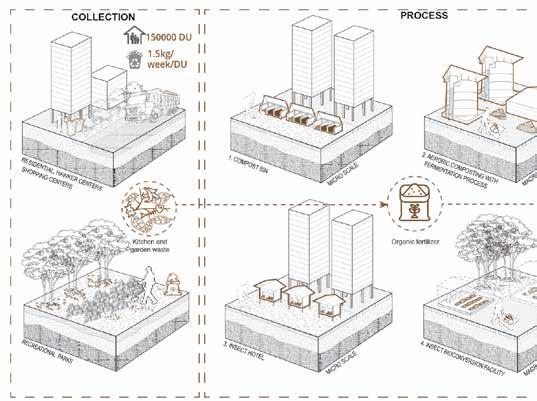
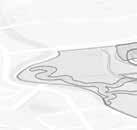
PHYTOREMEDIATION AREATION Before Areation After Core Removal Phytoremediation Plant / Transplant Reap / Collection 6-8 Weeks Later Nutrients, water, air can now enter soil species that can absorb contamination Compacted soil with shallow weak roots Increased density MULCHING Diameter at least 3 feet Depth 1-3 inches organiC wasTe TreaTmenT proCess 284
https://www.straitstimes.com/singapore/environment/project-using-black-soldier-flies-to-break-down-food-waste-set-to-expand-in



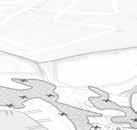
As Singapore has increased their percentage by 20% in food waste, use of organic waste in site to create compost then organic fertilizer is one of the ways to build soil structure, increase water holding capacity and provide a valuable source of micronutrients to plants. Macro level and micro level methods are used to create organic fertilizers.
Other techniques like Phytoremediation, Aeration are applied in particular areas highlighted in masterplan.
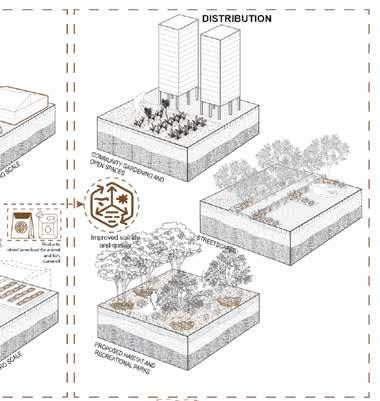



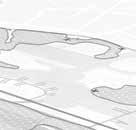
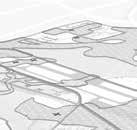
Mulching is a common technique to be used for forest and urban greenspaces.
 Collection of organic food waste to the treatment centres.
Micro level treatment process : compost bins, insect hotels and collection points of excess organic waste
Macro level treatment process: Aerobic and insect bioconversion facility
feet inches
Collection of organic food waste to the treatment centres.
Micro level treatment process : compost bins, insect hotels and collection points of excess organic waste
Macro level treatment process: Aerobic and insect bioconversion facility
feet inches
1 km 285
ACTION IV: HUMAN NATURE INTERPLAY





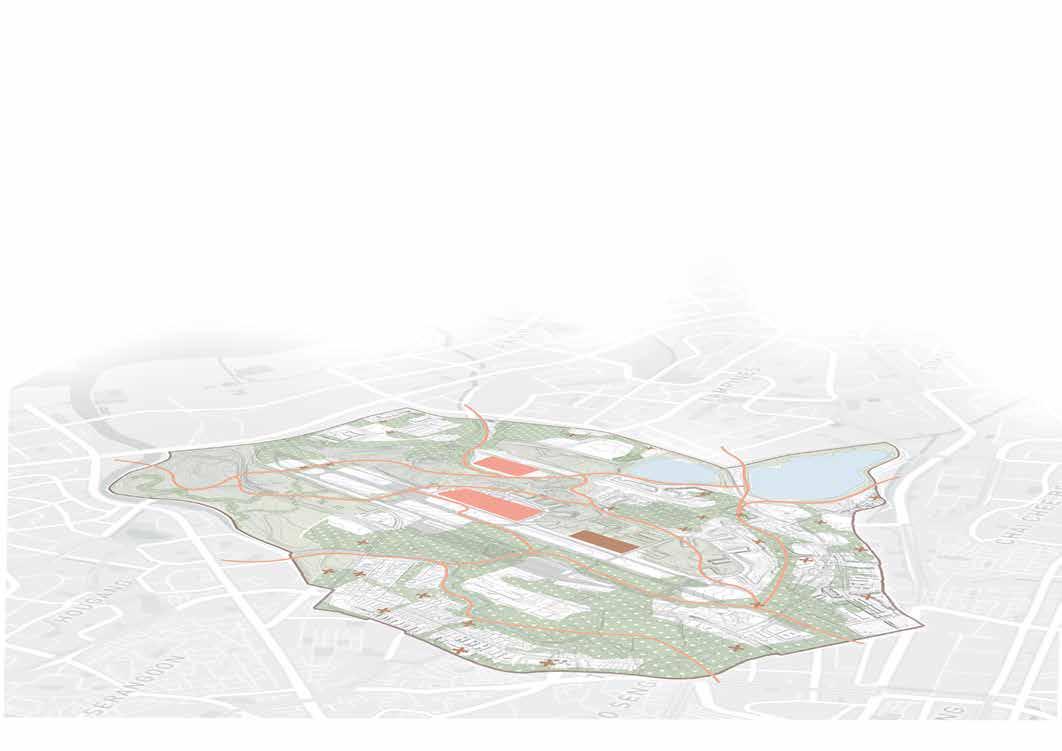
Insect & Soil App Character: Soil T
Insect + Soil
Insect hotel and composting
Insect Farming
Motorbike trail
Soil Research center
Insect hotel
Mud play
Elevated walkway in Freshwater swamp forest
MotorbikeTrail
Seragoon scrubland
Seragoon Forest
286
The main focus of human activity is to develop insect soil friendly relationship with human by changing modular living in Singapore. Encouraging participation for all age groups in activities like composting, insect towers in micro level neighborhood scale and macro site activities like trails connecting proposed and existing habitat, mud play, offroad biking, outdoor learning spaces, research centers and organic waste treatment to create organic fertilizer and insect soil education.
Tampines Quary
Bedok reservoir
Residenial zone
Commercial zone
Conserved zone

Habitat trail
Motorbike track Forest walk
Elevated walkway in Freshwater swamp frest
Food waste treatment
1. Aerobic compost treatment
2. Insect bioconversion
Reserach and education centre
Community enagement
1. Insect hostels
2. Compost making 3.Gardening

Naturalised canal
Museum and Research Centre
Compost making
Forest Walk
Community gardening
Outdoor learning
Heritage building
Nature play
Elevated pathways
Forest Walk
MotorbikeTrail
Secondary forest
500m
287
Legend

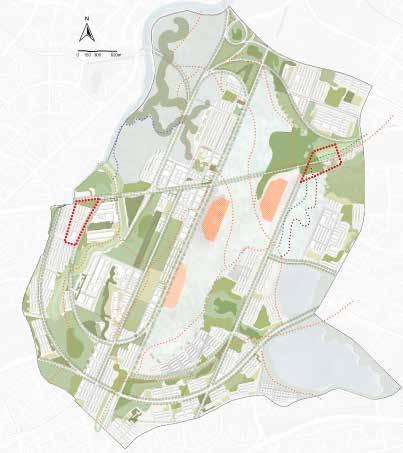
MASTERPLAN 288 siTe i siTe ii
TO HOMES
ORGANIC FERTILIZER PAVEMENT
CONCRETE GARDEN
PERMEABLE SURFACE


INFRASTRUCTURE
COMMUNITY GARDENS SOIL QUALITY
EARTHWORM
SUPPORT PARTICIPATION RENEGERATION
PERMEABLE SOFTSCAPE VEGETATION
SOIL
URBAN SOFTSCAPE
POLLUTION REMDIATION
PEST CONTROL
HABITAT WATER RELATED NATURAL INFILTRATION
ASSISTED NATURE
SPECIES DIVERSITY
Through design we achieve an interrelated circulation which allows co-breathing with soil possible. Infrastructure including food waste treatment, permeable surface, function as support system. Habitat, the regeneration system and human, the participatory maintenance system. Through the mutual support and cooperation of these three systems, the improvement of soil quality, permeability and diversity is achieved, and a stable, sustainable and regenerative cycle is expected to be realized.
HUMAN Achievement 289
GOOD SOIL - GOOD LIFE
FOOD WASTE TREATMENT RECREATION EDUCATION CO-BREATHING WITH
INSECT FARMING PER M EA BILITY DIVE RSIT Y

SITE I: SITE ANALYSIS 290

291
SITE I: SOIL MOVEMENT
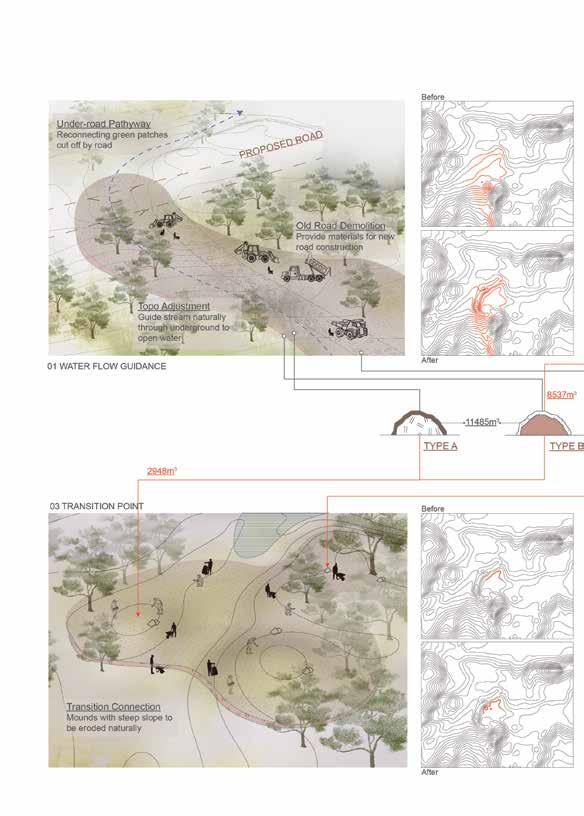
Action I
Given the proposed cross-slope adjustment of the road, the existing terrain required soil movement to connect the sides of the road for pedestrians and natural water flow
292
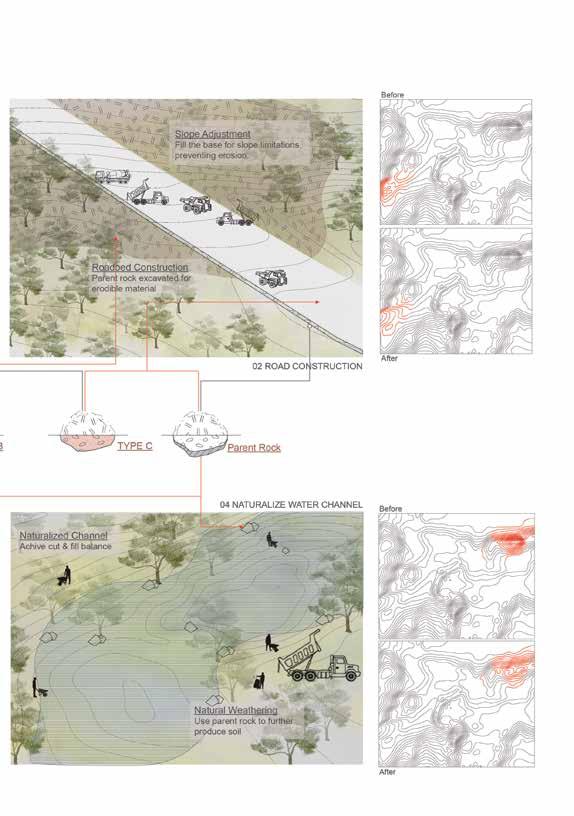
293
SITE I: HABITAT EVOLUTIONS
Source: Liu, T. et al., 2021. https://doi.org/10.3389/fevo.2021.643994
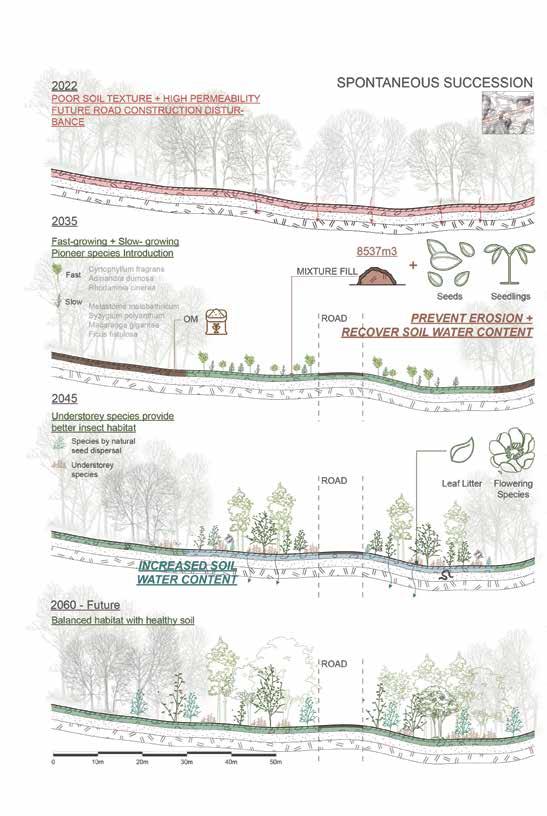
Action II + III
294
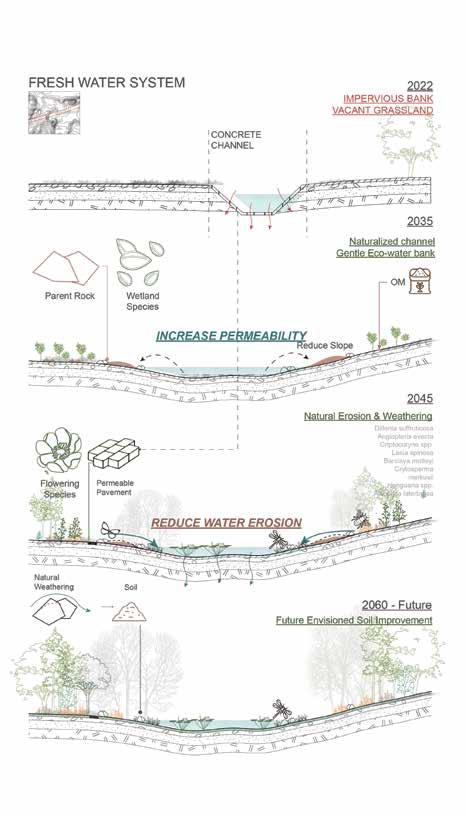
295
SITE I: HUMAN NATURE INTERPLAY Action IV








Proposed Type of biking
After movement of soil and naturalizing the canal, the intention of proposing human activities in this site is connect to develop awareness and attraction for mud play activities by connecting existing biking in Tampines forest to urban space and by connecting forest walk to proposed walkway along canal by proposing under road construction for seamless connection to increase soil insect interaction. 100 m
Zig Zag track
Slope : 17 ∞
Disturbance : Zig zag track
Degree of Disturbance : The slope is gradual with erosion.







Pedestrian
Plank road track
Slope : 0∞
Disturbance : Think wooden above the ground Degree of Disturbance




Plank above ground avoids disturbance to soil.

Under road connection Spider bridges for motor pedestrian
Allows to continue forest water front pedestrian walkway motor bike trail to connect trails and to guide water
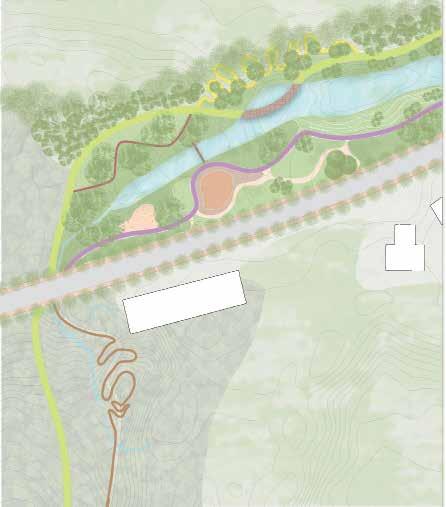
building Canal Existing road Tampines Forest Mud trail Plank
track
Master Plan for Site 2 Heritage
road
Zig zag slope track Deck track
walkway connects forest trail Forest trail Naturalized stream Under road connection Existing buildings
1. Mud play
2. Sand pit
3. Butterfly garden
4. Stepped seatings
5. Lawn
6. Recreational ground
1 2 3 A’ Nature play 4 5 5 6 6 A
Trail connecting to existing biking zone.
Legend
AAí
Zig zag slope biking track
Fresh water naturalized canal Deck track
296
biking tracks
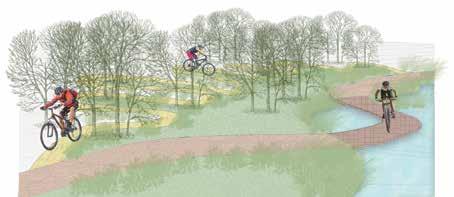
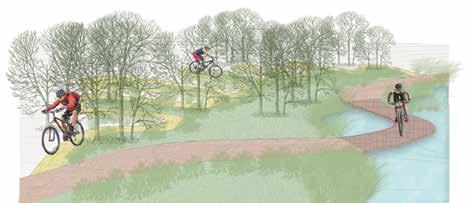
track in slope
zag track in slope
Disturbance : gradual with to avoid soil


























with to avoid soil
wooden plank : avoids

Think wooden plank

Disturbance : ground avoids soil.
Plank road track biking
Plank road track biking
connection motor biking and
motor biking and forest trail to connect walkway, existing connect proposed water to the canal.
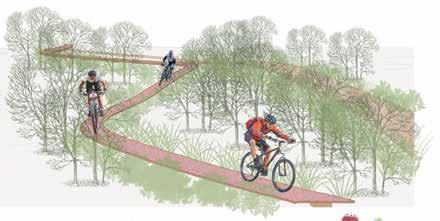
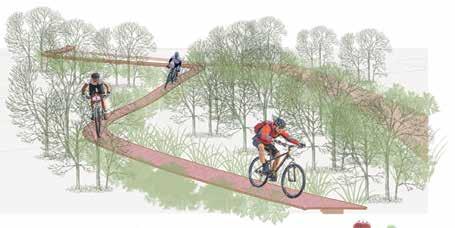
forest trail to connect pedestrian walkway, existing connect proposed water to the canal.
Mudplay for children
Mudplay for children
 Pedestrian walkway
Pedestrian walkway Road Lawn
Zig zag slope biking
Pedestrian walkway
Pedestrian walkway Road Lawn
Zig zag slope biking
297
SITE II: ISSUE ANALYSIS











WAREHOUSE/ STORAGE FACILITY

Debris and items over planting leading to disturbance to soil life.
Manufacturer



Warehouse / Storage Roads


Metal Workshop
Motor Repairs
Private Companies

Site Boundary
EXISTING BUILT
The landuse in site 2 is Industrial zone. Pollutants and excess built have compacted the soil, reduced soil life. The hardscape material reduces water permeability.

The vegetation observed is sparse due to compacted soil and poor soil quality.
BUFFER PLANTATION BETWEEN ROAD AND INDISTRIAL AREA
Trees
Site Boundary

EXISTING GREENSPACES
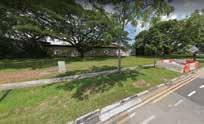
The ratio of green spaces with built area in site 2 is very low. Due to excess built permeabilty is less and pollutants are high in soil. The planting thrive on poor quality of soil.
Only human activity observed is pedestrial walkway

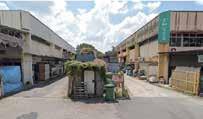

Green spaces acquired by storage leading to compacted soil, and soil life less planting.
As per analysis, the existing land use of site is industrial zone having pollutants, compaction, and poor quality of soil with sparse green spaces leading to less permeability.

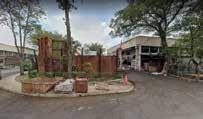


 GREEN PATCH WITHIN BUILT SPACES
GREEN PATCH WITHIN BUILT SPACES
298
SITE II: MASTER PLAN
Soil type B
Human soil insect interplay

Soil type C
Permeable paving (grass pavers)
Recreational space
Planting cracks on existing road
Car parking with permeable hardscape
Proposed buildings
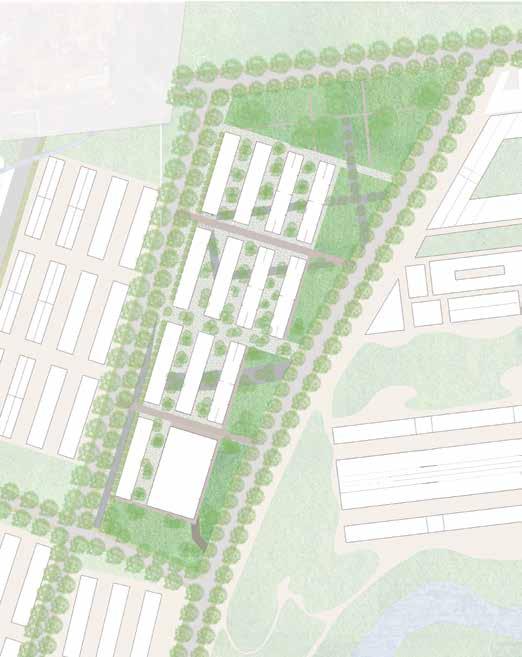
Vehicular connectivity
Pedestrian pathway connectivity
Legend 100 m
25 100 m
0
Site 2 Master Plan Layout
299
The site is designed for residential land use, community engagement spaces and car parking. Recreational spaces include some existing concrete roads which do not require demolition are retained and converted into concrete gardens by planting cracks. Proposed permeable hardscape and softscapes with sustainable human activities helps soil breathe.
SITE II PERMEABILITY

in the hardScape area, we add SoftScape patcheS and uSe permeable Surface to improve permeability
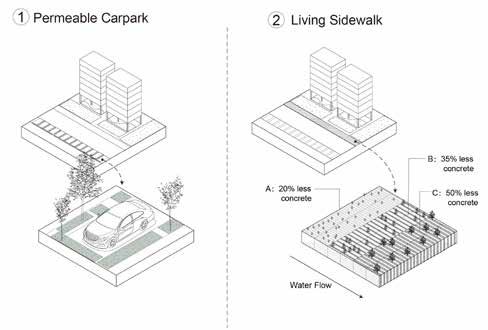

we import Soil type b and mix it with compoSt and garden Soil to make Soil mixture which be filled in original pit or Spread on the top of exiSting Soil
Source:https://landezine.com/texture-by-studio-basta-and-wagon-landscaping/ https://landezine.com/asphalt-jungle-paris-by-wagon-landscaping/
300


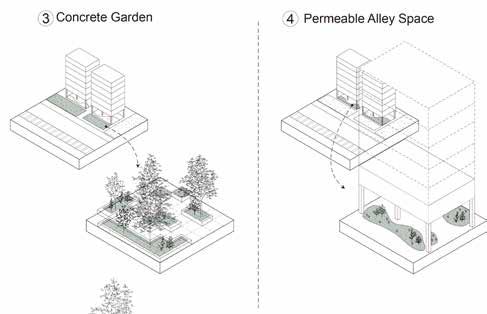
301
SITE II: ECOLOGY
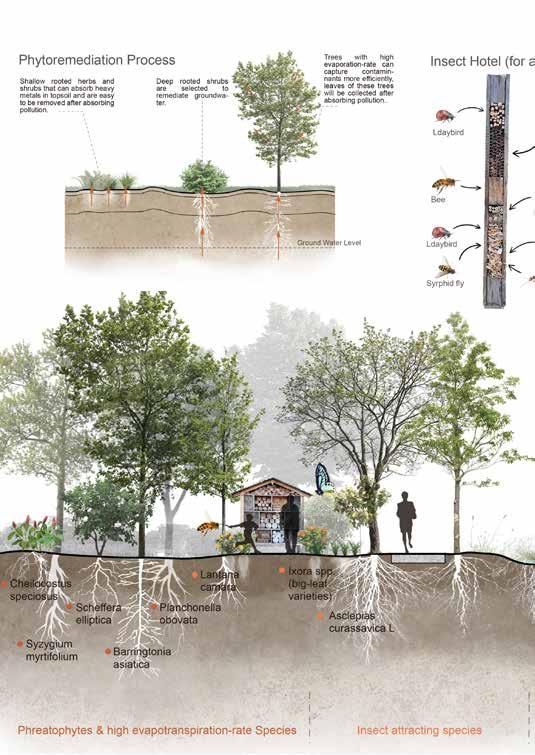
Action
302
Source:https://www.weforum.org/agenda/2021/11/this-insect-could-eliminate-food-waste-in-cities/ https://www.nparks.gov.sg/FloraFaunaWeb II
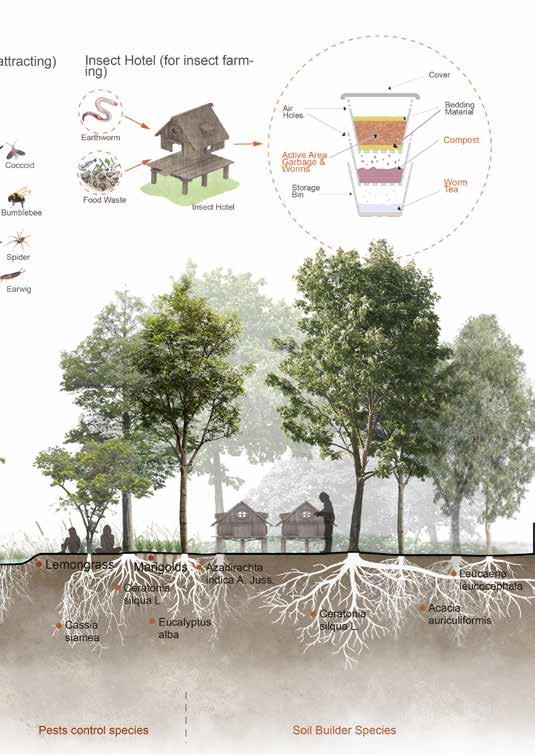
303
Action III + IV
SITE II: ACTIVITY Waste Treatment Process
Source: https://www.gooood.cn/urban-beehive-project-by-nine-yards-studio.htm
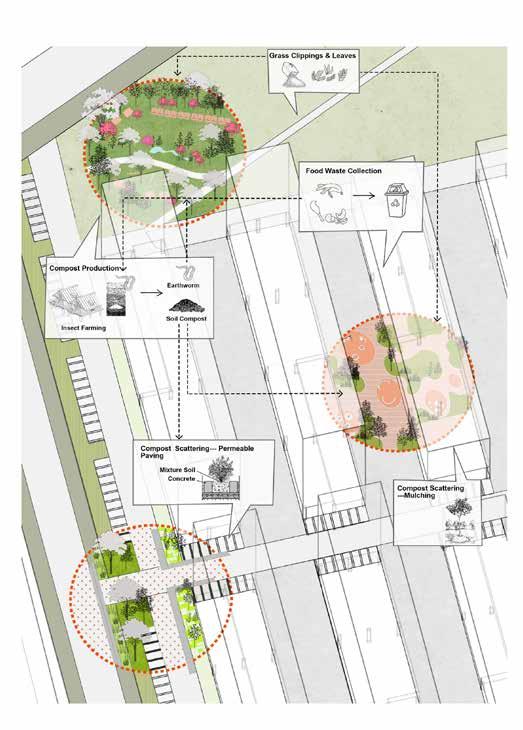
food waSte are collected from the reSidential buildingS, then taken to the community Space to make compoSt, the compoSt will be diStributed on StreetScape and in void deck to maintain the Soil condition 304
Community Space
In community space, there will be more interaction between humans and insects through activities like outdoor class and insect treasure hunt.
Streetscape
In Streetscape, more soft scape with various plant species and some bare land will help to attract insects and bring fun to people's street journey.
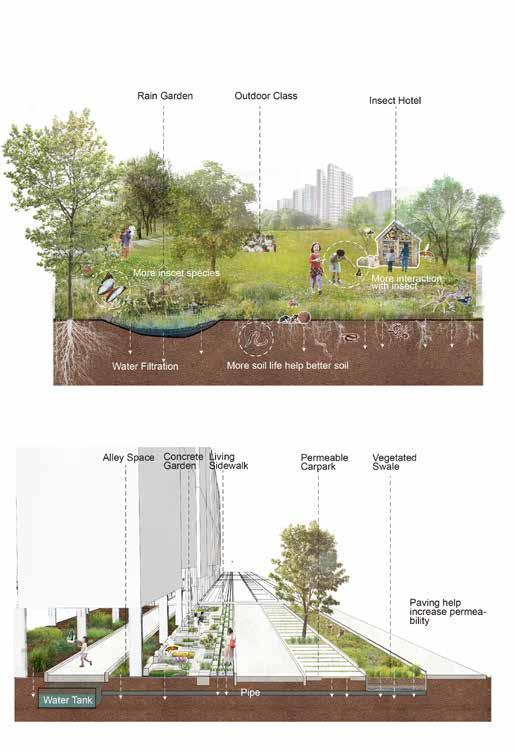
305


306
TRAVEL GUIDE OF SEEDS
BACKGROUND OF THE TOPIC; WHY IS IT A TOPIC OF IMPORTANCE
PLAB is an area among the most critical ecological patches and corridors in Singapore, taking a significant role in ecological connection with the potential to be an indispensable stepping stone in animal flow. Seed dispersal is one of the critical fundaments of establishing such a stepping stone. To improve the seed distribution both on a national and site scale, we focused on increasing animal movement by creating suitable and diversified habitats. And once the green connections are formed, a self-generative PLAB landscape will be established. The topic is significant in maintaining core wildlife habitats within the urban setting and discussing the potential of creating a self-generative landscape in a high-density urban environment in the long term.
VISION
As the primary dispersal method for this project, Wildlife movements provide great potential for long-term sustainable biodiversity development and promote PLAB as a critical ecological stepping stone on a larger scale. Our vision is to create nature-driven urban planning which prioritizes wildlife movements. It will promote a self-sustainable food system and opportunities for spontaneous landscapes in the long run.
CONCEPT & METHODOLOGY OF THE PROPOSAL
The identified issues on-site regarding our topic include lacking connectivity among green patches and existing hardscape structures that create barriers to animal movements, which is the key to seed dispersal. Targeting those issues, we concluded our concept of Self-Generative Landscape that focuses on Free-Flow, Soften, and Disperse. We utilized strategies from Spatial, Experiential, and Self-generative aspects. Strategies include - a) Spatial: Utilize topo and natural/manmade structures to create continuous linkage for both humans and animals. b) Experiential: Soften barriers at where human and animal movements intersect. c) Self-generative: Create diversified habitat and complexed patches through seed dispersal. We applied the three strategies from the PLAB scale to one selected site scale as an example to showcase the feasibility of our strategies.
CONCLUSION; HOW DOES THIS CONTRIBUTE TO THE OVERALL STUDIO MASTERPLAN
Based on the above strategies, we determined the core forest area needed to maintain the biodiversity of the site and the extent of the core movement paths required by the animals, which also influenced and implemented in our overall studio masterplan. Through the natural process and human interventions, we maximize patch connections and also ensure the free flow of animals, and increase the seed dispersal range on site. Ultimately, we achieved the goal of improving PLAB's ecological connections and patch complexity on both macro and micro scales through human intervention at the early stages, then transforming it into a selfgenerative landscape in later stages once all planned connections are established. And creating a community environment where people and animals co-exist harmoniously.
307
Xu Ruozhu, Chang Wanruo, Shi Yilan
Seed Dispersal and Animal Movements: Free-Flow, Soften, Disperse
ECOLOGICAL SIGNIFICANCE OF PLAB
Determination of Ecological Networks

Legend
Central Catchment Nature Reserve Least-resistance corridors
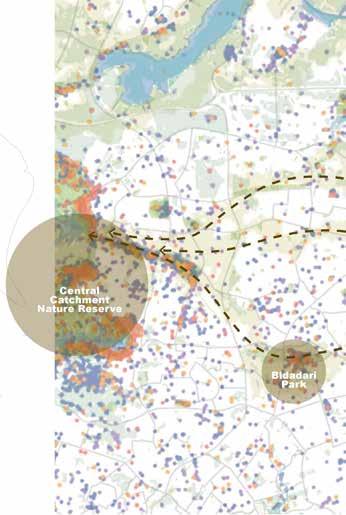

Tengeh Reservoir
Sungei Buloh Wetland Reserve
Pulau Ubin
Chingi
Labrador Park
Singapore’s vision - evolve Singapore into a biophilic city in a garden so that it could help mitigate the effects of urban air pollution and have a healthier living environment.
One of the large-scale planning strategies - to further build up the resilience of the urban system by enhancing ecological connectivity across the island.
The map above shows the projected ecological networks that animals are likely to use. The PLAB site, highlighted in red, situated within the identified corridors, also becomes a vital part of the overall greenery linkage connecting the fauna habitats from the northeast and southeast corner (Er, 2018).
Source: Er, K. (2018). Growing a Biophilic City in a Garden. CSC. https://www.csc.gov.sg/articles/growing-a-biophilic-city-in-agarden PLAB: RESEARCH REPORT. (2021). National University of Singapore.
308
A preliminary evaluation is conducted to understand our site condition in a bigger context. And as the map above shows, the discontinuous green spaces in PLAB are causing barriers along our site boundary and within our site, limiting animals from moving in and around.
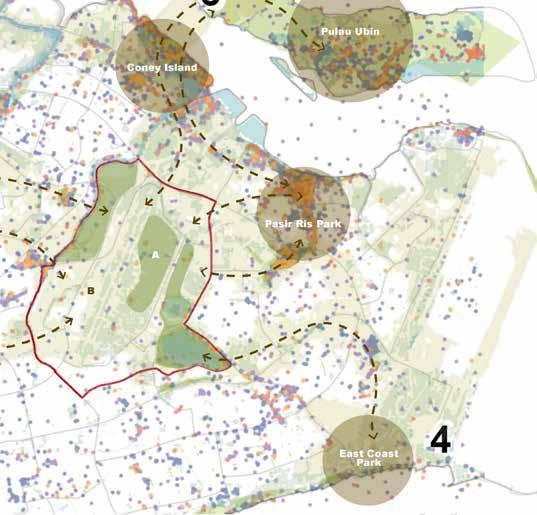
More specifically, area type A generally has higher existing vegetation density and coverage. Vegetation in the rest of the area (type B) is relatively scattered or urbanized. Therefore, when planning for future ecological layouts, the connections within area B and between A and B need to be further strengthened.

5 km
Legend
Reptiles
Mammals
Birds
Butterflies
Vegetation
Water
309
EXISTING SPECIES, PREFERRED HABITATS & FOOD RESOURCES



Research on PLAB flora and fauna includes typical animal species and vegetation. The information of seed size, dispersal methods and food resource condition is also illustrated. Five habitat observed in the site include streetscape, mangroves, urban parks, secondary forests and scrubland. The animal activity height ranges along with tree canopy height are demonstrated to show their relationship
Source : NParks website

310
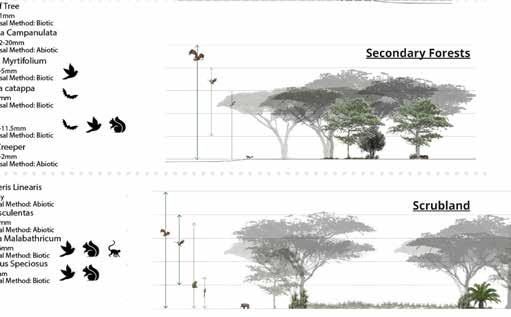
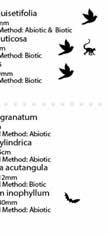
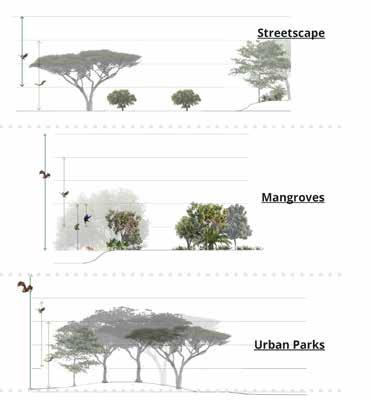
311
SEED DISPERSAL METHODS

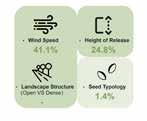
Background Information
exisTing wind direCTions and surFaCe Flowing direCTions

Legend
Water Flowing Directions
Wind Directions
Site Boundary
Controlling Factors

Wind Dispersal
Water Dispersal

Legend
Birds
Banded Surili
Dusky Leaf Monkey
Secondary Forest
Scrubland
Roadside Green Roads
Paved Park
Finlayson’s Squirrel
Long-tailed Macaque
Plantain Squirrel Raffles’ Banded Langur
Snooth-coated Otter
Waterbodies

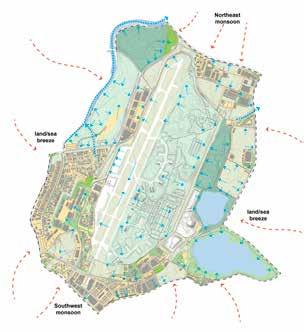
Open Field Buildings
Green Space
Secondary Froest & Scrubland
1 km
The seed has three main dispersal methods: wind, water, and animals. The wind on-site comes from all directions and has too many varieties, so it will not be considered for this project. Animal dispersal will be the primary planning approach, while the water on-site can help with animal movements when further water connections are developed.
Source: PLAB: RESEARCH REPORT. (2021). National University of Singapore.
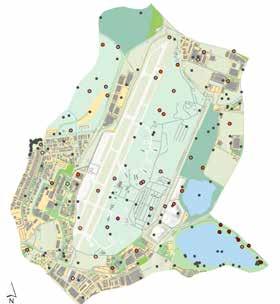 CurrenT Fauna map
CurrenT Fauna map
312
Arboreal & Ground
Ground Animals
ESTIMATION OF ANIMAL MOVEMENT ROUTES AND SEED DISPERSAL RANGE
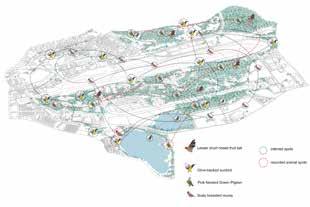

Flying Animals
Existing Seed Dispersal Range
Scrubland and sparse woodland:Plantain squirrel

Grass and shrubs: Scaly breasted munia
High density forest: Forest birds, Primate, Fruit Bats
From this figure, it can be seen that some spots in urban areas that are not being covered and disconnected. And when future development comes in, we need to keep such coverage as much as possible by conserving the most valued patches and increasing ecological connectivity.
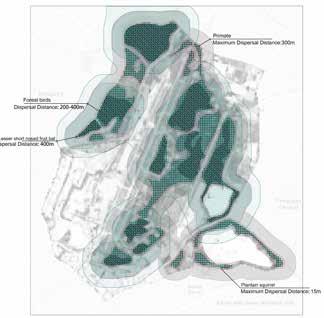
1500 m
1. Kitamura, S. (2011). Frugivory and seed dispersal by hornbills (Bucerotidae) in tropical forests. Acta Oecologica, 37(6), 531–541. https://doi.org/10.1016/ j.actao.2011.01.015
2. Flora Fauna Web. (n.d.). FLORA & FAUNA WEB. https://www.nparks.gov.sg/florafaunaweb3.
3. ADW: Search ADW. (n.d.). Animal Diversity Web. https://animaldiversity.org/search/?q=Viverra+tangalunga&feature=INFORMATION


4.LSM4254 - Principles of Taxonomy and Systematics: Species Pages on the Biodiversity of Singapore - Taxo4254 - Wiki.nus. (2020, October 6). Principles of Taxonomy and Systematics: Species Pages on the Biodiversity of Singapore. https://wiki.nus.edu.sg/display/TAX/LSM4254+-
5.Tsuji, Y., & Su, H. H. (2018). Macaques as Seed Dispersal Agents in Asian Forests: A Review. International Journal of Primatology, 39(3), 356–376. https:// doi.org/10.1007/s10764-018-0045-7
inferred SpotS inferred
recorded animal SpotS recorded animal SpotS
leSSer Short noSed fruit bat olive-backed Sunbird pink necked green pigeon Scaly breaSted munia
SpotS banded leaf monkey macaque plantain Squirrel wild boar
313
SITE CONDITIONS ANALYSIS

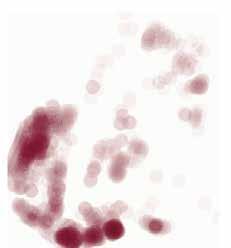
Natural connectivity is influenced by vegetation density canopy layer. With these information, we could tell the potential area to be future core protected areas. With the awareness that fragmentation, building density and traffic condition can affect the natural connectivity, we overlapped the information to arrive the barrier maps.
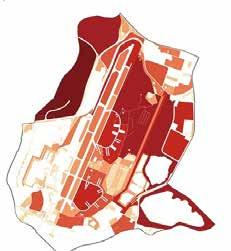

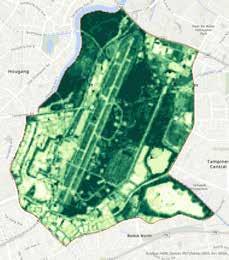
Vegetation Density

Contour Map
The area with the highest vegetation coverage and denser topographic changes has higher biodiversity potential. Therefore, the darker and highlighted area can potentially be selected as the core forest area.
Fragmentation Buildings
Continuous 314
Fragmented Low Density High Density
From the tree canopy distribution map, we can see that some areas lack canopy connectivity, especially the blank space in the center of the field, which hinders the movement of animals, especially arboreal animals in the field.

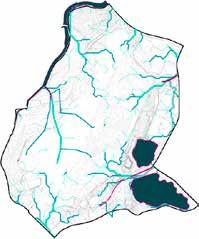
According to the living habits of animals, the surface runoff of the site has a high probability of becoming their main movement corridors and habitats.
1000 m
The degree of fragmentation of each patch, the density of buildings and the width of the road network will determine how much each regional boundary hinders different species.
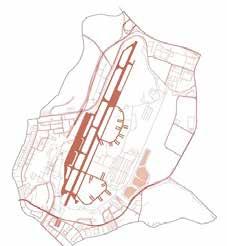
 Canopy Layer
Traffic Site Photos to show examples of barriers
Hydraulic Layer (Nature Group)
Canopy Layer
Traffic Site Photos to show examples of barriers
Hydraulic Layer (Nature Group)
315
BARRIER MAPS
Arboreal Animals
Ground Animals
The barrier maps are divided by 3 animal groups: arboreal animals, ground animals and flying animals. There are landscape elements related like fences, greenery and construction condition affecting natural connection in PLAB. We evaluated the connectivity condition of PLAB and illustrate from red to blue.
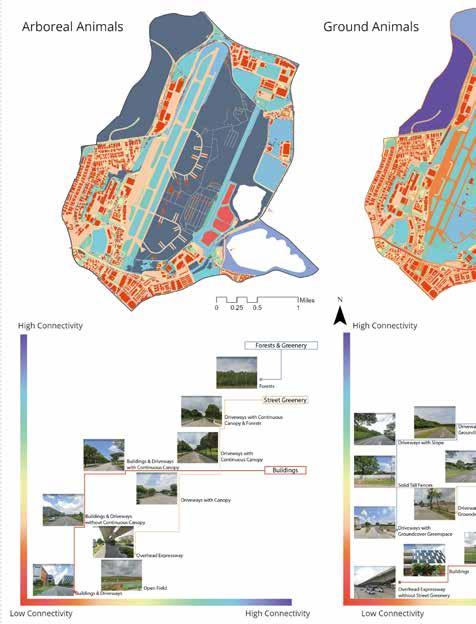
316
Flying Animals
The barrier conditions are influenced by fragmentation, building density, traffic condition and vegetation density. Taking these conditions into consideration, we get the result of barrier map to determine the areas to preserve and barriers that require strategies to soften them.
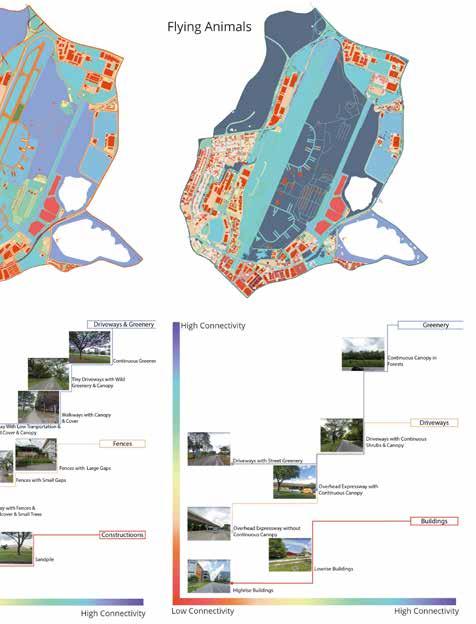
317
PROCESS OF STRATEGIC PLAN GENERATION
From Disconnected Patches To Ecological Web
Conserved Patches
Concluded from the previous pages of study on existing conditions of our site with our targeted animal types, now that we have the patches we want to keep, we then need to decide where the green connections should be.

Least-Cost Paths
With the least cost path tool in ArcGIS, we put in the moving time for the three animal types to go through each landuse; we calculated and got the outcomes of the most direct paths (or least-cost path) for them to use.

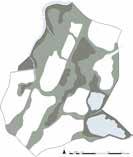
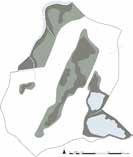
Major Connections
Following this result, we overlaid the least-cost paths on top of our conserved patches layout, and in consideration of the overall PLAB ecological connection conditions; we identified the major connections to form a better-connected system to strengthen PLAB's role in the overall context.


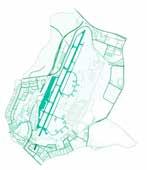

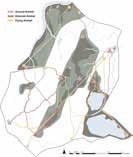
Ecological Web
In the final ecological web layout, we aim to allow the animals' free flow, so a more interconnected ecological system is formed so that it ultimately helps the dispersal process to achieve the selfgenerative purposes.
Ground Animals
Strategic Plan
Arboreal Animals
Flying Animals
Conserved Patches
Least-Cost Paths
Major Connections

318
1 km
Our proposed strategic layout shows that it is now linking with the adjacent corridors so that animals can move in and out of our PLAB site easily through core forests and nature parks.

It is also well connected within our PLAB site through riverscapes, community corridors, and streetscapes to allow arboreal and flying animals' free-flowing mode.
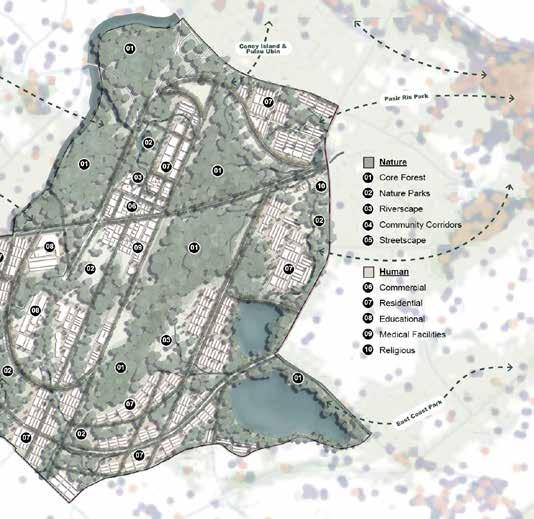
Legend
319
Ecological Web
COMPARISON OF BARRIER MAPS
Arboreal Animals
Ground Animals
FlyingAnimals
Actions taken to soften the barriers: Connecting the significant green patches together, reduce the fragmentation of PLAB
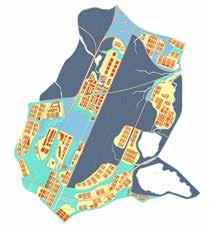

Adding ecological corridors between the patches, maintaining the movement paths


Lowering down some buildings with green rooftops added Improving water front habitat as important movement corridors
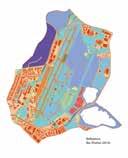
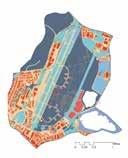
Before Before Before After After After
320
1 km
COMPARISON OF LEAST-COST PATH

Before and After of Proposed Layout

1
What's Changed
Reduced barriers within large core forests for ground animals to thrive without making too much travel to other patches. Smaller patches used by arboreal and flying animals were added along the edge of our site to place PLAB in a better-connected ecological linkage in the bigger scale. Within our PLAB site, additional green patches and corridors allows the arboreal and flying animal movements start to free flow

km Before Legend After
321
HABITAT TYPES AND ASSOCIATED FAUNA SPECIES

The habitats of the different animals in the site and the types and ranges of seeds they can disperse. These determine where target animals tend to feed and where they can disperse these seeds.
Source :FLORA & FAUNA WEB
LSM4254 - Principles of Taxonomy and Systematics: Species Pages on the Biodiversity of Singapore - Taxo4254 - Wiki.nus. (2020, October 6). Principles of Taxonomy and Systematics: Species Pages on the Biodiversity of Singapore. https://wiki.nus.edu.sg/ display/TAX/LSM4254+-
322
Waterfront Scrubland
Core Forest
Seed dispersal distance
Fauna Species
Crown width
Seed species
Source: ADW: Search ADW. (n.d.). Animal Diversity Web. https://animaldiversity.org/search/?q=Viverra+tangalunga&feature=INF ORMATION
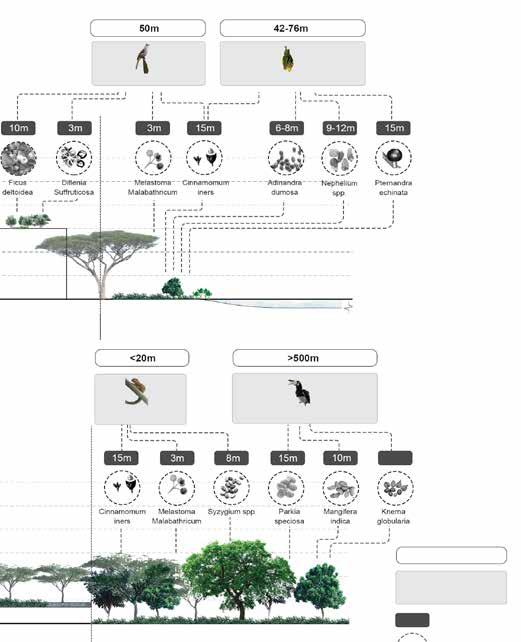
Top
Yellow vented bulbul Lesser Dog-faced Fruit Bat
Plantain squirrel
Oriental pied hornbill
323
PROCESS OF SEED DISPERSAL & SUCCESSION
This figure shows the changes of plant distribution in different periods of the site through two manual interventions and seed self-generative.
LEGEND
Mature tree (nature)
Young tree (disperse from nature)
Seed dispersal area (from nature)
Preserved forest and first human intervention.
Start the second human intervention. The first planted trees have matured to provide pathways for certain animals, at the same time, there is enough shade to support the growth conditions of long-lived tree species.
Purpose of huaman intervention: To help increase site connectivity, allowing birds and arboreal animals to move around the site as quickly as possible.
Requirements for selected species: The maturity is short, and the seedling period can grow in the sun.
Planting range: Main wildlife corridor and waterfront area.

Purpose of huaman intervention: Enrich the types of plants and habitats.
Requirements for selected species: Long-lived tree species that can provide a food source for more animals.
Planting range:
Away from human living areas, choose the main animal activities such as waterfront areas.

324
Mature tree (from first human intervention)
Young tree (disperse from first human intervention)
Seed dispersal area (from first human intervention)
Mature tree (from second human intervention)
Young tree (disperse from second human intervention)
High control area
Allow self-generative area

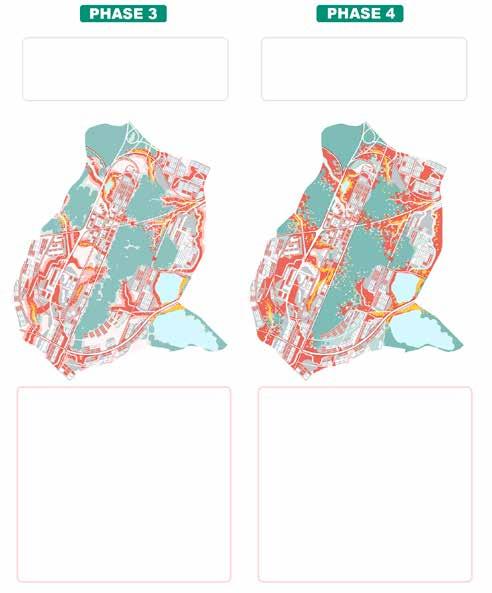
Water
Habitat types are beginning to increase. Final plant distribution pattern on site.
Most of the animals can move between the main patches of the site through the wildlife corridors, further increasing the range of seed dispersal, and the plant types of habitats are beginning to be abundant.
2000 m
Some long-lived tree species replace pioneers and become the main tree species in animal habitats, and the habitat structure tends to be stable.
325
CONSTRUCTION PHASING
Conserved Waterbody

Conserved Forest
Conserved Buildings
Conserved Roads
Forests
Waterbody Habitat Improvement
Waterbody Changes
Animal Rescue Center
Eco-link
Denser Forests
Corridors and Patches
Streetscape
Waterbody
Main Roads
Animal Movement
Potential Movement Destinations Buildings
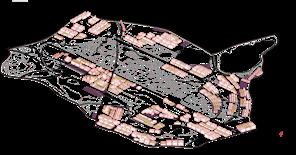
Green Rooftop
Areas
1,000m
Construction Contents
Phase1
Conserved Forests
Conserved Buildings
COnserved Roads
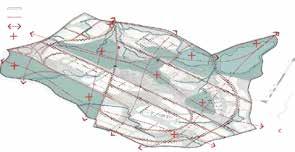
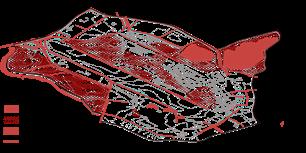
The first phase is about circling out conserved new waterbody then the water habitat will be in the phase3, because of the expanded forest more.The main roads will also be constructed Finally in the phase 4, there will be pavement,
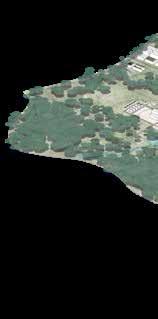
5
years Phase1
Final Phase 5-10
10-15
10
Paved
Phase2 Phase3 Phase4
years
years
years
1,000m 1,000m 1,000m
New Waterbody Phase2
326
Phase2
New Waterbody Modification
Waterbody Habitat Improvement
Phase3
Denser Forests

New Animal Movement and Destinations
Corridors and Patches
Eco-link
Infrastructure ( Animal Rescue Center)
Main Roads Construction
Streetscape
1,000m
Phase4
Buildings
Green Rooftop
Pavement
Minor Roads
conserved areas. Some roads, buildings, waterbody and forests will be conserved. In phase two we are going to modify the land to propose be improved at the same time. forest and the proposed corridors and patches in the site, we will have more animal movement and will accelerate the dispersal process constructed along with streetscape and infrastructure. pavement, all the buildings and secondary roads to be constructed.
327
SITE SCALE PLANNING - SITE SELECTION Application of
Proposed Strategies
PLAB Site
2 km
In the following pages, we will apply our three strategies considering self-generative, spatial, and experiential, again in the selected site to see how we tackle the connectivity issue and promote the seed dispersal process so that the free-flow, soften, and self-generative goals can be achieved.
And there are two key reasons for choosing this site. One is that the site contains one of the critical ecological corridors that connect three primary core forests. The site also includes various typologies that could be analyzed and applied to other PLAB sites. Typologies include from forest edge to urban space, within the urban spaces, within the core forest areas, etc.
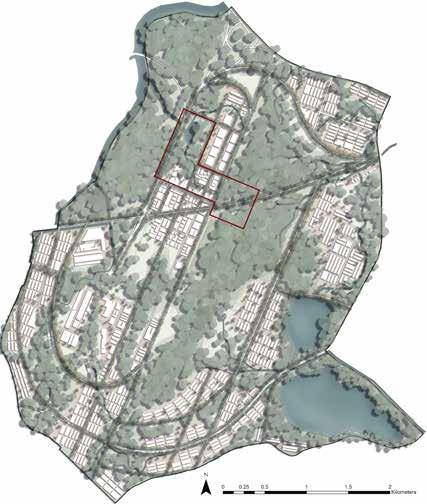
328
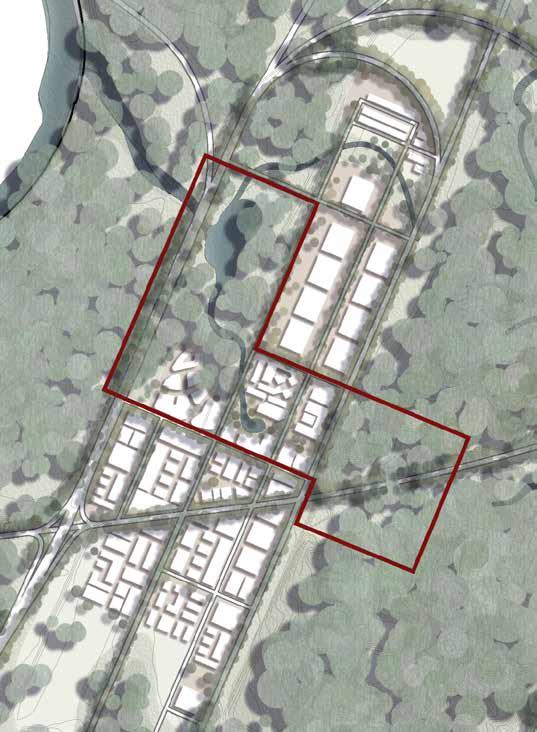
500 m
Forest
Forest
Core
Core
Nature Park Commercial Commercial Residential Residential 329
Core Forest
SELF-GENERATIVE PROCESS
Changes of plant maturity in different periods of zoom in site and different plants distribution range of two manual interventions.
PHASE 1
Preserved forest and first human intervention.

Mature tree (nature)
Young tree (disperse from nature)
Seed dispersal area (from nature)
PHASE 2
Start the second huamn intervention.
Mature tree (from first human intervention)
Young tree (disperse from first human intervention)
300m
The First Human Intervention
The maturity is short, and the seedling period can grow in the sun.
Seed dispersal area (from first human intervention)
Allow self-generative area
330
300m
The Second Human Intervention
Long-lived tree species that can provide a food source for more animals.
PHASE 3
Habitat types are beginning to be abundant.
Mature tree (from second human intervention)
Young tree (disperse from second human intervention)
PHASE 4
Final plant distribution pattern on site.

Tree (high conrol area)
High control area
Water
331
SELF-GENERATIVE TYPOLOGY
The diagram shows the range of seeds that different species are more inclined to spread at different stages, from pure natural areas to high-control areas.
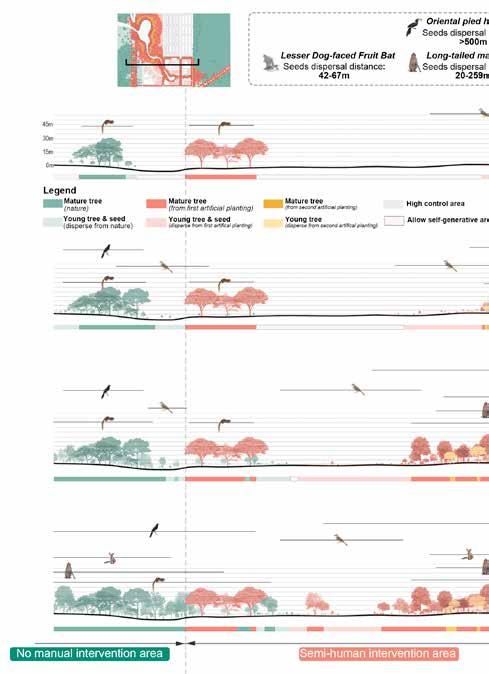
Section location
PHASE 1
PHASE 2
PHASE 3
PHASE 4
Target animal species
332

Preferred Seed Dispersal Range for Animals 333
CURRENT SPATIAL CONDITIONS AND OPPORTUNITIES
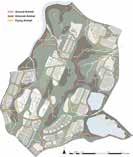
Based on Studio Proposed Layout
*arboreal animals needs more spatial considerations compared to flying animals.

As mentioned in earlier pages, the selected site is situated in one of the major green corridors, and the main target animal types are arboreal and flying. The spatial goal here is to propose another layer of an ecological connection system for both animals and humans on top of the PLAB scale linkages by utilizing topo and natural/artificial structures so that the animals’ free flow can better penetrate into urban spaces.
The above diagram shows the site conditions after our PLAB scale proposal. A spatial study needs to be performed to analyze how to create a more continuous habitat linkage.
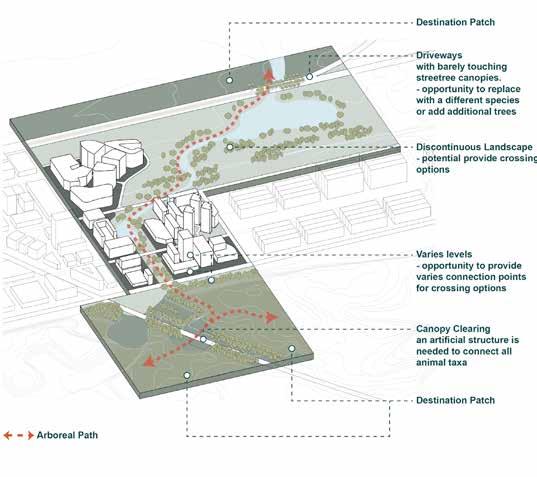 New Least-Cost Path Layout
New Least-Cost Path Layout
334
SPATIAL MASS STUDY
Natural and Manmade Structures
And what can facilitate arboreal movements?
1) trees need to be present and in full contact and roughly at the same level.
2) multiple crossing options need to be provided.
3) well-connected to the adjacent forest to have a viable destination.
So utilizing these planning principles, topographic changes in relation to building heights, and the tree species layout and information proposed in the self-generative process, canopy bridges were formed during the site model study, and continuous linkages for both human and animals at different levels are studied.
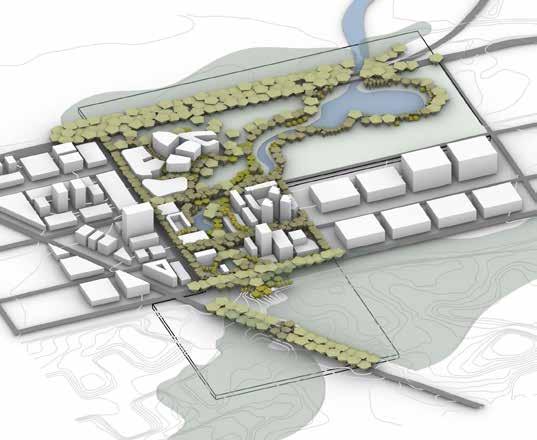
335
SPATIAL - CIRCULATION LAYOUT
The arboreal movements are mostly encouraged near the identified central ecological corridor. Various crossing options are provided both on the ground and on the buildings. Streetscapes allow additional moving options.


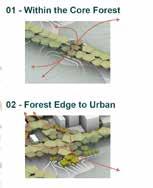
Human circulations are primarily focusing on where the buildings are. Minimum human circulations are proposed near the main ecological corridor to reduce the human footprint. Please refer to the experiential planning in the next section for further details.
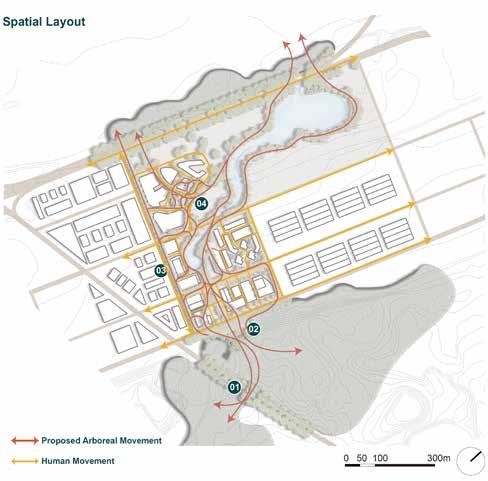
Typologies 01 - Within the Core Forest 02 - Forest Edge to Urban 03 - Between Urban Structures 04 - Urban Edge Back to Nature
Animal and Human Circulation
336
SPATIAL TYPOLOGY SECTIONS
Ecolink on top of the vehicular road to connect the habitats from the same topographic level within the core forest area.
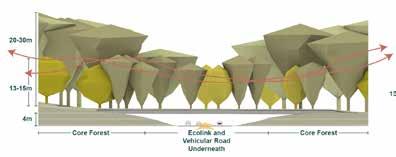
Trees with various heights to plant down the slope will allow a continuous canopy linkage to be formed.
When the gap between buildings is narrow, a hardscape structure linkage can be applied to create extra space at the roof level so that smaller trees can still become part of the canopy bridge.
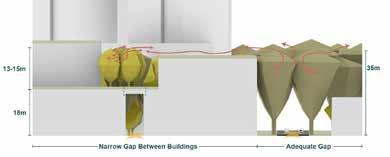
In cases where planting spaces are scarce, some innovations to building structures can be applied to open up the canopy level where arboreal flow may not be disturbed.
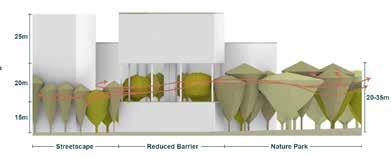
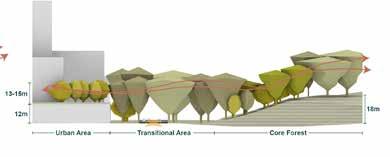 01 - Within the Core Forest
02 - Forest Edge to Urban
03 - Between Urban Structures
04 - Urban Edge Back to Nature
Natural and Manmade Structures
01 - Within the Core Forest
02 - Forest Edge to Urban
03 - Between Urban Structures
04 - Urban Edge Back to Nature
Natural and Manmade Structures
337

338
Site Scale Habitat Map
With zooming into the stie scale, the detailed habitat map of the site indicates the potential animal habitat boundaries in site scale.
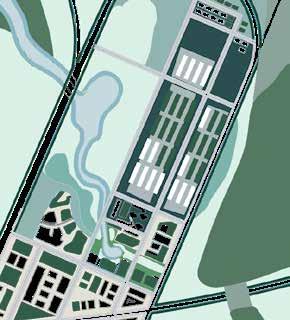
Vegetation and Food Resource
Syzygium zeylanicum Samanea saman
Syzygium grande
Barringtonia racemosa Mangifera indica
Adenanthera pavonina
Ficus microcarpa
Rhopaloblaste ceramica Cinnamomum iners Dillenia suffru�cosa Ficus Fistulosa
Melastoma malabathricum
musa spp
Parkia speciosa
Durio zibethinus
Taking animal habitat boundaries into consideration, we get the result of utility of plant species and planting design. With different vegetations introduced, they can provide food resource to different animal groups.
Ficus vaccinioides &Ficus microcarpa 'Golden'
Peltophorum pterocarpum
Delonix regia
500 m
339
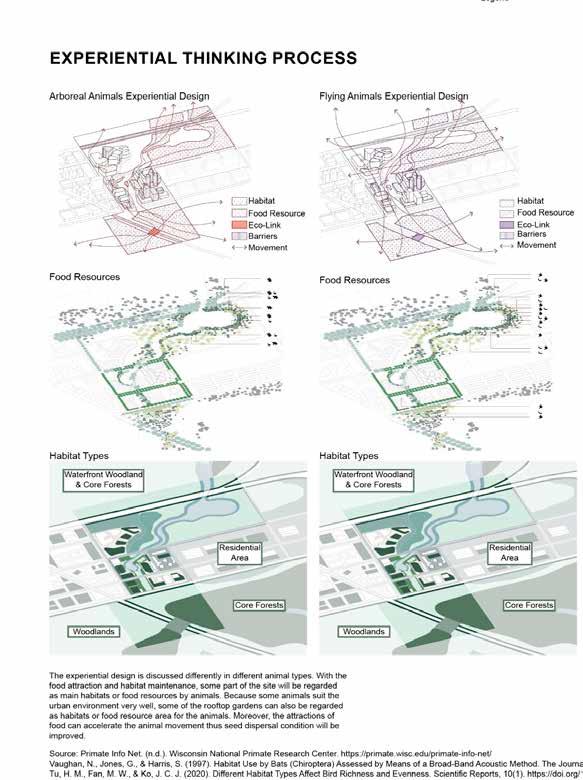
340

341
SITE MASTER PLAN
Finally, with the consideration of human activities, the site plan merged the planning considerations from all three perspectives - self-generative, spatial and experiential. Habitat maintenance and food resources are intended to accelerate the animal movement for improved seed dispersal. The canopy layers, urban parks, streetscapes, and human walking paths in animal habitats aim to reduce the human-animal conflicts, thus getting the outcome of softening the barriers and free flow of animals and humans and transforming PLAB into a critical ecologically self-generative stepping stone within Singapore.
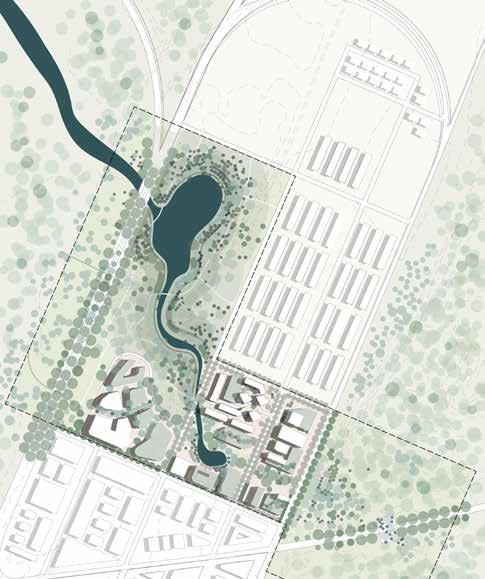
100 m
342 3 3 2 2 6 6 7 7 8 8 8 4 4 5 5 9 9 9 1 1 Secondary Forest Woodlands Waterbody Core Forest Eco-link Green Rooftop Urban Parks Community Commercial Area
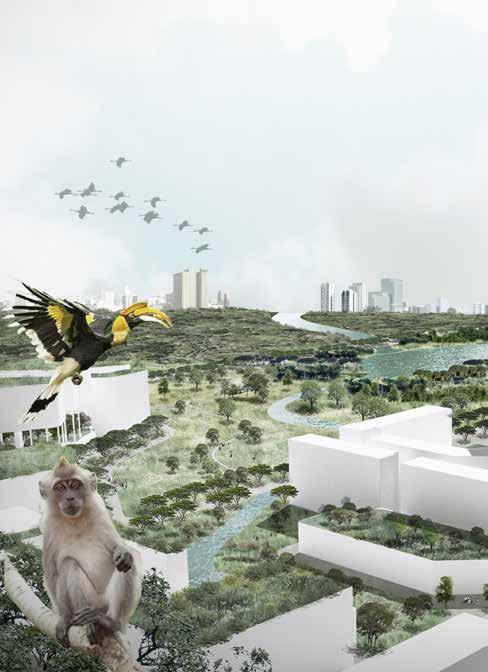
BIRDS’ EYE VIEW 343
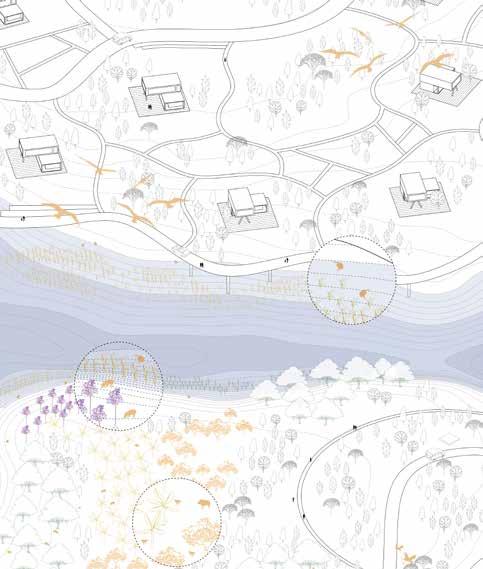
344
STAND BY WILDLIFE
WILDLIFE CONFLICT & PROTECTION
Our project topic is Wildlife Economy. Wildlife Economy is based on the conviction that nature is an economic asset. Some research shows that a sustainable wildlife economy benefits people and nature, using habitats and When communities living closest to wildlife have a clear role and stake in managing. What’s more, when communities living closest to wildlife have a clear role and stake in managing nature, they have a stronger incentive to conserve it.
The background of the project is based on the progressive deterioration of natural resource development in Singapore PLAB. First, the relationship between human and wildlife become tense, and human development increase more cases of human and wildlife conflict. Second, nature and property value have a positive correlation, but current development can't maximize the use of the natural resource. Finally, the boundaries between different landcover are too rigid, the edge should serve as the buffer zone between human and wildlife.
Our vision is to increase the economic value of natural elements and land value to achieve coexistence between humans and wildlife and raise awareness of protecting wildlife.
Based on that, we use the Habitat Suitability Analysis of four target animals and different rating overlays to obtain a hierarchy of sites from natural to human. Based on the rating and topography, we extract the edge typology and give the proposal edge, and then analyze and evaluate the property value in Singapore.
At the same time, we extracted three keywords for the project concept: Diffuse, Appreciate and Negotiate. In terms of diffuse, we provide proper Human-wildlife distance, we use topography change and slope analysis to set up multi-landuse in different slope rating overlays. In terms of appreciation, we use different degrees of openness from private to public, set distances, and different programs to enhance the aesthetic value of the site and the economic value of the site. In terms of negotiation, we use vegetation and installation, to carry out a strategy of attraction and avoidance of wildlife, so that people and wildlife can coexist in their appropriate areas.
For the contribution to the overall studio masterplan, Wildlife Economy plays a role in balancing the natural resources of the site with the intensity of man-made development, allowing for a better deployment of natural resources in the urban rewilding process and increasing the economic development value of the city. At the same time, it stimulates people's empathy and achieves the purpose of community with a shared future for mankind.
345
Ren Junyao, Wang Liangyu, Zhang Yuxi
HABITAT DECREASE AT PLAB
Landform and Habitat Changing Map
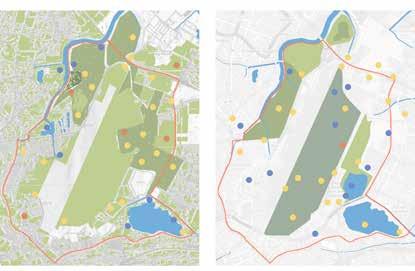
The background of the project is based on declining natural resources and increasing human-wildlife conflicts in Singapore PLAB. From 1945 to 2022 maps, we conclude the conflict between humans and wildlife because of the reduction and distribution problems of natural resources.

1000m
346
Legend
HISTORY OF WILDLIFE IN PLAB

Human-wildlife History
Source: People in Peril, Environments at Risk: The History of Tigers in Singapore

Dr Miles Powell, Nanyang Technological University, Singapore
National Museum of Singapore, Gallery Theatre
9 April 2017
347
TENSIVE RELATIONSHIP
4 Target Animals&Current Habitat

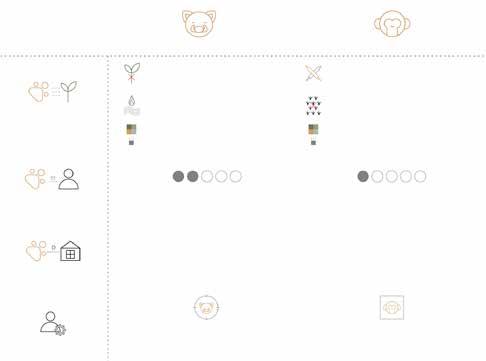
Influence on Environment
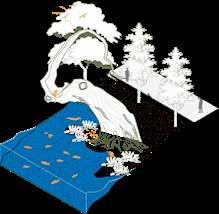
Wild Boars
Decrease in growing of many plants and trees by trampling and rotting.
Increased turbidity of water.
Leads habitats to become less diverse.
Crab-eating Macaque
Conflict is not so severe in Singapore.
Affecting agriculture and livelihoods.
Leads habitats to become less diverse.
Sensitivity to Humanbeing
Wild boars are very dangerous because they are aggressive and also carriers diseases.
Very easy to adapt to artificial environments and not afraid of humans.
Suitable Distance from Human Area Management

Uncomfortable from people: < 550 Meters
Uncomfortable from people: < 300 Meters
Birds
Research shows hunting is the only strategy to significantly reduce crop damage by boars.
Restrict their area of movement by erecting barriers and providing food.
Urbanized Area
Terrestrial Animals
Aquatic Animals
Waterbodies
Through the witness website, there is four target wildlife on our site. They are wild boars, crab-eating macaque, smooth-coated otters, and some birds. We research their influence on the environment, sensitivity to human beings and suitable distance from the human area, and how’s the management.
348
TENSIVE RELATIONSHIP
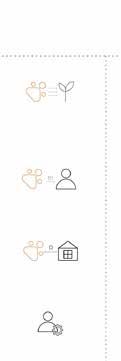
4 Target Animals&Current Habitat
Smooth-coated Otter Birds
Maintaining the balance of nearshore ecosystems.
Influence on Environment
Sensitivity to Humanbeing
Suitable Distance from Human Area Management
Otters can be frightened by humans in close proximity, flashing lights and human activity noise can also anger or frighten otters.
Uncomfortable from people: < 50 Meters
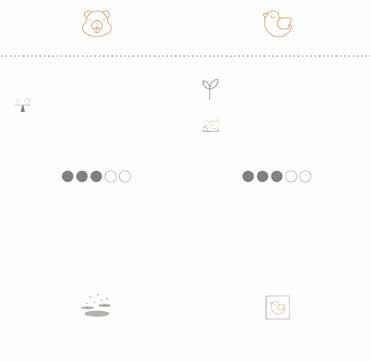
Helps pollinate plants and spread seeds.
Provide insect and rodent control.
Birds can be frightened by humans, but they will look for food in the range of human.
Shorebirds or songbirds: >100 Meters
Hawks and eagles: >400 Meters
Urbanized Area
Nest
Birds
Secondary Forest Insect
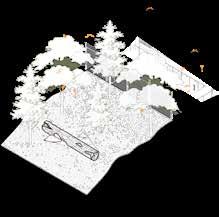
Small Mammal
Threat includes settlements, agriculture,water pollution.
Restrict their area of movement by erecting barriers and providing nest.


349
ISSUE STATEMENT
Human Wildlife Conflict
GIS Analysis
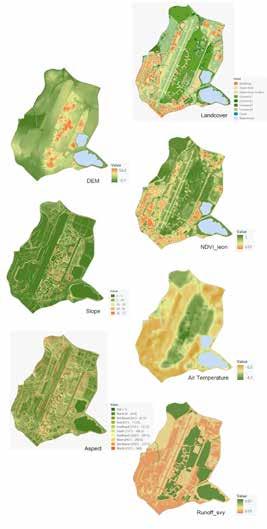

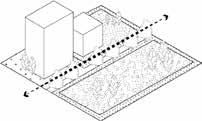
Relationship between human and wildlife become tense, human development increase more cases of human and wildlife conflict.
Negotiate: Provide proper Human-wildlife distance.
The first issue statement is human-wildlife conflict. We want to negotiate the proper human-wildlife distance, so we use habitat suitability analysis to get the rating map. The map shows the rating from nature to human, which help us to rearrange the site landuse and define the buffer distance roughly.
350
ISSUE STATEMENT
Human Wildlife Conflict
Habitat Suitability Analysis
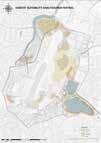
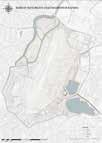
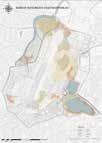
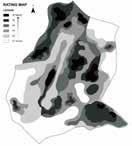
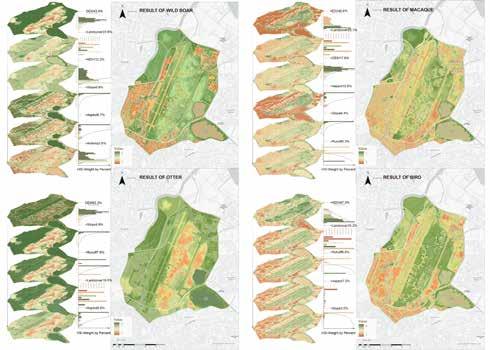
Rating Map Process
The suitability analysis came from the environmental indexes, including DEM, SLOPE, ASPECT, LANDCOVER, NDVI, AIR TEMPERATURE, and WATER RUNOFF. Then, based on the index and weights of different target animals in the paper, the result demonstrates the suitable habitat in PLAB.
We extract the areas with high scores as core protection areas, and the extraction of areas with medium scores, as the potential areas, and overlayed areas should be protected.
351
Nature and property value have a positive correlation, but current development can’t maximize the use of the natural resource.
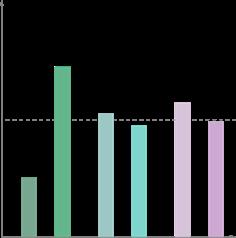

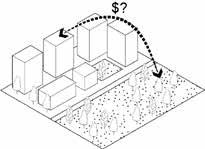

Appreciate: Provide comfortable and and aesthetic sense to wild habitats for increasing land value with residents’ appreciation.
The second issue is about nature and property value have a positive correlation, but current development can't maximize the use of the natural resource.
ISSUE STATEMENT Property Value
Closeness of Nature & Life Satisfaction Closeness of Nature & Excercise Willing Closeness of Nature Life Satisfaction Willing to Excercise Team +0.5 -0.5 0 0-500m Spontaneous 500-1000m Spontaneous 1000-1500m Spontaneous 0-500m Managed 500-1000m Managed 1000-1500m Managed Individual Walk Regression Coffecient 352
We investigated the site standards and green space ratios of properties of different values. We are aimed to provide a comfortable and aesthetic sense to wild habitats for increasing land value with residents’ appreciation.


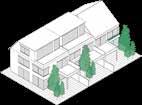
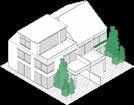
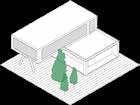
Bungalow Site Area 400m2 10m Width 50% High Low GFA: 7.24% 30 units 4002 per unit 1.2ha in total 80 units 2002 per unit 1.6ha in total 210 units 2002 per unit 4.2ha in total 14 12-story units 14 24-story units 4000m2 per unit 11.2ha in total 35 12-story units 35 24-story units 1000m2 per unit 70ha in total GFA:
GFA:
GSR: 40% GSR: 40% 45% 50% 50% 50% 200m2 10m Width 240m2 22m Width 4000m2 (Including Facility) 1000m2 Site Coverage Open Space Amount Legend Semi-ditached House Terrace Houses Condo HDB Institutional Commercial Sports 353
ISSUE STATEMENT Property Value
7.24%
7.24%
ISSUE STATEMENT
Rigid
Unutilized Area-Waterfront (with height difference)
Unutilized Area-Waterfront (with height difference)
Forest-Road (without height difference)
Runway-Forest (without height difference)
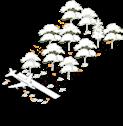
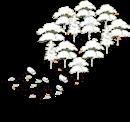


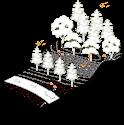



Sand dune-Waterfront (with height difference)

Industry - Urban Green (without height difference)
Forest-Unutilized Area (with height difference)
Runway-Forest (With height difference)
The third issue statement is the Rigid Edge. Currently, the boundaries between different landcover are rigid, but we propose the edge area can serve as the buffer zone between humans and wildlife to achieve their co-existence. The keyword here would be 'Diffuse', which means creating diverse buffer zones and softening them and we classified the edges into eight typical types by land use and height change.
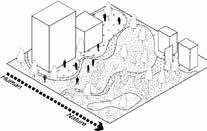 Edge
Edge
Boundaries between different landcover are too rigid, the edge should serve as the buffer zone between human and wildlife.
1 3 2 4 5 6 7 8
Diffuse: Creating diverse buffer zones and softening their edge for nature and human usage.
354
Original Rigid Edge
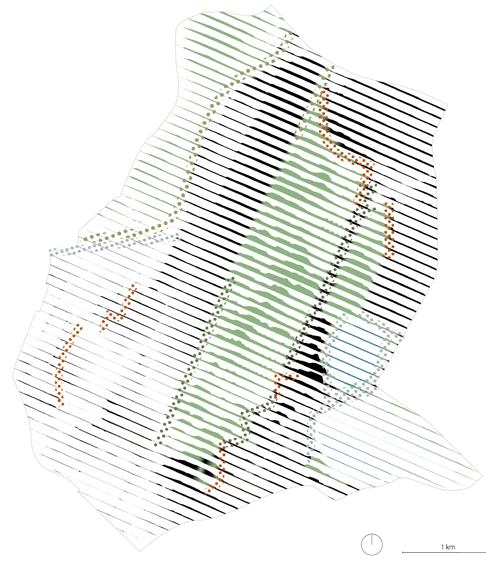

1 5 2 6 3 7 4 8 355
The picture shows our analysis process. We made a series of sections of Paya Lebar and overlayed it with current land use, which illustrates the areas with more conflict.
ISSUE STATEMENT Rigid Edge
CONCEPT
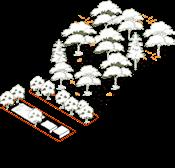

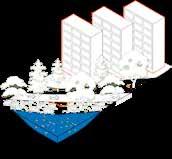
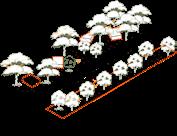
Proposed Edges



We propose different treatments to existing edges, the red-line marked areas are where the changes happen. Based on different land use and height differences, we arranged proper programs on the sites.
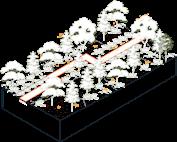
1 3 2 4 5 6 7 8 356
Overlayed the analysis result and our proposal together to get our group's overall master plan for Paya Lebar.
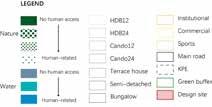
The map shows 4 degrees of accessibility for humans and wildlife, the solid-green areas don't allow human access while The areas with the sparsest green dots are most human-related. Different types of properties are also located on our site by various arrangements.
We chose two sites with different natural resources to do a detailed design. The site in the northwest includes a waterbody, and another site in the southeast includes diverse land use from nature to the urban area, also, the properties we located in these two sites are quite different.

CONCEPT Masterplan and Site Selection 357
STRATEGY1:TOPO&LANDUSE Topo
The first strategy is modifying the topography to provide diverse land uses in our sites. By analyzing the slope in Grasshopper, the results show the extreme steep parts and we proposed to reduce those rigid edges. After topo modification, we rearrange the human-dominated activities in gentle terrain and use the relatively steep spaces as the buffer zone, separating from wildlife protection area.

Site1 Original Rating Map Nature Artifical Institutional HDB12 HDB24 Bungalow Water Slope 25° 0° Original Slope Map Modified Slope Map Original Rating Map Original Slope Map Modified Slope Map Site2 Slope 25° 0° Slope 25° 0° Slope 25° 0° Artifical
Analysis and Modification 358
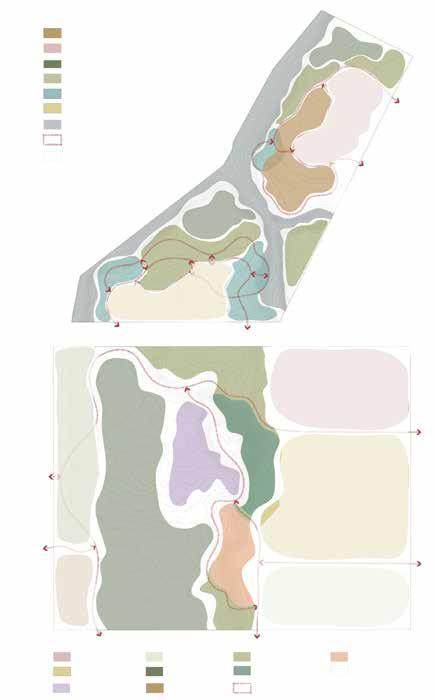
STRATEGY 1: TOPO&LANDUSE Multi-Landuse Arrangement Bungalow Private Entertainment Wildlife Habitat Forest Waterfront Public Space Water Circulation 1m Contour Commercial Urban Park Learning Forest Picking Garden 1m Contour Planted Forest HDB Wildlife habitat Institution Terrace Circulation Site1 Site2 359
STRATEGY2: PROGRAM& OWNERSHIP
The second strategy is controlling the closeness between wildlife and human to decide on different programs and ownership. In riverside edges, we proposed high-end value housing along the riverside, using distance, slope, and installation to maintain the proper distance between humans and wildlife.
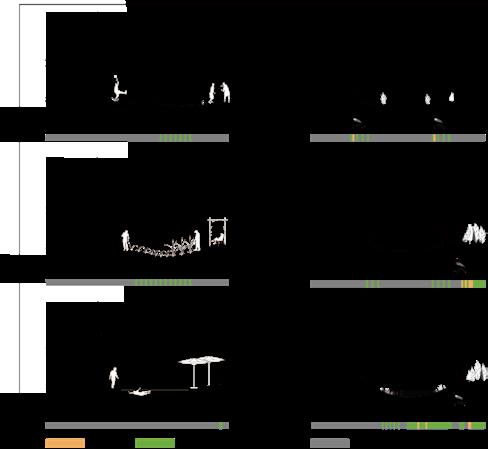
Slope Decides program and Species Slope<10° Exclusive Space <10m
Courtyard
Facilities
Private Space 10-30m 10<Slope<20° Slope>20° Wildlife Vegetation Human Activity
Sports, BBQ Productive Garden
Living
Kite Flying, Picnic Waterfront Terrace
Site 1 Distance&Installation 360
Distance Decides Ownership
Public Space to Wildlife Habitat >30m

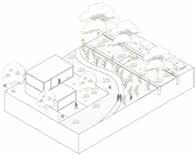
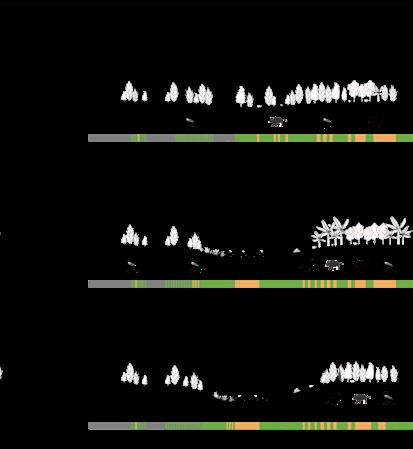
Wildlife Protection Station
High-end Landed
Electronic Sound Repellent
Spined Plants
Earth-covered Structure
Feeding Spots
Viewing Platform
Food Resource
Live Fence
Walking Path
Productive Garden
Attract
& avoid installations in landed housing Attract & avoid installations in riverside
PROGRAM&OWNERSHIP Site 1 Distance&Installation 361
STRATEGY2:

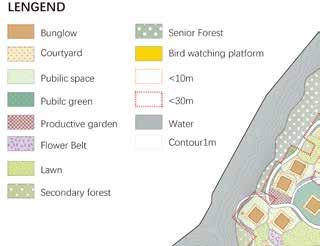
A B A'
Site 1 Program Plan Site 1 Program Map
2: PROGRAM& OWNERSHIP 362
B'
STRATEGY
By analyzing the closeness of natural elements and the slope of the terrain of the high-ended house, we decided on the arrangement of programs and the species of plants. Combining techniques and installation to demonstrate how to control the degree of attractiveness and avoidance of targeted wildlife. After our design, the riversides become more diverse than before, the program plan and sections show the different spatial experiences in river edges.
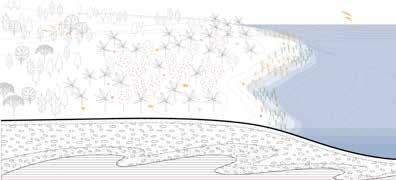
 Section A-A’
Section A-A’
Site 1 Section STRATEGY2: PROGRAM&OWNERSHIP 363
Section B-B’
Closeness to Nature Decides Program and Species
Extreme Situation
<5m
Tree Pool
Window View
Public Space
<50m
Streetscape
Residential Green
Attract & avoid installations in high density residential area
Roof Garden
Facade Garden
Eclogical Brick
Drainage
In site 2, most edges will concentrate on forest-artificial areas. Following the same design idea, we analyzed the distance and potential intervention in site2.Because public housings have a much more population compared with landed property, they have a different standard of deciding their program and ownership.

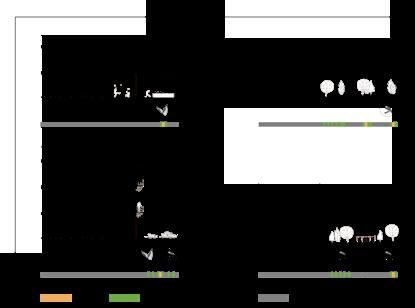
364
Site 2 Distance&Installation
STRATEGY&ANALYSIS 2
Semi-nature Space 50m-150m
Agroforestry
Learning Forest
Distance Decides Ownership
Wildlife Protection Area >150m
Low Density Insitution
Viewing Platform
Attract & avoid installations symbiosis in semi-natural area
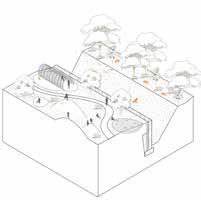
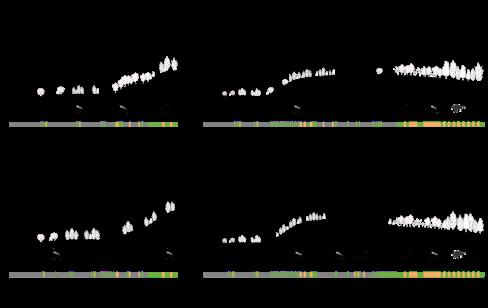
Wildlife Viewing
Food Resource
Biodiverse Playground
Haha Wall
We used some typical diagrams to show the various transition of natural elements.The Human intensity decrease as it gets closer to nature, and site 2 requires more public space and a larger buffer zone compared with site1
STRATEGY2: PROGRAM&OWNERSHIP Site 2 Distance&Installation 365
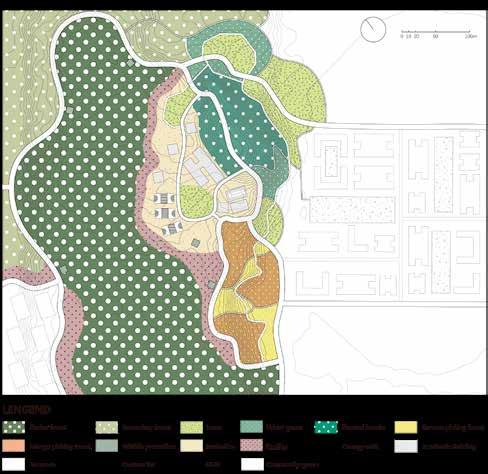
Site 2 Program Plan d c c' d' Site 1 Program Map STRATEGY 2: PROGRAM& OWNERSHIP 366
We propose diverse changes in properties and natural elements, for people can harvest fruits and explore learning forests on weekends or observe wildlife through their windows on weekdays.

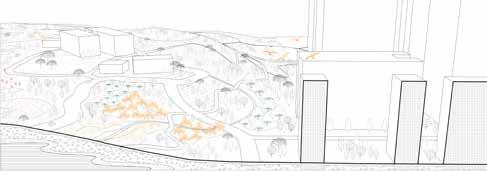 Section C-C’’
Section C-C’’
Site 1 Section STRATEGY2: PROGRAM&OWNERSHIP 367
Section D-D’’
STRATEGY 3: FOOD&HABITAT
Site1 Wildlife Food&Circulation
Wild Boars
Crab-eating Macaque
Site1 for 4 target animal
Strategy 3 is about providing sufficient food and habitat for wildlife, by analyzing the food resources, we get the favorable species and unfavorable species of our 4 target animals.
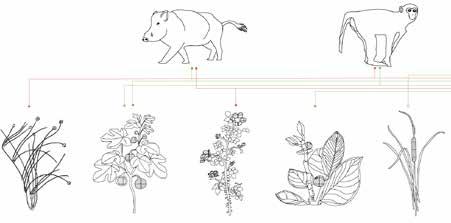
368
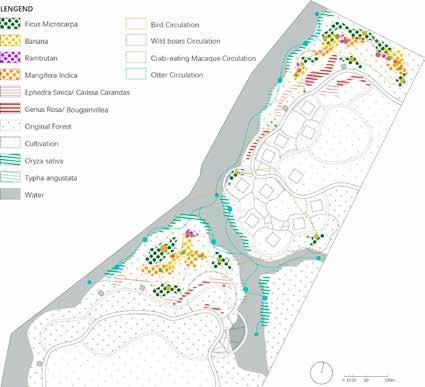 Ephedra Sinica
Typha angustata Rambutan Genus Rosa Ficus Microcarpa
Ephedra Sinica
Typha angustata Rambutan Genus Rosa Ficus Microcarpa
STRATEGY2: FOOD&HABITAT


Site2 Wildlife Food&Circulation
Birds Smooth-coated Otter
Banana Bougainvillea Mangifera Indica Oryza Sativa Oryza Sativa
Site2 for 3 target animal
2
plantation map showing where we set those feeding vegetation and how to manage wildlife’s circulations.
369
Site1: Riverside Edge
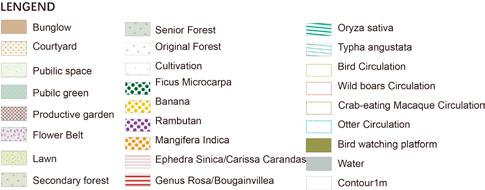


370
FINAL DESIGN Detail Masterplan



FINAL
Detail Masterplan
DESIGN
371
Site2: Forest Edge
ACHIEVEMENT
Riverside Edge
By constructing high-value houses on the water edge, the Sergon River serves as a backyard for landed properties, both enhancing the land value and introducing a more inclusive and diverse waterfront along the Serangon River. By cultivating aquatic crops that can be used as food resources to control the distance between the range of wildlife and human, the two groups can avoid direct conflict.
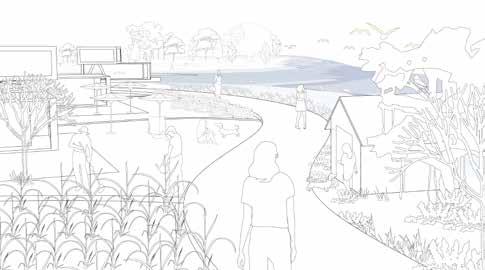

View
View
Human’s
Otter’s
372
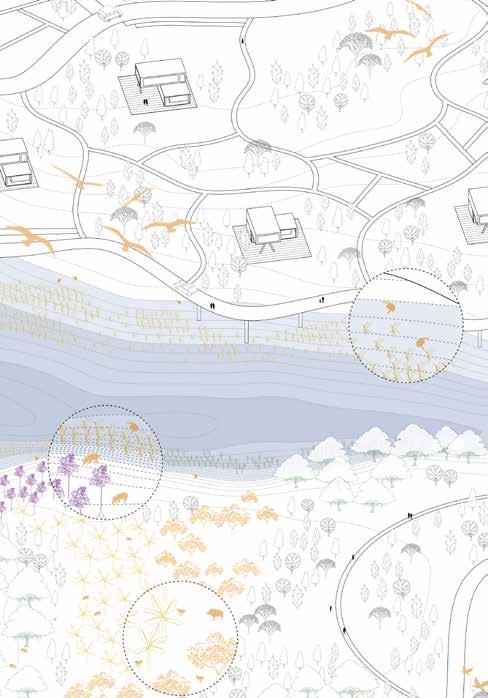
ACHIEVEMENT Riverside Edge Aerial View 373
ACHIEVEMENT
Forest Edge
Provide sufficient food resources in the core protection area, and set up human-intervented forests as a buffer zone between the natural and high-density housing, so that residents can see the wildlife through their windows while maintaining an appropriate distance.
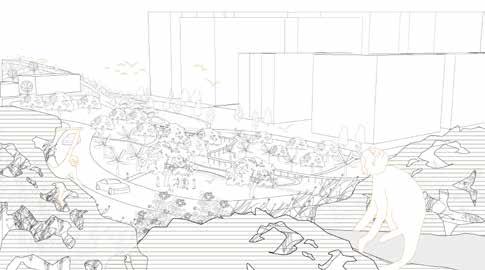
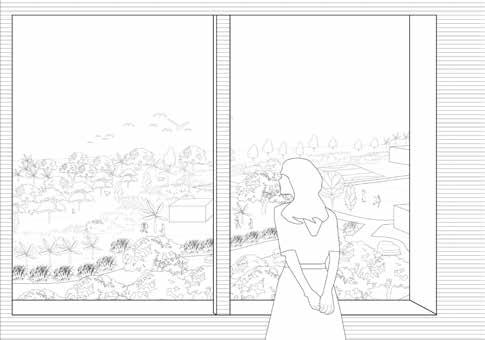
Macaque’s View Human’s View
374
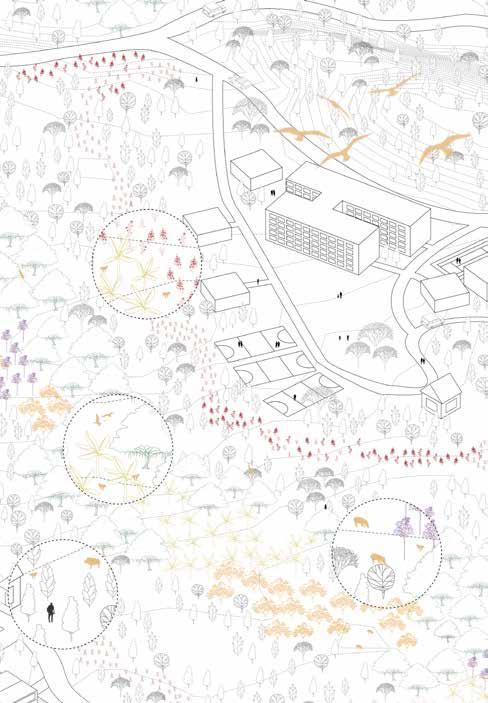
ACHIEVEMENT Forest Edge Aerial View 375
Syzygium myrtifolium Aphanamixis polystachya
Graywater Acacia
auriculiformis
orchards
Inorganic

Rainwater
Fagraeafragrans
Mimosapudica
Healthy
Alocasia macrorrhiza
Falcataria moluccana
Clidemia hirta Spathodea campanulata Muntingia calabura Tabebuia rosea
Falcataria moluccana Hevea brasiliensis Mikania micrantha Elaeis guineensis Ficus species
Soil
Water
Albizia falcataria
Penniseum
Acaciaauriculiformis
Tetraceraindica
Dicranopterislinearis
Terminaliacatappa
Melastoma malabathricum
Leucaena leucocephala
Dillenia suffruticosa Casuarina equisetifolia Spathodea
Acacia auriculiformis
Manihot esculenta Canal water
Leucaena leucocephala
Cinnamomum iners Soft clay Cheilocostus speciosus
Caryota mitis
Ardisia sp
Scrubland Grassland
Terminalia catappa
Secondary forest AbandonedYoungsecondaryforest landforest
376
CARBON BANK
NATURE AS A CARBON BANK
RECYCLE NATURE ELEMENTS AS NATURE CAPITAL
Nowadays, carbon neutrality is a hot topic around the world. Singapore is known to have the 8th highest per capita carbon emissions in the world. PLAB is surrounded by the most densely populated areas in Singapore and has lost most of its natural areas and resources in the past airport construction, so PLAB is an ideal area to achieve carbon sequestration. Through our assessment, the CO2 release from the future 160,000 residential population far exceeds the CO2 absorption from PLAB's existing natural resources. With the goal of carbon neutrality by 2050, PLAB will eventually form a huge urban carbon bank to mitigate the high per capita carbon emissions faced by Singapore through the recycling of water, soil, vegetation and other natural resources within the site over 30 years.
One of our strategies is to reduce carbon footprint. Water, soil and forest resource are intervened to reduce carbon footprint in that soil with forest store carbon in their original state. Water resources are collected, recycled and discharged in each catchment. After calculation, the waterway in each catchment can bear the biggest runoff of the catchment. The movement of forest resources are mainly transfer timer from deforested areas to resource recycling centers for production and recycling. The transfer of soil resource mainly lies in the construction of new habitats as urban forests and wetlands, building aquatic habitats near the river, and others put into the use of landscape. In general, the utilization rate of soil in the PLAB has reached 71%.
Another strategy is to maximum carbon sequestration. Firstly, pioneer species and framework species are planted to restore the existing forest. Secondly, primary forest species are used to improve existing forest and accelerate their succession. Finally, back mangrove and freshwater swamp are introduced to restore the wetland ecosystem as the main force of carbon sequestration.
PLAB witnessed a complete process of forest succession. After creating suitable soil conditions, the first pioneer trees were planted to form one secondary forest quickly. Then secondary forests gradually introduces primary forest species into it. During this time, woodcutter constantly trimming the canopy of pioneer trees to provide growth space and sunshine for primary forest species, and also the cut branches and leaves can be used as biomass to improve soil fertility, which accelerate the evolution of the original forest towards a more mature primary forest to maximize the carbon sequestration.
The last strategy is to mitigate urban heat. Through the construction of green roofs, vertical greening and urban green space, indoor and surface temperature can be reduced. Wetlands and urban rivers can also absorb heat to create a good microclimate. These designs reduce the temperature of PLAB and reduce energy consumption at the same time. The purpose of mitigate urban heat is to build low-carbon community from an energy-consumption community.
377
Cheng Siqi, Zhao Mingyu, Jiang Ruomin
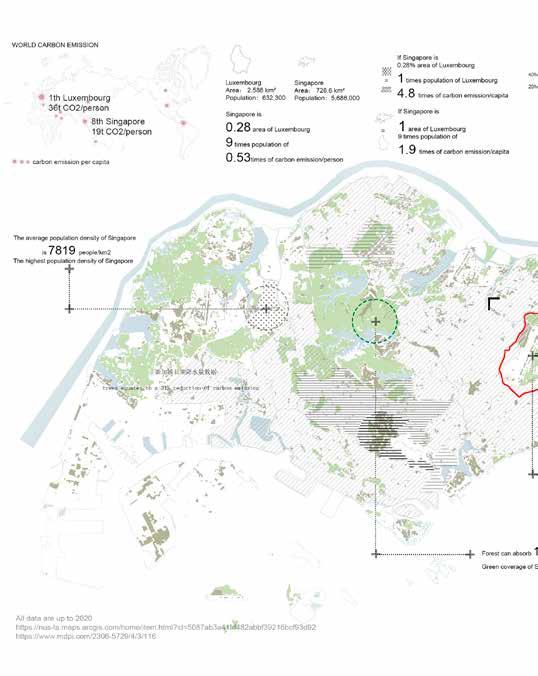
STUDY OF SINGAPORE 378
PLAB has lost many natural resources in the past 70 years, so we chose PLAB as the site for ecological restoration design .

379
EVALUATION OF NATURE RESOURCE
LEGEND
Inner lake River Secondary forest Secondary forest and scrubland Forest & scrubland Scrubland Park Open space Paved surface NATURAL RESOURCE CARBON EMISSION Total flux 1856 1327 ha ha ha ha ha ha ha ha ha ha DUS Secondary forest Secondary forest&scrubland Forest & scrubland Scrubland Park Roadside greeny +18544 106 136 61 18 50 35 406 148 15052 28288 11835 1818 5050 3535 trees t t t trees trees trees trees trees -11788 +60800 160,000 380
FRAMEWORK
Strategy deduced from the venue problem: Carbon Bank formed by three Nature Capital
CAPITAL
STRATEGY DESIGN TARGET ISSUES
Forest degradation
WATERCAPITALL CARBON BANK
Maximize carbon sequestration
Improving existing forest Restore forest Recover water system
Vegetation branch
Wetland disappear
Reduce urban heat
Plant more trees Increase water body
Water branch
Carbon footprint of construction
Minimize carbon footprint
Soil transport
Water transport
Tree transport
Carbon emission by dwellers
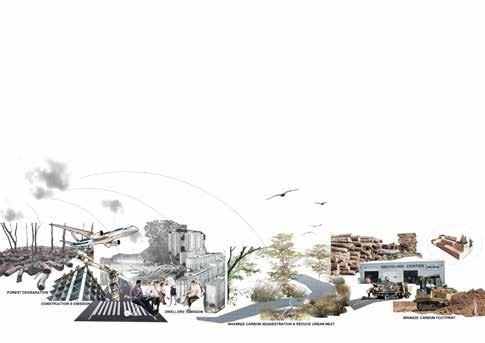
LIOS LATIPAC
Soil branch
GREEN
381
PROCESS OF MASTER PLAN
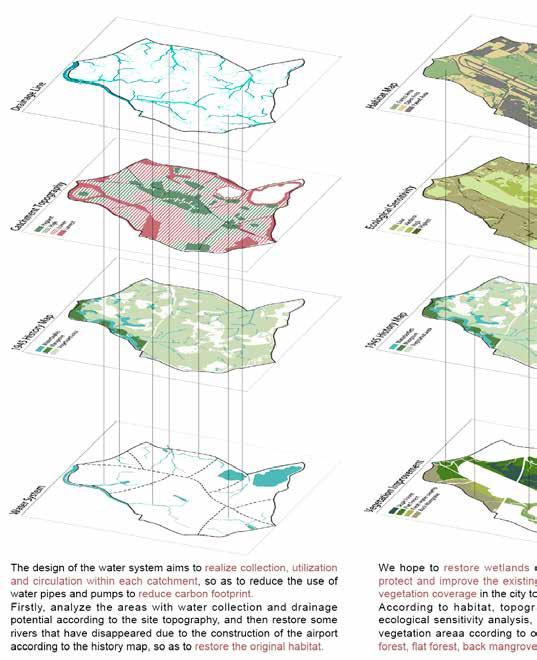
Water system Vegetation improvement 382
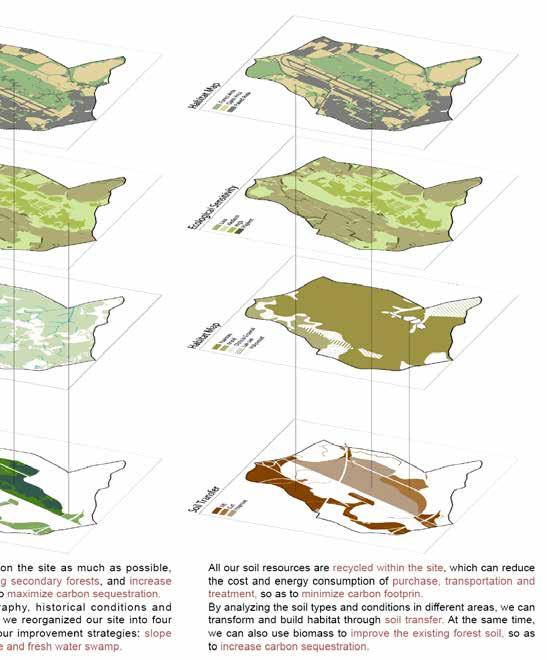
improvement Soil transfer 383
PHASING
The four construction stages of PLAB from current situation to renovation completion

PHASE 1
PHASE 2
Fertility Restoration Vegetation Improvement
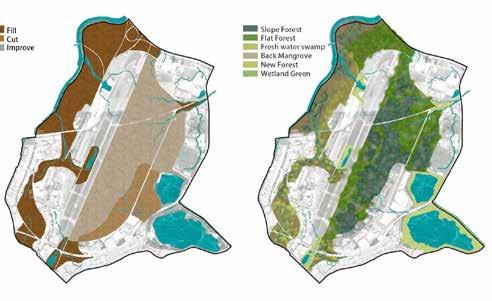
PLAB lost a large number of natural habitats during airport construction, and most of the surface is hard ground, so we need to restore the soil conditions according to the planning before restoring the vegetation.
We mainly carried out three kinds of soil movement: using sand and soil as the composition of swamp soil; Use forest soil for new forest construction ; The soil excavated from the river channel will be used for the construction of natural buffer near the riverway.
According to the current situation and history of different plots, we have carried out some vegetation restoration and upgrading. Firstly, we added some tree species of primary forest according to the terrain of the original secondary forest as an improvement of species diversity. Secondly, pioneer trees will be planted where new forests will be built. Third, we will restore the wetland in the original mangrove forest in the northeast, mainly planting back mangrove along the river and building fresh water swamp in other places.
384
PHASE 3
Urban Greenery
In order to increase carbon absorption and reduce urban heat island effect, we have also designed and improved greening in the city. First, we built green roofs and vertical greening to cool the buildings. Second, we set up green spaces such as urban parks, community greening and urban agriculture to increase the planting area of the city. Third, we planted street trees on both sides of all roads.
At the same time, some forest parts have grown into primary forests and the rest are also growing gradually.
PHASE 4
Natural Succession
About 40 years later, most of the forests on the site have been replaced by primary forests Wetlands and swamps grow mature and can be act as the main force of carbon absorption. Urban heat island is effectively reduced through urban greening. The new water system can efficiently solve the problems of drainage, circulation, irrigation and flood. The water, soil and tree resources on the site are continuously recycled in people's life, greatly reducing the daily carbon footprint. At this time, PLAB can achieve the goal of carbon neutralization.
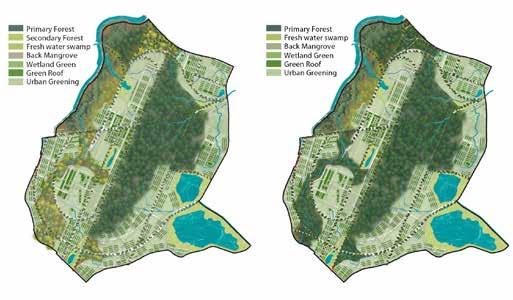
385
CAPITAL
Recycling Center
Main Roads Buildings
Site Bounday Highway
Slope Forest
Flat Forest Roside Tree
Urban greenery
Back Mangrove
Fresh Water Wetland
Wetland Greenery
Waterbody

Waterway
Soil Capital
GREEN
LATIPAC CARBON 1 2 3 4 5 6 6 6 7 7 10
Green Capital Water Capital MASTERPLAN 386
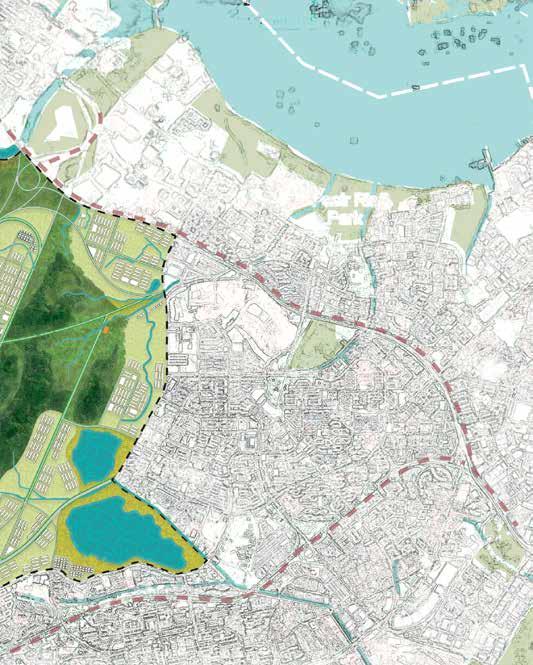
LIOS C
BANK 1 4 7 2 5 8 3 6 9 10 11 5 7 8 9 10 11 Slope Forest Back Mangrove New Forest Corridor Flat Forest Community Wetland Park Bedok Reservoir Fresh Water Swamp Purification Wetland Tampines Quarry Recycling Center Water Square 1 km 2 km 387
WATERCAPITALL
15.6 HECTARE BACK MANGROVE HABITAT PROPOSED
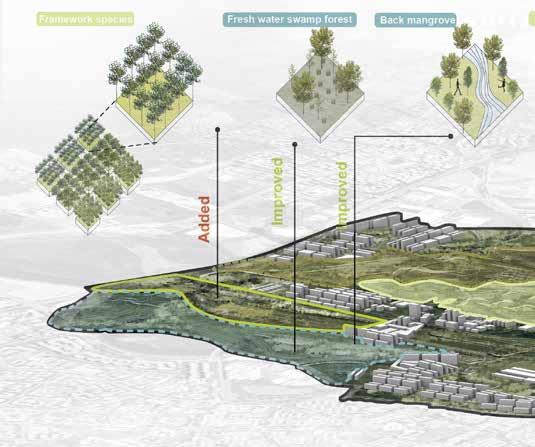
98.6 HECTARE YOUNG FOREST PROPOSED
87750 TON CARBON DIOXIDE ABSORBED
STRATEGY 1 :MAXIMIZE CARBON CONSEQUESTRATION
Tree branch
Wetland
Improve
Water branch 388
Carbon catcher
Restore
existing forest
Framework species forest
Pioneer species forest
Compound forest
Provide nutrients
30 years later Support
Mature forest system
Purify water bodies
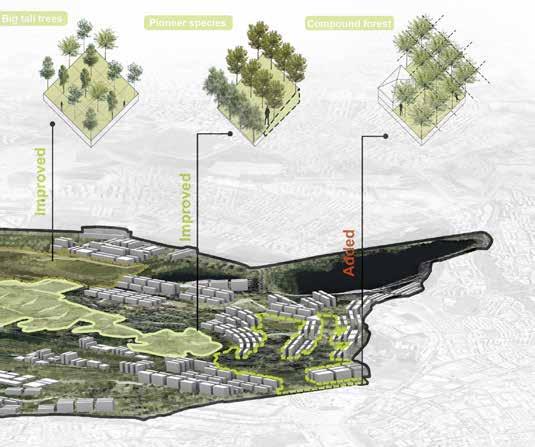
Back mangrove habitat
Riverscape
10 years later
Carbon bank
Wetland habitat
Restore wetland 389
FOREST SUCCESSION







Scrubland Secondary forest


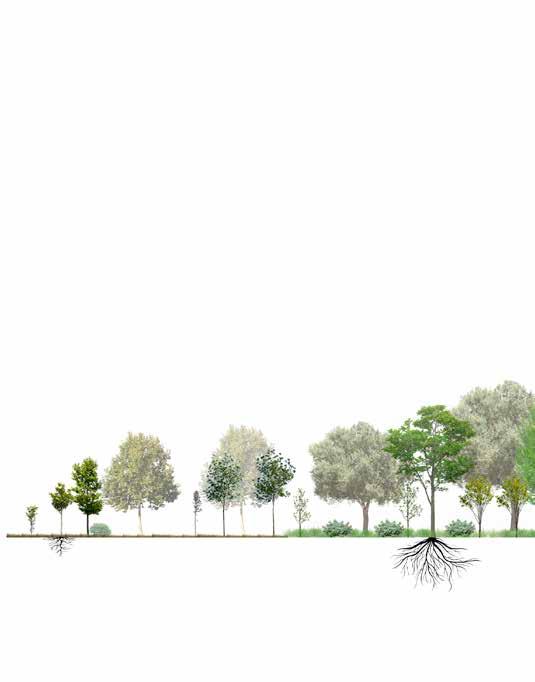 Macaranga hypoleuca
Melastoma malabathricum
Pulcherrimum
Ferrugineum
Timonius wallichianus
Clerodendrum laevifolium
Prunus polystachyus
Syzygium lineatum Ficus fistulosa
seed dispersal
Tree transplanting
Biomass
Leguminous plants
Macaranga hypoleuca
Melastoma malabathricum
Pulcherrimum
Ferrugineum
Timonius wallichianus
Clerodendrum laevifolium
Prunus polystachyus
Syzygium lineatum Ficus fistulosa
seed dispersal
Tree transplanting
Biomass
Leguminous plants
More sunshine 390
Leaves







transplanting Biomass forest
Shorea leprosula Campnosperma auriculata Dipterocarpus Koompassia Canarium Parishia
sunshine
Prune branches
391
Twig
Primary forest
117.5 HECTARE URBAN FOREST

PROPOSED
28.6 HECTARE WATER SYSTEM
PROPOSED
2.5 DEGREE TEMPERATUREA REDUCTION
STRATEGY 2 :REDUCE URBAN HEAT
Energy consumption community
Green roof
392
Urban river
river way
Vertical greening
Cool air by tree transpiration
SAVE ENERGY
Urban green space (forest park/forest street)
Absorb heat by water evaporation
Low carbon community
Wetland
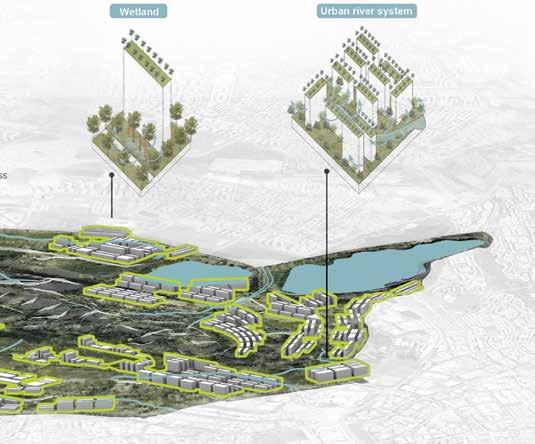
393
STRATEGY 2: REDUCE URBAN HEAT
A cross-section model of a low-carbon community
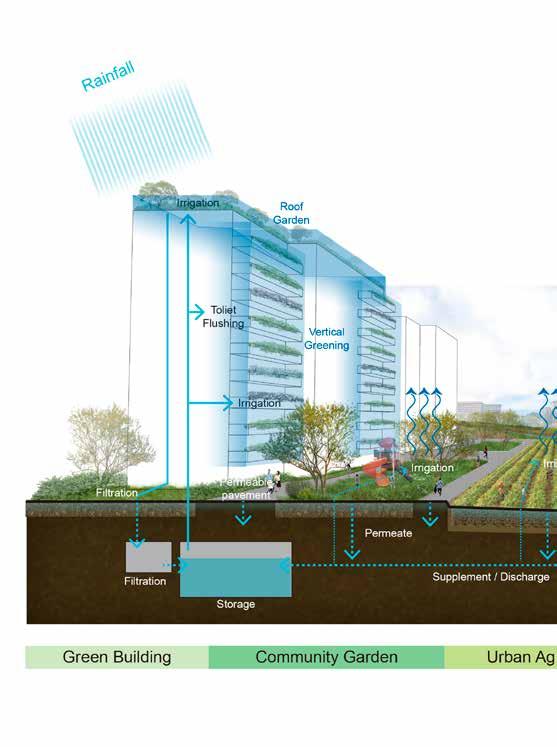
Lower the building's indoor temperature
- Transpiration of vegetation
- Cooling surface ground
394
Evaporation of water cooling surrounding area Increase the shade
Green coverage of PLAB is increased to
16.12%
higher than before. So surface temperature can be reduced by about
83.88% 1.8℃
Each building has green roof and vertical greening, which can reduce the indoor temperature by about
4℃
and save AC energy consumption by more than
25% 129.39ha
The water surface area of the site is larger than before, providing comfortable microclimate for the surrounding area.
17ha
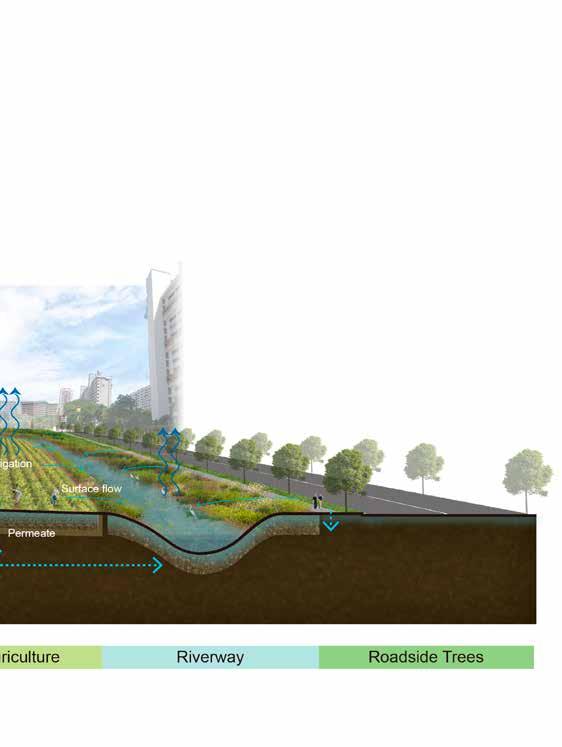
vegetation
395

STRATEGY 3: REDUCE URBAN HEAT 396
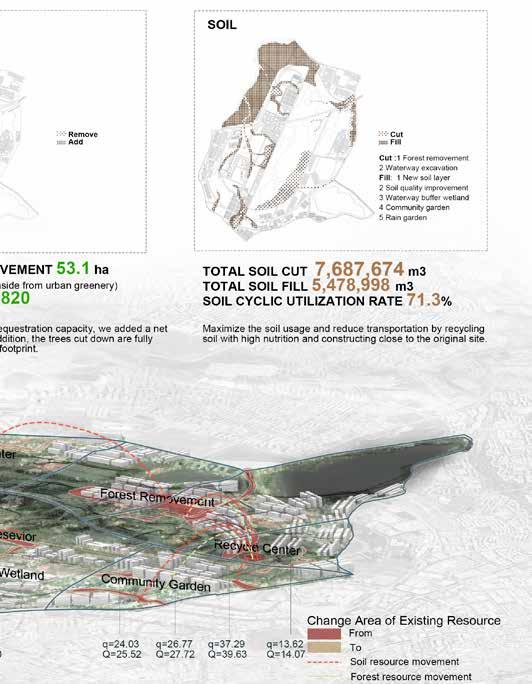
397

STRATEGY 3: REDUCE URBAN HEAT 398
We have set up RECYCLING CENTERS in areas of the site where resources are exchanged frequently. Soil that around 275,000 14-feet freight trucks can carry, and 13% of the forest resources are put into the recycling centre, which then goes to the plant for processing.
They are then involved in the lives of the residents. Residents learn about resource use through craft schools, exhibition halls and experience recycling in the form of urban green spaces and street furniture.
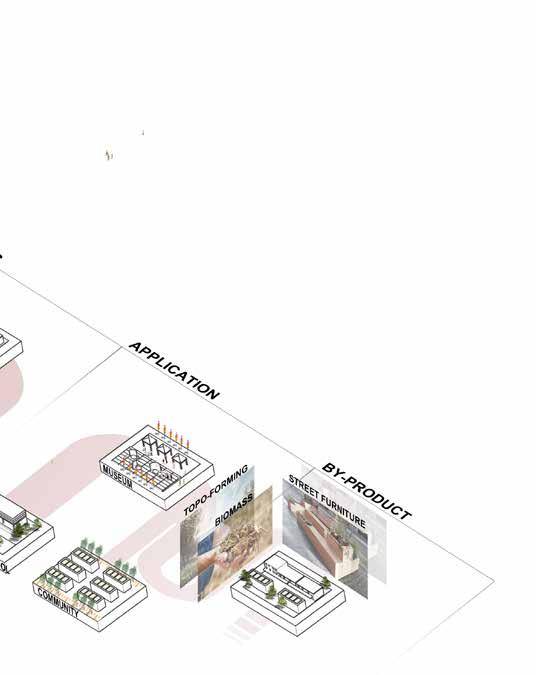
399
DETAILED DESIGN: EXAMPLE OF CARBON BANK
LEGEND
Application of strategies in specific site
For strategy 1, we have retained and improved the original forests, and built new urban forests, green spaces, fruit forests and urban agriculture to maximize carbon sequence. For strategy 2, we set up roof garden, vertical greening, river and surrounding community green space, agriculture field and roadside tree to reduce the heat island effect. At the same time, wetland is also a place for residents' leisure and entertainment activities. For strategy 3, we set up recycling center, factory, lab, museum and handcraft school near the road and forest to recycle the resources in the site.
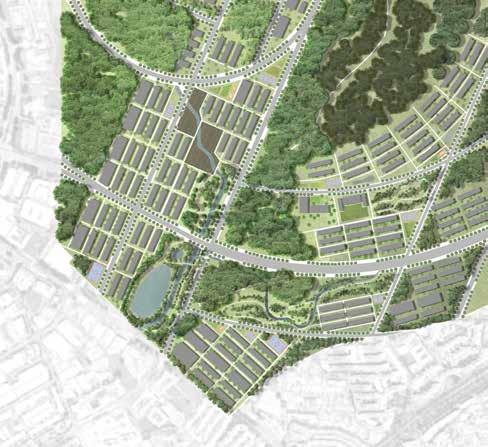
0 50m N 100m 200m 400m 1 2 3 5 4 7 9 8 6
1 Farmland
2 Wetland
3 Water reservoir
4 Recreational park
5 River buffer
6 Recycling centre
7 Primary forest
8 Pioneer forest
9 Communiy park
400
Site selection
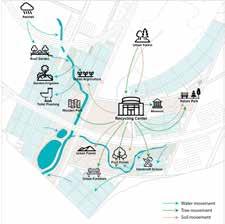
In the whole carbon bank, this area is the most frequent and complete node for resource conversion, so we choose it as a example for detailed design.
Type of utilization
The gray area is the original resources of the site, mainly including the original soil. The brown area is the original resource retained, mainly forest. Green area is the location for resource recycling, including new forest, community green space, wetland and urban agriculture. Red is the newly added resources, mainly street trees
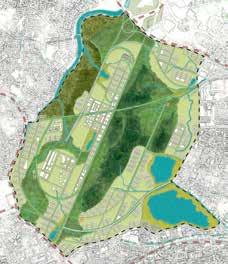

Resource distribution
Firstly, the soil excavated from the original site is transferred to different places for habitat construction after being treated by the recycling center. Water resources are collected from rainfall and enter the river through roof garden and surface flow. They are used by downstream communities and agriculture and fruit forest around the river as toilet flushing and irrigation. Finally, they enter wetland for filtration and storage, and then recycled in dry season. The trunk, leaves and other resources in the forest are processed by the recycling center into urban furniture, wooden pavement and handcraft, which are used by people.
401
WETLAND: MAIN FORCE OF CARBON SEQUESTRATION
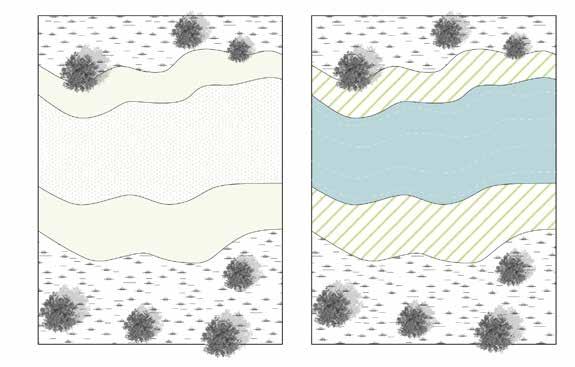
Recycle natural resource Soil transfer Dig Plant phytoremediation Rainwater collection INPUT OUTPUT Fill Soil transfer -5.00 ±0.00 Improve soil quality STAGE I STAGE II ±0.00 = -0.104 +2.504 ton km2 yr-1 ton km2 yr-1 Green buffer Rainwater collection Green buffer 402
Assisted natural regeneration
Maximum ecosystem diversity
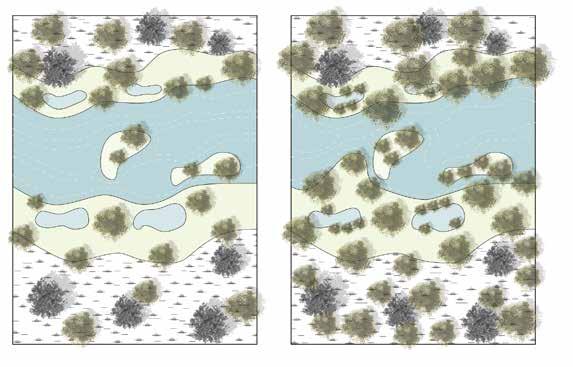
+7.304
Maximum diversity
+13.304 ton km2 yr-1 ton km2 yr-1
Tree planting Wetland Water system
STAGE III STAGE VI
Secondary forest
Secondary forest
Primary forest
Naturalized river
Primary forest
403
Wetland
Rainfall
Filter and improve water quality
· Replenish groundwater
· Biodiversity habitats

· Buffer impact of floods and storm surges
Surface Flow
Filtration
Storage
Roof Garden
WETLAND Functions and scenes in community Wetland Park
404
Spaces for rcreation and education
Discharge
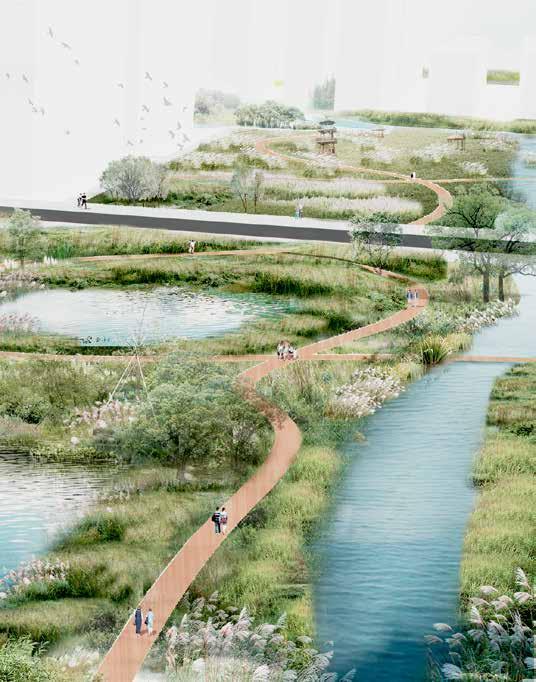
405
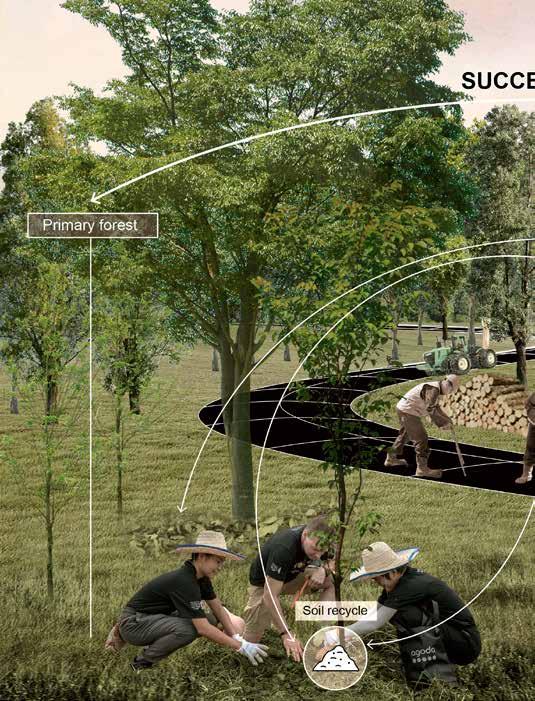
406
FOREST: VEGETATION&SOIL
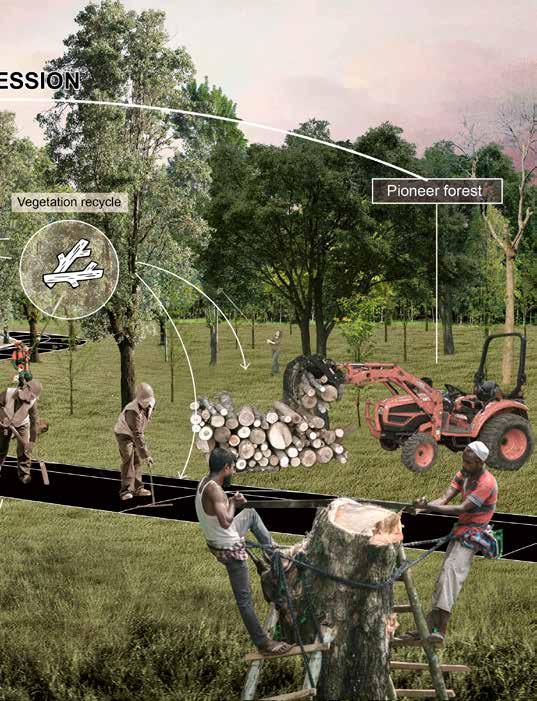
407
COMMUNITY INVOLVEMENT IN RECYCLING CENTER
This picture shows the involvement of residents in the recycling of resources outside the recycling centre. The involvement of the residents opens up more possibilities for how the resources can be used. In addition to becoming ecologically valuable products such as biomass, the natural resources can be used as a tool for people to interact, they can make their own desired items from the wood cut on the site, etc. This makes PLAB a more vibrant community.
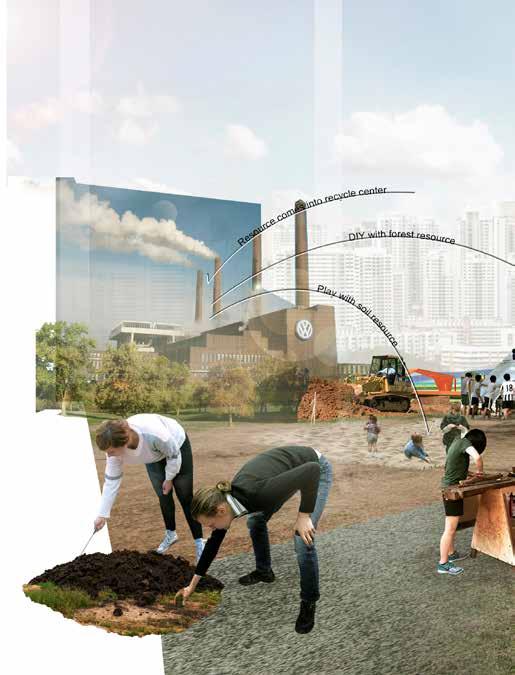
408

409
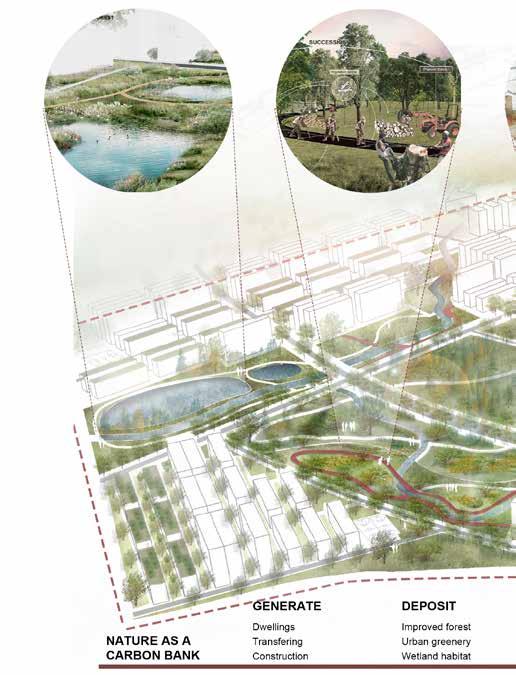
NATURE AS A CARBON BANK 410
In the small site, we have created a carbon bank by visualizing the process of carbon generation, absorption and use in nature and human life.
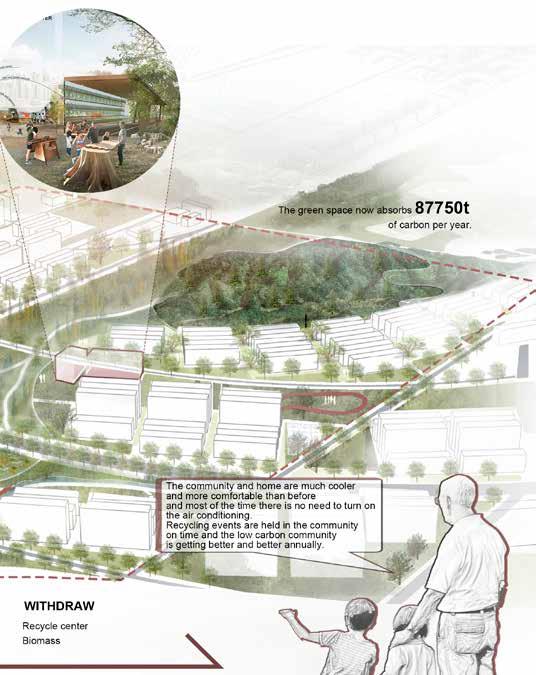
411
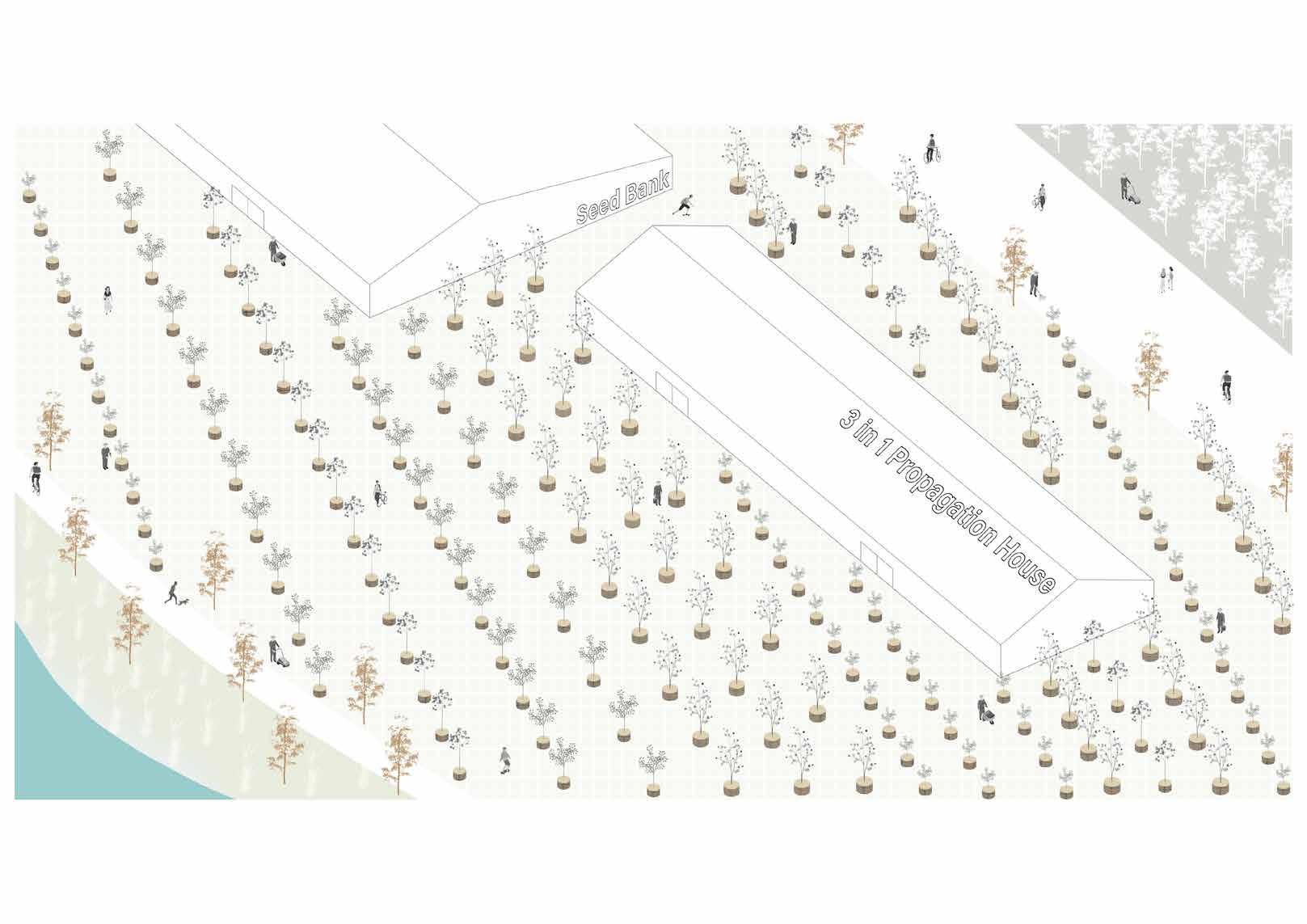
412
PRODUCTIVE LANDSCAPE BUSINESSES
PLAB AS A SUB-REGIONAL CENTRE
Wee Cynthia, Chai Xin Yi
From an economic and social perspective, Singapore's reliance on outsourced landscape materials has been increasingly demanding as more spaces are allocated for landscape projects. Coupled with demanding national green policies and new town rejuvenation schemes, the local market for landscape materials is expected to surge. Existing conventional manufacturing processes have proven to be an inefficient system within this landscarce nation as it is monofunctional, require a large amount of space, generates a huge amount of waste and are typically separated from communities.
From an ecological perspective, past degradation of forests and urban development have caused native tree species to decline severely. To strengthen our nation's ecological resilience, resource security and respond to the increasing economic demands, PLAB has the potential to become a regenerative productive landscape district. In comparison to the rest of Singapore, PLAB has a high amount of green spaces. This creates an opportunity for businesses to capitalize on the natural resources available on-site. Pertinent to these issues, the productive landscape businesses' design interventions are Productive Parks and Productive Streetscapes.
From an economical aspect, productive parks incorporate tree nurseries which aims to meet PLAB/national demands for the development of urban green spaces, additionally assembling a sustainable network of resource management through soil banks, water catchments and cleansing biotopes helps better the regenerative qualities of the business. Productive streetscapes aim to produce timber for manufacturing byproducts that would support PLAB/national park developments, additionally productive streetscapes are designed with the intention of being self-watering, thus reducing maintenance cost.
From a social aspect, productive parks provide recreational green spaces to meet the green needs of residents. For productive streetscapes, this would be to safeguard users' safety as overgrown mature trees pose a safety issue to road users. Both design interventions aim to provide employment and land stewardship opportunities to engage residents.
From an ecological aspect, productive parks incorporate seed banks which aid in safeguarding endangered native tree species future population. For productive streetscapes this would be to provide shade to infrastructures by selective planting.
413

VISION Overview 414
We then did a background research on landscape businesses, ranging from edible garden to bee keeping and we eventually decided on businesses that are scalable and one that utilizes the natural resources available on-site, this landed us into the business of tree nursery and timber production.
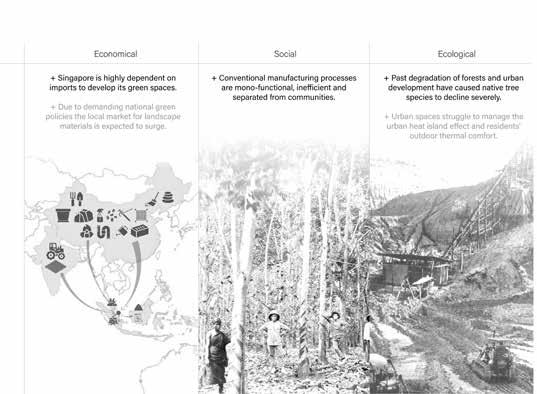
WATER PROCESS PROS CONS SPACE MAN POWER EDIBLE GARDEN TREE NURSERY TIMBER PRODUCTION BEE KEEPING FOOD WASTE TO BIO-MATERIALS EDIBLE GARDEN CITY | 11-50 EMPLOYEES VERTIVEGIES PTE LTD 11-50 EMPLOYEES CITIPONICS | 2-10 EMPLOYEES NUTRINEST BEE RESCUE 2-10 EMPLOYEES [EST.] BEE AMAZED GARDEN | 2-10 EMPLOYEES [EST.] INSECTTA 2-10 EMPLOYEES NA INSECTTA 1600 sqm First urban insect farm in Singapore rearing the over a million Black Soldier Fly [Native to Singapore]. Circular economy. NUTRINEST BEE RESCUE > 100 sqm Sembawang, Orchard road and Jurong Area. BEE AMAZED GARDEN | > 1 ha CITIPONICS minimal water consumes less thatn 1% of traditional farming and 10% of hydroponics farming. Close loop system to prevent water wastage and pollution. Rain water is also harvested to reduce water usage. + A colony may need several liters of water per day. Every bee collecting water usually makes about 50 trips, each time collecting about 25 mg of water. + Shallow dish filled with rocks or marbles is ideal for bees + Sustainably Farmed with zero waste and minimal carbon emission. + 3.5x the Production with 99% less water & minimal electricity + Safest & Purest Harvest grown with 0 pesticides, next to your homes + Conserve the local honey bees. Reduction rate of bee population is in the alarming situation. + Beehives located in cities produce healthier and more productive bees. The reason is that urban bees have access to greater biodiversity, resulting in a more varied diet and stronger immune systems. + Tampines forest has many bee attracting plants. + Valorise food waste [Beer grains & soybean]. Reduce food waste in landfills. + Larvae - Animal Feed + Frass [bio-waste] - Rich Fertiliser suitable for leafy vegetables and urban crops. Doesnt smell. + Bio Materials - Pharmaceuticals and cosmetics + Requires trained professionals + High upfront cost + High labour costs + Technology issues may cause huge problems + Requires trained professionals + High upfront cost + Melissophobia - Fear of bees common among urban community. + Entomophobia, sometimes known as insectophobia EDIBLE GARDEN CITY + OUE Downtown 465 sqm + Singapore Power Group | 150 sqm + Open Farm Community [restaurant] | 929 sqm VERTIVEGIES PTE LTD 2 ha Plant > Harvest > Sell [rotational] Monthly yield Collect > Uncap > Heating > Filtration > Ultrasonication > Creaming Urban bees also produce, on average, 12 kg of honey in their first year. Bio- Materials Harvested > Extraction > Conversion Frass Harvested > Composting [2 months for BSF] FAR EAST FLORA PTE LTD | 51-200 EMPLOYEES PRINCE'S LANDSCAPE PTE LTD | 201-500 EMPLOYEES YEAR 1 1ST - 3RD MONTH = 4 L/INCH OF TRUNK DIAMETER X 2 TIMES A WEEK 4TH - 12TH MONTH = 4 L/INCH OF TRUNK DIAMETER X 2 TIMES A MONTH YEAR 2 - 5 = 4 L/INCH OF TRUNK DIAMETER X 2 TIMES A MONTH FAR EAST FLORA PTE LTD | 0.6 ha CHENGTAI NURSERY | 3 ha CHOP CHING HIN PTE LTD | 8 ha PASIR PANJANG NURSERY NPARKS 6.5 ha [300 000 plants / year] ROGER&SONS | 11-50 EMPLOYEES ARTHUR ZAARO | 11-50 EMPLOYEES [EST.] ROGER&SONS [LOCALLY SOURCED] | 0.8 ha ARTHUR ZAARO [LOCALLY SOURCED] 1800 sqm + Reduce import carbon footprint cost. + Quick turnover rate. Plants can be sold in a year. + Provide good quality plants + A new habitat for wildlife + ^ Trees = ^ Carbon sequestration + Wood is a building material that contribute to the long term reduction of carbon emissions. + Harvested plantations can be replanted and begin the cycle of carbon retention all over again. + Manufacturing timber is low energy as compared to steel, concrete and aluminum. + Labour intensive + Requires regular maintenance, large amount of space & large amount of water + Seed/Cuttings - Sapling stage requires a controlled environment - high humidity & out of direct sunlight + Lead time for cultivation to harvesting requires a long time for mature wood. + Requires careful regular maintenance + Felling of trees will be labour-intensive + Softwoods and Hardwoods will be harvested at different years Seed > Sapling > Young Trees > Redistribution Year 1 Year 2 - 5 2-3 times per year/season Young Trees > Mature Trees Harvesting > Manufaturing Year 7 - 35 BACKGROUND RESEARCH
415


Economical, Social, Ecological 416
ISSUES, STRATEGIES, TACTICS

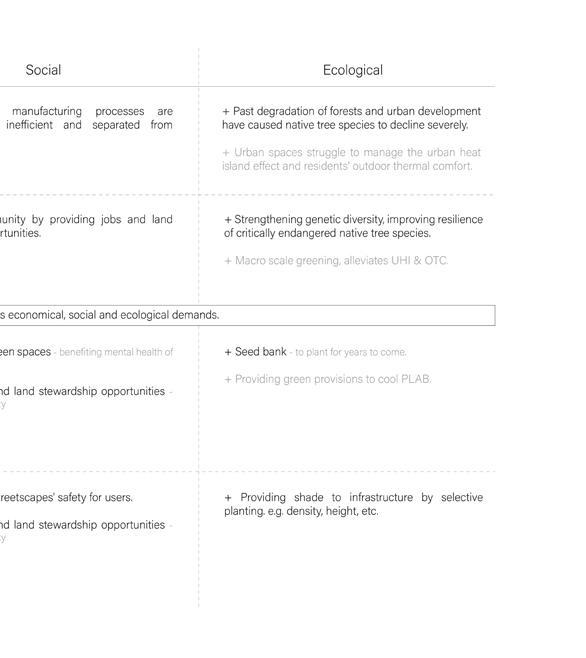
417
ESTABLISHING A SUSTAINABLE RESOURCE MANAGEMENT
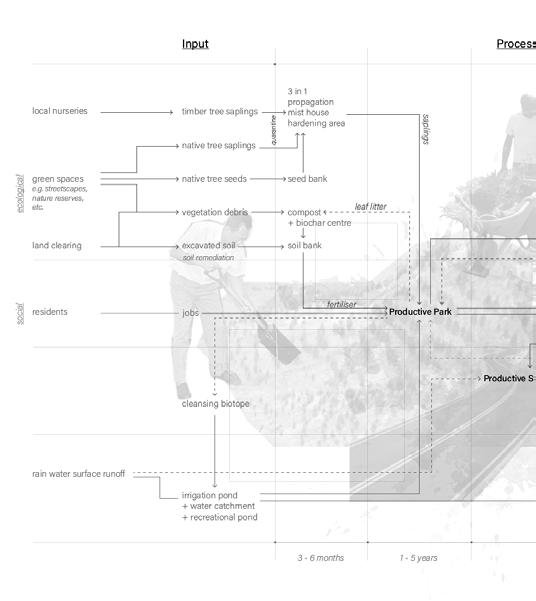
NETWORK Input, Process, Output 418
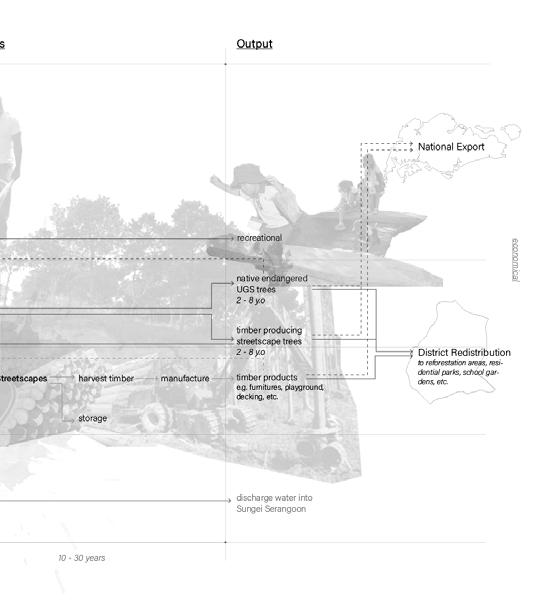
419
SITE SELECTION
Productive Streetscapes & Productive Parks
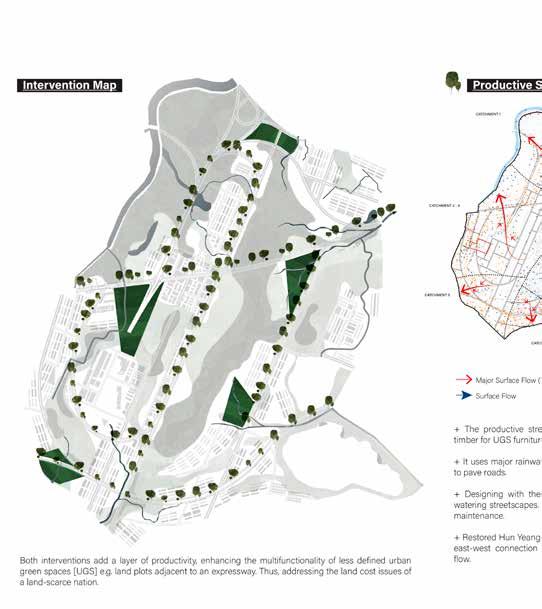
420
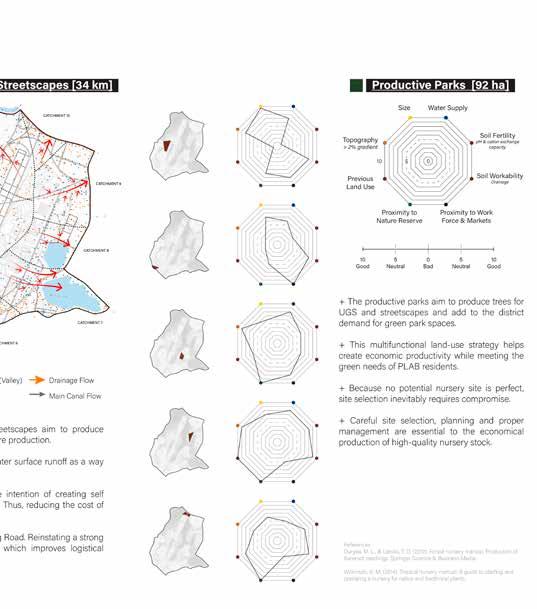
421
INTERVENTION AREAS
Productive Streetscapes & Productive Parks
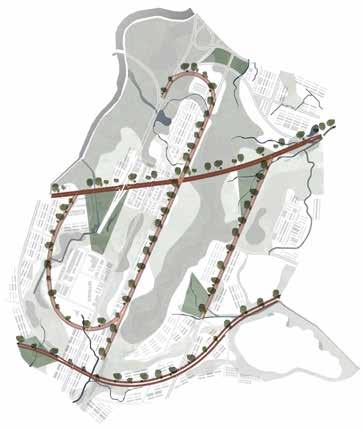
Total estimated amount of trees needed to develop PLAB productive streetscapes: 3 381 trees

Growth rate: Slow-growing Wood quality: Heavy hardwood Cyrtophyllum fragrans
Growth rate: Fast-growing Wood quality: Light hardwood Hopea odorata
By Products
Lorong Chengal Hopea odorata
construction purposes, carts, presses flooring, roofing, fence-posts, ploughs, furniture






Runway Avenue
Khaya senegalensis
flooring, furniture, veneer, decorative work, cabinetry, window frames, plywood, and musical instruments
Furniture
Tembusu Road Pteleocarpa lamponga
roof supports, house building, interior construction
Cladding
Growth rate: Fast-growing Wood quality: Hardwood Khaya senegalensis
Hun Yeang Road
Cyrtophyllum fragrans
heavy construction, railroads, bridges, parquet flooring, furniture, charcoal









Bridges & Furniture
Growth rate: Fast-growing Wood quality: Heavy hardwood Ptelocarpa lamponga
Growth rate: Slow-growing Wood quality: Hardwood Swietenia macrophylla
Mahogany Avenue Swietenia macrophylla
high-end furniture, plywood and heavy construction work, precise woodwork items
High End Furniture
[e] Runway Avenue
[c] Mahogany Avenue
[d] Tembusu Road
[a] Hun Yeang Road
[b] Lorong Chengal
Park Park
ha Capacity : ha Capacity :
malaccensis Ardisia
Mata
elliptica
Ayam
422
Total PLAB Productive Parks : 92 ha

Total PLAB Nursery Area : 14 ha [~15%]
Total estimated develop
Defu Productive Park
Nursery Size : 5 ha
Nursery Max Capacity : 4 500 trees
Total Water Required : 1 800 000 L / yr
Total Soil Required : 108 000 L / yr
Total Fertilizer Required : 13 500 L / yr
[a] Productive Park
Nursery Size : 13 ha
Nursery Max Capacity : 2 100 trees
Produces 10 types of trees
Timber Producing Streetscape Trees
[d] Productive Park
Nursery Size : 14 ha
Nursery Max Capacity : 1750 trees

3 381 trees
Nursery Size : 17 ha
Nursery Max Capacity : 2 100 trees
Growth Wood quality: Cyrtophyllum




Nursery Size : 11 ha
Nursery Max Capacity : 1 400 trees
Growth Wood quality: Hopea

Total PLAB Nursery Max Capacity : 11 850 trees By Products



Native Endangered UGS Trees

[a] Hun [b] Lorong
[c] Productive Park
[b] Productive Park
Khaya senegalensis Senegal Mahogany Pteleocarpa lamponga Tembusu Tikus Cyrtophyllum fragrans Tembusu Swietenia macrophylla King American Mahogany
Hopea odorata Chengal Pasir
Syzygium glaucum Eugenia glauca
Tarenna fragrans River Tarenna
Sterculia parviflora Samrong Koompassia malaccensis Kempas Ardisia elliptica Mata Ayam
Lorong construction presses fence-posts,
423
QUANTIFYING DEVELOPMENT NEEDS
Establishing PLAB Trees KPI
PLAB Benchmarking
Meeting the prescribed green needs of residents.
URA PLAB Target = 160 000 DUs
No. of residents = 160 k x average household size
Total Residents in PLAB : 506 176
Green Park Spaces needed to serve PLAB residents [0.8ha/1 000 residents] The Population White Paper 2013 = 506 176 / 1000 x 0.8 ha = 414 ha
Current urban park [Bedok Reservoir green spaces 59 ha ] & Revamp park [Tampines Quary 62 ha] vs PLAB green needs = 59+62/414 x 100 = 29%
Minimum required added GPS - 293 ha
Estimated amount of trees needed to develop parks in PLAB [est. 50 - 100 trees/ha of park] = 293 ha x 75 = 21 975 trees
Total estimated minimum amount of trees needed to develop PLAB green park space = 21 975 trees
Accounting for margin of error
20 % + Other Demands
Total estimated minimum amount of trees needed develop PLAB green park space = 21 975 trees
20 % MOE = 21 975 trees x 1.2 = 26 370 trees
Other Demands = 26370 + 500 = 26 870 trees
[Based on 1 tree every 10 m spacing.]
Total estimated amount of trees needed to develop PLAB productive streetscape = 3 381 trees
Total estimated amount of trees needed to develop PLAB productive streetscape = 3 381 trees
20 % MOE = 3 381 trees x 1.2 = 4 057 trees
Other Demands = 4 057 + 500 = 4 557 trees
Chengal Runway Avenue Tembusu Road Hun Yeang Road Mahogany Avenue 5.26 km 9.00 km 4.95 km 6.92 km 7.68 km 526 trees 900 trees 495 trees 692 trees 768 trees Productive Streetscapes Demand Urban Green Spaces Demand
Lorong
424
Fast Growing UGS Native Trees
Schedule - 2 Yrs
Koompassia malaccensis
Ardisia elliptica
Final Development KPI
Moderate Growing UGS Native Trees
Transplanting Schedule - 4 Yrs
Syzygium glaucum
Sterculia parviflora
Tarenna fragrans
Total amount of trees needed to development UGS + PS
26 870 + 4557 = 31 427 trees
Fast Growing PS Tree Transplanting Schedule - 2 Yrs
Hopea odorata
Khaya senegalensis
Pteleocarpa lamponga
Slow Growing PS Trees
Transplanting Schedule - 8 Yrs
Cyrtophyllum fragrans
Swietenia macrophylla
needed to PLAB
Transplanting
704 trees 5394 trees 5394 trees 5394 trees 5394 trees 5394 trees 704 trees 704 trees 536 trees 536 trees 425
PLAB DEVELOPMENT PHASES
Transplanting & Harvesting Schedules
426
427
PRODUCTIVE STREETSCAPES
Intervention Aims & Species Selection
Intervention Aims
+ Establish young trees in streetscapes for timber produces
+ Harvest timber into furniture and other usages within Urban Green Spaces
+ Harvest timber in intervals of rotation periods for future exports outside of PLAB
+ Capitalize on existing topography and hydrology to reduce watering efforts
+ Give PLAB a sense of district identity with these 5 main productive streetscapes

Softwood:
Softwood is wood from gymnosperm trees.
+ Burns quickly
+ Provides a good heat output
+ Dries/seasons quickly
+ Grows fast
+ Relatively cheap
Hardwood:
Hardwood is wood from dicot trees.
+ Provides an excellent heat output
+ Burns for a long time
- Does not burn for long
- Can produce excessive smoke
- Can split and crackle lots
- Takes a long time to grow
- Takes a long time to season
+ Produces less smoke than softwood - Is more expensive than softwood
Fast Growing PS Tree Transplanting Schedule - 2 Yrs
Hopea
Slow Growing PS Trees
Schedule - 8 Yrs
Transplanting
odorata
senegalensis Pteleocarpa lamponga 704 trees 704 trees 704 trees
fragrans Swietenia macrophylla 536 trees 536 trees
Khaya
Cyrtophyllum
Hun Yeang Road MahoganyAvenue MahoganyAvenue Hun Yeang Runway Avenue Lorong Chengal 428
Productive Streetscape Trees










Hopea odorata
Chengal Pasir
25-30m (H), 1.2m (D)
Full sun
Moderate water
Fast-growing Strong light hardwood



Khaya senegalensis Senegal Mahogany
15-30m (H), 1m (D)
Moderate shade
Moderate water
Fast-growing Hardwood
Pteleocarpa lamponga Tembusu Tikus
37m (H)
Full-part sun
Moderate water
Fast-growing Heavy hardwood

Cyrtophyllum fragrans Tembusu
30m (H)
Full Sun
Moderate water
Slow-growing Heavy hardwood
Swietenia macrophylla King American Mahogany

40m (H)
Full sun
Moderate water
Slow-growing Hardwood
Slow-growing: 2 years to reach 1m
Moderate-growing: 4 years to reach 1m






Fast-growing: 8 years to reach 1m














Selection Parameters:







Native Nationally extinct

Productive Streets Lorong Chengal Runway Avenue Tembusu Road Hun Yeang Road Mahogany Avenue Road Lengths 5.26 km 9.00 km 4.95 km 6.92 km 7.68 km Trees planted 526 trees 900 trees 495 trees 692 trees 768 trees 429
Yeang Road Tembusu Road
PRODUCTIVE STREETSCAPES
Harvesting & Transplanting Phases
Fast-Growing PS Tree Transplanted at 2 years old Fast-Growing PS Tree Harvested at 12 years old 18.0 m 15.0 m 15.0 m Year 2042 F.G plant batch 2 18.0 m 15.0 m 15.0 m Year 2050 100% F.G harvest batch 1 1m 2m 1m 5m 4m 6m 18.0 m Main Road Runway Avenue 15.0 m PS Plant Verge Fast-Growing Trees 15.0 m PS Plant Verge Fast-Growing Trees Year 2048 100% of F.G Batches Transplanted Fast-Growing [F.G] Batches F.G plant batch 1 F.G plant batch 2 F.G plant batch 3 F.G plant batch 4 F.G plant batch 5 430
Slow-Growing PS Tree Transplanted at 8 years old Year 2054 S.G transplanted batch 1 18.0 m 15.0 m 15.0 m Year 2066 50% S.G harvest batch 1 18.0 m 15.0 m 15.0 m Slow-Growing PS Tree Harvested at 28 years old 1m 1m 3.5m F.G S.G 18.0 m Main Road Hun Yeang Road 15.0 m PS Plant Verge Slow-Growing Trees 15.0 m PS Plant Verge Slow-Growing Trees Slow-Growing [S.G] Batches Year 2076 50% of S.G Batches Transplanted S.G plant batch 1 S.G plant batch 2 431
PRODUCTIVE PARKS
Phases Detailing Productive Parks Yearly KPI
Vacant Space * for other plants & maintenance
Fast Growing PS Tree Transplanting Schedule - 2 Yrs
Hopea odorata
Khaya senegalensis
Pteleocarpa lamponga
Slow Growing PS Trees Transplanting Schedule - 8 Yrs
Cyrtophyllum fragrans
Swietenia macrophylla
Fast Growing UGS Native Trees Transplanting Schedule - 2 Yrs
Koompassia malaccensis
Ardisia elliptica
Moderate Growing UGS Native Trees Transplanting Schedule - 4 Yrs
Syzygium glaucum
Sterculia parviflora
Tarenna fragrans
Nursery production begins in 2038 and it takes 10 years for the nursery to produce enough trees to complete the PLAB development KPI.
nursery
begins 2040 year 2 2038 year 0 2042 year 4 2044 Total PLAB PP Nursery 0 % 100 % 0 % 100 %
production
0 % 100 % Transplanting Percentage/Development KPI Transplanting Percentage/Development KPI FG UGS Native Trees FG UGS Native Trees 10% 5% MG UGS Native Trees MG UGS Native Trees 50% 0% FG PS Tree FG PS Tree 40% 20% SG PS Trees SG PS Trees 0% 0% Defu PP [a] PP [b] PP [c] PP [d] PP
432
PLAB UGS development KPI completion support maintenance & export/redistribution demands
2044 year 6 2046 year 8 2048 year 10 0 % 100 % Transplanting Percentage/Development KPI Transplanting Percentage/Development KPI 0 % 100 % Transplanting Percentage/Development KPI FG UGS Native Trees FG UGS Native Trees FG UGS Native Trees 20% 100% 15% MG UGS Native Trees MG UGS Native Trees 100% MG UGS Native Trees 100% 0% FG PS Tree FG PS Tree 80% FG PS Tree 100% 60% SG PS Trees SG PS Trees 100% SG PS Trees 100% 0% 433
DEFU PRODUCTIVE PARK Detail Design
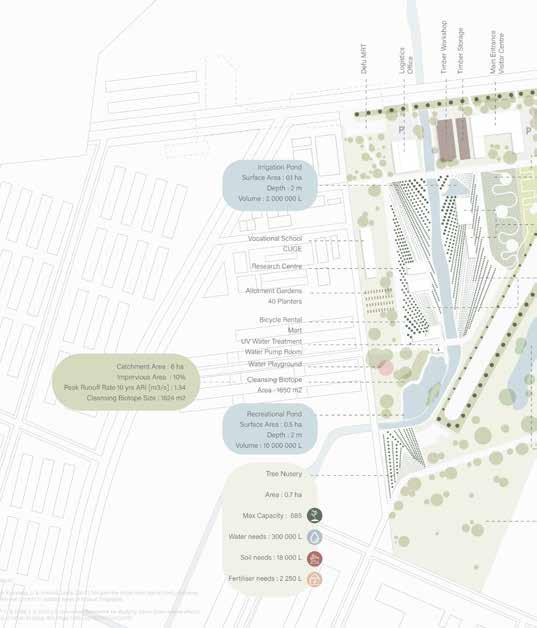
434
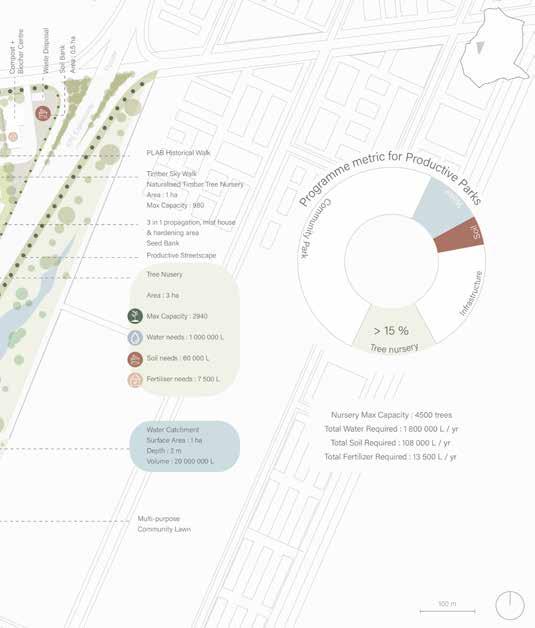
100m 435
Some existing buildings are retained and repurposed for the park infrastructure. Excavated soil from terrains that are cut for new watersheds will be remediated at the soil bank.
The existing canal will be naturalized, 3 new watersheds will be created for recreational purposes, irrigation and water catchment. Lastly, the removed existing greens for park developments will create vegetation debris that goes into the compost and biochar centre before entering the soil bank.
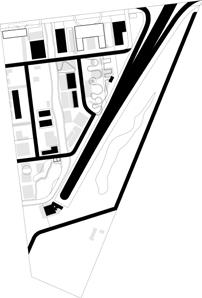
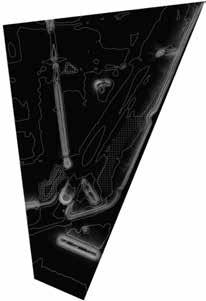
Defu Productive
Retained Existing / Repurposed - Removed Existing - Cut Terrain for New Watersheds Soil Bank + Added 3 New 3 in 1 Propagation House Seed Bank Soil Bank Area : 0.5 ha Timber Workshop Compost + Biochar Centre + Recreational Pond Surface Area : 0.5 ha Depth : 2 m Volume : 10 000 000 + Irrigation Pond Surface Area : 0.1 ha Depth : 2 m Volume : 2 000 000 L + Water Catchment Surface Area : 1 ha Depth : 2 m Volume : 20 000 000 Excavated Soil Soil Remediation Logistics Office + Recreational, Irrigation
SITE ANALYSIS
Park
436
Surface Water Flow
Drainage Water Flow
Cleansing Biotope Area : 1650 m2
[Calculations]

Catchment Area : 6 ha
Impervious Area : 10%
Peak Runoff Rate 10 yrs ARI [m3/s] : 1.34
Cleansing Biotope Size : 1624 m2
Renaturalised Canal
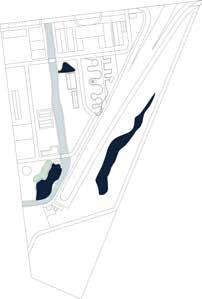
New Watershed
Irrigation Pond & Water Catchment
Vegetation Debris
Scrubland
- Removed Existing Greens for New Watersheds
+ Nursery + Productive Streetscape
Open Field Green Spaces + Park
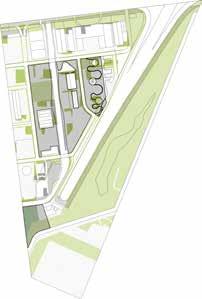 Compost + Biochar Centre
Compost + Biochar Centre
ha L ha L L
437
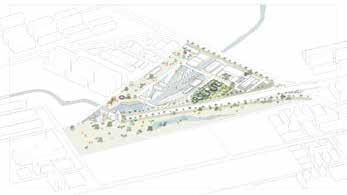
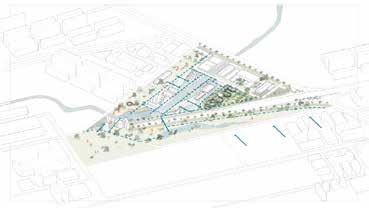

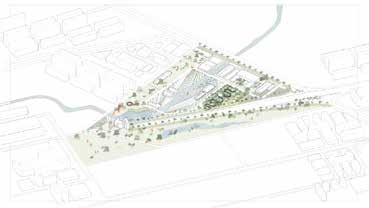


INPUT & OUTPUT Defu Productive Park 438




439

TREE NURSERY Defu Productive Park Perspective 440

441
TRANSPLANTING SCHEDULE IN TREE NURSERY Defu Productive Park Section
Nursery edges occupied by fast growing trees for easier transplanting. Nursery center occupied by slow growing trees as it requires less disturbance for a prolong period.
Moderate Growing UGS Native Trees Harvest at 4 years old
Fast Growing UGS Native Trees
Harvest at 2 years old
Human activity only allowed when tree is 50 cm in height to prevent being trampled.
4.5 m 5.0 m 3.5 m
Spacing 5 m to 2 m - Wider than a conventional nursery as
442
it is also used for recreational purposes. Less competition for sun a
nutrients.
1 m 1
1 m 1 m
m
Fast Growing PS Tree Harvest at 2 years old
All trees transplanted at 1m.
Brought out from 3 in 1 propagation house to nursery at 25cm. trampled.
3.5
3.0
2.5
Slow Growing PS Trees Harvest Harvest at 8 years old
3.5 m
m
m 2.5 m
m 2.0 m
nd
443
1 - 2 ° terrain gradient for optimal drainage

NURSERY Defu Productive Park Pespective 444
NATURALISED TIMBER TREE

445
446
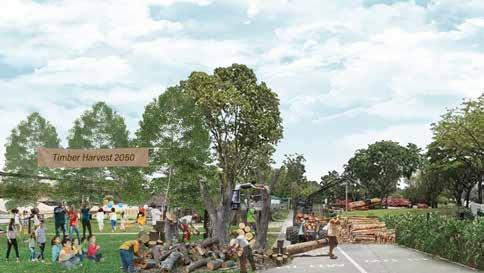

PLAB ENGAGEMENT & EVENTS Defu Productive Park 447

448

449
REFLECTION
This studio gave me a new perspective on understanding landscape. It was also the first time to intervene in a larger scale urban planning from the perspective of landscape, which was a completely different experience from the past design courses. Revision after revision and logical deduction made me get a great exercise in this course and learn how to find the most balanced way between ideal and reality. Besides, it was also my first time encountering a bird-based topic, and it was a new experience to analyze and plan the site with birds as the main characters. I learned a lot about birds and their essential role in seed dispersal, as well as the process of forest succession. I believe this studio will help me greatly in my future study and work.
Under the topic of landscape connectivity with birds, I began to rethink the relationship between nature and people. What nature can offer to people is as important as how people should protect it, as this determines whether the designer's ideas will attract the people who will pay for them. Human attitudes towards nature represent an interesting duality, between the human desire to heal and refresh in nature and to satisfy their curiosity, and the abhorrence of the dangers that nature can pose. It therefore takes patience to strike a balance between conflicting demands. In many cases sacrifice is inevitable, but a good idea is possible to achieve the best of both worlds. Only an in-depth and detailed analysis of the interaction between man and nature will reveal more of these possibilities.
Under the guidance of the development and issues in Singapore, the studio enables me to re-examine the relationship between nature and nature, as well as between human and nature, so that they can connect with each other and mutually benefit each other. The research and design started from large-scale planning of PLAB and then focused on quarter scale to neighborhood scale areas.We integrated ecological knowledge with landscape architecture to promote forest regeneration and improve people's mental health with the help of birds.This is a new challenge for us to seek the solution of how to provide a more conducive environment for birds while respecting their habits, and at the same time maintaining a reasonable relationship between human and nature.This new experience is the cornerstone of our study to figure out how can our design serve as a balance between human and nature to bring benefits to our living environment.
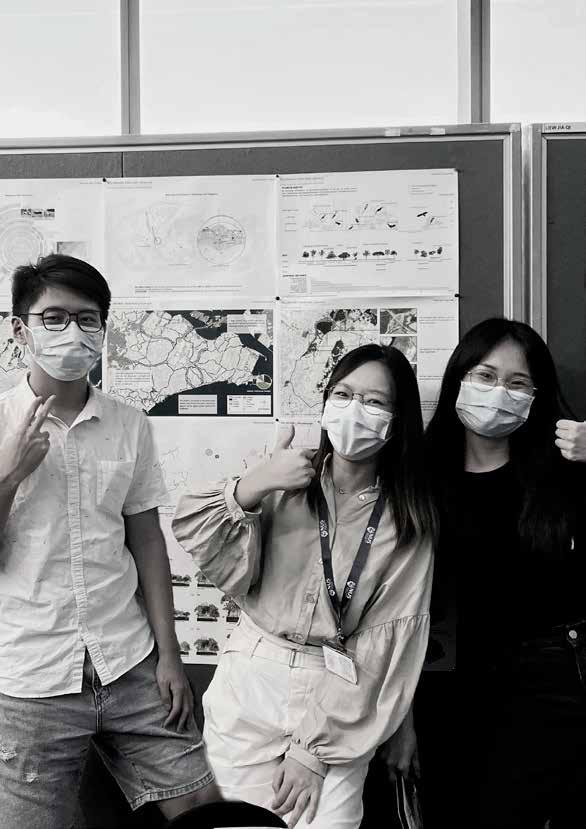 -Dong Liwei
-Shen Yunnan
-Dong Liwei
-Shen Yunnan
450
-Zhang Yuer
This semester’s studio let me shift the perspective from design to planning on a larger scale and start to think about what the landscape can do at the brownfield like an airport. Soil involved not only the soil properties but also can permeate every aspect of the landscape in the city, interwoven with the surroundings.
The soil and land are the basics of the landscape but are also the most neglected parts of the design because they are such familiar to us. We are used to cutting and filling the soil and land, but it is easy to forget that the soil itself has different personalities like humans, and it is manifested in the difference in physical and chemical properties in different environments. After gaining a deeper understanding of soils, I realized the importance of choosing the right strategies for soil restoration and allowing them to create value for the city at the same time.
Through this studio, I have a more comprehensive understanding of landscape design. I had never touched the issues of soil transfer and treatment before, and it was this studio that made me realize that landscape can play its role in more aspects. At the same time , large-scale planning is not a small challenge. Instead of being good at detailed design, I also benefited a lot from how to balance design with the requirements of the government and the site when contacting with planning. Finally, this studio made me know more about the real design process, which made my design ideas more practical and feasible instead of being based on nothing. All in all, I am very grateful for this studio, which gives me more ideas and understanding of this field.
In such an era of rapid urbanization, the speed of urban renewal makes it easy for us to ignore natural factors. In this studio project, we try to plan and design the city from the perspective of landscape Urbanism. We start thinking from a micro perspectivethe natural factors of the site itself, link it to the macro social issues in Singapore as a whole and finally get our vision and strategy. I also benefited a lot from learning and communicating with other groups during the course. Groups with different themes negotiate and compromise with each other, and finally form a unified master plan. This way of designing is something I haven't tried before. Although our group had a hard time advancing the plan, I also learned a lot of new theoretical knowledge form other fieldsduring this process . It also made me see more potential in landscape architecture.
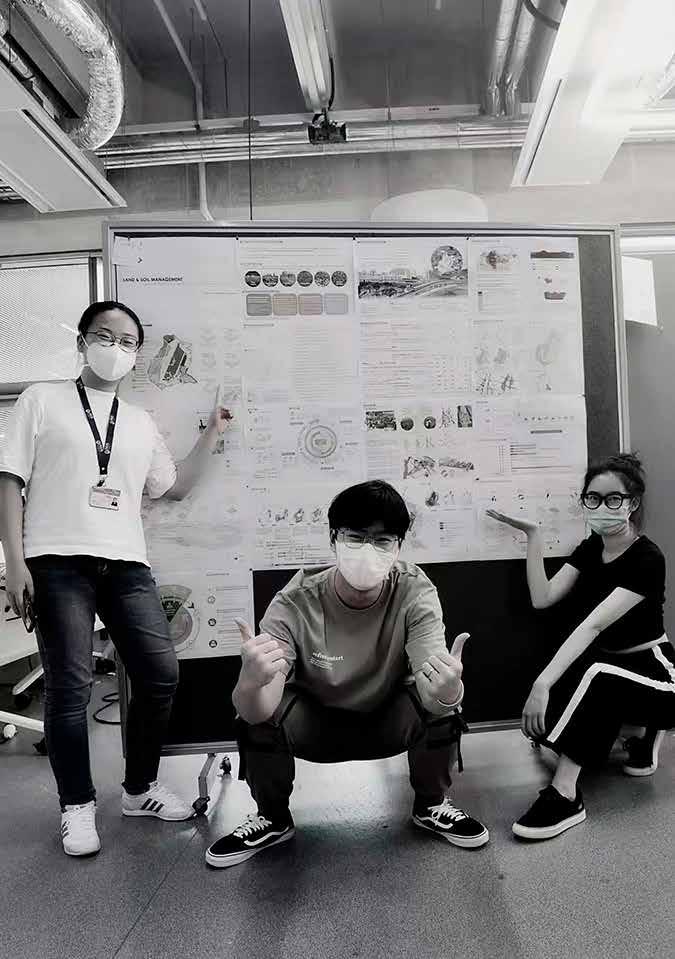 -Wang Yu
-Zhang Wenting
-Wang Yu
-Zhang Wenting
451
-Liu Kangsheng
The course topics this semester have given me an introduction to other areas as well, such as materials science and planning. This makes me feel that the landscape is not just about building green spaces, it actually has many entry points. In addition to this, the teacher encouraged us to incorporate future technology into consideration, and integrate the landscape design with it. The design is divided into studio part and group part, and the research direction of each group is different. So when we decided on the studio theme, we went through many rounds of negotiation. I think it's a very meaningful process that simulates multi-disciplinary cooperation.
At the beginning of the semester, I chose the topic of recyclable materials because I wanted to challenge a subject I had never known before. This is also the first time I have been exposed to such a large-scale planning project, so I did encounter some difficulties in discussing and determining the overall plan with other groups. However, these negotiation processes are also particularly meaningful, and helps me to build a good sense of cooperation in my later studies and work It was also a particularly good collaborative process for me within our three-person team. Thanks to my teammates and Lehana!
This semester’s studio has been a great challenge and a special experience for me. As the title was recycled construction material, my team and I were initially confused when we did the research as it didn't seem to have anything to do with landscape architecture. But in the constant discussions within the group and with Lehana, I have become more and more aware of the ecological core behind this topic. The landscape major is not only to design a beautiful park, but also to deeply understand the relationship between the city, society, and ecology. At the same time, we should also have a deeper sense of social responsibility, and use the methods of landscape to deepen the society's awareness of material recycling.
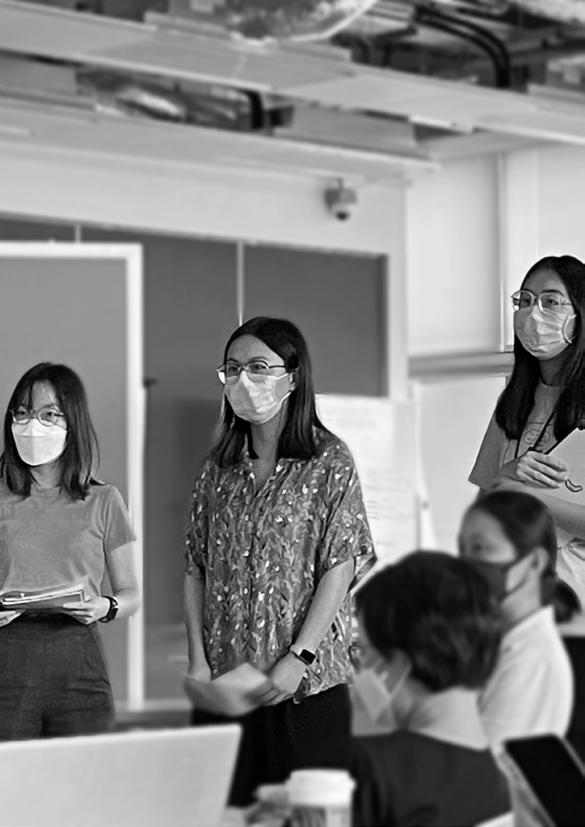 -Ye Han
-Ye Han
 -Liu Ziyue
-Liu Ziyue
452
-Jiang Yuli
In this semester's studio, besides the traditional landscape design, the tutor led the studio to complete the plab planning and design together. Each group needed to coordinate with other themes while completing their own theme, which was a very challenging task.I learned not only how to do a large-scale planning but also how to work with a lot of people.
In our group's theme, water management, I learned the whole system of how to use water through landscape treatment. Through research of WSUD and ABC water programme, I got to know about the eco-way of water management and began to think about what can we do more about water management. Water is no longer an embellishment in landscape design, but a link between people and nature, community and history.
-Hu Die
I learned a lot from the studio this semester, guiding landscape design from a macro perspective of urban ecology. Collaboration with groups designing different topics, constant discussions and consultations have also allowed me to see PLAB in a more holistic way. But this is the first time I've done a studio with so many groups, it's not an easy thing.
As for our group topic: water management. Under this topic we discuss the relationship of ecology, history and community to water management and water purification. Combined with the course of landscape construction this semester, my understanding of WSUS, water treatment, and water ecology has been greatly improved.
-Lin Lan
I gained a lot in the process from the field trip to PLAB in the early stage to generate strategies and finally to the derivation of design. The site investigation helped me to have a deeper understanding of the site, and brainstorming with group members inspired me to think about water management from a new perspective with more innovative approaches that integrate with technology, culture, history, and ecology.
Challenges also emerged. The scale of PLAB is so large compared to usual projects. Such a design process was very challenging, but it also gave me a comprehensive understanding of how to adopt urban ecological principles to affect urban planning. The teamwork with each group also made me understand the importance of communication. In addition, another important thing I learned was how to craft storylines to better present the narrative of our design. Good presentation is just as important as good design.
-Jin Zhuoyin
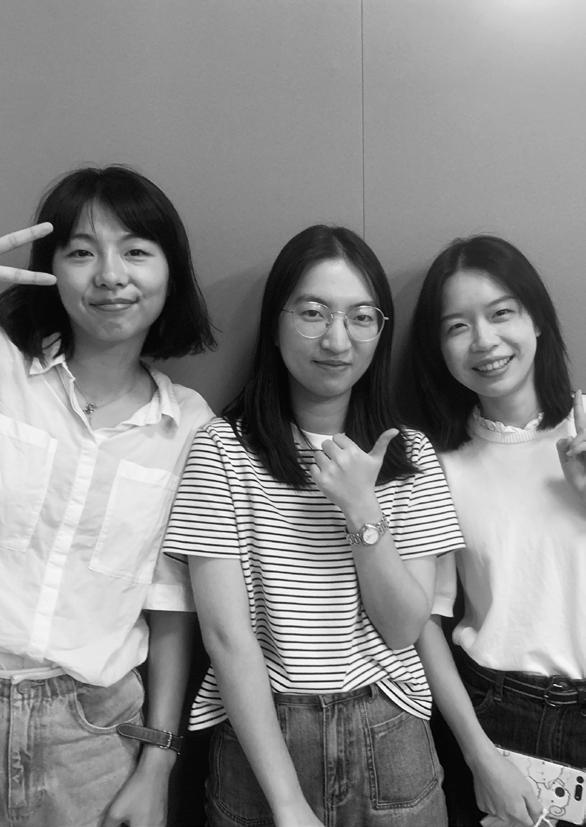
453
Due to the huge scale and coordination amongst groups with very varied focuses, this studio project was challenging. The negotiation process was fascinating because it allowed us to see the same area of land through new lenses and understand the requirements from several angles. Our group topic proved to be more difficult than I had anticipated, as water is a fluid element with a lot to consider during the design process, as one stage of protection can severely effect other sections. Our group envisions PLAB to be a selfsustaining town model for future Singapore, but we are limited by farming and growing techniques that require a large piece of land and appear to have too much compromise to achieve our goal; instead, a more balanced and multi-functional land should be proposed in future projects. Finally, I would like to express my gratitude to my groupmates for their unwavering support during this process.
This studio project had provided a unique experience which greatly involved teamwork & communication. The main challenges I faced were designing on a large scale, integration of ideas with other groups & planning for the design of an adaptable framework. Encountering these unfamiliar challenges has helped me develop a strong appreciation for town planning & design. It was also inspiring to see the progress of my peers. I have learnt a lot from working together with my groupmates as well. Reflecting back on the project has helped me to understand my shortcomings & areas in need for improvement. Aside from a lack of graphical & presentation skills, I need to look beyond planning & innovate more through design. The most crucial takeaway for me is the need to be decisive, understanding what I want to achieve & the ability to construct an understandable narrative.
Master planning at a macro town-level scale proved to be a challenge this semester. With overlapping ideas, areas of focus, similar design interventions, and topics, resulted in a to-and-fro negotiation, of project hierarchy and importance, that finally led to the overall masterplan concept. The discussion pushed me to initiate conversations and constantly communicate my ideas between the different groups so that we can reach an agreement as well as better understand each other’s projects and objectives. Throughout the semester from consultation to interims, I am able to see the process and commendable works of my peers and studio mates which inspired me to push harder and try designing outside of my comfort zone, be it graphically or systematically. There is much room for improvement if more time were given, such as how we approach our topic, not limiting our design to farming, and possibly exploring further on the aquatic species.
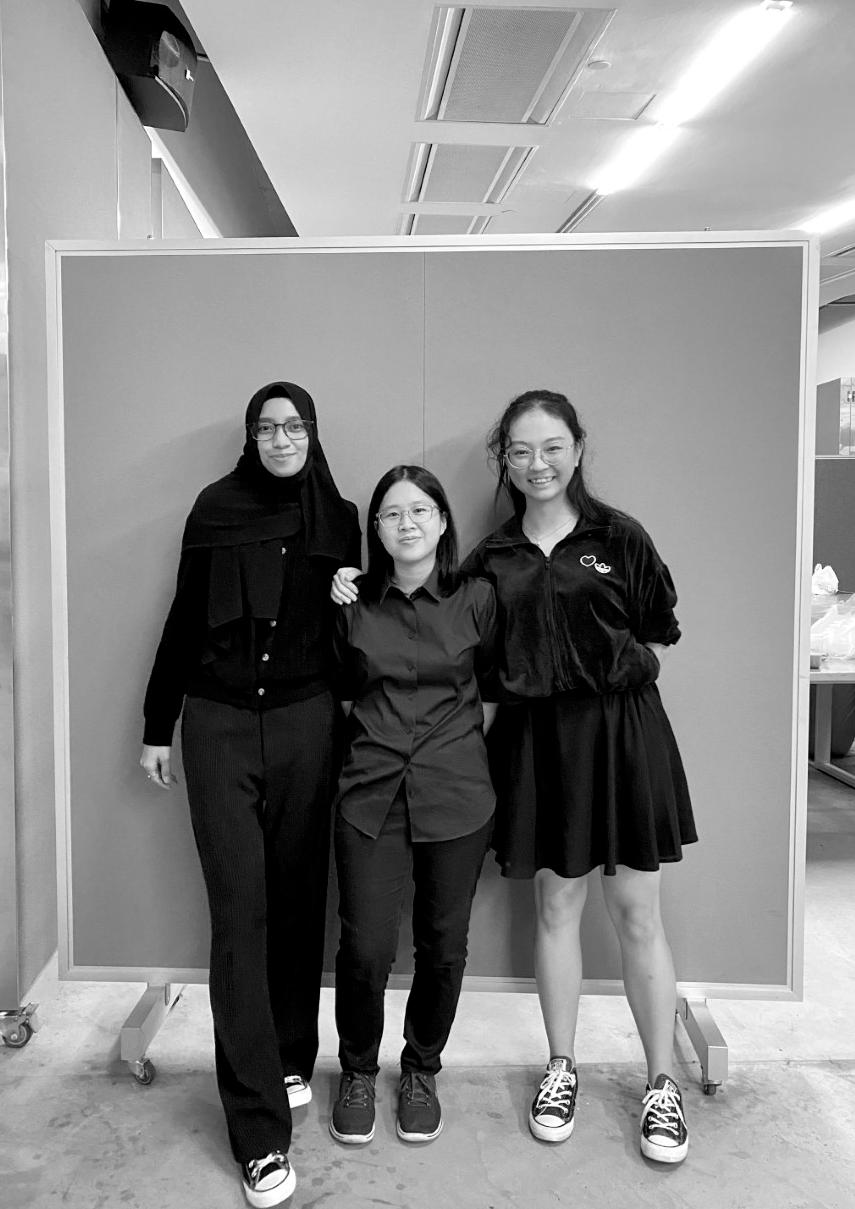 -Xing Zhiyan
-Janina Kwan
-Xing Zhiyan
-Janina Kwan
454
-Sabrina Shafari
The soil related design of this semester gave me the opportunity to think from a more research perspective and analyze the current situation of the site more scientifically. It also made me realize that the experimental results are not the same as the design. Not just addressing problematic areas but leveraging scientific evidence to better understand the site and thus have a clearer idea of how to use existing site resources, propose a reasonable method. As a team, we share and negotiate important ideas with each other, allowing me to see soil issues from more perspectives. The studio has also enhanced my ability to think outside the box, allowing me to continue thinking about how to apply ecological concepts to more logical designs in the future.
The last four months of the studio have given immense knowledge and awareness on ecology particularly about soil and insects. This topic is unique in its own way as it will always have something new to learn and I really feel very grateful to be introduced to this topic with new ideas got to incorporate in large scale project of PLAB. The initial process of working as a studio with divergent thinking gave a new experience and a chance to share thoughts with each other. Studio has strengthened my ability to think, preserve and complement the natural elements within an urban setting and to implement an ideology of “Landscape comes first” to design any project in near future.


In this semester's studio, the topic of our group is about soil. This is a relatively new research field for me. In previous projects, I did not pay much attention to the improvement of soil itself and the treatment of soil is often for water or plants. Undoubtedly, the topic of soil is full of challenges for me. In order to better study the current situation of soil on the site, my team members and I went to the site to collect samples and analyze them in a professional laboratory, which makes us have a more comprehensive understanding of the current situation of the site. In addition, we also read a lot of literature and books related to soil and made relevant case analysis, which laid a solid foundation for our later proposal. Finally, really thanks the teacher for her guidance, which provided some important ideas and ideas when we don't know how to dig deeper.
 -Zhou Sicong
-Anchita Nitin Mirwankar
-Zhou Sicong
-Anchita Nitin Mirwankar
455
-Cao Naichun
This studio has really been a productive experience for me. Because this time we focused more on the importance of the design process rather than the design result, although it was difficult, it gave me a new perspective towards importance of knowledge about landscape processes. In addition, this time we look at the landscape design from the perspective of animals, hoping to make the urban landscape reasonably wild through selective intervention. This learning process also allowed me to understand the complexity of seed dispersal mechanisms, and I look forward to more opportunities to continue ecological research in the future, as well as pushing my limits and learning more in my next studio.
In this studio, I really appreciate our group work. It was tough to make sure everything was successfully in progress as every of us had to negotiate with other team members. I am happy to see the team work turns out fantastic finally. Throughout the semester, we integrated the designing with ecological knowledge then we found the interesting point of combination of different subjects. About our designing, it could be my first time that we only focused on the thinking process to get the decision of site masterplan instead of doing the detailed design. Even though it was tough, I appreciate the thinking process and integration of our group team outcomes during that time.
It’s been a challenging semester, not only because this is probably the first time I worked on a project that focuses so much on the ecological perspective, but also the first time teamed up with other thirteen classmates to come up with one overall plan. Even though there is some back and forth on certain planning issues, I consider them all to be good and necessary thinking processes to help us practice from multiple aspects. Also, this semester involves a lot of big-scale planning methods, which I didn’t have much experience with since what we learned before focused more on the smaller scale landscape design. Now I think it’s rewarding that, after this semester, we have another set of tools to put in our back pocket for future references.
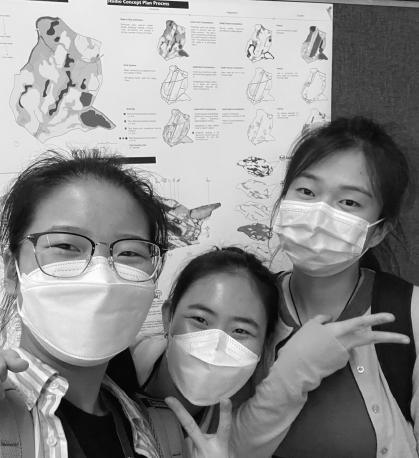 - Ruozhu Xu
- Wanruo Chang
- Ruozhu Xu
- Wanruo Chang
456
- Yilan Shi
This studio is very meaningful for me. First of all, I'm glad to work with my team as our skills are complementary and our inspirations are mutually aligned. It was the first time for me tried to design in a large-scale ecological direction, and I learned a lot from this process when cooperating with each other. Junyao's capabilities in GIS analysis technology allowed us to smoothly advance the program with the available data, while the other two of us did well in proposing design ideas and drawing graphics. Our professor, Yun Hye, worked diligently to provide us with multiple guidance from analysis to design to presentation. It is an honor to work with her and I have benefited a lot.
-Liangyu Wang
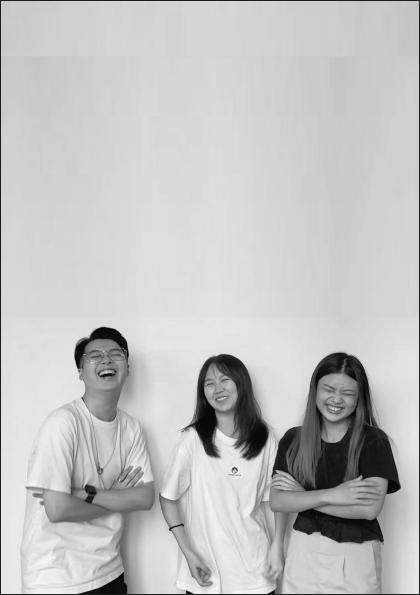
A pleasure and interesting studio for me. It is worth mentioning that professor Yun Hye's guidance really pushes us forward. I communicate with her a lot during the semester, when I found her extensive knowledge of ecological planning is very helpful which help me learn more on the city-scale design. Meanwhile, the cooperation of our team is really effective, I'm happy everyone in my group tried their best to work on the project and present their efforts in the final. We did a lot interesting research and analysis and the experience inspire me to make further explore about relevant topic.
-Junyao Ren
I had a really good experience in our studio this semester, the whole workflow was organized very well and went smooth. I learned a lot from my group members since we had one interesting perspective and everyone contributed a lot to delivering the final work. In general, I’m glad this is the most effective studio I have ever had for not struggling too much with the design concept or forms but spending time to think deeply. Meanwhile, suggestions from our tutor fed our thinking process and pushed us to achieve the big picture of our project, which guaranteed to use our time and work wisely.
-Yuxi Zhang
457
During the semester, the group and I were very confused at first when we saw the topic ''Recycling natural elements as natural capital''. After many weeks of discussion with Yunhye we developed our own way of dealing with natural resources. Firstly, we realised that we needed to have a clear understanding of the resources that existed on the site before we could deal with them, such as how much of each resource there was. It took us quite a while to work out how to calculate the resources, as we had never before imagined that the number of trees in a forest could be estimated, and that the soil in a forest could be calculated. We then clarified that our aim in dealing with natural resources was to create a carbon bank for PLAB, and then on the basis of this we devised three basic strategies. The process of the design was difficult this semester, but also rewarding. I have never felt so much pressure in my previous landscape studies career and it was clear that the content of my design was of a very different depth and breadth to that of my undergraduate studies. Overall, it was painful, but rewarding.
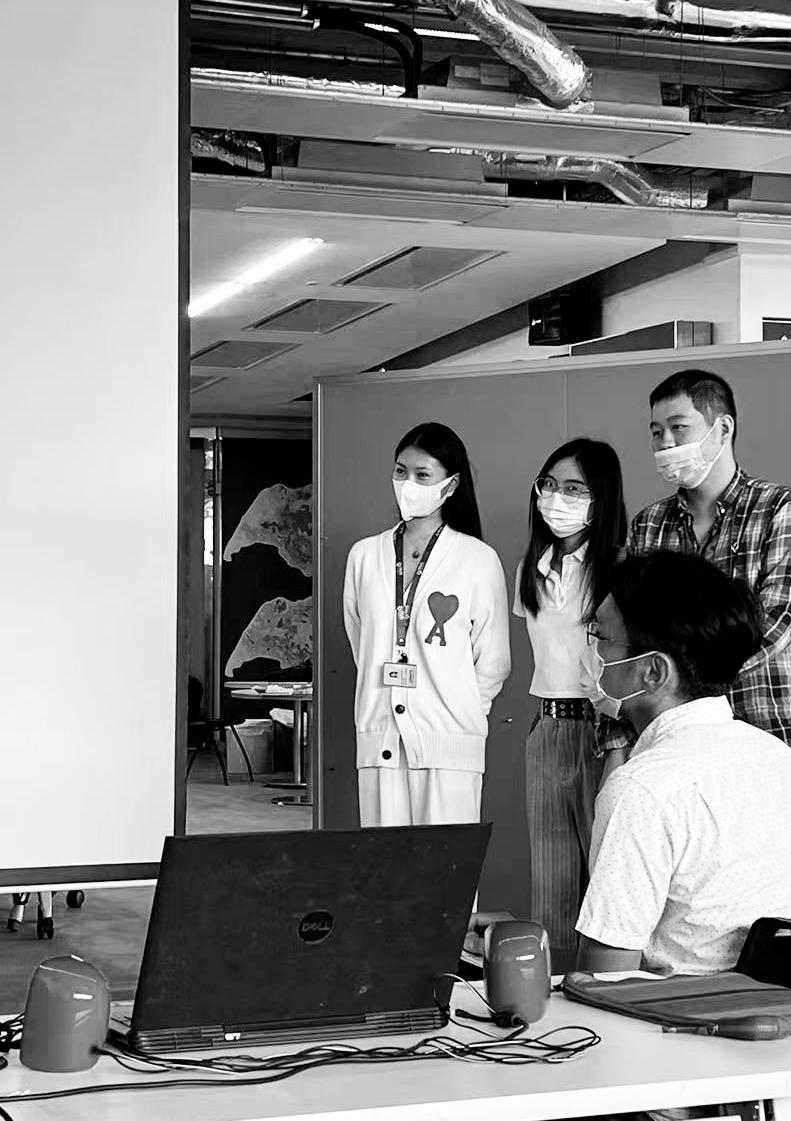
The topic of our group is "Nature Resource as Nature Capital", which is a very special one. Because of its broad meaning, we need to find a subdivided theme and keep rigorous logic to conduct in-depth design. The three of us started with the topic of carbon neutralisation and focused our attention on the three nature resources of water, soil and forest, but then started struggling for several weeks. The main reason is that we have not clearly understood the relationship between these three Nature resources and our theme, and have been thinking about water, soil and forest in a traditional and separate way, so the results of the first few weeks seem confusing.. After several weeks of communication and discussion with Yunhye and other students in the studio, we gradually got on the right track, found the internal connection between three nature resource and Carbon Bank, straightened out the logic of design and narrative, and got a relatively complete and rigorous design.
This semester's studio is very cutting-edge and challenging. Cutting edge in that most of the sites and buildings in Singapore are over 40 years old, and in an era of high population density and rapid global climate change, the renewal and reintegration of older landscapes and buildings into urban development is very cutting edge.The PLAB is 18.6km2, which is 2.5% of Singapore's total land area (728.6km2). On such a large site, it was challenging to come up with a conceptual plan that took into account the different ecological elements and infrastructure development. In the year 2050, when Singapore will achieve carbon neutralization, PLAB will serve as a model to demonstrate how to recycle and utilize the natural resources of the site to maximize carbon sequestration and minimize the carbon footprint. The biggest lesson I learned from the whole semester of research and design is that landscape is a dynamic process, and how to unify multiple and opposing natural resources to achieve a common goal is my biggest takeaway from the semester.
-Mingyu Zhao
- Siqi Cheng
458
- Ruomin Jiang
This studio has taught me the importance of collaboration, communication, and patience. It was an iterative process with a lot of back-and-forths from the beginning of the studio masterplan discussions to the final negotiated outcome and design strategies. Since it was mostly working as a group or as a studio, I also learnt the importance of communication. “Good communication is the bridge between confusion and clarity.” I do agree with this quote and I truly appreciate all the time we took to discuss, make decisions and clarify any confusion. Lastly, I learn to have patience with all things. But, first of all with myself. To me, these are difficult but important lessons to grow as a person.
Having gone through this design studio that is centred around PLAB and designing for the needs of a city, has equipped me with new knowledge on designing on a larger scale. It was definitely a challenge for everyone in the studio as we were pushed to think bigger as landscape architecture students. As we had to generate a studio masterplan, it really pushed us to work together as a class, negotiating with the various studio groups on topics such as nature and the built environment. A lot of interesting perspectives and dialogue came out of these discussions and I really appreciate having been given the opportunity to learn from my peers that come from various educational and national backgrounds this semester.
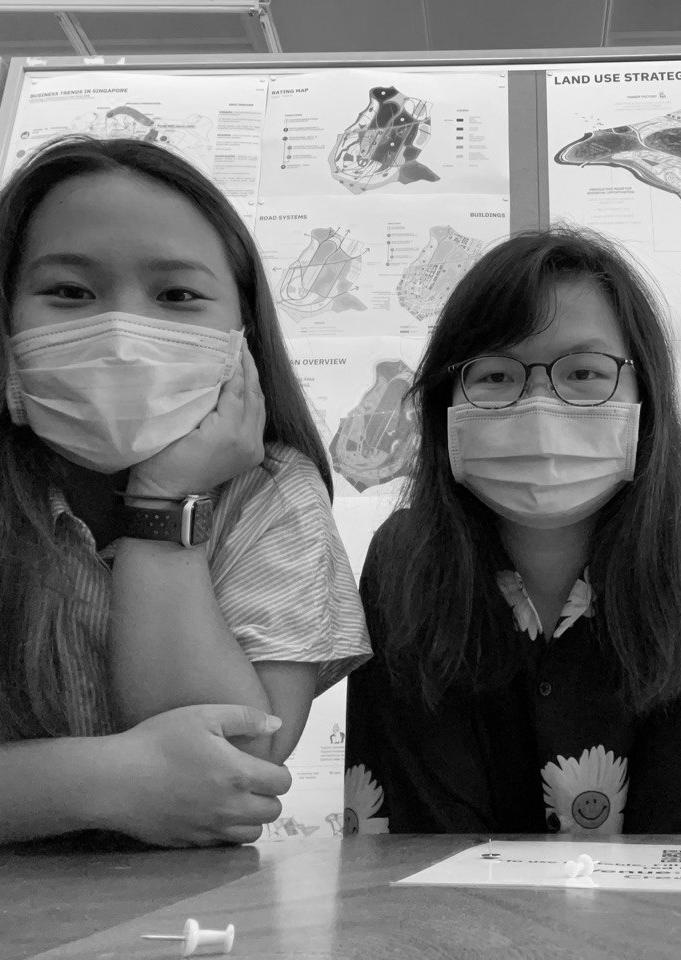 - Cynthia W
- Chai Xin Yi
- Cynthia W
- Chai Xin Yi
459
As a studio product which is not censored, this book may contain mistakes or deficiencies. Proposed ideas may not represent the positions of NUS.
Published by Department of Architecture
School of Design and Environment
National University of Singapore
4 Architecture Drive
Singapore 117566
Tel: +65 65163452
Fax: +65 67793078
Copyright © 2022 Hwang Yun Hye and Guo Lehana (ed.)
ISBN: 978-981-18-4626-7
Student Editors
Liu Kang Sheng
Hu Die Mirwankar Anchita Nitin Zhou Sicong
Copyright © 2022 Hwang Yun Hye and Guo Lehana (ed.)
ISBN: 978-981-18-4626-7

























































































































 Neighborhood forest - Quarter forest
Neighborhood forest - Quarter forest






















































 Retaining wall
Detachable metal skin
Structured beam & joints
3D Printing
Road edge Undulating concrete
Retaining wall
Detachable metal skin
Structured beam & joints
3D Printing
Road edge Undulating concrete





















































































































































 This graphic shows where water comes from and how sewage is treated and reused in the current water management loop in Singapore.
This graphic shows where water comes from and how sewage is treated and reused in the current water management loop in Singapore.

































 Section & Renders
Section & Renders

 Section & Renders
Section & Renders

 Section
Section














































































































































































































































 Pedestrian walkway
Pedestrian walkway Road Lawn
Zig zag slope biking
Pedestrian walkway
Pedestrian walkway Road Lawn
Zig zag slope biking




















 GREEN PATCH WITHIN BUILT SPACES
GREEN PATCH WITHIN BUILT SPACES




























 CurrenT Fauna map
CurrenT Fauna map










 Canopy Layer
Traffic Site Photos to show examples of barriers
Hydraulic Layer (Nature Group)
Canopy Layer
Traffic Site Photos to show examples of barriers
Hydraulic Layer (Nature Group)







































 New Least-Cost Path Layout
New Least-Cost Path Layout








 01 - Within the Core Forest
02 - Forest Edge to Urban
03 - Between Urban Structures
04 - Urban Edge Back to Nature
Natural and Manmade Structures
01 - Within the Core Forest
02 - Forest Edge to Urban
03 - Between Urban Structures
04 - Urban Edge Back to Nature
Natural and Manmade Structures














































 Edge
Edge





















 Section A-A’
Section A-A’






 Section C-C’’
Section C-C’’

 Ephedra Sinica
Typha angustata Rambutan Genus Rosa Ficus Microcarpa
Ephedra Sinica
Typha angustata Rambutan Genus Rosa Ficus Microcarpa



























 Macaranga hypoleuca
Melastoma malabathricum
Pulcherrimum
Ferrugineum
Timonius wallichianus
Clerodendrum laevifolium
Prunus polystachyus
Syzygium lineatum Ficus fistulosa
seed dispersal
Tree transplanting
Biomass
Leguminous plants
Macaranga hypoleuca
Melastoma malabathricum
Pulcherrimum
Ferrugineum
Timonius wallichianus
Clerodendrum laevifolium
Prunus polystachyus
Syzygium lineatum Ficus fistulosa
seed dispersal
Tree transplanting
Biomass
Leguminous plants

















































 Compost + Biochar Centre
Compost + Biochar Centre










 -Dong Liwei
-Shen Yunnan
-Dong Liwei
-Shen Yunnan
 -Wang Yu
-Zhang Wenting
-Wang Yu
-Zhang Wenting
 -Ye Han
-Ye Han
 -Liu Ziyue
-Liu Ziyue

 -Xing Zhiyan
-Janina Kwan
-Xing Zhiyan
-Janina Kwan


 -Zhou Sicong
-Anchita Nitin Mirwankar
-Zhou Sicong
-Anchita Nitin Mirwankar
 - Ruozhu Xu
- Wanruo Chang
- Ruozhu Xu
- Wanruo Chang


 - Cynthia W
- Chai Xin Yi
- Cynthia W
- Chai Xin Yi